June 27, 2007
CADAVRE EXQUIS CARTOGRAPHY (C.E.C.)
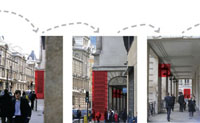
Urban Game & Mapping Exercise
FRIDAY SESSION 18 :: CADAVRE EXQUIS CARTOGRAPHY (C.E.C.); An urban game & mapping exercise followed by Talks from Dr. Maria Kaika and Julie Myers :: June 29, 2007; 6.30 pm :: Outside Bank Tube station - Take the 'Cornhill North' exit and meet us on the square outside the Royal Exchange, corner of Threadneedle St. and Cornhill :: Bring: a digital camera with its download equipment (Cables!), so we can download the images after the walk at Public Works and team-mates.
CADAVRE EXQUIS CARTOGRAPHY prompts people to explore and collect ground-level images of the City. Walks will be followed by two short talks at the public works studio at 8pm. Dr .Maria Kaika of Oxford University will talk on the continuously changing development of the City of London. Julie Myers will present - To travel Somewhere - a mobile phone / mapping project developed from a series of walks in San Francisco, USA, Cambridge, UK and Helsinki, FIN.
CADAVRE EXQUIS CARTOGRAPHY is played in pairs sharing one digital camera with display screen. Player 1 starts by taking a picture with a designated building or object in the frame as well as a second object / building of any kind. After handing over the camera to player 2, both leave the first photographed object behind, moving towards the second element of the shot. Player 2 now takes a picture with this building / object in the frame, but again with something else in the background or foreground, which will be the linking element in the next image. The camera is then handed over to player 1, who takes the next photo of the series.
THE AIM OF THE GAME IS TO COVER AS MUCH GROUND AS YOU CAN.
THE RULES:
1. A team is only allowed 30 shots and 1 camera per walk, so SHOOT CAREFULLY!
2. Images have to overlap physically and can only be of ground level building or object, so DON'T SHOOT IN THE AIR!
3. Only take images of objects/buildings in front of the team so SHOOT FORWARD!
All images will be assembled online and will allow visitors to wander through the City from behind their computer.
Maria Kaika holds a D.Phil. in Geography from the University of Oxford, and an MA in Architecture from the National Technical University of Athens as well as professional qualifications as an architect. Her previous posts include: Director of Studies in Human Geography at St Hugh's College, Oxford, Departmental Lecturer at the School of Geography, Oxford, Junior Research Fellow at Linacre College, Oxford, Lecturer in Human Geography at St Peter's College Oxford.
Dr Kaika's research focuses on urban theory, and more specifically on the politics and culture of architectural technology and design and on urban political ecology. Collaborative projects include work on: urbanism and culture; modernist urbanism and nature; urban environmental history; representations of nature and the city; governance and environmental policy; European environmental policy; theoretical approaches to sustainability; political ecology of water supply in western cities.
Julie Myers is an artist who's practice is informed by social encounter and intervention. Her work investigate memory, gesture and narrative in relation to physical environment. Sometimes recording just a brief moment captured between strangers and at other times building sustained relationship with multiple participants over a sustained period of time. She uses film/video, mobile technologies and database formats to document and present material that exists both on the web and in site specific or exhibition space.
Julie is a senor lecturer at Middlesex and Kingston Universities and lives in London. She has exhibited and screened work extensively receiving a number of awards including an AHRB research award and an Erasmus Scholarship. Previous work has been commissioned by The Arts Council of England, NESTA, The BFI, The Institute of Contemporary Art, BAA and the National Portrait Gallery. Julie has recently completed a placement at Adobe in San Francisco as part of the ACE interact program.
public works
Northgate House
2-8 Scrutton Street
UK London EC2A 4RT
Click here to view map
For more information email Jim[at]citymined.org or andreas[at]publicworksgroup.net
Posted by jo at 12:56 PM | Comments (0)
June 25, 2007
Institute for Applied Autonomy
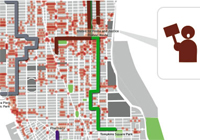
Tactical Cartography
In taking up the term 'tactical' in an arts context, we link cartography with 'tactical media,' an approach to art production that privileges critical social engagement. Since the early 90's the tactical media label has become something of a house brand for a host of widely divergent media practices embracing themes of politics and empowerment. Particularly, the term has expanded from its origin in interventionist art to ultimately include a wide variety of "alternative" and "indy" media strategies. In considering the term here, we emphasize its connotations of instrumentality.
At root, tactical media is about intervention - it is concerned with creating disruptions within existing systems of power and control. Less a methodology than an orientation, it is fundamentally pragmatic, utilizing any and all available technologies, aesthetics, and methods as dictated by the goals of a given action. Tactical media events are necessarily ephemeral - they exist only as long as they continue to be effective; once their utility has been exhausted, they vanish into thin air. While it may form a part of a long-term strategy, tactical media itself is concerned with temporary destabilization rather than permanent transformation.
Extending these notions to spatial representation, then, we claim that "tactical cartography" refers to the creation, distribution, and use of spatial data to intervene in systems of control affecting spatial meaning and practice. Simply put, tactical cartographies aren't just about politics and power; they are political machines that work on power relations. From An Atlas of Radical Cartography.
Posted by jo at 04:56 PM | Comments (0)
June 18, 2007
Bloomsday on Twitter
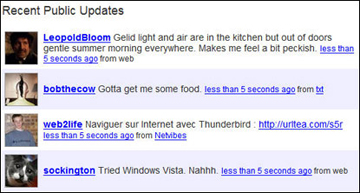
Bloomsday on Twitter: A performance of Wandering Rocks on Twitter, and a commentary on both. Created by Ian Bogost and Ian McCarthy :: I do not like Twitter, the micro-blogging service that allows users to send short (SMS-sized) text-based updates that are displayed publicly and shared with friends social-network style.
For me, Twitter represents the worst trends in the new internet culture. It purports to allow people to "communicate" in new ways, a promise that mostly creates new obligation and infatuation to stay "up to date" and "connected." In the world of Twitter, you (and me, and everyone) pay constant, tiny homage to a new gimmickry.
This is a gimmickry that doesn't even rise to the level of the gadget, with its industrialist promise of technological progress. It is a kind of softer soft-pornography determined to make identity-assertion the new masturbation. Russel Davies' Twitter parody Dawdlr comments on this trend, asking users to send updates via postcard.
In the world of Web 2.0, a public sheds the chains of a tightly-controlled mass media market in which individuals are converted into the "consumers" needed to purchase mass produced goods and services. In its stead, that public gets a loosly-controlled micro media market, in which individuals are converted into the "users" needed to create databases for sale to Google or Yahoo! or News Corp for $35 a head. But now the market outsources manufacture to those very "users." The workers may have had nothing to lose but their chains, but the users are lining up to link their own together. It's the new fashion; chains are the new black.
Invective like this may amuse, but it doesn't necessarily change opinion or create discussion. My friend and sometimes-collaborator Ian McCarthy and I had been talking in San Francisco recently, looking for an intervention that would both comment on Twitter as a social force and also attempt to use the service in a culturally interesting way. What if the focus on socialization and identity is actually the least interesting way to use Twitter?
So, here's what we came up with.
Today, like every June 16, is Bloomsday, a holiday that celebrates James Joyce and his novel Ulysses, which takes place on this date in 1904. Ulysses already offers a parallel commentary; Joyce conceived of the book's principal character, Leopold Bloom, as an everyman counterpoint to Odysseus, whose adventure Bloom's parallels. Each of the book's 18 chapters take place in roughly an hour's time.
The 10th of these, Wandering Rocks, follows 19 Dubliners walking through the city, doing their daily business, some intersecting with others. It's a famous and often-studied section of the book, one that also speaks to an experience of urban modernity that has become second-nature to us now.
Enthusiasts often retrace the characters' steps on Bloomsday, and innumerable animated maps and the like have been created by fans and scholars. The latter technique still doesn't really represent the interleaved simultaneity of Wandering Rocks, the complexity yet ordinariness of space and interaction that Joyce's writing accomplishes. And the former technique turns the ordinariness of the episode into a kind of theme park, missing the importance of the Wandering Rocks as a vignette of the scenario that grounds the rest of the novel (I've written about this theme more in relation to videogames in a chapter of my book Unit Operations).

We took Wandering Rocks and adapted it into a large series of 140-character or less utterances in the first person. We organized and timed these and built a database for them. We registered key characters in the novel as users on Twitter. For example:
STEPHENDEDALUS: I see Dilly's high shoulders and shabby dress, shut the book quick, don't let see.
Then we wrote some software to automate the performance of Wandering Rocks on Twitter, so basically we just turn it on and it runs. The result, we hope, will offer both an interesting and unique perspective on the novel and on Twitter. I'll let our critics be the judge of that.
Bloomsday tradition normally demands that festivities take place on Dublin time, which is unfortunately 6 hours ahead of the US East Coast. Wandering Rocks starts at 2:55pm, which is barely the crack of dawn (especially on a Saturday) out on the West Coast. So we decided to synchronize our performance to EDT. If you wish, you can watch the public stream on Twitter starting at 2:55pm EDT. You can also watch the individual characters, or even add them as "friends" to get the updates.
Update: the performance is now completed; while there were a few hiccups that made a very small minority of the characters unable to participate, the vast majority worked as planned, and you can now click through to read their contributions. I'll put together some documentation of the live version to share soon.
BUCKMULLIGAN
STEPHENDEDALUS
[go to post for live links]
LEOPOLDBLOOM
BLOOMSCAT
BLAZESBOYLAN
JOHNCONMEESJ
ONELEGGEDSAILOR
WIFEOFSHEEHYMP
BRUNNYLYNAM
DENISJMAGINNI
MRSMGUINNESS
BLONDEINTHRNTNS
HELYS
MISSDUNNE
TOMROCHFORD
SATCHELLEDBOYZ
NOSEYFLYNN
MCOY
LENEHAN
JJOMOLLOY
UNLABORINGMEN
CORNYKELLEHER
CONSTABLE57C
THESHOPMAN
EARLOFDUDLEY
OLDWOMANONTRAM
PATRICKDIGNAM ALMIDANO
THELACQUEY
DILLYDEDALUS
SIMONDEDALUS
HAINESINDUBLIN
JOHNPARNELL
ELIJAHISCOMING
KATEYDEDALUS
BOODYDEDALUS
MAGGYDEDALUS
MISTERKERNAN
NEDLAMBERT
CLERGYMANJACK
FRBOBCOWLEY
DENISBREEN
BENDOLLARD
CASHELFARRELL
BLINDSTRIPLING
DUDLEYWHITE
RICHIEGOULDING
THEPODDLERIVER
2SANDEDWOMEN
THEPOLICEMAN
MARTNCUNNINGHAM
JOHNWNOLAN
HORNBLOWER
MANINMACINTOSH
Late last night, partly to test and partly to put a stake in the ground, we did perform the first ten minutes of the novel properly synchronized to Dublin time.
Happy Bloomsday!
[blogged by Ian Bogost on bogost.com/blog] [Related]
Bloomsday On Twitter
Perhaps one day we will remember Twitter as the peak of exhibitionism on the Internet, a phenomenon that started with blogs and social networks. It is hard to imagine anything more compulsive: Twitter is a community of thousands of people who publish brief messages answering the simple question "what are you doing right now?". It is a sort of self-imposed big brother, a Babel of self-referential statements ("I'm checking my email", "I'm buying a computer on eBay"), a massive collective stream of consciousness. On June 16, in Dublin, there are celebrations for the Bloomsday, a day of cultural activities centered on James Joyce's Ulysses. Among the most important events of that day is the reenactment of day of Leopold Bloom, the odissey of the common man that unravels on the streets of Dublin in a single day. What do the most important novel of the twentieth century and the most extreme platform of web 2.0 have in common? Nothing, or so it was before the last June 16, when Ian Bogost and Ian McCarthy, game designers and non-linear narration researchers, chose Twitter as the stage of a strange online performance. The tenth chapter of Joyce's Ulysses, that narrates simultaneously the lives of nineteen citizen of Dublin was adapted to microblogging. The original text was broken down into fragments and inserted into a database for a computer program to read and publish as messages on Twitter at the right times, signed with the names of the characters/users. The result is a bizarre short-circuit between time and space units, between high and low culture. Characters from a novel are animated by a machine and their voices mix with those, paradoxically more artificial, of real human beings. The performance, coherently with the pace of that chapter, lasted only an hour, and it probably wasn't noticed by the users of Twitter, lost as a drop in an ocean of communicating solitudes. - Paolo Pedercini, Neural.
Posted by jo at 06:49 PM | Comments (0)
Gallery TPW presents
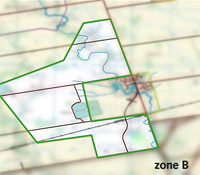
Dubious Views
Dubious Views: Questioning Institutional Representations in Tourism and Cartography :: Curators: Michelle Kasprzak, Michael Alstad, Shawn Micallef :: A bilingual online exhibition produced by Gallery TPW and funded by the Virtual Museums of Canada.
Every time you open your eyes, a hundred different sources vie for your attention. This spectacle - the cacophonous accumulation of images superimposed over the "real" world - is built by everything from advertisements to entertainment to government. This institutional view of the world can come to stand in for and suppress any other visions or versions that might be out there.
The artists discussed in Dubious Views address the role of the "institution" in terms of its effect on the understanding of place. It is examined in relationship to the tourism industry, and in the context of mapmaking and geography. In both cases, the artists involved look at and play with creating alternatives to the institutional view, and attempt to challenge its singularity, its authority, and its monolithic profile.
Artists include: David Rokeby, Surveillance Camera Players, Michelle Teran, Proboscis, Sylvia Grace Borda, Janet Cardiff, Eugene Atget, Nikki S. Lee, Charles Marville, Roger Minick, [murmur], N.E. Thing Co., Shelley Niro, Louise Noguchi, Mitch Robertson, Ed Ruscha, Camille Turner, Jin-me Yoon, and more.
Posted by jo at 11:50 AM | Comments (0)
June 14, 2007
Conor McGarrigle's
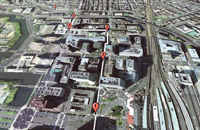
Joyce Walks
Joyce Walks a new project by Conor McGarrigle: Because somewhere, sometimes it's always Bloomsday. Every June 16th in Dublin Joyce enthusiasts celebrate Bloomsday with re-enactments of events from Ulysses. Unfortunately not everyone can be in Dublin for that day but why should that stop you celebrating Bloomsday where you want when you want. So as Bloomsday approaches we announce Joyce Walks a web 2.0 service which will let you map routes from Ulysses to any city in the world so that Bloomsday can be celebrated in any place at any time.
Joyce Walks is a psychogeographical tool which generates walking maps based on routes from James Joyce's Ulysses in any city in the world using Google Maps. The system prints maps to be used as the basis of walks exploring the city of your choice and generates mashups using your pictures and videos documenting these walks to share with other users.
Inspired by the Situationist idea of the Derive Joyce Walks seeks to provide the walker a means of exploring the urban environment which is unique, truly random but removed from a reliance on chance. Although based on a fixed route each map generated is unique as it is based on an individual selection by the user of the center point of their chosen city thus every map provides the walker a means of exploring the urban environment which although based on routes which are predetermined according to a strict adherence to a text is individual to them. Of course removing these routes from Dublin removes specific spatial relevance but they still retain an aura of association which creates a link between the locations and Joycean Dublin.
Joyce Walks saves every map generated to a database. These walks, in addition to being specific to their creator, form part of a continuum where each specific walk performed by any user of the system is added to an searchable archive of unique performative walks from around the world. This archive over time will become a tool to explore and view many unique walks in many cities around the world creating a veritable web 2.0 psychogeographical rough guide.
Requirements: Firefox or Safari browser , in this beta version Internet Explorer is not supported, support for IE will be added shortly. Due to copyright issues between Google and the British Ordnance Survey cities in the UK and Northern Ireland are not searchable, we are working to find a solution for this.
Posted by jo at 06:03 PM | Comments (0)
LOCATIVE MEDIA IN THE WILD
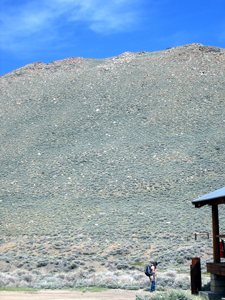
Student Explorations
In the Spring quarter of 2007 at UCSD, a group of particularly rugged and conceptually edgy students volunteered to take contemporary computing topics to the wild. Venturing to the White Mountains, near the Nevada state line, and adjacent to Mount Whitney and her Sierras, the students inhabited the UC White Mountain Research Facility. Their art's practices took them out into the topography... see what they did.
Artists: Zane Andre, Christopher Baker, Adriana Barraza, Heather Clark, Sara Gevurtz, Jonathan Huntoon, Andrew Kim, Gen Kobayashi, Jose Lopez, Sarah McClelland, Christina Tam, Christin Turner, Ryan Velasquez, Thao Vo, Britni Wenck.
Projects: 37°29'59"N, 118°10'06"W, A Sound Perspective: Site Specific Azimuth at Crooked Creek, Another Methuselah, Follow the White Rabbit, GPS Animated Geoglyph, In Search of Sephiroth, MapZ, Phantom Walk (The Linear Cube), Psychogeographic Maps, Shade Walking, Sighted, Sonic Trajectory, Sonifying the White Mountain, Spiritual Geocaching, Visual Biodiversity Survey: 25 Samples, Visions From An Exhange Student.
Posted by jo at 05:43 PM | Comments (0)
June 08, 2007
Plundr
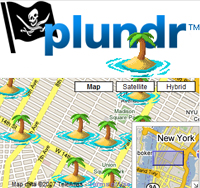
Piracy on the High Seas of NY
Plundr is a location-based game of piracy and trading on the high seas created by area/code. Start out as a bilge-spewing land-lubber in a leaky tub, search the ocean for unsuspecting ships to pillage, upgrade your ship, and amass a fortune in black market goods.
Plundr is designed to be played on laptop computers by players who are navigating through real-world space. The gameplay takes place on Islands where you can buy and sell goods, prey on Merchant Ships, and battle other nearby players. Each Island corresponds to a real-world location. [via]
Posted by jo at 11:30 AM | Comments (0)
May 23, 2007
Electronic Lens
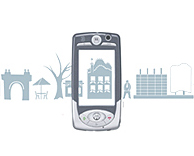
Annotating for Civic Engagement
The Electronic Lens explores and creates new paradigms of civic ubiquitous networking with mobile technologies. We think of Electronic Lens as something of a viewfinder. Using a motion that is already familiar (think point and shoot camera phones), the citizen can use the eLens to gather information about physical objects and places.
The eLens matches electronic information with the physical environment in an innovative way. For example, eLens users can post lasting messages in physical locations, tag buildings and places, or create social networks based on interest and social affinities. eLens interactions combine the physical environment with formal and institutional information and the annotations from users’ personal experiences.
Ultimately the eLens enhances the value of the city for its citizens by making their environments more accessible, more culturally vibrant, more socially just. The eLens fosters communication among people and between institutions; as a result citizens are now better able to navigate the social, institutional and physical urban space.
Posted by jo at 08:38 AM | Comments (0)
May 12, 2007
Squirrel and Acorn
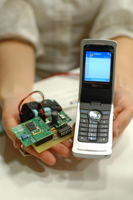
Cell phone Air Pollution Monitor
" ... Squirrel and the companion software, Acorn, also represent a bold exercise in social responsibility and cross-border engagement. "We want to make air quality data visible, accessible and legible to raise consciousness of environmental monitoring," says Spanhake. For this, she has collaborated with Calit2 researcher Kael Greco, author of a mobile webcam application that uploads images taken by the mobile phone automatically and continuously. These images are tagged and manipulated with the sampled pollution data -- the grittier the image, the more polluted the air is -- then displayed in real time on a web page. "This, along with other visual and audible ways, will help to demystify what 20ppm is in a meaningful way," says Spanhake, adding: "Low-cost technology will also make it available and scalable to the technological, environmental and cultural needs of individuals, communities and cities."
The device is low-cost, mobile, and scalable. It is also intended to be a building block for the creation of a mobile wireless sensor network dependent upon those who breathe the air -- people. "Squirrel is meant to monitor an individual's personal exposure to the air, thus providing a means for agency in the production of air pollution data," says Spanhake. "It will enable supplemental data to the environmental protection agencies that cannot afford to scale their technology to population growth and urban sprawl." ..." From Tracking Pollution and Social Movement: Love Fest for Calit2 Technologies at 'Make Fest 2007'.
Posted by jo at 01:35 PM | Comments (0)
May 11, 2007
Heavy Opera: An Audio Tour to Awaken Londoners to
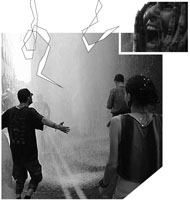
The Impact of Financial Systems on Climate Change
John Jordan and James Marriott’s operatic audio tour set in London’s Square Mile is intended to awaken city workers to the impact of financial systems on climate change. But not only does And While London Burns misgauge how much the suits already know, its hysterical tone also harmonises too easily with the coming new eco-order.
A fountain of water from the river Walbrook shoots up above my head, drums are pounding, a sound system’s bass rumbles. I hear cheers but I can also hear the clatter of police shields and batons around the corner. Seven years after London’s Carnival Against Capital, when protesters outside the LIFFE exchange broke a water mains sending a thirty-foot jet of water into the air, I am walking just a half a mile north of the same spot. Now I can hear the Thames rushing up the valley the Walbrook follows, bursting its banks, laying waste to the tall glass-fronted buildings as some of the most expensive real estate in London collapses around me. I’m swept up in a sonically induced fantasy driven by the tracks on my MP3player. I am taking part in And While London Burns, an operatic guided walk written by John Jordan and James Marriott, set to music by Isa Suarez and produced by the cross-disciplinary art and education group Platform.
John Jordan has played a role in both these participatory dramas, firstly as a member of Reclaim the Streets – one of the anti-capitalist groups that coordinated the Carnival Against Capital in June 1999. This time around as an artist commissioned by Platform – an interdisciplinary arts, campaigning and research group committed to longer term, less partisan approaches to transforming the activities of the financial institutions and corporations with head offices in the Square Mile. The walk is an attempt to dramatise the research Platform has conducted into climate change. James Marriott, its co-founder, explains:" from Heavy Opera by Anthony Iles, It's Not Easy Being Green, MUTE VOL 2 #5.
Posted by jo at 01:36 PM | Comments (0)
April 21, 2007
Turbulence Commission:
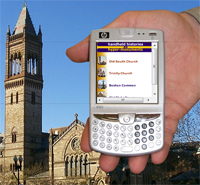
Handheld Histories as Hyper-Monuments
Turbulence Commission: Handheld Histories as Hyper-Monuments by Carmin Karasic, Rolf van Gelder and Rob Coshow, with special thanks to the HP mscapers team, Brett Stalbaum, and Jo Rhodes :: Part of the Boston Cyberarts Festival, pick up a smartphone at the Judi Rotenberg Gallery, 130 Newbury Street, Boston :: April 21-28, 2007, Tues-Sat 10am-6pm. Gallery talk today: 2:00 pm.
Designed for HP iPAQ 6900 series smartphones, Handheld Histories as Hyper-Monuments uses GPS and mobile technologies to address historic bias in Boston's public monuments. The artwork gathers non-official stories to socially construct hyper-monuments that exist as digital doubles, augmenting specific historic monuments. For example, imagine you are near the Old South Church in Boston, MA, USA. The smartphone sounds church bells to get your attention. It then displays an easily identifiable image of the Old South Church circa 2007, followed by images of the church that take you back in time. Finally you see the location as it was in its natural, wild state. You can send text, image and audio content to the website from the monument location via any internet enabled device. Or use any internet browser to view and add histories to the hyper-monuments.
HHHM requires HP mediascapes locative media software to create content rich hotspots on GPS aware maps. Once the HHHM mediascape is installed on a handheld device, a GPS fix is required to automatically display the hyper-monument. WiFi internet connectivity is best for viewing and contributing to the hyper-monument via the handheld's browser.
“Handheld Histories as Hyper-Monuments” is a 2007 commission of New Radio and Performing Arts, Inc., (aka Ether-Ore) for its Turbulence web site. It was made possible with funding from the LEF Foundation.
BIOGRAPHIES
One November morning in 1994, CARMIN KARASIC was listening to digital artists on NPR when she realized she was a digital artist trapped in a Fidelity Technical Project Manager's body. This simple realization changed her life. A multimedia artist focused on Internet Art, she is also an Assistant Director of Boston Cyberarts, and on the faculty of Lesley University. Her work can be seen online in several e-zines, websites, and galleries, such as CAGE. She has exhibited in the Boston area at the DeCordova Museum, MIT List Center, the Attleboro Museum, Computer Museum, New England School of Art and Design, The Art Institute of Boston, and The Brodigan Gallery; in NY at the Studio Museum, Harlem; Brooks Gallery at Cooper Union, and the New York Hall of Science; and Austria, Canada, Japan, and Germany. Carmin has been awarded a Mudge Fellowship from the Groton School and a duPont Fellowship from the Art Institute of Boston.
ROLF VAN GELDER is an artist and web developer. Self-taught, he has been creating visual art since the early 80s. He has been collaborating with Carmin Karasic since the 1990s. They created "d{s}eduction dialogue" for the 2001 Boston Cyberarts Festival and "Virtual Quilt" (2002) for the DeCordova Museum and Sculpture Park, Lincoln, MA, USA (with Clara Wainwright). In 1995 Rolf founded one of the first on-line art galleries, CAGE - Cyber Art Gallery Eindhoven (http://www.cage.nl). His work has been exhibited in over 50 exhibitions in the U.S.A., Canada, Austria, Portugal, Italy, Sweden, Germany, UK, Spain and the Netherlands.
ROB COSHOW is an artist/photographer who recently graduated Magna Cum Laude from the Art Institute of Boston. Trained in classic wet-lab photography as well as digital and new media, Rob has honed his experimental approach to create works that bridge multiple disciplines. In 2006, he exhibited his “Crab Cake” robots at Axiom Gallery, and collaborated with Jeff Warmouth, Roland Smart and other Boston artists to create “Art Show Down” at Art Interactive. He has received various honors for his photography and illustrious reviews for his new media work.
Posted by jo at 10:10 AM | Comments (0)
LOCATING OURSELVES
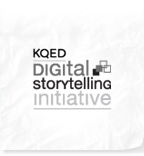
A KQED Digital Storytelling Summit
LOCATING OURSELVES: A KQED Digital Storytelling Summit :: May 26, 2007; 10-4 pm (Bonus: Friday evening, May 25, 6-8 pm party and showcase celebrating the Coming to California contest) :: KQED, 2601 Mariposa Street, SF :: All are welcome ::Lunch provided, so please RSVP: lrule[at]kqed.org
Come participate in an exploration of the current Digital Storytelling Landsacpe, with special attention given to place-based storytelling, locative media, and mobile technologies. So much is happening, and it's been a long while since we've come together to discuss where we might be going.
Many of us are practitioners, so please let us know what themes you'd like to see explored. Email Leslie Rule at lrule[at]kqed.org. We also invite you to join us Friday evening as we celebrate our high school digital storytellers who participated in the 5th Annual Coming to California Digital Storytelling Contest.
Posted by jo at 08:21 AM | Comments (0)
April 18, 2007
AreYouHere?
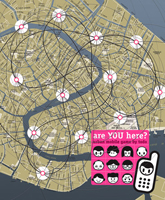
Venice - Urban Mobile Game
AreYouHere? :: 2007 - June 6th/15th - Venice - urban mobile game :: AreYouHere? is one of the 12 urban interventions of Migration Addicts, 52nd International Art Exhibition, La Biennale di Venezia, Collateral events :: Site: the whole city - starting point at Chiostro Ex Chiesa Santi Cosma e Damiano, Giudecca, 620.
AreYouHere? is an urban mobile game that aims to explore Venice through its inhabitants/migrants. More and more Venetians are leaving the lagoon to settle in other towns. In the next 30-40 years, it is certain that Venice's population will be dramatically reduced. Bar and hotel owners now come from abroad while the town is losing its original inhabitants and becoming more and more globalized. Thousands of tourists arrive to Venice everyday. The Observer provocatively wrote that if the only destiny of the town is low cost tourism then it would be better to have Venice managed by Disneyland Corporation. A kind of paradox is happening. Venice could be everywhere, that "exotic" does not exist anymore. Labor migrants from Asia are welcoming you and serving you Italian food. You are in Venice. But are you really in Venice? What do you see? Who do you meet?
AreYouHere? is an urban exploration through the faces of the people anyone can meet during his/her stay. Faces of migrants that have become the actual inhabitants, while the player is the stranger. A touristic and personal exploration of people and their faces. Those photos will be joined together into a personal postcard. He/she will receive the postcard at home. A postcard that is actually sent by him/herself. The player will receive the postcard to his/her home: a postcard that is actually sent by him/herself.. But the places you are supposed to visit, however, are not the ones you would expect to go, the top visited.
Surely you'd never take a photo of people who lives and works in these places. But that's what you have to do: shoot photos at immigrant people who live and work in Venice, carefully following the path that has been created for you, because you are the stranger, the tourist, and they are a part of Venice instead. You should take those photos with your mobile phone and send them by MMS to the number you found on the invitation. But remember, the first photo you send must be a photo of yourself: because you are a part of the game. [via]
Posted by jo at 04:34 PM | Comments (0)
April 16, 2007
Locative Media Summer Conference
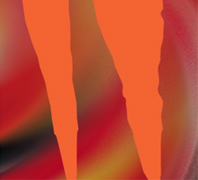
Call for Papers
Locative Media Summer Conference: Call for Papers :: September 3-5, 2007 :: Research Center "Media Upheavals", University of Siegen, Germany :: Submission deadline: May 15, 2007.
"Everything is related to everything else, but closer things are more closely related" (Waldo Tobler's First Law of Geography, 1970)
Nowadays everything in the media world gets tracked, tagged and mapped. Cell phones become location-aware, computer games move outside, the web is tagged with geospatial information, and geobrowsers like Google Earth are thought of as an entirely new genre of media. Spatial representations have been inflected by electronic technologies (radar, sonar, GPS, WLAN, Bluetooth, RFID etc.) traditionally used in mapping, navigation, wayfinding, or location and proximity sensing. We are seeing the rise of a new generation that is "location-aware". This generation is becoming familiar with the fact that wherever we are on the planet corresponds with a latitude / longitude coordinate.
The term "Locative Media", initially coined in 2003 by Karlis Kalnins and the 2006 topic of a special issue of the Leonardo Electronic Almanac, seems to be appropriate for digital media applying to real places, communication media bound to a location and thus triggering real social interactions. Locative Media works on locations and yet many of its applications are still location-independent in a technical sense. As in the case of digital media, where the medium itself is not digital but the content is digital, in Locative Media the medium itself might not be location-oriented, whereas the content is location-oriented. Can Locative Media like digital media thus be understood as an upheaval in the media evolution? This is one question we want to discuss at the Locative Media Summer Conference in Germany.
Locative Media can now be categorized under one of two types of mapping, either annotative (virtually tagging the world) or phenomenological (tracing the action of the subject in the world). Where annotative projects seek to demystify (see all the Google Earth Hacks), tracing-based projects typically seek to use high technology methods to stimulate dying everyday practices such as walking or occupying public space. The Japanese mobile phone culture, in particular, embraces location-dependent information and context-awareness. It is thus projected that in the near future Locative Media will emerge as the third great wave of modern digital technology.
The combination of mobile devices with positioning technologies is opening up a manifold of different ways in which geographical space can be encountered and drawn. It thereby presents a frame through which a wide range of spatial practices that have emerged since Walter Benjamin's urban flaneur may be looked at anew. Or are Locative Media only a new site for old discussions about the relationship of consciousness to place and other people? In the early days of sea travel, it was only the navigator who held such awareness of his exact position on Earth. What would it mean for us to have as accurate an awareness of space as we have of time? In the same way that clocks and watches tell us the exact second, portable GPS devices help us pinpoint our exact location on Earth. As we dig a bit deeper into how particular Locative Media projects negotiate local and global spaces, we see the increasing "technologisation" and commodification of urban and public spaces. Are Locative Media the avant-garde of the "society of control"? If this kind of media practice resides in pure code (tracklogs), what is the difference between Locative Media and software development? Or is the recent rise of Locative Media just a response to the disappearance of net art?
In reaching beyond art, many of us are becoming familiar with GPS units, such as navigation systems. GPS technologies now appear in mobile, location-aware computing games such as "Mogi" or "Tiger Telematics Gizmondo," which utilize GPS to enable players to see each other's locations. Most of the location-based games nowadays seem to emphasize collecting, trading and meeting over combat. Does this indicate a social trend in mobile entertainment? Do Locative Media generate more accessible than aggressive play plots? Can we say that the numerous distributed geotagging projects (Flickr, Geocaching etc.) unleashed have given rise to a new genre of collaborative "geocommunities"? Could these geolocated spatio-temporal web portals become a dynamic visualization matrix for all scales, from nano to astro, and incorporate interoperability standards for the biological sciences, the geosciences, history, economics, and other social sciences? And finally, are Locative Media a kind of manifestation of what Bruno Latour means by the "Internet of Things"? By geotagging objects instead of people, and having these objects tell us their stories, do we create what Jean-Jacques Rousseau called for, an awareness of the genealogy of an object as it is embedded in the matrix of its production?
This summer conference will attempt to give an overview of actual research on this topic, especially focusing on how Locative Media tackle social and political contexts of production by focusing on social networking, access and participatory media content including story-telling and spatial annotation. Participants from all relevant disciplines are invited, especially researchers in social science, IT design, urban, media and cultural studies. Project demonstrations are warmly encouraged, but the main objective is to move beyond presentation and to build conceptual and theoretical links and exchanges between disciplines. This kind of conference is meant a forum for the presentation of papers, further discussion, collective reading work and as a preliminary step for the publication of an edited volume in 2008.
Invited Speakers:
Prof. Dr. Lev Manovich, University of California, San Diego (USA), http://www.manovich.net/
Prof. Dr. Stephen Graham, University of Durham (GB), Department of Geography, http://www.geography.dur.ac.uk/information/staff/personal/graham/index.html
Dr. Miya Yoshida, Malmv Art Academy, Lund University (S), http://invisible-landscapes.net/
Dr. Drew Hemment, University of Salford/Futuresonic Festival (GB), http://www.drewhemment.com
Dr. Adrian Mackenzie, Lancaster University (GB), http://www.lancs.ac.uk/staff/mackenza/
How to participate:
Submissions should include 1) Title, 2) 500-word abstract 3) Selected bibliography and 4) 200-word CV for the presenter.
These should be sent to thielmann[at]spatialturn.de as pdf or doc attachments by May 15, 2007. Notification of acceptance will be provided two weeks later so as to allow adequate to make travel arrangements. Full papers for publication are due on December 31, 2007.
For further information contact Tristan Thielmann: thielmann[at]spatialturn.de. The summer conference is organised by the research group "Media Topographies" of the Collaborative Research Center "Media Upheavals", University Siegen, Am Eichenhang 50, 57076 Siegen, Germany.
Posted by jo at 01:10 PM | Comments (0)
April 15, 2007
Turbulence Commission: The Simultaneous Translator

ONLINE Performance Today
Turbulence Commission: The Simultaneous Translator by John Roach and Willy Whip [Requires Windows OS] LIVE PERFORMANCE: Sunday April 15; 12:00 PM EST to 3:00 PM EST [Mac users can listen via the player of their choice].
"The Simultaneous Translator" (SimTrans) is a Windows based audio interface that enables anyone to load audio streams and manipulate them in real time on the Internet. SimTrans makes the delays and fluctuations of the Internet visible and audible. The Internet becomes your collaborator as you create your mix, and the instability you usually try to avoid becomes a tool for creation. Distance and delay are manifest within the interface numerically and as a series of sliding heads; there is also a link to Google Earth where you can watch the dynamic flight of data travel between yourself and the audio source.
“SimTrans” is a 2007 commission of New Radio and Performing Arts, Inc., (aka Ether-Ore) for its Turbulence web site. It was made possible with funding from the Murray G. and Beatrice H. Sherman Charitable Trust.
THE PERFORMANCE: "The Simultaneous Translator" grew out of the artists’ live networked performance project "Simultaneous Translation," in which the delays of the internet are used to dynamically effect the live performances of geographically distant artists.
The upcoming performance will take place from 12:00 PM EST to 3:00 PM EST on Sunday April 15. Log on via http://turbulence.org/Works/simtrans.
Participants: Greg Davis (USA), Kenneth Goldsmith (USA), John Hudak (USA), Keyman (France), Lawrence Li (China), Mice69 (France), Miguel Ramos (Spain), Joe Reinsel (USA), John Roach (USA) and Willy Whip (France).
BIOGRAPHIES
JOHN ROACH doesn't consider himself an installation artist, a sound artist, or a sculptor, but prefers to think of himself as a nomad, touching down in whatever place is most hospitable to his ideas. Recent projects have been an installation at the 2B Gallery in Budapest, Hungary; a collaborative performance with objects and video at the Saint Stephen Museum in Szekesfehervar, Hungary; and a web video project called Sweet Music. He continues to work with Willy Whip on their long-standing live networked performance project Simultaneous Translation.
WILLY WHIP is a designer and teacher in hypermedia interactivity. Outside his institutional work he likes to produce mashups that fertilize his own secret garden. This personal research and development leads him on a quest for hybrids: connect this information to that information; grow new contents; release new senses. Recent activity includes projects with the artists Anika Mignotte, Reynald Drouhin, and Du Zhenjun.
Posted by jo at 11:55 AM | Comments (0)
April 12, 2007
Social Tapestries'
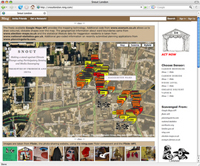
Snout Performance
Images from Tuesday's Snout performance around Hoxton, London can be viewed on our Flickr site and we are pleased to announce the prototype 'scavenged' sensing and public authoring site for Snout is now live. View the sensor traces collected during the performance together with other local information and links to ways to stimulate local conversations and action.
Social Tapestries will be publishing the technical documentation for the Snout sensor hardware and software (an updated version of last year's Feral Robots sensing system) later this summer, along with video documentation and a Cultural Snapshot exploring Snout's concepts and ideas – a recipe for others to create their own participatory sensing events and websites for bringing communities together to discuss and act on local issues.
Posted by jo at 12:23 PM | Comments (0)
April 11, 2007
[-empyre-] Brooke Singer: Thoughts on the topic

TechnoPanic: Terrors and Technologies
"... In the last several years I have seen the rise of work termed "Locative Media" and my own work is sometimes grouped in that category. I usually ignore labels but this one is particularly bothersome to me because there is a trend here to collapse this ever-growing field of terror technologies into infotainment objects. This gets to the issue of what Tim calls the "ambivalent attraction to technologies of terror" and, as Horit questions, "what is the relationship between the production of art by means of digital technologies and the production of terror by the same?" Locative Media (as with the term Web 2.0) is deceptive in its appearance of being simply shiny, fun and new. Yet, do we question computer art for its use of the digital computer, originally designed to quickly crunch numbers to project missiles more accurately -- wherein lies the difference? Is it only distance from inception?..." -- Brooke Singer, empyre. Read the full post >>
Posted by jo at 08:52 AM | Comments (0)
April 10, 2007
DEAF: Snack&Surge Brunch: Marked Up City
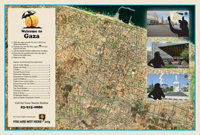
You Are Not Here.org: Gaza - Tel Aviv
Marked Up City: You Are Not Here.org: Gaza - Tel Aviv :: Hosted and introduced by Nat Muller (NL) :: Saturday 14 April 2007, 11:00 – 13:30 hrs :: Location: V2_Studio :: Entrance: € 7,50 :: LIVE STREAM (REALVIDEO) - 14 april, 11:00-13:30 (Clicking on the above link before the indicated time will result in an error message!) This live stream can be viewed with the free RealPlayer.
Cities are more than their streets and squares, their commerce and inhabitants: they are part and parcel of a whole economy which brands and markets "the urban experience" to us as a commodity. Tourism is of course the latter's most logical instrument: more often than not we are sold a sugar-coated product, which discards the dynamics, frictions and population groups, which make up the city proper. Marked Up City dips into the belly of city branding and urban tourism... with a twist.
You Are Not Here.org (YANH), urban tourism mash-up project by artist Thomas Duc (US), media activist Mushon Zer-Aviv (IL/US), interaction designer Kati London (US) and new media hacker Dan Phiffer (US) :: Laila El-Haddad (PS/US), journalist and writer :: Merijn Oudenampsen (NL), specialises in issues concerning flexibility of labour, precarity, gentrification, and city branding.
The SNACK & SURGE Brunches create a performative and gastronomic theatre of operations addressing political, technological and artistic questions relating to the poetics of power. We invite the DEAF audience to kick off their day pondering the aesthetics, actions and media of resistance and critique. Part hang-out, part culinary experiment, SNACK & SURGE intends to be a caress for the palate, an opener for the mind, and a rebelliously festive wake-up for the mood.
Rise and start your day deliciously: biting at the poetics of power!
Food by: anders eten.com
Posted by jo at 01:34 PM | Comments (0)
April 06, 2007
Upgrade! Brussels/Ghent

On Public Space and Sound Practices
Upgrade! Brussels/Ghent: On Public Space and Sound Practices :: We examine and discuss meshed networks in public space. Artist networks reappropriate public space by means of sound, and comment and annotate public space by soundtags. Can we speak of hybrid transmission spaces? Do these mobile modes of exchange provoke new creative practices? Project presentations by Tapio Mäkelä; Justin Bennett; Sarah Washington and Knut Aufermann. Discussion moderated by Annemie Maes and IRC chat by Dusan Barok.
Tapio Mäkelä: My first radio project was called Sound Calendar in 1994 with artist association MUU. Sound Calendar consisted of 24 sound pieces by participating artists, broadcast before morning and evening news on Finnish national radio and through intercoms at eight Finnish railway stations. My own piece in the work made me an accidental radio hacker as it caused a shut down of the entire Finnish radio network for approximately 10 minutes. My interest in hybrid uses of radio has to do with combining Internet radio with listening or participatory interfaces in public spaces.
I am currently developing “Translocal radio workshops” in two locations in the Barents Sea region. Inter-connected artist led workshops in Kirkenes (No) and Murmansk (Ru) bring together media and sound artists and community groups to develop content locally and across the border. The work is presented through public events and temporary listening environments as well as through Internet radio and temporary FM. The workshops are planned for late summer this year and Spring 2008.
In the summer of 2008 a fourth Polar Circuit workshop will take place in the Baltic Sea. Concept:Islands, among other topics, invites participants to experiment with radio and mesh-up networks and alternative energy solutions. In both of these workshops I am working on a sound archive with geo-annotation, not with an interest of GPS as such, but how the location of samples and interviews can also be a meaningful archival interface.
Justin Bennett is an artist and composer working with sound and visual media. While living in Sheffield in the 1980's he colllaborated with bands such as Hula, TAGC, and Fabricata Illuminata. Since 1989 he is based in the Netherlands. Bennett is best known for his work with field recordings, which he uses to create installations, soundwalks, CD-releases and live performances. Much of his work is concerned with urban space and the relationship of sound to place. In the last few years he worked with GEM Den Haag, the CCS, Paris, the Guangzhou Triennial, moorroom Roma, Sonic Arts Network, UK. Upcoming projects include a permanent sound work for a public space in The Hague and a text-based piece for a park in Luxembourg. He collaborates with, among others, BMB con., Renate Zentschnig, Grand Mal, 242.pilots, Kreutzerkompani.
Sarah Washington and Knut Aufermann talk about the radio lives and works that have been encountered by in their last one and a half years on the road around Europe. Working in more than a dozen countries and meeting people from all over Europe, visiting their projects, doing workshops and participating in radio conferences, festivals and live-to-air events, has give these 'radio gypsies' a unique overview of the state of experimental radio activity across Europe today. In this presentation they will also give you a taste of their own approach to radio production, and demonstrate how their ongoing enthusiasm for the medium allows them to develop singular radio events in cooperation with others.
Posted by jo at 11:39 AM | Comments (0)
SPACE2/ | Transcendence

A Psychocartography of Conceived Presence
(Oslo, 03.04.2007) Following the success of the installation Space2 at ROM for Art + Architecture, its new location is now at Euklides (Pilestredet 75C, Oslo). Space2 is the continued development of Transcendence, developed by the Norwegian architectural laboratory SERENDIPIT:US (Eli Goldstein & Kjersti Wikstrxm) at Dispatx Art Collective.
During 2 simultaneous journeys in Berlin and New York, an archive of experience (atlas of emotion) was established. Through conceiving presence, the project Transcendence crystallizes the condition of sensing one space while imagining / conceiving the presence of another - a process that mirrors the shared experience of being in two places at the same time, whilst co-existing in the shared virtual space.
Hundreds of visitors from architects and artists to established writers, sociologists, anthropologists and philosophers have experienced the playful and interactive installation in the past three weeks. Space2 has a critical focus on the processes and procedures of design - constituting in a methodological experiment within the borders of art, architecture and research.
Focusing on the creative method - the organisational process that translates creative vision to creative product - is fast moving beyond online curatorial platforms such as Dispatx. The Norwegian Architecture Association (NAL), the Association for Interior Design, and KHIO, the Oslo School of Art, have all expressed significant interest in SERENDIPIT:US as a result of this work.
Euklides is focused on crossing borders between art & design, looking to make anti-standardized products and building commercial models related to them. For SERENDIPIT:US, this touches on some of the main reasons for engaging in the study of subjectivity, personal habitats and spatial values, as well as these factors' role in the perception of space and in generating new spaces or objects. Focusing on methodology and analysis in generating and exploring real or imagined spaces, their work approaches phenomenological aspects of spatial conditions.
Dispatx Art Collective is a curatorial platform for the development and presentation of contemporary art and literature.
Posted by jo at 11:19 AM | Comments (0)
April 04, 2007
Participatory Urbanism
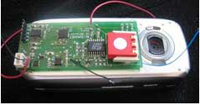
Phone as Environmental Instrument
Last week in Oslo, i attended a very inspiring talk that Tom Igoe gave at the Oslo School of Architecture. He presented open source ideas and explained their impact on the way we think about space.
Among the projects he showed was Participatory Urbanism, a work by Eric Paulos, Ian Smith and RJ Honicky that turns the mobile phone into a “networked mobile personal measurement instrument."
On the one hand, there's a sophisticated device, the mobile phone, which provides us very little insight into the actual conditions of the terrain we traverse with it.
On the other hand is the fact that we must defer to a handful of civic government installed environmental monitoring stations that use extrapolation to derive a single air quality measurement for an entire metropolitan region. Such data doesn't reflect the dynamic variability arising from daily automobile traffic patterns, human activity, and smaller industries.
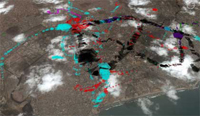 [Left: Carbon Monoxide readings made with taxicabs across Accra, Ghana] The goal of Participatory Urbanism is to provide mobile devices with new “super-senses” by enabling sensing technologies such as noise pollution, air quality, UV levels, water quality, etc. to be easily attached and used by anyone, especially non-experts.
[Left: Carbon Monoxide readings made with taxicabs across Accra, Ghana] The goal of Participatory Urbanism is to provide mobile devices with new “super-senses” by enabling sensing technologies such as noise pollution, air quality, UV levels, water quality, etc. to be easily attached and used by anyone, especially non-experts.
Integrating simple air quality sensors into networked mobile phones promotes everyday citizens to uncover, visualize, and collectively share real-time air quality measurements from their own everyday urban lifestyles. This rich people-driven sensor data leverages community power imbalances, and can increase agency and decision maker understanding of a community's claims, thereby potentially increasing public trust.
Other projects Tom Igoe presented: Public Air Quality Indicator, Area's Immediate Reading and i'll add Neighbourhood Satellites. [blogged by Regine on we-make-money-not-art]
Posted by jo at 03:38 PM | Comments (0)
April 02, 2007
Judgement Day for 1st Life Game Figures
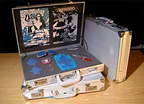
Tagged City Play for Real Players in Real Cities
The Ludic Society's Tagged City Play for Real Players in Real Cities was recently presented at Social Hacking, a series of temporary public art commissions for the city of Plymouth (UK).
Attracted by the slogan Become a game figure by implant!, participants were invited to get an injection of “RFID Judgement tags” under the skin. They then become Real Players, 1st life personae who are also game figures in the Reality Engine while playing in a real city. They can drive tuned Plymouth racing cars to tag the city and receive a tagging toolbox containing graffiti, spray stencils, stickers, RFID stickers and implant injection kits.
Real objects in the city are subjectively chosen for tagging. The tags are functional but useless (RFID-tags with zero data.) By putting this zero-tag on an object, players de-valuate real world things into virtual play-objects. If the Real Players find a tagged object with a value assigned to it, they zap it. The goal is to change the value of tags into the value Zero by using their “Wunderbäumchen” (inspired by the car air fresheners in the shape of a pine), technical toys used for finding and reading tags and/or emitting a target-oriented electro magnetic pulse..." Continue reading >> [blogged by Regine on we-make-moeny-not-art]
Posted by jo at 11:30 AM | Comments (0)
March 27, 2007
Vague Terrain
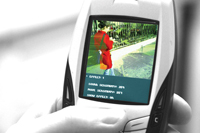
Locative
vague terrain: locative: Why is location interesting? Several years ago, I inherited a broken television set from my grandmother. I had little use for a TV that displayed everything in shades of green, and so it stayed in the attic. It was only when I was later preparing to move that I decided to turn it on. What I found when I turned the dial to the highest UHF channel was that the TV picked up what sounded like eight simultaneous cordless phone conversations. I could barely decipher anything in the cacophony, but it did make me wonder who these people were, where they were standing as they were speaking these words, if these conversations were passing through me, and if they knew I was listening.
I have to thank both Greg J. Smith and Neil Wiernik for inviting me to be the first guest editor. Neil and Greg have both done an enormous amount of work on the journal since its inception. Their efforts are creating an amazing archive of the state of the arts during this nascent period of technological curiosity and exploration.
Even though the digital age has been around long enough that we possess theorists' interpretations of its implications, it's almost as if artists are only just wending their way through these new ways of communicating, and it's this excitement of exploration that's palpable in the art work. Projects that begin with an exclamation of "oh, neat!" quickly give birth to perspectives that come to reshape our understanding.
When I was first asked to edit the journal, it was to be on the subject of mobile technology due to my experience with projects such as the Warbike, an artwork that creates music from WiFi networks through which a cyclist rides. But to consider mobile technology is not to marvel at the ability to watch TV on one's cell phone—merely shifting content created for one medium to another—it is to consider the implications of our new-found ability to take it with you. Watching TV on the subway is not the same thing as watching TV in your home.
The latest PDA and cell phone developments are easy targets for theorising about mobile technology, but a device as simple as Sony's Walkman in 1979 drastically altered the ways in which people communicate in public. Although it innocently allowed you to take your music out of the home, it actually created an entirely new set of communicative gestures using headphones: disregard for others by playing music too loudly, taking headphones off to signal an openness to engage verbally, putting headphones on to avoid contact in public.
What changes when we take it with us? The parameter is space, or place. The term locative, in many ways, gives one the impression of a device with some artificial intelligence that allows the little thing—if I'm forgiven to personify our cute gadgets—to know something about the space in which it's situated or moving through. Of course, artificial intelligence, especially confined to the current power of mobile processors, is nowhere near smart enough to truly understand anything about space. It cannot contextualise the same way that you or I would if placed in a foreign space. What it does do is give us information based on the space according to the parameters and design that we've set up for it. It doesn't give us information outside of the media we've chosen, but this still allows for a great amount of surprise and discovery.
The renewed interest in space generated by mobile technologies such as the cell phone, and location-specific technologies such as GPS, has spread to areas beyond the high-tech. People are finding connections between their perceptions of space and those of the Situationists in the twentieth-century, and the wanderings of the Surrealists before them. Communities are forming psychogeography societies to explore their urban surroundings. Civic interest and concern in urban centres is not only healthier than ever before, but gaining momentum.
Several of the projects in this issue deal solely with the radio spectrum and eavesdropping as a means of understanding the human facet of their immediate surroundings. This is a technology that has existed for decades. But the discourse generated from the interest in more sophisticated technologies has allowed us to contextualise the implications of older technologies and our perceptions of space, especially the blurring of public and private spaces.
Each of the projects featured in this issue deal with space in several manners. It's the synthesis of the experiences and understandings created by many focussed projects that allow us to understand not the gadgets' relationship to space, but our own.
The explorations of ssim-el and Sawako's 2.4Ghz Scape examine the invisible layer of communications that passes through public space unbeknownst to us.
The Context Photography project follows a traditional approach to locative technologies: using the technology to help us better understand aspects of the space. Evamaria Trischak's 4816 also touches on this, as well it and and Patricia Rodriguez's cell phone videos explore technology as medium for our conduct: although it provides insight, at the same time it imposes limitations through its structure that may hamper our ability to understand space.
Mobile technology is also an enabler, either helping to create new forms of narrative not previously possible, as with knifeandfork's Hundekopf, or to foster community and civic interest, as discussed in my interview with Île Sans Fil's Michael Lenczner.
Finally, the articles of Marc Tuters and Jeremy Hight question our definitions and understandings of the field of locative technology, its possibilities, and its future.
Thank you very much to all of the contributors who made this issue possible not only through their projects, but also with their co-operation in compiling all of the information. Feel free to send any comments my way to locative [at] vagueterrain [dot] net, and please let the contributors know how their work engaged you.
david mccallum
Posted by jo at 01:31 PM | Comments (0)
March 14, 2007
Franck Ancel's Triptych
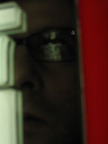
5/5 + 5C + 5G
5/5: In 2004, Franck Ancel completed a triptych on architecture, image and technology by projecting the words "Mobile Wireless Digital" onto the screen of the Montparnasse Tower in Paris. Today, under the title "5/5", he is projecting on the Théâtre de l’Agora à Evry, France his two projects "5C" and "5G", in connection with this line of research.
The trail presented here in the shape of a diptych challenges known and recognized limits, and the outdated boundaries of the past. These documents trace the use of a special form of GPS tracking based on a real experience, that of a separate journey, while also questioning virtuality in the age of world globalisation. Therefore, it is not about abandoning criticism of technological uses to technological uses of criticism. After all, it is through a person's very existence that the temptation to understand the space of his or her time arises, and this forms the focus of this presentation, in which a particular journey becomes an objective creation.
5 Continents (5C): Between 18:00 and 19:04 hours, Paris time, on Saturday 17 December 2005, the first artistic creation from an in-flight passenger plane took place. It was transmitted live over the Internet during a flight from Shanghai to Munich, at an altitude of 30,000 feet and at a speed of over 900 kilometres an hour. This live transmission at "X" moment was the culmination of a series of 5 communications "From Scenography to Planetary Network", for and on 5 Continents.The transmission was posted in real-time on our website, via a wifi satellite link relaying images and sound from the plane. This performance was made possible thanks to Lufthansa's offer to provide FlyNet with Boeing's in-flight online connectivity service, Connexion by Boeing.
This webcast makes a formal nod to the sleeper John Giorno, the poet of "Sleep", a legendary film for the Neo avant-garde art movement made by Andy Warhol in 1963, New York. This time round, a sleeper has left the Asian New York of tomorrow. This world first lasted 64 minutes. In the video recording 64 key words appeared in a combination of 12 interplays on five themes (five continents, colours, senses, elements, years), initiated with an eye to the forthcoming 2010 World Expo in China.
5 Guggenheims (5G): In 2006 we collected data in front of the 5 Guggenheim museums. The traces of this journey echo the possible virtual construction of a space on a planetary scale symbolised by these museums. The shift from a fluid virtual architecture to a constructed reality takes shape in the form of a 3D video animation created by Bryan Bey and a resin model created with 3D prototyping, made in collaboration with the IDO creation company from the elements we had gathered together. 5G is made up of photos and GPSb.
Posted by jo at 11:03 AM | Comments (0)
March 13, 2007
Digital marks
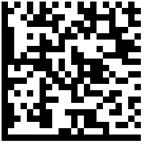
Augmented Realities
A little bit on digital marks, I selected a variety of them.
The semacode, a two dimensional code that encodes a URL. The picture (left) is the semacode of architectradure. Thank you Michael Surtees for the link! This tag embed the URL address of my blog, that can be read by your cell phone and send you to its page. I guess it avoids typing in the URL and you can rapidly go through a series of web sites using the respective tags.
It is especially useful for combining physical space to digital content. The Semacode's Software Development Kit has is developed for ubiquitous computing by creating visual tags for objects and contexts, and read them using a mobile camera phone. The physical Wikipedia called Semapedia, created by Alexis Rondeau and Stan Wiechers, allows you to add place tags on places and things to link them to the relevant Wikipedia articles.
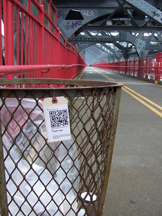 [images: trash can with a wikipedia tag] Semacode technical paper.
[images: trash can with a wikipedia tag] Semacode technical paper.
Urban Tapestries allows public mapping and sharing by combining mobile and internet technologies with geographic information systems. This system was linked to Natalie Jeremijenko's famous feral robots -open source robots for investigating contaminated urban sites- and called Robotic Feral Public Authoring: "Adding the sensor readings to online mapping tools, such as Urban Tapestries, suddenly brings the relationships between environment and home vividly to life. It enables people to feel they can learn about their environment and have the evidence to do something about it"
Yellow Arrow allows a community to tag places using arrows. You can post a message using the arrow and anyone could retrieve it using their cell phone. Another method to link digital content to a physical place. The community of yellow arrow is quite big. Their blog.
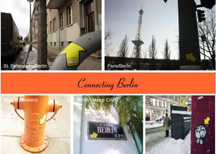
Elens allows anyone to create talking landmarks. Developed by the MIT Media Lab it allows anyone to tag a place by adding a sticker on a physical location, sticker that can later be scanned by a cell phone, in this case the Motorola A1000.
M-views developed at the MIT media lab in the interactive cinema group -media fabrics- with Glorianna Davenport, explores the "ideas, methods, and culture of mobile cinema, which is experienced in temporal and spatial narrative segments that can be delivered on context-aware mobile devices."
In 2002, I researched with Glorianna Davenport on technologies to allow digital information to communicate with the physical space. I worked on Passing Glances a system that enables users to create ambient urban interludes through the use of SMS text messages. Associated graphics and storytelling were projected in the urban space.
CHI'04 paper
Enarrative5 2003 paper
With these tags, the physical space is tagged to the digital space. One can think the other way around and tag the virtual space with physical content. That is what Josh Lifton told me he was working on the other day. Josh created a plug sensor/actuator network, called the dual reality lab, that links the MIT Media Laboratory space to a virtual lab space in the Second Life online virtual world.
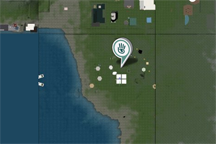
[left: Location of the MIT Media Laboratory in Second Life] More info technical about the plug. [blogged by Cati Vaucell on Architectradure]
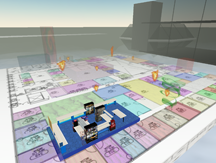
["Dual reality" is the concept of maintaining two worlds, one virtual and one real, that reflect, influence, and merge into each other by means of deeply embedded sensor/actuator networks. Both the real and virtual components of a dual reality are complete unto themselves, but are enriched by their mutual interaction. The dual reality Media Lab is an example of such a dual reality, as enabled the Plug sensor/actuator network that links our actual lab space to a virtual lab space in the Second Life online virtual world.]
Posted by jo at 01:30 PM | Comments (0)
March 12, 2007
UPGRADE! AMSTERDAM:

[TAG & TRACK}
UPGRADE! AMSTERDAM: [TAG & TRACK} :: When: wed. March 21st 2007 || start 20.30 hrs. / doors: 20.00 hrs. :: Where: Melkweg, Theater, Lijnbaansgracht 234 A, Amsterdam | free entrance | LIVE webcast: www.fabchannel.com
'Locative media' are hot: from cell phones to GPS, to other means of satellite communications. A world without the latter seems unthinkable, or perhaps even non-navigationable. Experiments with locative media within the arts have mostly focused on and taken place within an urban context. Upgrade! Amsterdam [tag & track] offers a counterbalance and highlights projects where the technology itself is not the main feature, but rather how their usage functions within specific contexts, and generates a multitude of meanings and experiences: from Fulani nomads in Nigeria to what the migration mapping of Montagu's Harrier brings about between ornithologists from Groningen and farmers in Mauritania.
Introduction to the theme by Assia Kraan: Recently Assia Kraan wrote an article on locative media for 'Open - magazine for art and the public domain', titled 'Public action through geo-annotation - social encounters by ways of locative media arts'. Her introduction to this Upgrade! [tag & track] will be a continuation of this article focussing on narrative possibilities of locative media and the sence thereof.
Nomadic Milk - Esther Polak - Michiel de Lange: Nomadic Milk is about mapping migration patterns of Fulani nomads as that of the diary industry their milk is processed by. Nomadic Milk visualises both social entanglements and mental maps of the two systems.
Capturing the migration of Montagu's Harrier - Ben Koks c.s. Not even as much the data produced by the tiny 7 gram satellite backpacks of migrating Harriers between the Netherlands and Mauritania, Senegal and Nigeria is of interest, but more the narratives arising from it among the Dutch ornithologists and farmers in Western Africa. http://www.grauwekiekendief.nl
After the presentations there will be a panel with Assia Kraan, Ben Koks, Esther Polak, Just van den Broeke and Michiel de Lange, moderated Lucas Evers. Just van den Broeke will be present at this panel since he has been involved in numerous projects working with a variety of locative technologies. http://www.justobjects.nl
UPGRADE! AMSTERDAM is a series of gatherings for and by new media aficionados, artists, geeks, media makers and breakers, and the generally curious. Point of departure is the premise: "No upgrade without a downgrade." UPGRADE! AMSTERDAM is organised by Nat Muller & Lucas Evers, is actively hosted by de Melkweg, and kindly supported by VSB Fonds and Mondriaan Foundation.
UPGRADE! is an international, emerging network of autonomous nodes united by art, technology, and a commitment to bridging cultural divides. Since April 1999, a group of new media artists and curators have gathered in New York City. The first meeting took place at a bar in the east village with Tim Whidden & Mark River [MTAA], Mark Napier and UPGRADE! founder Yael Kanarek.
Posted by jo at 12:33 PM | Comments (0)
March 07, 2007
G-Turns

Satellite Scratch
After the GP4, a player that uses the earth as a disc and its portable version the G-POD, BRAND is launching a range of brand new softwares. The first one, G-BEE (Global Beeliner), allows you to create direct sonic connections between two arbitrary locations on Earth: select two places (just avoid water surfaces as they are silent), pick the duration (5, 10 or 15 minutes of a selected satellite), and order the music.
The G-ONE (Global Orbit Navigation Engine) invites you to virtually hop on a satellite and scratch across the Earth's topography, just as the needle of a record player scratches across a record. The satellites (there are more than a thousand of them) and their orbits are real and calculated in real time. You can also subscribe to a daily thirty minute podcast of satellite scratch.
It's only recently, when i met Jens Brand and his collaborator Sukandar Kartadinata, that my doubts were confirmed: Brand's g-playing works are essentially tongue-in-cheeck. If you still have any doubt about that, just try to apply for an I-God membership card gold.
This month, Jens Brand is presenting his work in Oldenburg for SOUND//BYTES, an exhibition about electronic and digital soundworlds, Berlin and Luxembourg during the Festival Musique Visuelle. [blogged by Regine on we-make-money-not-art]
Posted by jo at 08:30 AM | Comments (0)
March 06, 2007
Word Finder, Google Earth Edition
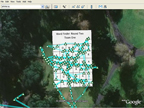
1st Life / 2nd Life Game
Julian Bleecker writes: This is a 1st Life / 2nd Life game that is based on paper-based word-finder games. In this game, you try to identify dictionary words within a grid of letters and circle them. In this variation, the landscape becomes the game grid and you have to walk (or run!) to generate a virtual line that runs through the letters in order to "capture" the word and score points. A GPS is used to help the team identify where the letters are in 1st Life space, and to "capture" the words composed of those letters by recording "track logs" through them. The GPS is able to record where you are in 1st Life, and to create "tracks" of locations, which are essentially connected points that make up lines on the GPS. These track logs can be seen as a way of geospatial drawing — the tracks you make delineate lines which can compose various forms of drawing. In our case, the lines are meant to create lines through the letters that make up the words. (Note that in the more traditional word finder games one circles the letters — that would be a bit tricky in this variation, so we'll just draw an approximate line _through_ the letters. Continue reading >>
Posted by jo at 05:03 PM | Comments (0)
February 24, 2007
Sakura_mapping system

Call for Participation
[posted by Yukihiko Yoshida] Sakura_mapping system is a mapping system that can make visualization of "Sakura (Cherry blossom) front" on satellite image. "Photograph of cherry blossoms" and the location information are contributed with mail. You can see it with Google Maps and Google Earth. (Sorry, Text is Japanese only) http://mapping.jp/map/sakura_gmap.html http://mapping.jp/sakura_mapping.kmz
You can participate by sending the cherry blossoms image with mail. Please add GPS information to exif header of the image. map07[at]mapping.jp We are waiting for the contribution from countries other than Japan.
Cherry blossoms are national flowers in Japan. This is a non-profit-making project, co-sponsoring of arbitrary group "Green photon" and "Committee of Earthday Tokyo". It is possible to participate from all...cellular phone with GPS, usual cellular phone, and PC. In Japan, the location information is judged from the mail text when there is no GPS information.
Posted by jo at 04:03 PM | Comments (0)
February 19, 2007
In-Site Montréal

Hotspot Interventions
In-site Montréal: Curator’s statement by Michelle Kasprzak :: In-Site Montréal is a collection of site-specific art presented on the portal pages of five wireless internet (Wi-Fi) hotspots in Montréal. Artists Nicolas Fleming, Maria Legault, and Virginie Laganière have created artworks that may be viewed when users of the free service provided by Île Sans Fil log in to their accounts at the selected hotspots.
The five hotspots are rooted in specific spaces, each one with its own unique properties. The In-Site Montréal project grew out of a desire to augment the experience of place for Wi-Fi users, offering an additional layer of information within the hotspot environments. The artworks that are presented on the portal pages are inventive responses to the characteristics of the spaces that the hotspots inhabit.
“The window appears to look out onto a dataspace that continues beyond the borders of the window itself. [...] But the illusion quickly wears off. The window starts to feel more two-dimensional, more like a piece of paper than a portal. The view-space appears to flatten out, to the point where the window and the data contained within the window merge.”i
Here Steven Johnson is describing the effects of using a scrolling window on a computer screen for the first time, and I am referring to it (ever so slightly out of context) to illustrate a point about the works that are being presented within In-Site Montréal. The users of the Île Sans Fil wireless network are, arguably, all hardened internet users, for whom the complexities of scrolling windows and portals and most other graphical user interface-related things are trivial.
However, since they have reached the secondary stage that Johnson refers to, where the “window and the data contained within the window merge”, there are certain expectations for an experience that can keep pace with their ability to leap from hyperlink to hyperlink.
Portals, by and large, are clumsy. The portal that occasionally pops up on my screen, which is associated with my Hotmail account, assumes I am interested in all manner of celebrity gossip and sports scores, and regional news for an area that is 45 miles to the west of where I currently live. But the works presented as part of In-Site Montréal are not attempting to form part of a portal experience that would guess the preferences of each user. The works are dealing directly with the particularities of the site where the hotspot is, which is a small enough area to be clearly defined as a common element in each user’s experience. For the elite users, something at last may jump out at them from this flattened dataspace where things feel as twodimensional and familiar as a piece of paper. Instead of the usual hurried clicking to get past a familiar “roadblock” and get to the destination they intended to go to, they may now feel that the artists of In-Site Montréal have added an observation on their local café, library, or artist-run centre that matters, that they can respond to, that strikes them out of their reverie.
“A provisional conclusion might be that in advanced art practices of the past thirty years the operative definition of the site has been transformed from a physical location —grounded, fixed, actual— to a discursive vector—ungrounded, fluid, virtual.”ii
Parts of this definition of site – fluid, virtual – are key concepts that that In-Site Montréal works with. The layer of information that floats on top, as a meta- layer to the usual experience of café users in the Île Sans Fil network is meant to be something a bit fluid, virtual and unexpected. The only definition that it does not fit is that of “ungrounded”, precisely because it is the grounding in the site that sets this project apart. Maria Legault’s interventions with her Free Sugar project may be considered particularly grounded in the sites in question. She worked with two locations, Studio XX and Café Utopik, and developed an extension of her Free Sugar project around both locations. At Studio XX, a feminist art centre that primarily consists of an office space and computer lab, she created a performance event entitled the Free Sugar Salon, that was open for anyone to attend and have the holes in their lives filled with pink pudding. She filled cracks in the architecture of Studio XX with pink icing, and then turned her attention to the attentive public that arrived at the studio, counseling them and filling their mouths with pink pudding to console them. At Café Utopik, a café/bar that regularly hosts bands and spoken word events, she conducted a surreptitious intervention, filling crevices and holes in the architecture and surrounding environment of the Café with pink icing, and documenting it in photographs. Both of these projects are presented on the portal pages of Studio XX and Café Utopik as video documentation of these actions.
Artist Virginie Laganière focused on two very different areas: the Jean-Talon Market and the area around the popular meeting place, Café Utopik. Her site-specific video pieces were shot with regular video cameras, as well as custom camera rigs attached to her body. She then manipulated the footage further in the editing suite, adding her own compositions as soundtracks and prolonging moments that happened oncamera, providing us a moment to reflect on their significance. She specifically chose to document moments where people were not as present in these spaces, and where the patterns of movement in the “off-peak” hours would become more apparent.
Through her augmentations in the editing suite, she also aims to create a piece of work that allows us to see beyond our usual clouded and harried view of the urban environment, and enjoy a view of the built environment that is tranquil, constructed, and part of an aesthetic experience. In particular, her video piece presented on the portal page of the Jean-Talon Market, usually a place so buzzing with activity as to be nearly impossible to navigate, was shot in the very early hours of the morning, when market stall owners are setting up. This meditative and slow period of the Market’s activity is hidden from most of the Market’s patrons, and Virginie’s artful editing brings out the poetry in the stasis of these moments.
Nicolas Fleming's performance art videos also present us with an alternate view of our public spaces. His work is presented at Café Kafeïn and Laïka, because of both the subject matter that he chose and the locations that he performed in. At Laïka, an extremely popular and hip bar/restaurant/club, he presents se traîner, a piece wherein he drags himself out of his apartment (which is within the same building complex that Laïka is in) and down the stairs to an escape portal – an automatic garage door. Throughout the performance he can be heard grunting with the strain of moving himself in such an unconventional way, and by the end of this performance, he is clearly exhausted. Users viewing this video must marvel about this strange and strenuous test to his body, that took place in relative secret behind the scenes of the Laïka’s festive décor. In the other piece, traîner un dj, Fleming travels to Île Sainte-Hélène to encase a dj in a canvas sac, and drag him along the pavement, with the sounds of Piknic Electronique (Montréal’s outdoor summer dance club) pounding in the background. This work is presented at Kafeïn due to the dj culture that is resonant there; the dragging of a dj must be somewhat humourous to the clientele.
Telematics is a term used to designate computer-mediated communications networking involving telephone, cable, and satellite links between geographically dispersed individuals and institutions that are interfaced to data-processing systems. It involves the technology of interaction among human beings and between the human mind and artificial systems of intelligence and perception. The individual user of networks is always potentially involved in a global net, and the world is always potentially in a state of interaction with the individual.iii
The virtual spaces that In-site Montréal inhabit are amorphous areas around several accepted gathering places such as cafés, galleries, markets, and bars. They are perhaps places where as an internet user, you may intend to use the opportunity of connectivity to the network to look outward, to read news of distant places or connect with friends far away through e-mails and online social networking sites. The art practice of telematics in particular addresses the creative possibilities when two parties are connected over distance to communicate. In some way, the pieces presented on the portal pages of Île Sans Fil’s network as part of the In-Site Montréal project present something that is almost anti-telematic, in that the works look inward rather than outward. In the case of this project, a connection to someone across the globe is not sought, it is shunned in favour of a further examination and rumination on the details of the local environment. A local resident, who is perhaps used to the culture at Café Utopik, may be best able to chuckle at the video of pink icing being added to the sign above the door. This intense inwardlooking that these pieces commit to is the essential point of the project. Instead of seeking to look outward and connect with others who are in a radically different geographic space, In-Site Montréal hopes to reconnect locals with their own space, through the language of culture, compelling users of the network to turn their gaze inward enough to consider the cultural resonances that are possible.
- Michelle Kasprzak, 2006/2007
i Steven Johnson "Interface Culture: How New Technology Transforms the
Way We Create and Communicate" 1997 Harper Collins, New York. Pg 86
ii Miwon Kwon, One Place After Another: Notes on Site Specificity, October 80 (Spring
97): 95.
iii Roy Ascott: “Is there love in the telematic embrace?”
http://www.receiver.vodafone.com/07/articles/03_page01.html
Posted by jo at 04:05 PM | Comments (0)
February 16, 2007
You Are Not Here
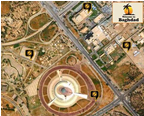
Reviewed by Luís Silva
"From a strict physical, corporeal point of view, ubiquity is an ontological impossibility. For as much as one would like, being in two places at the same time, for instance, the city of New York and the city of Baghdad, is not possible to accomplish. Only electrons, netart and god have the uncanny ability to present themselves in several places in one given moment.
You Are Not Here departs from and builds itself from this inability. Developed by Thomas Duc, Kati London, Dan Phiffer, Andrew Schneider, Ran Tao and Mushon Zer-Aviv and inviting people to “explore Baghdad through the streets of New York”, YANH presents itself as an urban tourism mash-up. Not only can you be in two places at the same time (the ubiquity concept we departed from), but also both places become interconnected in a psychological enactment of a meta-city. The underlying mechanism is pretty simple: users (the so-called meta-tourists) are invited to download and print on one side of a sheet of paper a map of Baghdad and on the other side a reversed map of New York. As soon as that task is accomplished the exotic sightseeing can begin. Scattered around New York are YANH street-signs that provide warned explorers (those who printed the map) as well as random passers-by the telephone number for the Tourist Hotline, where audio-guided tours of contemporary Baghdad destinations in NYC can be listened to." Continue reading You Are Not Here - You Are Not Here by Luís Silva, Furtherfield.
Posted by jo at 05:17 PM | Comments (0)
Proboscis
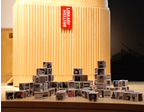
London As We May See It
On Wednesday February 14th 2007 Proboscis presented a new 'map' of London as part of "Uncharted Territories: the Brave New World of Mapping" at the British Library, London.
London As We May See It is the city re-imagined through a landscape of 105 StoryCubes. Each one has 5 pictures taken in a particular street or place (as well as an image of the street sign). The StoryCubes can be assembled together – connected – in any way in three dimensions to describe the route of a walk, or the places one has lived or worked in. They can describe experiences one has had across the city or the places in which one has made friends, had trysts with lovers or where we seek solace and rest from the manic energy of the city. These cubes could also be used to create a shared map between a community or group of friends - ever evolving and changing with each person's contribution.
The pictures used in the map were all contributed to the group photoblog The Way We See It. Thus the map is organic and can grow alongside the photoblog, adding new StoryCubes as new streets are photographed and 'mapped'.
"London As We May See It" is the beginning of a new series of collaborative mappings of places and communities in the UK and abroad by Proboscis. As such we hope it could be the basis of or model for a tool of engagement within a community, or across different communities, combining the ease of new digital technologies, for capturing and sharing images, with familiar technologies (print / paper based) that result in tactile and tangible spaces of their own for telling stories and sharing knowledge and experiences. More pictures and details are available here. Buy your own Blank StoryCubes here.
Posted by jo at 08:51 AM | Comments (0)
January 26, 2007
Biomapping Brixton

Workshop
Biomapping Brixton-How do you feel about the area that you live in? Which areas do you have a physical and emotional response to? The Hayward are running workshops with artist Christian Nold to create bio maps of areas in Brixton and Clapham. These workshops are FREE and promise to be a fascinating insight into your community
The Bio Mapping tool allows the wearer to record their Galvanic Skin Response (GSR), which is a simple indicator of emotional arousal, in conjunction with their geographical location. This can be used to plot a map that highlights points of high and low arousal. By sharing this data we can construct maps that visualise where we as a community feel stressed and excited. These workshops involve a walk around the area followed by a download session where your physical responses are downloaded and mapped on Google Earth.
It is strongly recommended that you register your interest beforehand as the number of participants has to be limited to a maximum of 10.
Meeting and download point:
Brixton - Monday 29 Jan. Meet at Brixton Library at 2.30pm
Clapham - Monday 12 Feb. Meet at Clapham City Learning Centre
For more information and to register your interest in either of these workshops please e-mail Paul.green[at]southbankcentre.co.uk
To find out more about the Southbank Centre's programme of socially engaged digital arts projects please visit.
To find out more about Christian's work and bio mapping visit:
http://www.biomapping.net or http://www.softhook.com
Posted by jo at 04:14 PM | Comments (0)
January 09, 2007
Dune & Devil
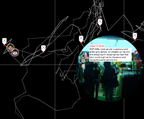
Tracking Vienna + Tokyo through Dune+ Devil
Dune & Devil (2003-present) explores a space- and time-based phenomenon through communicational technoculture. The aggregation of «•» applies different structures like global positioning systems, audiovisual media, mobile technology, tele-communication tools and specialized software, to experience the stereotopographical synchronization of two individuals in different urban situations. We are trying to translate this spatial experiment under the condition of a unique geosocial application to translate this individual, cultural and technological impact in our DIY-habitat. The project produces a sociographic disposition of a mixed reality which can be observed through the interface of dune-n-devil.com.
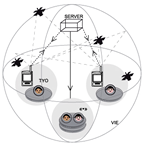
We are using two handheld computers with additionally installed open source java virtual machines (btw, thanx to mr. freebeans/japan for preparing mysaifu!) on a windows mobile operating-system. A specially, for this project, self-developed java application, is used to interconnect the two mobile computers via UMTS/GPRS for communication and navigation. The incoming GPS-data is streamed to a mysql database which collects all data produced (both outputs: Dune/Vienna and Devil/Tokyo). At last, the database provides the flash application for the visualization of the project «•» on the website.
Public space is constantly ehanced with new infrastructures of communication such as GPS, wireless internet, telecommunication protocols, location based services, mediatectures and many more. This modification of reality happens through the new possibilities of information-technologie, interface-culture and interaction. The basic goal of the communication based sychronization-system «•» is tracking digital processes in two different cultural situations (vienna & tokyo) through two different observers (Dune & Devil), and to merge this into one sensation. We are trying to translate this spatial experiment under the condition of a social application in a creative process of constructing new ways in media and art. Dune & Devil will incribe themselves into these connected, synchronized, totally different realities. This change of perspective through individual selection, dependent on the attention and the cross-link of these two realities, explain how space andt time are related to the observer and the system of observing.
Posted by jo at 10:31 AM | Comments (0)
January 07, 2007
Polar Wandering

A Continuous Line Drawing to and from Antarctica
Polar Wandering: Layla Curtis: After leaving London on Thursday October 27th 2005 Layla Curtis will spend the next 3 months carrying out an extensive psycho-geographical exploration as she travels through Madrid, Santiago, the Falkland Islands and remote islands in the Southern Ocean headed for Antarctica. Recording this journey using a personal GPS tracking device, Layla Curtis will create a continuous line drawing charting her passage to and from Antarctica. Regularly logging longitudinal and latitudinal data generated by the GPS system onto the website, Layla's movements will grow into an interactive line drawing embedded with photos, videos, sound recordings, and text. As the project progresses the live GPS drawing will develop into a complex data map through which viewers can personally explore this multimedia survey of the relatively sparsely mapped continent of Antarctica.
Layla Curtis has been awarded the 2006 Artists and Writers Fellowship Award, a joint partnership between the British Antarctic Survey and Arts Council England's International Artists Fellowships Programme. This project has been developed in collaboration with Locus+. [blogged by Martin Rieser on Mobile Audience]
Posted by jo at 05:53 PM | Comments (0)
December 27, 2006
"Big games" and environmental space
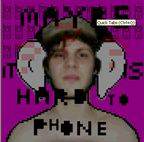
The Porous Border Between the Real and the Mediated
Parsing tons of papers, articles, documents and pdf that I accumulated in the last few months, I ran across this article in Vodafone’s Receiver: Big Games and the porous border between the real and the mediated by Frank Lantz.
In this short piece, the author describes what he means by “big games”, i.e. “Big Games are human-powered software for cities, life-size collaborative hallucinations, and serious fun“. Some excerpts I find pertinent regarding my research:
Imaginary places, constructed from code, are now being represented not just as pixel grid windows into synthetic 3D environments, but mapped onto the actual 3D environments in which we live. Called “Big Games”, these large-scale, real-world games occupy urban streets and other public spaces and combine the richness, complexity, and procedural depth of digital media with physical activity and face-to-face social interaction.
He then describes games such as ConqWest, Mogi Mogi, PacManhattan, Superstar, Can You See Me Now, Uncle Roy, Botfighters… And describes how the urge to use spatial environment as a playful space did not come out from the blue: children’s neighborhood games (like Red Rover, hide and go seek, and kickball or Capture the Flag), Assassin/Killer game, skateboarding and Parkour, location-based art activities of the late 20th century, Live action role-playing. And those activities share some common purposes:
a desire to push game experiences beyond traditional boundaries of time and space. But there is another, complementary desire within conventional computer and videogames themselves. Over the last 10 or 15 years, these games have developed a profound obsession with play dynamics of 3D spaces, architecture, and environments. (…) In some ways, Big Games are a natural extension of this obsession with environmental exploration and social dynamics as gameplay subjects.
The author hence describes how mobile and ubiquitous computing technologies are a catalyst for big games creation. And finally, his thought about spatial practices are very interesting:
There is no longer a clear, well-defined boundary between the virtual spaces and interactive systems of our digital experience and the concrete, tangible aspects of our physical experience. Even as high-resolution computer graphics make the simulated worlds inside our computers more realistic, the actual world outside our computers is behaving more and more like data.
(…)
Regardless of the technology with which they are implemented, Big Games reflect a change in perspective brought about by mobile, pervasive, and ubiquitous technologies. Even Big Games that use chalk on sidewalks to make a citywide puzzle, or appropriate the archaic technology of payphones to make a game of urban tactics, are made possible by a shift in how we perceive our environment brought about by the new relationship between space and computing. (…) Whatever else they are, these games are primarily about connecting people – a way to reclaim public space as a site for a new kind of shared experience.
Why do blog this? because it gives a very good summary of “big games”, which I am partly interested in my research (I use big games to study how people collaborate and use location-awareness features). On a different note, it seems that in the location-based/geowankin scene, the term “big” now receives more and more interest. See the “big here challenge” or how Fabien describes it (or even Matt Jone’s video!).
Finally, what the author stress in his conclusion (big games to reclaim public space), is exactly something Mauro and I wrote about three years ago in the following paper: To Live or To Master the city: the citizen dilemma or in this short pdf report I dropped on the web: Augmenting Guy Debord’s Dérive: Sustaining the Urban Change with Information Technology. The report only focuses on the use of LBS to foster new public space practices. [blogged by Nicolas on Pasta and Vinegar]
Posted by jo at 07:27 PM | Comments (0)
December 18, 2006
Two ITP Projects
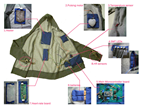
Worth a Look
Two interesting projects from the ITP (thanks regine!):
On one hand, MoPres: Sense and contribute to the ghosty presences around you by Jane Oh, Alex Bisceglie (see also their website):
MoPres brings out the residual presence of the people who occupied your current location. It is a geotagging project with the humanized ‘context’ of the locations. The raw data is from bio-metric sensers rather than the conscious, forceful, and mostly inaccurate logging which will provide a more creative and sophisticated flexibility of interpretation on the experiences of people
User Scenario: People wear the vest with embedded sensor package [heart rate and body temperature sensors], and the data is logged through the cell phone with geo tagging [gps and/or cell-tower id]. Once the mobile application reads the pattern of the data in relation to locations, it triggers the output devices embedded in the vest [heater and the pulse motor] with relevant residual patterns so that people can experience others’ past experiences at the given spot.
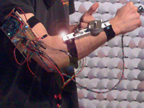
On the other hand: the personal range finder: A device used to navigate physical space without the aid of your eyes by Justin Downs:
The personal range finder is an assistive device that translates physical space into a tactile input on your arm. The goal of this project was to make an affordable mobile machine that is rugged, runs off a common power supply (9 volt battery) and easy to use. The range finder utilizes sonar to create a map of the surrounding physical space. This map is then translated to a scaled pressure gradient which is applied to your forearm. In this way you are able to “see” the surrounding 8 feet of space allowing for informed movement without the use of your eyes.
Why do I blog this? the first project is very interesting in the sense that it follows the trend “making explicit invisible/implicit phenomenon” in a nice way. Plus, I also like the lowtech look of the hooded The second one is different for another reason: the translation from physical space to a tactile input is a pertinent way to create a sort of intangible interaction through gestures: seeing by gesturing. [blogged by Nicolas on Pasta and Vinegar]
Posted by jo at 05:43 PM | Comments (0)
December 17, 2006
Eric Kluitenberg
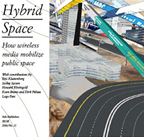
The Network of Waves: Public Agency in Hybrid Space
The Network of Waves: Public Agency in Hybrid Space by Eric Kluitenberg
The office space above which I live, in a corner house in the Indische Buurt, somewhere in Amsterdam East, used to house a local police station. At that time I was not yet living there. The place was briefly in the national news because of a fair-sized riot which took place there. A couple of Moroccan youths were brought to the station for some minor offence. Their friends thought that this was not right, so they followed the police back to the station to besiege the policemen there. It was not just a few friends who ran after the policemen, but a much larger group which suddenly turned up at the station, coming from nowhere at the precise moment when the youths were brought in. At that time this phenomenon, later known as a 'flash mob', [1] was still relatively new. The police on site were unpleasantly surprised, and had to issue a hasty call for reinforcements to negotiate with the besiegers. When it was all over a police spokesman said that it was a disgrace that the Moroccan youths had used their mobile phones to mobilize a mob. How else could these youths all have known at the same time that something was going on at which their physical presence was 'urgently desired'? And exactly where they needed to be? What the spokesman meant was that the youths had compiled mailing lists for text messages and then used texting to get together as many people as possible as quickly as possible. Texting with mailing lists was a popular application, because at that time text messages could still be sent and received free of charge.
A few years ago 'flash mobs' received a good deal of attention from the mass media. Semi-spontaneous public gatherings of groups of people, hardly if at all known to one another, nondescript, with no determining characteristics such as banners, uniform or logo, briefly performed some collective synchronous action, and then dissolved back into 'the general public'. Directions and information about the gathering were sent out by text messages, or e-mails, telling participants where, when and what. These short messages could easily be sent on to friends and acquaintances with the aim of starting a chain reaction resulting in the appearance of an unpredictably large mob at a predetermined time and place.
Reclaim the Mall!!
The 'flash-mob' phenomenon is thought by some people to have originated in a few relatively unmanageable actions in large shopping centres in American towns, disorganizing them temporarily and playfully. These actions generally had no political significance. This all changed at the end of the 1990s. The 'Reclaim the Streets' movement, [2] highly active at the time, which used to organize illegally orchestrated 'street raves' in the public spaces of large towns, made intensive use of text and e-mail address lists to organize quasi-spontaneous street parties. They did however give these street parties a layered political agenda. The parties were generally given concrete political and social themes and were linked to particular actions, such as support for a strike by London Underground staff. The movement's desire to also use these actions to free public space from its economically determined function (for instance transport, shopping or advertising) was succinctly expressed in the slogan 'The streets for people!'. The parties followed a fixed procedure. The evening before, a sound truck with a generator, a DJ kit and a large number of loudspeakers would park in a wide street. Shortly before the start a double collision would be staged at the beginning and end of the street. The crucial factor here was the provision of information for the participants, who were, in principle, unknown to the organizers. Participants therefore received a short message containing simple directions to the place, the date, the time and a few instructions, such as 'wait for the orange smoke -- that's when the rave will begin'. The double collision meant that at the agreed time the street was closed to all traffic. The cars used were fitted with smoke bombs which were set off by the mini-crash, producing enormous plumes of orange smoke, visible for miles around. This was the sign for which the 'Reclaim the Street' mob was waiting. Suddenly the street was flooded with people, sometimes more than a thousand at a time, while music began to boom from the previously parked truck or bus.
These examples demonstrate that we are living in a space in which the public is reconfigured by a multitude of media and communication networks interwoven into the social and political functions of space to form a 'hybrid space'. Traditional space is being overlaid by electronic networks such as those for mobile telephones and other wireless media. This superimposition creates a highly unstable system, uneven and constantly changing. The social phenomena which occur in this new type of space can not be properly understood without a very precise analysis of the structure of that space.
The way the Moroccan youths in Amsterdam East used text message address lists to mobilize themselves rapidly and effectively against what they saw as unjustified police violence provides an interesting example of a social group which finds itself in a socially segregated and stigmatized position appropriating a newly available technology. Mobilization was possible because at that time real-time mobile communication (texting) was available essentially free of charge. Shortly after that incident, texting became a paid service, though the reasons for this were economic rather than political, and its use for this purpose quickly lost popularity. It was simply too expensive to send so many messages at the same time. The specific relationship between time, space and technology, and to a lesser extent simple economics, determined the way in which this social phenomenon manifested itself. More than e-mails, which almost always have to be downloaded from a terminal or laptop (e-mailing on a mobile telephone is extremely laborious and inefficient), the brief phase during which text messaging served as a free public medium provided an important indicator to a changing relationship in the use and organization of public space. The mobility and immediacy of the medium gave birth to new social morphologies, like the 'flash mob', which still seem mostly to indicate a kind of mobile 'just-in-time-community' in physical public space.
The Place of Flows...
The question here is what this new kind of social morphology might mean. What lies behind the gimmick? What social, economic and technological transformations give rise to new phenomena of this kind?
So far the most important sociological theory about this is set out in Manuel Castells' Rise of the Network Society, the first part of his trilogy on the information age. [3] In it he describes the rise of flexible social network connections which resulted from economic and social transformations in late industrial societies and were strengthened by the introduction and wide application of new technology, primarily communication and information technology. Castells postulates that the network has become the dominant form in a new type of society that he calls the network society. He treats the influence of the network form as a social organization in physical and social space and establishes a new kind of dichotomy. According to Castells there are two opposing types of spatial logic, the logic of material places and locations (the 'space of place') and the logic of intangible flows of information, communication, services and capital (the 'space of flows'). [4]
The particularly striking thing about Castells' theory is the strict separation between the two kinds of spatial logic. Whereas the space of places and locations is clearly localized and associated with local history, tradition and memory, Castells sees the space of flows as essentially ahistorical, location-free and continuous. This last mainly because it moves across every time zone and so in some sense is not only location-free but also timeless. [5] Castells believes there is a fundamental asymmetry between the two kinds of space: while the vast majority of the world's inhabitants live, dwell and work in the space of places and locations, the dominant economic political, social and ultimately also cultural functions are increasingly shifting to the place of flows, where they make possible location-free ahistorical network connections, international trends, power complexes and capital movements. Only a very small part of the world population is represented in the bodies which take decisions about the organization and use of new location-free spatial connections. But increasingly the decisions made within such self-contained systems determine the living conditions in those places and locations where the vast majority of the world population attempt to survive and where their knowledge, experience and memory is localized. Castells feels that it is not surprising that political, social and cultural bridges need to be deliberately built between the two spatial dynamics, to avoid society's collapse into insoluble schizophrenia.
The attractive thing about Castells' theory is that it makes it possible to grasp and clarify a multiplicity of asymmetric social developments in a single image -- an image that has certainly not left popular culture unmoved. At the same time Castells' suggested contrast between physical locations and places and the intangible space of flows is misleading and ultimately even counterproductive for his political agenda: the deliberate building of bridges between physical space and informational space. Instead of a strict separation between physical space and informational space, all technological and social trends clearly indicate that these two 'spheres' are becoming more and more closely interwoven. A generic model of the sort suggested by Castells is totally unsuited to the analysis of this closeness and to gaining an understanding of how possibilities for public and private action come about within it, the central question posed in the present issue of Open. What threats to the autonomy and inviolability of the subject, the group, the community or cultural self-determination could possibly manifest themselves here and how can something be done about those threats?
Hybrid Space as a Polymorphous Concept
Against the placelessness and continuity of Castells' ahistorical 'space of flows' stands the discontinuity and multiplicity of hybrid space. The hybridity of this spatial concept refers not only to the stratified nature of physical space and the electronic communication networks it contains, but every bit as much to the discontinuity of the 'connectivity' or degree of connection between the multiplicity of communication networks. After all, even the universal presence of a telephone connection can not be taken for granted. More important still is the connection between local social and electronic networks: who communicates with whom, and in what context, is determined differently from one region to another, sometimes even from one day to the next. Because the space of electronic communication is rooted in local networks, it is also linked with local history. And questions about who controls electronic space or becomes familiar with electronic space are by no means easy to answer. Ravi Sundaram for example, co-founder of the Sarai new media initiative in Delhi, is constantly drawing attention to the coming into being of what he calls 'electronic pirate-modernity', [6] which comes about when local groups or individuals, illegitimately and without permission, gain access to television, telephone or the Internet -- 'Never ask permission, just appear!'.
Hybrid space is never exclusively local, as in the case of the idyllic hippy commune at the beginning of the 1970s. Small local networks, hacked or not, never remain limited to the local bazaar or the vegetable market in the next village. Local networks interweave with the international networks into which they force their way. Thus, says Saskia Sassen, the local is reconstituted as a micro-environment with a worldwide reach. Free-software geniuses in Sao Paulo's favelas find no difficulty in downloading the results of the latest interchange between the Amsterdam Waag (the Society for Old and New Media) and the Alternative Law Forum in Bangalore, but nobody pulls his or her local roots out of the ground.
Diktat of Visibility
The thing that strikes one about current discussion and the associated criticism of the rise of electronic media in public space is the preoccupation with the visual forms in which these media manifest themselves, such as screens, projections and electronic tagging. [7] It is a sort of extended visual criticism, closely connected with a tradition which assumes that the visual arrangement of observable reality is a necessary precondition for any ability to exercise power over that reality. However, the thing that stands in the way of this preoccupation with the visual is a critical analysis of the more invisible processes which are rearranging public space and imposing a different utilization logic. Relatively invisible forms of social compulsion, which bring these processes into play, may well have a much greater significance for the way in which public space can and may be used in future.
The concept of the perfect visual arrangement, expressing a social reality in which power structures are completely unambiguous and transparent, still always refers to Alberti's 'legitimate construction' and Piero della Francesca's ideal city, both of which reflect a visual articulation of daily life suggesting that everything, social and public, is completely controllable and constructible. Although the unifying point of view of a linear perspective has long been rejected, the street screens still stipulate for us a single perspective: a correct viewing distance and direction, while social relationships are radically altered.
The street screen is also the embodiment of spectacle in its most repressive form. Today spectacle is no longer alone in controlling the inner life, the interior of the alienation of the average TV junkie. The street, the classic stage of modern theatre, is overloaded with marching electronic screens and projections, so erasing the public functions of open space. Public functions become blurred by the flow of light and images drenching us in a fetish of alienating desires as we follow our necessary route through the city, from A to B.
Limitations of the Screen
Another point of criticism of the new urban visuality is its inherent limitation. Virtually every screen is rectangular and flat and has limited resolution (the number of pixels which determine the quality of the image). Media artists recognized these limitations years ago and have, with varying degrees of success, developed a multitude of strategies to attempt to overcome those limitations by, for example, a spatial type of installation, interactive media in which the screen itself also becomes an object capable of being moved and manipulated, projection on walls, fabrics, curved screens, screens that are not rectangular, [8] mirrored projections, moving projections, projections on glass materials and so on. Some artists, as for example the members of the Knowbotic Research collective, even leave out screens entirely, replacing them by new haptic interfaces and stereoscopic helmets from the Virtual Reality research laboratory or, as during the 1996 Dutch Electronic Art Festival, an installation on the roof of the Netherlands Architecture Institute, where network manipulations translated into sound and stroboscopic light. [9] Yet another example of the movement to bypass the screen is the Xchange network, in which artists collectively explore the sonic dimension of the Internet. [10]
The new generation of media-architects can learn from media art that the screen is ultimately a dead end. It is interesting to see how these attempts at iconographic liberation keep on recurring. Avant-garde painters carried out endless experiments in their attempts to break away from the frame of the painting and the surface of the canvas, their ultimate aim being to announce the death of the 'retinal' object. This same death announcement is repeated by today's media artists, but this time in relation to the screen. Media architecture again venerates the screen as a window on a space first seen as boundless, but later recognized as being largely subject to limitations and conventions.
Ultimately the screen dissolves into the architecture, becoming less a screen than a membrane between physical and medial reality. Here the 'image' functions less and less as an autonomous object, but increasingly coincides with the architecture itself, its skin, its inner life and its internal processes, finally disappearing from the consciousness of the user of that architecture. The image ecomes subliminal, 'vernacular', commonplace, merged with the environment, self-evident -- in the end the spectacle neutralizes itself. Media theorist Lev Manovich was still positive about this new medially enhanced architecture in his essay entitled The Poetics of Augmented Space, that had Learning from Prada as subtitle and was based on the success of Koolhaas's creation. [11] By now we know that the concept has failed completely, screens have disappeared from the scene or have been cut back to a minimum. The lesson of Prada is that the strategy of visibility can quickly turn into its opposite.
The Problem of Invisibility
In the present phase, the most important change in computer technology and its applications is that they are steadily beginning to withdraw themselves from sight. The European Union has for some years now been subsidizing a wide-ranging programme of multidisciplinary research and discussion with the remarkable title The Disappearing Computer. This title alludes less to the disappearance of computer technology than to its ongoing miniaturization and the way that it is beginning to turn up everywhere. The programme is investigating the migration of electronic network technology into every kind of object, to built environments and even to living beings. The thesis is that miniaturization and steadily reducing production costs are making it simpler to provide all kinds of objects with simple electronic functions (chips containing information, tags that can send or receive signals, identification chips and specialized functions in everyday objects). This is more efficient than building ever more complex pieces of multifunctional apparatus and mean the abandonment of the old idea of the computer as a universal machine capable of performing every conceivable function. [12] In fact, this is how technology becomes invisible. A decisive step, with dramatic consequences for the way people think about and deal with spatial processes.
This assimilation of computer technology in the environment introduces a new issue: the problem of invisibility. When technology becomes invisible, it disappears from people's awareness. The environment is no longer perceived as a technological construct, making it difficult to discuss the effects of technology.
Lev Manovich speaks of 'augmented space', a space enriched with technology, which only becomes activated when a specific function is required. [13] Wireless transmitters and receivers play a crucial role in such enriched spaces. Objects are directly linked with portable media. Chips are incorporated into identity cards and clothing. Even one's shopping is automatically registered by sensors. Screens and information systems are switched on remotely, by a simple wave of the hand. Miniaturization, remote control and particularly the mass production of radio frequency identification (RFID) tags is bringing the age-old technological fantasy of a quasi-intelligent, responsive environment within reach of digital engineers.
Of course these applications are not exclusively neutral. Combinations of technologies of the sort described above make it amazingly simple to introduce new and infinitely differentiated regimes for the control of public and private space. The application to public transport of RFID smart cards, which automatically determine the distance travelled, the fare and the credit balance, still sounds relatively harmless. Fitting household pets with an identity chip the size of a grain of rice, inserted under the skin, has become widespread practice. Indeed most health insurance schemes for household pets prescribe the insertion of such chips as an entry condition. Recently, however, first reports have turned up of security firms in the United States which provide their employees with subcutaneous chips allowing them to move through secure buildings without the use of keys or smart cards. Such systems also allow companies to compile a specific profile for each individual employee specifying those parts of the building or object to which the employer has (or is denied) access, and at what times
It is not difficult to extrapolate these practices to society as a whole. Who has the initiative in such matters? If the initiative lies exclusively with the constructors, the producers of these augmented spaces, and their clients, then the space we are living in is liable to total authoritarian control, even if there is no immediately observable way in which that space displays the historic characteristics of authoritarianism. The more widely the initiative is distributed between producers and consumers and the more decision-making is transferred the 'nodes' (the extremities of the network, occupied by the users) instead of at the 'hubs' (junctions in the network), the more chance there is of a space in which the sovereign subject is able to shape his or her own autonomy. The articulation of subjectivity in the network of waves is also an opportunity for the last remnants of autonomy to manifest themselves.
The Strategic Issue: 'Agency' in Hybrid Spaces
The concept of 'agency' is difficult to interpret, but literally combines action, mediation and power. It is not surprising therefore, to find it applied as a strategic instrument for dealing with questions about the ongoing hybridization of public and private space. Unlike Michel de Certeau's tactical acts of spatial resistance to the dominant utilitarian logic of urban space in particular, the action of this instrument in new ('augmented') hybrid spaces has mainly strategic significance. A tactical act of spatial resistance, which is after all no more than temporary, is hardly comforting to anyone faced by such an infinitely diversified and adaptive system of spatial control. New hybrid spaces must be deliberately 'designed' to create free spaces within which the subject can withdraw himself, temporarily, from spatial determination. Given the power politics and the enormous strategic and economic interests involved, and the associated demands for security and control, it is clear that these free spaces will not come about by themselves or as a matter of course. I would therefore like to suggest a number of strategies to give some chance of success to the creation of such spaces
Public visibility: 'maps and counter-maps', tactical cartography
The problem of the invisibility of the countless networks penetrating public and private space is ultimately insoluble. What can be done, however, is to remake them in a local and visible form, in such a way that they remain in the public eye and in the public consciousness. This strategy can be expressed in 'tactical cartography', using the tools of the network of waves (gps, Wi-Fi, 3G, etcetera) to lay bare its authoritarian structure. An aesthetic interpretation of these structures increases the sensitivity of the observer to the 'invisible' presence of these networks.
Disconnectivity
Emphasis is always placed on the right and desire to be connected. However, in future it may be more important to have the right and power to be shut out, to have the option, for a longer or shorter time, to be disconnected from the network of waves.
Sabotage
Deliberately undermining the system, damaging the infrastructure, disruption and sabotage are always available as ways of giving resistance concrete form. Such measures will, however, always provoke countermeasures, so that ultimately the authoritarian structure of a dystopian hybrid space is more likely to be strengthened and perpetuated than to be thrown open to any form of autonomy.
Legal provisions, prohibitions
In the post-ideological stage of Western society it seems that the laws and rights used to legalize matters provide the only credible source of social justification. But because a system of legal rules runs counter to the sovereignty of the subject it can never be the embodiment of a desire for autonomy. It can, however, play a part in creating more favourable conditions.
Reduction in economic scale
New hybrid systems of spatial planning and control depend on a radical increase in economic scale in the production of its instruments of control. Thus the political choice to deliberately reduce economic scale would be an outstanding instrument to thwart this 'scaling-up' strategy. [14]
Accountability and public transparency
In the words of surveillance specialist David Lyon, 'Forget privacy, focus on accountability'. It would be naive to assume that the tendencies described above can easily be reversed, even with political will and support from public opinion. A strategy of insisting on the accountability of constructors and clients of these new systems of spatial and social control could lead to usable results in the shorter term.
Deliberate violation of an imposed spatial program
Civil disobedience is another effective strategy, especially if it can be orchestrated on a massive scale. Unlike sabotage, the aim here is not to disorganize or damage systems of control, but simply to make them ineffective by massively ignoring them. After all, the public interest is the interest of everyone, and no other interest weighs more heavily. [15]
The formation of new social and political actors -- public action 'Agency', the power to act, means taking action in some concrete form. The complexity of the new hybrid spatial and technological regimes makes it appear that the idea of action is in fact an absurdity. However, new social and political players manifest themselves in public space by the special way they act, by clustering, by displaying recognizable visuality, by marking their 'presence' vis-a-vis (the) other(s).
The manifestation of concrete action by new social and political actors in public space is 'gesture'. The action, in this case, is the way the space is used, though there is still a difference between the use of a space and more or less public actions in that space. The use of space becomes agency when that use takes on a strategic form.
Notes:
1. For a description, see http://en.wikipedia.org/wiki/flashmob.
2. Reclaim the streets website http://rts.gn.apc.org/.
3. Manuel Castells, The Rise of the Network Society (Oxford: Blackwell Publishers, 1996).
4. Ibid.
5. Consider for example the concept of the 24-hour economy.
6. 'Electronic pirate modernity': see also www.sarai.net.
7. See also www.urbanscreens.org or the Logo Parc symposium held in Amsterdam on 16 November 2005, a cooperative project undertaken by the Jan van Eyck Academy, the Premsela Foundation and the Art and Public Space Lectureship (Rietveld Academy and the University of
Amsterdam).
8. These 'shaped screens' do incidentally form a curious counterpart to Frank Stella's Shaped Canvasses.
9. Anonymous Muttering: http://www.khm.de/people/krcf/AM/.
10. Website of the Xchange network, http://xchange.re-lab.net. 11. Lev Manovich, The Poetics of Augmented Space: Learning from Prada (2002), see www.manovich.net
12. The so-called Turing Machine, named after the mathematician Allan Turing -- the machine that is capable of simulating any other machine.
13. Manovich, The Poetics of Augmented Space, op. cit. (note 11).
14. The mass production of RFID (radio frequency identification) tags compelled producers to minimize the security provisions incorporated to allow the tags to be applied cost effectively to virtually any conceivable consumer product. A policy of giving priority to the safety and reliability of the chips and the information stored on them would make them much too expensive, restricting their development to specialized 'niche' markets.
15. Examples of a new kind of civil disobedience include deactivating RFID tags with the aid of an adapted mobile phone, hindering the operation of smart cards, regularly swapping client cards, deliberately supplying false information when registering online and using 'anonymizers' on the Internet, 'encrypted' (coded) mobile phones and local gsm blockers.
This essay was written for the new issue of Open (#11), cahier about art and the public domain - "Hybrid Space". The essay introduces the overall theme of the issue, and suggests some strategic considerations on the use of hybrid space.
More information on the issue can be found at the website of NAi Publishers:
http://www.naipublishers.nl/art/open11_e.html
and at the website of Open:
http://www.opencahier.nl
The journal was presented at De Balie, Centre for Culture and Politics in Amsterdam, on November 18, with the annual SKOR lecture, delivered this year by Saskia Sassen: "Public Interventions - The Shifting Meaning of the Urban Condition". The lecture is available on-line at: http://www.debalie.nl/terugkijken See also: http://www.debalie.nl/artikel.jsp?podiumid=media&articleid=85601 [via nettime]
Posted by jo at 06:19 PM | Comments (0)
December 12, 2006
MobZombies
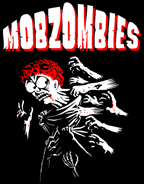
Human-as-Joystick
MobZombies explores a new dimension of handheld gaming by adding motion awareness to classic arcade style gameplay. Using a handheld device, and a custom motion sensor, players enter a virtual world infested with pixel-art zombies (a homage to vintage 8-bit console games). The goal of the game is to stay alive, running away from or planting bombs to destroy the ever-encroaching zombies.
The twist is that a player's physical position controls the position of their zombie-world avatar, forcing the player to actually move around the real world to succeed in the game.
The virtual zombie-world is a simple environment -- the game's complexity comes from players having to negotiate real-world objects in order to avoid the zombies and stay alive. The scoring system is simple: the longer you can stay alive, the higher your score. Of course, the longer you stick around, the more zombies you'll encounter.
"Basically, the game uses a digital compass and an accelerometer fastened to your hip (transmitting data through bluetooth) to get a relative position. That position controls a little zombie character in a virtual game world, and your main objective is to basically run away from zombies - by really running (or walking...). You can also drop bombs, but the trick is that you have to get away from the drop zone quickly before the bomb explodes on you. Other than zombies, the virtual world is really lacking any other obstacles - again, the idea is that the barriers are all brought in from the physical world. For example, in the game world, you might see a clear path away from the zombies, but in the physical world, that path might contain a busy street, or a wall. So that's where a lot of the difficultly comes in - learning how to navigate both these worlds and be hyper aware of your position in each.
The game has some history - I started designing it as a research project at USC, and it was entirely GPS based. However, we really found that it was a totally different experience than what we wanted, because of GPS resolution issues, as well as the ~1 second refresh rate. So my friend aaron and I built out an entirely different version based on relative movement. Now that we've got this version up and running, we're thinking about ways to get GPS involved again, while still retaining the analog control feel. One of the ideas we've been toying with is having community-assisted item pickups. In the current game, we randomly spawn heath and bomb pickups nearby your character. We were thinking it would be cool if people on the web could drop item pickups for you by clicking on a map. We could place those items in the virtual world based on a gps position, but once it was in the world, the player could still use the same control mechanism to get to the item. So yeah, basically thinking of creative ways to use GPS and maintain the nice analog feel of the human-as-joystick thing." -- Will Carter [via]
Posted by jo at 03:07 PM | Comments (0)
November 20, 2006
Glowlab
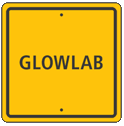
Issue 11
Welcome to Glowlab Issue 11! The projects in this issue examine the presence of surveillance within public space, and the ways in which ubiquitous technologies, such as electronic tags, global positioning systems, SMS messaging, and other locative media are informing the ways in which we interact within urban environments. These artists utilize these technologies to create mobile orchestras, jam turnstiles, observe the observers, and put the means and the media of production into the hands of ordinary citizens. This issue also includes independent curator Anuradha Vikram's review of Psychogeography by Merlin Coverly.
Transparent City: The ethics and aesthetics of mass-surveillance technologies by Derek Lomas :: Mobile phone carriers track our location and keep a record of everywhere that we have been. TRANSPARENT CITY is a prototype surveillance interface demonstrating how widespread mobile phone technology could be transformed into an apparatus for massive governmental control.
The Warbike and Wardriving: Geeks Don't Know it's Psychogeography by David McCallum :: The Warbike is a mobile, interactive artwork that sonifies WiFi networks during a bike ride. This article describes the process of creating the system, and touches on the links between psychogeography and wardriving.
Inner city locative media: The Media Portrait of the Liberties project by Valentina Nisi :: The Media Portrait of the Liberties is a modular collection of anecdotal stories drawn from a disadvantaged Dublin inner city neighbourhood called the Liberties. The narratives are displayed as short video clips on a location-aware handheld computer.
TXTual Healing by Paul Notzold :: TXTual Healing is an interactive project that enables members of the public to interact with large speech bubbles that are projected onto flat surfaces, such as the facades of public buildings, using SMS messaging.
arphield recordings by Paula Roush :: Arphield Recordings is a project documenting impromptu arphid sound performances produced by people scanning their oysters cards in their daily routines of accessing London tube stations.
Fête Mobile and Inflatable Art by Marc Tuters, Fête Mobile :: Movable Feast/ Fête Mobile is a 6-meter blimp equipped with surveillance and communications capabilities that enables participants to remotely view their surroundings and exchange media files through a wireless file server. In his article, we discuss the development of the project.
Book Review: Psychogeography by Merlin Coverley by Anuradha Vikram :: Psychogeography is a primer on the practice and its precedents, inspired by the neo-psychogeographic revival in London over the past two decades, and focusing specifically on the theoretical lineage of contemporary British writers.
Glowlab is an artist-run production and publishing lab engaging urban public space as the medium for contemporary art and technology projects. We track emerging approaches to psychogeography, the exploration of the physical and psychological landscape of cities. Our annual Conflux festival, exhibitions, events and our bi-monthly web-based magazine support a network of artists, researchers and technologists around the world.
Posted by jo at 01:40 PM | Comments (0)
November 18, 2006
Franck Ancel
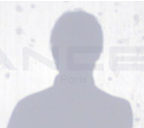
Tuut: Utopia of Theater
"Studying the terrain, the litterateurs believe they have established the existence of a major psycho-geographic crossroads — with Ledoux's Rotonde de la Villette at the centre – which can be described as a unity…" - the journal Les Lèvres nues, November 1956, Paris.
Mobile_Wireless_Digitale, for the bicentenary of the death of the utopian architect Claude Nicolas Ledoux in Paris, faced with the extension of the Cité des Sciences et de la Musique. I am no longer drafting a utopian performance which could have involved an immersive projection (cf. estimate drawn up with the UTRAM company) within Ledoux's Rotonde, and have been made possible by means of an inflatable dome (cf. study by another company), as conceived by me since 2001.
In contrast with some of the anticipated utilitarian hijackings aimed at establishing a modicum of social aesthetics on the square that is dedicated to the battle of Stalingrad in Paris, my idea involved a light and sound projection at the entrance to this capital: issues not only of physical fluidity but also fluidity of data. Thus, this space that traces the old boundaries closing in on the city, would be transformed by opening up the city, at a time when a dark globalisation is being prepared for us by some of the uses to which technology is being put.
I therefore propose an open-access 3gp stream broadcast from GPS co-ordinates N 48°53.365' E 002°22.555' to video receivers at this address: rtsp://217.71.210.164/ancel/19 , to other portables and on the Internet, on 19 November 2006 between 19:00 and 20:00 (Paris GMT). The 3D animation of this presentation has been created in association with Bryan Bey. It transfigures my Black Time epoch, for this action is primarily the echo of a manifesto for a Pari(s) lancé dans un lyrisme électronique (‘Paris (bet) cast in an electronic lyricism'), between active memory and the virtual future. - Franck Ancel
Posted by jo at 11:49 AM | Comments (0)
November 17, 2006
BlueStates:
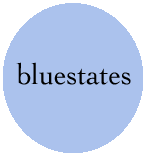
Exploring Relational Space
Cities are not merely collections of buildings; they are the living, breathing, teeming product of the human bodies who inhabit them. A city razed to the ground may recover, but a city emptied of people is dead. Yet emphasis is always given to the locative nature of a city - the neighborhood you live in, the street, the floor, the unit - an assertion of a Cartesian primacy which ignores the more profound natural relationships of the city: the coming together and parting of human beings living social lives. Cities are their people; souls are the bricks from which a city is constructed.
BlueStates: Exploring Relational Space--by Mark Pesce and John Tonkin--is an attempt to reverse the figure and ground of the city, ignoring its visible nature as a locative, Cartesian space, creating, instead, a view of the city purely as a social space. In this work, the trope of absolute location is abandoned in favor of the idea of relational proximity. BlueStates does not show you where you have been, but rather, it shows you who you have been with - a more perfect metric for the inner life of the city.

The inspiration for BlueStates is drawn from the recognition that most of us, most of the time, carry that most common of 21st century appliances, the mobile phone. Most of these mobile phones are equipped with a wireless technology known as Bluetooth. A Bluetooth mobile phone user creates a radius of electronic awareness - what we call a "bluesphere" - extending as much as ten meters from their body. When two Bluetooth devices pass in proximity to one another, each senses the other. Data is exchanged - and promptly ignored. BlueStates: Exploring Relational Space uses its own, custom software sensors - which run on mobile phones, PDAs and computers - to listen intently to the bluesphere. These sensors contribute to a database record of proximal encounters, and this data is then used to build views into the social life of the city's residents.
BlueStates is by its nature a highly participatory work. Anyone will be able to visit the website and create their own views into relational space. Residents of cities around the world will be encouraged to add their own sensors to the global network of sensors, expanding the database to incorporate the inner social life of their own cities. Beyond this, the work's creators have committed to releasing all software developed for the project as as free and open source software (under the GNU General Public License), believing this will encourage others to create their own projects in relational space. Finally, artists will be provided with tools to that will allow them to permute the data gathered by BlueStates: Exploring Relational Space in new and unique ways.
The two artists behind BlueStates have spent their careers exploring the intersection between art and technology. Mark Pesce is best known as the inventor of VRML, the standard for 3D on the World Wide Web, and has pioneered new interactive techniques for a quarter of a century. John Tonkin has consistently produced a stream of artworks that twist technology (and, occasionally, his body) into new and unexpected forms. Currently based at the University of Sydney, he has been involved in a broad range of projects including a collaboration at the Banff Centre for New Media Arts and a fellowship funded by the Australia Council. [from ISEA 06, via pasta and vinegar]
Posted by jo at 04:32 PM | Comments (0)
November 14, 2006
Regine Debatty's
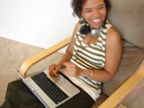
Interview with Lalya Gaye
I've been writing about Lalya Gaye's work over and over again ever since i started to blog. She's one of those few people who seem to swim effortlessly in both the artistic and the purely scientific waters.
She's an engineer and PhD graduate working in multidisciplinary projects that search to explore new territories of personal expression and creativity enabled by ubiquitous computing. Her research focuses on mobile media for urban space and on computational repurposing of everyday objects. In 2002, she started working on various research projects at Future Applications Lab, Viktoria Institute in Göteborg, Sweden. But she still manages to find some time to develop smaller new media projects with friends and to get involved in the mobile music and New Interfaces for Musical Expression (NIME) communities... More >>
Posted by jo at 09:19 AM | Comments (0)
November 03, 2006
Turbulence Commission:
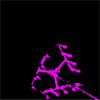
"Cell Tagging" by Brooke A. Knight
Turbulence Commission: Cell Tagging by Brooke A. Knight :: The mobile phone occupies a space that is both connecting and distancing. Seemingly ubiquitous, it has become an increasingly powerful tool, functioning as a phone, PDA, browser, and camera. With "Cell Tagging" it becomes a remote control that allows users to dial, draw, and speak. After dialing the number posted on the website, users are asked to enter a zip/city code that is significant to them. An aerial map of that place loads onto the screen. After choosing a color and brush size from the palette, users can use their cell phone keypads to draw directly onto the map. They are asked to speak into the phone and say why that place and drawing is meaningful to them. Users can save their drawings to the "Cell Tagging" database where others may view them. Cell phone users "graffiti" the sound-space around them, making every place their own. "Cell Tagging" literalizes this act of marking.
"Cell Tagging" is a 2006 commission of New Radio and Performing Arts, Inc., (aka Ether-Ore) for its Turbulence web site. It was made possible with funding from the LEF Foundation.
BIOGRAPHY
Brooke A. Knight is an artist and educator who has been working with digital media for over a dozen years. He has exhibited in over 40 international and regional venues, including Art Interactive, Photographic Resource Center, Mediaterra 2001, and Experimenta 02. His current areas of interest include webcams, the landscape, and text in all forms. Knight’s writings have been published in Art Journal and Sandbox. He is an Assistant Professor in the Department of Visual and Media Arts at Emerson College, where he teaches classes in interactive media.
Posted by jo at 10:20 AM | Comments (0)
October 31, 2006
Adam Greenfield
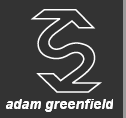
On the failure (or impossibility) of mapping
Last night I had an appointment to meet some old friends at Freemans for drinks and - as is both my habit in general, and an occupational hazard when getting around town on a conveyance that moves faster than just about anything else in the mired cityscape - I showed up quite a bit early.
Having locked up my bike, I found myself with a good fifteen minutes on my hands, an absurdly generous stretch of time in which to stroll up and down the not-particularly-extensive length of Freeman's Alley. I didn't have a book, I didn't happen to have my Moleskine on me, I had nothing close at hand with which to divert my attention, and so I wound up subjecting the space of the alley to the kind of close and sustained inspection I so rarely get to lavish on anything.
I saw windows bricked up, apparently against the encroachment of a neighbor building that was no longer in evidence. I saw fronds of razorwire tangled in rusted lengths of now-obsolescent barb, the both moored to a stanchion that had somehow worked or been torn free from anything more solid than the wire itself and which remained hanging stupidly in the void. Above all I saw a thousand ad hoc interventions, each the trace of some occasion on which an electrician or a plumber or a contractor made an off-plan, field-expedient modification in the name of getting things done - the outstanding example of which was a congeries of coiled, small-gauge utility lines staplegunned to the alley's westerly wall, their distal ends disappearing through holes into the buildings beyond. Some of these were still tagged legibly (feed 193 chrystie roof), but most had long gone mute as to their function or purpose.
I took all of this in, over the course of a quarter-hour. And then I knew, immediately and in my bones, that any project devoted to the Borgesian attempt to map the built environment at even reasonably high resolution is forever doomed to failure, no matter how many self-reporting locational gizmos we tack onto the world. Time and layered improvisation had rendered this one alley-end baroque almost beyond description, calling into question the practicality of any attempt to represent it schematically. And from there, inevitably, the regress beckoned, as it always does for me, and I suddenly understood the world as nothing more than an enormous aggregation of moments like these.
Infrastructure foliates, ramifies. That's what it is, what it does. It has a thousand parents, all of whom work on their own, in effective silence, and none of whose efforts or intentions are fully knowable to anyone else. Infrastructure, as I once insisted to a friend, is a bitch. All the cables, conduits, trunks and buses our planetary girdle of awareness is built from - they may not literally have the power of self-reproduction, but they may as well have, given how far beyond any one agency's knowledge or control they are and continue to grow. You turn around for a moment and it's all changed. How could we possibly hope to map it all?
I can't help but think that this is one of those apparent insights which occasionally strike me with the force of epiphany, and yet are completely banal to others. I don't know why a few minutes at the back of one particular New York alley should impress this feeling on me - maybe it's the effect of recent attention to questions of situatedness and underspecification - but I do know that moving forward, I'll be a lot less likely to take seriously any schema of the world which relies on the accurate description or representation of live infrastructure for its force. [blogged by Adam Greenfield]
Posted by jo at 02:44 PM | Comments (0)
[Re: ] magazine
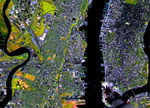
Locative Media
[Re: ] magazine has launched its first edition. The theme of this international new media online magazine is locative media. Locative Media -recently becoming more popular in Media Art discourses- has roots dating back to the dawn of history. Early myths like the Gilgamesch Epic or - more specific - Homer's Odyssee deal with issues of location and the recording of movement on earth's surface...
Developments since then include mediaeval cartography as well as the Situationists' approach to mapping a city. Nowadays Locative Media uses technology to trigger artworks in a specific physical space. The magazine features an depth interview with locative media artist Jeremy Hight about a new form of dissent utilizing smart mobs, on line community and locative media. [posted on RANDOM]
Posted by jo at 08:53 AM | Comments (0)
October 23, 2006
Tagzania's Spanish Architecture on Google Earth
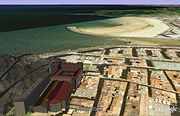
Venice Architecture Biennale
The Spanish Pavillion at the Venice Architecture Biennale commissioned Tagzania and its parent company, CodeSyntax, to develop several architectural models for Google Earth, and produce a set of videos using Google Earth flights.
The installation consists of 16 screens geographically organised: 16 simultaneous and synchronized 3-min videos are shown on those screens. 13 of the screens have a 3D architectural model on it, developed with Sketchup, and transplanted to the Google Earth scenario. Two more screens shown urban plans in 2D, as flat layers over Google Maps. One of the screens has no project to show, but the city of Palma de Mallorca needed to be there, so the panel with all screens made geographic sense, and therefore a series of pictures from the city Cathedral are visible in that particular flight. Several target cities in Spain where models had to be developed lacked hi-resolution imagery at Google Earth, so aditional ortophotographic layers were added to film the videos. These are the locations of the projects:
http://www.tagzania.com/user/tagzania/biennale.
Flights show the buildings in close detail, and there are also some context changes in the videos, all screens go to Madrid, Barcelona and Venice, first from a distance and then zooming into great detail: in those close positions, Google Earth's pool of information layers and pinpoints is visible in the videos. All positions made sense with the screen arrangements in the panel...
About Tagzania: Tagzania is a site for bookmarking places in a map. It's interface is mainly flat, 2D views served by Google Maps thru their API. However, all points uploaded to Tagzania, and the collections of places organised by users or tags, have dinamic links to Google Earth. Anyway, developing 3D models didn't have much to do with our site's conception... Until now, at least.
The explosion of map mashups, geotagging, geography 2.0 we may say, has had a clear impact so far. Latitude and longitude are no longer terms exclusive to cartographers. They're in the hands of common net users.
Now, tools like Sketchup, Google Earth and the competitors of Google may have an impact in architecture, civil engineering and 3D design as well. Tools like Tagzania will not substitute professional cartography or architecture, but may make those realms accessible to myriads of users. There's space for all in Internet, and we all shall create, share and build our own spaces (geographic, architectural, urban spaces) on the web.
Posted by jo at 05:49 PM | Comments (0)
October 19, 2006
Ethan Zuckerman
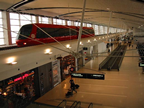
Tracking Hasan Elahi
Hasan Elahi is a conceptual artist whose life is an ongoing work about surveillance. He starts by telling us a chilling story - his detention by the INS at Detroit Airport after returning from a trip from overseas. An immigration officer scanned his passport and blanched, then led Alahi through a maze under the airport to an INS detention facility. As a US citizen, this was pretty odd - he tried to talk with the guards to figure out what was going on. But it all became clearer when the man from the FBI in the dark suit came to talk with him.
The FBI asked him about his whereabouts on September 12, 2001 - he was able to answer the questions by taking out his Blackberry and showing off his meetings. Over the course of questioning, it became clear that the reason he was being questioned was that he had a storage locker in Tampa, where he’d been teaching. Scared by 9/11, the owners of the storage area reported that “an Arab man had fled on 9/12, leaving explosives in his locker.” There were, of course, no explosives, and he hadn’t fled - just the detritus of ordinary life.
Elahi’s life for the next few months involved dozens of interviews with the FBI, finally culminating in nine back to back polygraphs, which finally “cleared” him. He explains that the power dynamic of an FBI interview leads to a very human response - the desire for survival. Elahi says that he could have questioned the legality of the experience, hiring a lawyer… but he realized that there was the possibility that any act of resistance could have gotten him sent to Guantanamo.
For the next few months, every trip Elahi took, he’d call his FBI agent and give the routing, so he didn’t get detained along the way. He realized, after a point - why just tell the FBI - why not tell everyone?
So he hacked his cellphone into a tracking bracelet which he wears on his ankle, reporting his movements on a map - log onto his site and you can see that he’s in Camden. But he’s gone further, trying to document his life in a series of photos: the airports he passes through, the meals he eats, the bathrooms he uses. The result is a photographic record of his daily life which would be very hard to falsify. We all know photos can be digitally altered… but altering as many photos as Elahi puts online would require a whole team trying to build this alternative path through the world.
Elahi also puts other apsects of his life online, including his banking records. This gives a record of his purchases, which complements the photographs. He doesn’t put the phone records online, because it would compromise the privacy of the people he talks with, and some friends have asked him to stop visiting, but he views the self-surveillance both as an art form and as his perpetual alibi for the next time the FBI questions him.
At the same time, he’s stretching the limits of surveillance systems, taking advantage of non-places. He flew to Singapore for four days and never left the airport, never clearing customs. For four days, he was noplace - he’d fallen off the map, which is precisely what the FBI and others worry about. But he documented every noodle and every toilet along the way.
One of the audience questions asks whether the FBI actually threatened Elahi with Guantanamo, or whether his “artistic temperment” might have exaggerated the seriousness of the situation. Elahi explains that it was never made concrete, but that he certainly felt the threat of indefinite detention, and that he believes the only thing that saved him was a common culture - the ability to quote the lyrics of country songs, or talk about college football, the sort of things a terrorist would find very hard to fake.
Another questioner wonders if Marianne Weems will make a show about Elahi - she mentions that an earlier piece, “Jet Lag”, tells the true story of a woman who flies from Amsterdam to NYC 167 times, again and again, until she dies of jetlag. (Still trying to find a reference to this story…) Given that Elahi’s life involves all the issues Weems is most interested in, she admits that a piece based on his experiences would be irresistable. [posted by Ethan Zuckerman on World Changing]
Posted by jo at 09:51 AM | Comments (0)
Net_Dérive
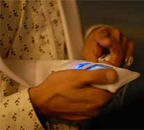
The City as Instrument
Net_Dérive, by Atau Tanaka and Petra Gemeinboeck with the collaboration of Ali Momeni, is a location sensitive mobile media art piece that calls for an exchange between participants in the gallery and participants in the streets. Deployed on advanced mobile phones, the work seeks to create a kind of musical instrument, thinking of the city-as-instrument.
Participants are given a kind of scarf with a mobile phone in each end and off they go to explore the neighborhood. One of the phones takes pictures every 20 secs and collects sounds, the other talks to the GPS (also in the scarf) and to the server inside the gallery space. On a radar they can see themselves pictured as dots but also the images they're taking. The sounds and pictures collected in the streets are sampled and mapped to a 3D city map in the gallery. As users are walking they can hear some voice instructions through a pair of headphones. Those comments suggest paths to follow or turns to make, they are generated and heard in a musical fashion. The voice instructions are inspired by the old Situationist games and theory of the Dérive - now brought into the digital and mobile spheres. As the user chooses to heed or ignore these instructions, a trace of his/her path is carved out in the city.
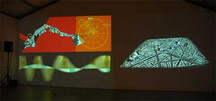
The engine then generates an audiovisual amalgam based on this information, and feeds it back as a live stream to each mobile client. The simultaneity, history, and memory of the various users’ paths and images become an abstract narrative that is summed together and projected in the gallery space. A feedback mechanism is created as users’ actions generate the collective narrative that in turn directs them.
Presented in Paris during the IntensiveScience exhibition of Sony CSL Paris, 6, 7-october 2006
Photos by Walter Kim. Images and information courtesy of Atau Tanaka.
Related: Sonic City, a wearable piece that enables people to compose music in real time by walking through the city; headphones that turn urban noise into music. Atau Tanaka's talk at Futuresonic; Pixel bondage on rice paper. [blogged by Regine on we-make-money-not-art]
Posted by jo at 08:38 AM | Comments (0)
September 28, 2006
TAGGED
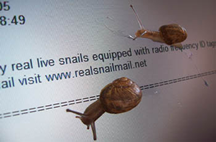
New RFID Works
TAGGED :: Five new works by artists working with RFID technology as part an ongoing project produced by [ space.media.arts ] :: Opening Reception: 6 October, 6 - 9pm; continuing until 21 October :: With a performance by Paula Roush.
Electronic tagging technologies are increasingly impacting society and are set to shape the future. Standing for Radio Frequency Identification, RFID tags use radio waves and can potentially function without your knowledge, with widespread adoption across many commercial and public industries.
In this exhibition, the artist collaborative Louis-Philippe Demers and Philippe Jean are working with local shop Hollywood Convenience electronically tagging their grocery items to produce the artwork iTag. Using a portable music device, available to pick up from the exhibition, shoppers can listen to music generated from the grocery aisles.
RealSnailMail is a project in development by boredomresearch, using RFID technology to enable real snails to carry and deliver electronic messages on their own time, despite growing expectations of instant communication.
Mute-Dialogue (Yasser Rashid and Yara El-Sherbini) have created the interactive installation, Origins and Lemons. Arranged as an East End market stall the installation invites you to pick up RFID-tagged items and scan them to receive clues as to their history and origin.
In SWAPOId, evoLhypergrapHyCx (C6) implement RFID technology in the Antisystemic Distributed Library Project, an alternative library of shared books, videos, and music with venues in community centres and bedrooms worldwide, and through this acting as but one site of resistance against a de-humanising, de-dimensional agenda.
Arphield Recordings by Paula Roush records the sound of citizens scanning their Oyster cards in London Underground stations, and outputs them in live performance, installation and public intervention.
A new essay by Armin Medosch, The Spychip Under Your Skin, accompanies this exhibition and will be published on a new [ space.media.arts ] website: http://www.spacemedia.org.uk.
FOR MORE INFORMATION
Email: exhibitions[at]spacestudios.org.uk
Web: http://www.spacemedia.org.uk
Telephone: 0208 525 4339
Press inquiries: claire[at]spacemedia.org.uk
TRAVEL
Bus: 26 & 48 from Liverpool Street
106 & 254 from Bethnal Green
55 from Old Street
Tube: Bethnal Green
Train: Hackney Central Silverlink
EXHIBITION OPENING TIMES
Wednesday - Saturday.1 - 6pm
FREE ADMISSION FULLY ACCESSIBLE
Posted by jo at 08:42 AM | Comments (0)
September 25, 2006
No2Pho/notovo research project
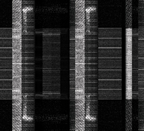
Happy New Ears (festival for New Music), Kortrijk (be)
notovo at Happy New Ears (festival for New Music), Kortrijk (be) :: The No2Pho/notovo research project: investigates the behaviour of language in its many appearances: textual, sonic and visual, as well as gestural or body language. How do these disparate elements relate to each other and how do they organize within a system which includes human and computer as a sender and a receiver [and vice versa].
The notovo-installation [article (PDF)]: as a generative sound installation NoToVo (noise to voice) plays with a connected set of elements. It is composed of dissonant synthetic voices, changing in real time from speech to sound. A physical network and a virtual network. People and voices. Wireless headphones and spatialized soundsources. People walk their traject through space. Their localisation and orientation is tracked. These data modulate the behaviour of realtime generated synthetic voices. As such, a conversation can be physically crossed and experienced according to the visitors' own position. Voices are layered and mixed by movements and trajects through space: the visitor becomes the performer.
No2Pho/notovo is developed by so-on (a collaboration between sukandar kartadinata, johannes taelman, edo paulus, billy bultheel and annemie maes). With the support of the VAF (Vlaams Audiovisueel Fonds).
http://so-on.be
http://okno.be/?id=954
http://happynewears.be
location: Happy New Ears festival, september 23rd --> oktober 8th
meetingpoint: busdascoop - kapucijnenstraat 10 - 8500 kortrijk
opening: saturday september 23rd from 2pm till 8.30pm
open: every monday, wednesday, friday and saturday from 2pm -> 8.30pm; sundays from 2pm -> 6pm
Posted by jo at 11:50 AM | Comments (0)
September 22, 2006
terminus1525.ca takes over the city !
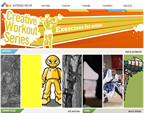
Disseminating Canadian Cultural Content
terminus1525, Canada's online arts community, is proud to announce a partnership with community wireless groups Ile Sans Fil and Wireless Toronto, which uses new technology to engage Canadian audiences with art in their local cafes, libraries and parks. Ile Sans Fil's and Wireless Toronto's 27,500 users are being introduced to art by young Canadians when they use any of the 135 free public wireless hotspots operated by the two groups. Most of the hotspots are located in Montreal and Toronto, but the project includes resources for interested volunteers to set up hotspots in their own cities and towns.
terminus1525 is proud to support and participate in this ground-breaking large-scale project, which is developing new methods to promote Canadian art. Maintained by zinc Roe Design, terminus1525.ca is a collaborative workspace brought to life by the ingenuity and imagination of young Canadian artists working in a wide range of disciplines. A project that has been funded by Canadian Heritage and administered via Canada Council for the Arts, t1525 operates free online studios where emerging artists can show their work, find support, feedback and inspiration.
Ile Sans Fil (ISF) and Wireless Toronto (WT) are volunteer-run non-profit organizations which develop, deploy and support community-focused wireless infrastructure. This is accomplished through providing free Internet access in public spaces, as well as geographically-specific information and cultural content at each hotspot.
Through this collaboration, the three organizations aim to innovate in methods of disseminating Canadian cultural content. Work by t1525 artists is shown to a large captive audience of mobile wireless users. Already echoing the mandate of ISF and WT in supporting community via technology, t1525 also wants to introduce members to the creation of locative, mobile and syndicated artistic content.
Through the community-owned wireless infrastructure installed and managed by ISF and WT, users are directed to a website specific for each hotspot before they can surf the web. This opportunity is used to showcase local information or content, and in this case, art from terminus1525. At 30 select hotspots where the project has supported advanced audio and video service, an on-site mini-server allows the delivery of location-specific, large files of music and videos at speeds currently impossible over the internet.
The size of this project is impressive. By harnessing the infrastructure and contribution of volunteers at Ile Sans Fil and Wireless Toronto, content from terminus1525.ca young artists will be disseminated to over 27,500 users, many of whom make daily use of these infrastructures.
Sources:
Michael Lenczner
Ile Sans Fil
michael[at]ilesansfil.org
514 708 5112
Michael Pereira
Wireless Toronto
michael[at]wirelesstoronto.ca
416 821 5081
Sophie Le-Phat Ho
terminus1525
sophie[at]terminus1525.ca
514 993 2312
Posted by jo at 08:30 AM | Comments (0)
Real Time Rome
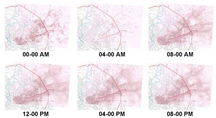
at Venice Biennale
MIT Real Time Rome project to debut at Venice Biennale :: Real Time Rome, a pioneering MIT project that promises to usher in a new era of urban mapmaking, will have its worldwide debut at the Venice Biennale, the prestigious biannual exhibition of contemporary art, from Sept. 10 to Nov. 19.
The project utilizes data gathered, in real time and at an unprecedented scale, from cell phones and other wireless technologies, to better understand the patterns of daily life in Rome, and to illustrate what ubiquitous connectivity in an urban environment looks like.
"In today's world, wireless mobile communications devices are creating new dimensions of interconnectedness between people, places and urban infrastructures," said project director Carlo Ratti, director of the SENSEable City Lab at MIT. "The goal of Real Time Rome is to use this connectivity to map the city in real time, which may ultimately lead to a deeper understanding of how modern cities function."
Real Time Rome features seven large animations, projected on transparent plexiglass screens. One screen shows traffic congestion around the city, while another screen shows the exact movements of all the city's buses and taxis. Another screen is able to track Romans celebrating major events like the World Cup or the city's annual White Nights festival (Notte Bianca, which will happen on Sept. 9, the evening before the Biennale's architecture exhibition opening). Additional screens show how tourists use urban spaces and how cars and pedestrians move about the city.
Ratti believes these types of visualizations will help reduce the inefficiencies of present day urban systems and open the way to a more sustainable future: "Our hope is that projects like Real Time Rome will give city dwellers more control over their environment by allowing them to make more informed decisions about their surroundings. Imagine being able to avoid traffic congestion, or knowing where people are congregating on a Saturday afternoon. In a worst-case scenario, such real time systems could also make it easier to evacuate a city in case of emergency."
Ratti's team obtains its data anonymously from cell phones, GPS devices on buses and taxis, and other wireless mobile devices, using advanced algorithms developed by Telecom Italia, the principal sponsor of the project. These algorithms are able to discern the difference between, say, a mobile phone signal from a user who is stuck in traffic and one that is sitting in the pocket of a pedestrian wandering down the street. Data are made anonymous and aggregated from the beginning, so there are no implications for individual privacy.
"The exhibit will hopefully trigger many more urban studies that take advantage of the already existing data on mobile phones and transportation systems, in order to create a deeper understanding of how cities are being used," said project curator Andres Sevtsuk, a graduate student in urban studies and planning.
Ratti describes Real Time Rome as a new kind of mapmaking. Along with other powerful interactive maps, such as Google Earth, Real Time Rome is backed up by huge databases that will ultimately make it possible to conduct highly customized searches and view displays in real time.
"We are very excited to carry out our experiment in Rome, the city where Gianbattista Nolli refined modern cartography in 1748," Ratti said. "Maps of the future will be large databases that will enable us to extract fragments that suit our needs, much like we can do today on the web, and will also tap into the coming revolution in RFID (radio frequency identification) technology."
Real Time Rome is produced by MIT's SENSEable City Laboratory, an initiative that studies the impact of new technologies on cities.
Other MIT projects will also be on display at the Biennale, in the same location as Real Time Rome. They include including an interactive bus stop with wireless Internet; designs for digitally enhanced public spaces in the Milla Digital in Zaragoza, Spain; a smart car and public transportation system by the MIT Media Lab and Design Lab; and new computer interfaces by the Tangible Media Group at the Media Lab.
"All these projects from MIT deal with specific aspects of the urban environment and digital technology," said Sevtsuk. "Together they start to form a multifaceted picture of how real-time communications can change urban design."
Following the Venice Biennale, the SENSEable City Laboratory will launch the SENSEable City Consortium, a major research initiative aimed at bringing together city and public administrators, network operators, electronic hardware and software producers and urban hardware manufacturers in MIT's unique research environment.
The principal sponsor of Real Time Rome is Telecom Italia. Technical partners are the Rome public transportation authority (ATAC), Google, Samarcanda Taxi and the city of Rome.
The Real Time Rome team at the SENSEable City Lab is composed of Ratti, Sevtsuk, Burak Arikan, Francesco Calabrese, Assaf Biderman, Filippo Dal Fiore, Saba Ghole, Daniel Gutierrez, Sonya Huang, Sriram Krishnan, Justin Moe, Carlo Ratti, Francisca Rojas, and Najeeb Tarazi.
For more information, visit senseable.mit.edu/realtimerome/.
Posted by jo at 08:02 AM | Comments (0)
September 18, 2006
Insectopia:
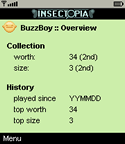
Context-Aware Gaming
insectopia is a new kind of cell phone game where the real world spills into the game world. Players roam the cityscape searching for and catching a multitude of different insects. Each insects in the game world is generated by using the available bluetooth devices available in the player’s vicinity. By catching insects and trading them with other players, players build their own collection bigger and better. The current status of the game is displayed on various highscore lists both in the phones and online.
See also geoquiz, a location-based mobile game in which players create and answer questions related to their current geographic position (kept track of through the GSM network). [blogged by Nicolas on pasta and vinegar]
Posted by jo at 03:42 PM | Comments (0)
September 15, 2006
You Are Not Here
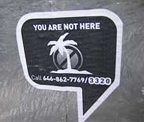
Baghdad in Brooklyn
I followed the You Are Not Here walk which was presented yesterday at Conflux. This urban tourism mash-up invites participants to become meta-tourists on an excursion through the city of Baghdad while walking through the streets of New York. We were given maps printed on both sides: on the recto, a map of Baghdad, on the verso, a map of New York. By looking through it in the light, we were able to navigate through the Baghdad/New York streets. We had to look for the You Are Not Here signs placed on lamposts, walls or other locations in the streets, they indicated us that we had arrived at an important monument or square of the capital of Irak. The YANH street-signs provided the telephone number for the Tourist Hotline.
Site-specific access codes entered on our mobile phones through the Tourist Hotline provided us with audio information about the current site that we had discovered. For example, when we arrived in central Baghdad's Firdos Square, we received information about the toppling of the statue of Saddam Hussein and how this might have been a stage event as most of the spectators of it were American soldiers and journalists.
Through the website, you can get your own mashed-tourist map of Baghdad, NYC with a full tour guide to all of the must-see locations.
You Are Not Here tries to expose the contrasts and the similarities between two mashed cities. We are consuming global information on a daily basis: a tourist visit demands a higher level of commitment and identification with a place than a habitual commute. YANH provides participants with a fragmented tourist experience, which provokes a critical view of urban space and its subjection to media and politics.
The experience was quite nice and walking becomes the medium through which we discussed, commented and exchanged our views about the Iraqi events.
A work by Mushon Zer-Aviv, Dan Phiffer, Kati London, Thomas Duc, Ran Tao and Charles Joseph.
You Are Not Here will also be part of the Come Out and Play festival that will take place in New York on September 22-24. [blogged by Regine on we-make-money-not-art]
Posted by jo at 04:30 PM | Comments (0)
September 14, 2006
Scoot
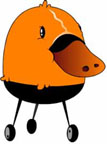
a location-based game
Melbournians have another chance to save their town from those pesky aliens when the location-based game, Scoot, returns this weekend 16 - 18th September.
Following its 2005 premiere at ACMI and Federation Square, Scoot 2006 will be played over 3 days across Victoria's 5 major cultural organisations and takes participants on a unique interactive treasure hunt through the virtual and real worlds of Australian Centre For Moving Image, National Gallery of Victoria, State Library of Victoria, the Arts Centre and Melbourne Museum.
A location-based game that employs sms, multimedia and the online environment to explore concepts of space, Scoot 2006 is played out via sms instructions sent to participants' mobile phones. It begins with players receiving a mystery SOS message leading them to the world of Scoot. In order to avoid invasion, players must then seek out magical characters, play online games and interact with the strange objects that have arrived in Victoria's major arts institutions.
Created by artist Deb Polson and presented by Australian Centre For Moving Image in collaboration with National Gallery of Victoria, State Library of Victoria, the Arts Centre and Melbourne Museum, Scoot explores using mobile phones as tools of play and creates a gaming experience across multiple locations in Australia's largest location-based game. It has been supported by the Victorian Government through Arts Victoria and the Community Support Fund.
Families and groups of 2-6 can play. For more information and to register visit Scoot or ACMI Games Lab [posted by jacinta on selectparks]
Posted by jo at 07:28 PM | Comments (0)
September 12, 2006
Primary and Other Remote Locations
We recently finished a short video describing a project we started last summer (2K5), and that was completed early this summer. Just recently I posted it to youtube. It is somewhere at the intersection of database, painting, diy gis, walking work and locative media. Does painting put the taint on new media or new media the taint on painting, or both? But we don't worry very much about mixing oil (paint) with (scarce) water. Exploring the confluence of new and old media, as well as the virtual and real, is where we have been working recently. [posted by Brett Stalbaum on Locative]
Posted by jo at 02:18 PM | Comments (0)
September 08, 2006
Tag Shufflesition:
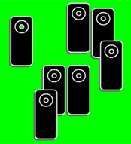
A Mobile Game of Mimicry and Mime
Tag Shufflesition: a mobile game of movement, mimicry and mime, that uses iPod Shuffles to see how fast can you find out who’s “it”! :: Designed by Charlie Hoyt and Andrew Bucksbarg, Indiana University Bloomington (2006) :: Central Park, New York :: Saturday, September 23, 2006 at 3:00PM.
Christo may have turned Central Park into a work of art, but Andrew Bucksbarg and Charlie Hoyt are part of a group of game designers who will be transforming New York into an enormous game level. Mobile and locative technologies have given rise to an international flowering of what are called urban games, street games or Big Games. These games explore new technologies and make the real world and urban spaces their playground. Tag Shufflesition will be featured in New York’s Come Out & Play Festival
From massive multi-player walk-in events, scavenger hunts to public play performances; the festival will give players and the public the chance to take part in a variety of different games. The festival will feature the innovative use of public space and games that make people interact in new ways, such as Tag Shufflesition.
Tag Shufflesition is a mobile system for movement and dance using the random playback feature of mobile mp3 players, such as Apple’s iPod Shuffle. The “Shufflers” (participants) receive random instructions from their iPods as to how to move and interact with the other Shufflers. One iPod is loaded with a slightly different set of instructions. The task of the Shufflers to find out which Shuffler among them is “it”- the one with the different instruction, and begin to mimic all of the “it” Shuffler’s movements. The game is complete when all of the Shufflers are correctly mimicking the “it” Shuffler.
Tag Shufflesition is engaging for both spectators and participants as an interactive game of patterns movement and mimicry. Shufflers will enjoy following the directions, which often exist as small games within the larger game of Tag Shufflesition. Spectators, without the distractions the Shufflers face, will also enjoy trying to guess who’s “it,” but please don’t give “it” away!
Charlie Hoyt is an Audio Instigator. When he’s not staring at a mixing board or making “music”, Charlie enjoys video games, rock ‘n roll, and name-dropping. Charlie is pursuing a Masters in Immersive Mediated Environments at Indiana University in Bloomington, Indiana, studying audio and music for participatory media. Charlie’s previous artistic fracases include “ToneBeast”, which received honorable mention at the 2004 Indiana IDEAS Fest and “MESS”, which received nothing, but is nevertheless fun. Email: audioinstigator(at)yahoo(dot)com
Andrew Bucksbarg is a techno-media artist, experimental interaction designer, audio-visual performer and a professor in the Department of Telecommunications at Indiana University. Bucksbarg’s work and interests reverberate in the space of creative new media practices, technology and theory. As an experimental interaction artist, Bucksbarg concerns himself with technologies and social systems that support tactics of ambiguous, autonomous social creativity and exchange. Bucksbarg’s work appears physically and digitally around the globe, including the Rhizome.org Artbase; Share DJ, NY; The 2006 Bent Festival, NY; National Museum of Australia, Canberra, Australia; Sonorities Festival, Belfast, UK; The Dark light Film Festival, Dublin, Ireland; Trampoline Media Festival, Nottingham, UK and dLux Media Arts Festival, Sydney, Australia. Email: Andrew(at)adhocarts(dot)org Press: 812-219-5310
Posted by jo at 04:37 PM | Comments (0)
September 07, 2006
Preemptive Media's AIR

Launching September 14
"Allowing you to explore your neighborhood and urban environment for pollution and fossil fuel burning hotspots." :: The AIR project will launch on September 14, 2006 in Lower Manhattan at the AIR headquarters located in 125 Maiden Lane (map). Release party from 5-7pm!! The headquarters will be open daily from 12-7 pm from 9/15-21.
AIR is a public, social experiment in which people are invited to use Preemptive Media's portable air monitoring devices to explore their neighborhoods and urban environments for pollution and fossil fuel burning hotspots. Participants or "carriers" are able to see pollutant levels in their current locations, as well as simultaneously view measurements from the other AIR devices in the network. An on-board GPS unit and digital compass, combined with a database of known pollution sources such as power plants and heavy industries, allow carriers to see their distance from polluters and other AIR devices. In addition, the devices regularly transmit data to a central database allowing for real time data visualization on this website.
While AIR is designed to be a tool for individuals and groups to self identify pollution sources, it also serves as a platform to discuss energy politics and their impact on environment, health and social groups in specific regions.
Posted by jo at 08:05 AM | Comments (0)
September 06, 2006
Upgrade! New York
![]()
Catherine D’Ignazio a.k.a. kanarinka
Upgrade! New York: September 14, 7:30 pm :: The Change You Want to See Gallery and Convergence Stage :: 84 Havemeyer Street, Store Front @ Metropolitan Ave, Brooklyn, NYC
Are locative media and psychogeography projects just entertainment for white, middle-class, gadget-oriented consumers? Mapping impulses, locative media projects and psychogeographic investigations of place and community have proliferated over the past decade. There is a rich, interdisciplinary field of practice and new strategies, tactics and tools are being invented all the time. However, there is also the need for critical evaluation and discussion of the relevance and impact of these cultural projects. Factors of race and class are often overlooked. Connections to the material (often military and corporate) circumstances of the development of technologies deployed in these projects are often swept aside. Through the increasing corporatization and militarization of participation and play (Web 2.0, Joint Red Flag military war game), it is clear that more participation and play does not mean more democracy and freedom. On the contrary, participation and play are also deployed as mechanisms of social control.
Catherine D’Ignazio a.k.a. kanarinka will discuss several collaborative projects from her practice, show other examples of contemporary psychogeographic investigations and then open the forum for others to do the same. The goal of the talk is to discuss three questions:
1) Is locative media/psychogeography work just entertainment for white, middle-class, gadget-oriented consumers? (Hopefully the answer is no, but we’ll see.)
2) What is at stake in the corporatization and militarization of “play” and “participation”?
3) What kind of agency do these projects have? i.e. What do they really do?
TO BRING (optional): Failures & successes. Bring a psychogeography/locative media project to share with us, including your commentary about what kind of agency it produces, how it addresses its audience, and so on. Both failures and successes - and the numerous projects that have both - are useful.
LATER: We will proceed to the opening for the Conflux Festival at Supreme Trading Post to continue the conversation.
Posted by jo at 01:44 PM | Comments (0)
August 24, 2006
The (New) Familiar Stranger
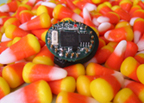
Subtle Connections and the Unknown
Wireless, mobile, digital technologies are rapidly transforming our relationship to people and place in public urban settings. The Familiar Stranger Project developed by Eric Paulos and Elizabeth Goodman from Intel Berkeley Lab, explores these devices implications that provide a loose connection (but no explicit communication) to those nearby whom we do not know - our 'Familiar Strangers'. Familiar strangers are individuals that we regularly observe, particularly in public urban spaces, but do not interact with. A good example is a person seen on the tube every morning: if this person fails to show up we suddenly notice it.
The claim is that the relationship we have with the familiar strangers is indeed a real relationship in which both parties agree to mutually ignore each other. And this familiarity with strangers help us to feel part of a group. However current trends in mobile phone usage increasingly divide people from co-located strangers within their community. In quirky situations or strange places in fact we use our mobile phones uncomfortably, dramatically decreasing the chances of interacting with individuals outside our social groups. The research goal is to use wireless devices to extend the social phenomenon of Familiar Stranger. Paulos and Goodman are not interested in designing a friends' finder, matchmaking device - strangers must remain stranger. Instead, they want to develop mobile devices to explore and play with our subtle connections to strangers and the unknown.
One of these prototypes is the Jabberwocky, a freely available mobile phone application that takes advantage of current Bluetooth device proliferation. Users of the Jabberwocky are able to visualize current and historical Familiar Strangers and places using collections of Bluetooth addresses. Importantly, other users do not need to use the application: the tool is entirely capable of detecting other Bluetooth mobile phone users. One of the most powerful elements of Jabberwocky is that it is not driven by the bits of an online network, but by actual real-life, by the movement and interaction (or non-interaction) of others who's path we cross. Therefore, the number of 'participants' is not simply the size of some database on a central server but a more powerful and personal membership in urban life. To be specific, every Bluetooth mobile phone user is within the Jabberwocky community. As Lewis Carrol would have written, "Beware the Jabberwock(y), my son!". Valentina Culatti, Neural.
Posted by jo at 11:50 AM | Comments (0)
August 22, 2006
[iDC] Interactive City: irrelevant mobile entertainment? Part 2
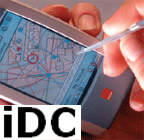
Mark Shepard's Response
It's encouraging to find such an outpouring of interest and critique on the subject of locative media and its relation to pyschogeography, mapping and urban play. While we had originally planned on addressing many of these issues in September as part of the Architecture and Situated Technologies thread, I think the current discussion provides an opening to address how an evaluation of certain locative media practices (and their failures) might provide a "sandbox" for thinking through the opportunities and dilemmas of a near-future world of networked "things". From locative media to atoms, bits and ubiquity.
As someone whose interest in the Situationists predates my work in new media, I have long felt uncomfortable with media art practices that claim or aspire to transpose concepts of pyschogeography and tactics of the dérive or detournment to contemporary urban environments. It is critical to remember that the dérive emerged in a specific historical context, one that I would argue no longer holds. In part a response to 20th century urban planning strategies promoted by modern architects associated with CIAM (Congrès International d'Architecture Moderne), the dérive sought to reclaim a space for the creative capacities of an imaginative subject in face of an onslaught of the functional rationalization of modern capitalism. CIAM's strategies aimed to reorganize the city - perceived as an ailing beast in need of a cure - through a strict functional segregation of dwelling, work and recreation (leisure) zones connected by rationalized transportation corridors.
Citing a 1952 study by Parisian sociologist Chombart de Lauwe that mapped the movements made in the space of one year by a student living in the 16th Arrondissement, Debord expresses outrage that her itinerary "forms a small triangle with no significant deviations, the three apexes of which are the School of Political Sciences, her residence and that of her piano teacher." [1] To a certain extent, the dérive was conceived to explicitly counteract this rationalization of patterns of movement through the city and the corresponding limitations imposed on the diversity, messiness, and richness of urban life. Understood as a form of ludic play, the expressed aim was to free people from "their relations, their work and leisure activities, and all their other usual motives for movement and action, and let themselves be drawn by the attractions of the terrain and the encounters they find there." With regard to kanarinka's comment about the gentleman invited to drift with them who "summed it up nicely" by saying "Sorry, I can't go with you. I have to work here until 8PM and then I have to go to my other job," I would argue that it is precisely this mentality that the dérive sought to address.
In evaluating locative media projects claiming or aspiring to a Situationist agenda, I often find myself questioning to what extent their deployment of mobile technologies ends up actually reifying this rationalization of patterns of use or movement. Put another way, to what extent do conventions for the use of consumer mobile technologies actually contribute to CIAM's agenda in their codification of modes of interaction with and within the contemporary city? Perhaps the most pertinent question for locative media might be: how might these technologies be (mis)used in an attempt to counteract (rather than reinforce) an ongoing rationalization and commodification of urban life? It would seem less a question of "locating" oneself, perhaps more one of getting lost...
Brian Holmes' critique of locative media [2] focused on a perceived noncritical ("naive") adoption of GPS technologies and Cartesian mapping systems in the context of Situationist aesthetics. Specifically, Holmes attacks the non-reflexive use of technologies developed by the military and their domestication in the context of scenarios of play, where aesthetics becomes politics as decor. This critique was originally delivered at a workshop held at the RIXC center in Latvia in 2003. Since then the field has expanded significantly, and while early locative media projects may have relied heavily on these technologies, it would be difficult to identify locative media exclusively with either GPS or Cartesian mapping today. At the same time, some contemporary projects built on GPS are far more reflective of the dark side of locative media. [3] This is not to say Holmes' critique no longer holds. Quite the contrary, as it would seem it has been in many cases internalized by the field. While this year's ISEA / ZeroOne San Jose symposium and exhibition presented a few GPS-based locative media projects, they were by no means the majority. Drew Hemment et. al.'s LOCA project is one example of a "pervasive surveillance project" aimed at raising public awareness of how certain consumer technologies (bluetooth in this case) enable tracking in ever more subtle ways. [4] Alison Sant's paper "Redefining the Basemap" [5] addressed the fact that many locative media projects still "remain bounded by datasets that reinforce a Cartesian and static notion of urban space" and made a call for alternative methods of mapping the city, particularly ones addressing the temporal dimension of urban experience.
The critique of GPS and Cartesian mapping systems is by no means new. Laura Kurgan's exhibit "You Are Here: Museu" (1995) [6], addressed the uncertainties that arise when relying on satellite tracking systems to know "where we are." Architect Stefano Boeri's essay "Eclectic Atlases" (1997) [7] addresses the failure of satellite imagery to adequately represent the contemporary metropolis and calls for alternate methods for mapping the city as experienced "on the ground." The exhibition and catalogue for "The Power of the City: The City of Power" (Whitney Museum of American Art, 1992) [8] explores alternative mapping practices of conceptual and performance art from the 60s and 70s in terms their relation to Baudelaire's Flaneur, Jameson's notion of cognitive mapping, and (then) contemporary readings of Situationist aesthetics. Kevin Lynch, in his oft cited treatise "The Image of the City" [10], acknowledged that the emotional dimension(s) of his cognitive maps were beyond the reach of his research methods. More recently Marina Zurkow, Scott Patterson and Julian Bleecker's "PDPal" (2003) [9] asks what might an "emotional" GPS look like?
Perhaps the most interesting take on the relevance of locative media today is that of Marc Tuters and Kazys Varnelis as expressed in their essay "Beyond Locative Media," published by Leonardo in conjunction with the Pacific Rim Summit [11]. Acknowledging that locative media has been attacked for its ambivalence with regard to commercial interests and its reliance on Cartesian mapping systems, they find these critiques nostalgic, "invoking a notion of art as autonomous from the circuits of mass communication technologies", which they argue no longer holds. Moreover, they make the case for locative media as a "conceptual framework by which to examine the certain technological assemblages and their potential social impacts. Unlike net art, produced by a priestly technological class for an elite arts audience, locative media strives, at least rhetorically, to reach a mass audience by attempting to engage consumer technologies, and redirect their power." At the dawn of an age where ubiquitous networked objects outnumber humans as generators and receivers of information, this effort is more important than ever.
+++
[1] Guy Debord. "Theory of the Derive" - http://library.nothingness.org/articles/SI/en/display/314
[2] Brian Holmes. "Drifting Through the Grid: Psychogeography and Imperial Infrastructure" - http://www.springerin.at/dyn/heft_text.php?textid=1523&lang=en
[3] See the Institute for Applied Autonomy's "i-SEE - Now More than Ever" - http://www.appliedautonomy.com/isee.html or Annina Ruest's "Track the Trackers" - http://www.t-t-trackers.net/
[4] LOCA - http://www.loca-lab.org/
[5] Allison Sant. "Redefining the Basemap" - http://www.intelligentagent.com/archive/ia6_2_interactivecity_sant_baseline.pdf
[6] Laura Kurgan. "You Are Here: Museu" - http://www.l00k.org/youarehere/you-are-here-museu
[7] Stefano Boeri. "Eclectic Atlases" in The Cybercities Reader (NY: Routledge, 2003)
[8] Cristel Hollevoet, Karen Jones, Timothy Nye. "The Power of the City: The City of Power (NY: The Whitney Museum of American Art, 1992)
[9] Marina Zurkow, Scott Patterson and Julian Bleecker. "PDPal" - http://www.pdpal.com/
[10] Kevin Lynch. "The Image of the City" (MIT, 1960)
[11] Marc Tuters and Kazys Varnelis. "Beyond Locative Media" - http://netpublics.annenberg.edu/locative_media/beyond_locative_media
+
mark shepard
+
http://www.andinc.org
iDC -- mailing list of the Institute for Distributed Creativity (distributedcreativity.org) iDC[at]bbs.thing.net http://mailman.thing.net/cgi-bin/mailman/listinfo/idc
List Archive:
http://mailman.thing.net/pipermail/idc/
Posted by jo at 10:03 AM | Comments (0)
August 21, 2006
Reflecting Back on Screens:
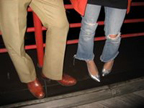
Inclusion & Exclusion
I'm back in Ottawa after a week in Banff with some really great people doing really great stuff, but before I switch my attention to fall teaching I'd like to think out loud about a few things that keep coming to mind.
It seems to me that our conversations on new media art ultimately revealed that it isn't the newness of media that's so interesting, but rather the artness of it. (Yes, I know that's not a word, but bear with me.) While "user-generated content" - or, as I prefer, public authoring and participatory media - repeatedly came up in conversation, it was quickly distinguished from artistic practice. While no one seemed willing to come right out and say it, I think the implied distinction was primarily quality-based, and both aesthetic and cultural quality are notoriously subjective.
My keynote address (which I'll post as soon as possible) chose to turn "screen" from noun to verb in an attempt to draw out the ways in which new media art and design practices involve acts of inclusion and exclusion. I tried to unpack a few of the primary metaphors that feed our notions of mobility, and I invited people to reimagine their senses of community and citizenship based on what it means to be in or out. The point of all this, of course, is to get producers of all sorts to acknowledge their own screening processes. In my mind, the most pressing political and ethical challenge facing us today is how we account for, and become accountable to, differences in perspective and practice. In other words, who gets to decide what constitutes quality content? The government? The broadcaster? The company? The artist? The designer? The academic? The public? And which public is that exactly? When it comes to collaboration, whose interests take precedence in which contexts? (As one artist said to me after my presentation, "I've realised I value art more than people.")
In my panel presentation (which I'll also post shortly) I discussed what I consider to be Proboscis' exemplary collaborative work, and how it was this sense of collaboration that helped shift a broadly technology-focussed project to a culturally-focussed one, or more specifically, how the two became entirely inseparable. Fiddian Warman also showed us a couple of Soda Creative's projects that specifically engage some of these questions, albeit in indirect ways. Both Nahnou-Together and b.tween2cultures explore what it might mean to create distinct cultural identities - together. Or how about this? The Residents and MOMA's new River of Crime Community Art Project seeks out a space for professionals and amateurs to work together. As "an exploration of the rise in popularity of instant-video-creation due to the proliferation of inexpensive video cameras, as well as both still cameras and phones that shoot video," ROCVID invites anyone and everyone to make a video - any way they like - to go with an audio clip provided by the legendary music group. Mass art and art for the masses indeed.
I'm sure I'll continue to think about these things as I prepare for my lecture on mongrel practices of art, design and anthropology at UIUC art + design next month, and as always, comments are welcome.
And for anyone interested, here are all my Interactive Screen 0.6 posts:
IA Screen : Introducing the Canadian new media context
The Convergence Conundrum: A Cross- Canadian Perspective on the Business of Content
Technology, Privilege and Innovation: The Legal Perspective
Creative Commons: Art, Activism and the Database
The View from Outside In: Margins of Art and Activism
The View from Inside Out: Margins of Technology and Business
Playing the Interface
Serious Games: Understanding the grey area between learning and playing
Filming Outside the Cinema
Blast Theory - Day of the Figurines workshop
The Impossibility Box: An Emotional Computation
(photo: Peter Horvath) [blogged by Anne Galloway on Purse Lips Square Jaw]
Posted by jo at 11:31 AM | Comments (0)
July 21, 2006
BUMP…
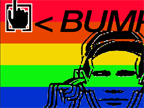
Reinstates the Virtual World with an Offline Voice
Artist Jaygo Bloom has been commissioned by folly, a media arts organisation based in Lancaster, to develop the sound work BUMP… for this year’s Futuresonic festival, in partnership with Manchester based digital signage organisation Pixel Inspiration. Futuresonic is the UK’s leading electronic and media arts festival, and takes place in Manchester in July 2006. According to Jaygo Bloom, the commissioned artist, "As computer technology becomes more sophisticated, the technology itself will fade into the background of human activities, becoming far less intrusive than is the case today."
Jaygo Bloom suspects the invisible, therefore he seeks to reverse the need for this technological transparency. BUMP… reinstates the virtual world with an offline voice. BUMP… is an online project that translates an online keystroke into an actual real time and physical event. BUMP… will reinstate the presence of this technological intervention over its environment via the quick shot, rapidfire, 8bit sounds emanating out of its location based folly sound modules located throughout participating venues of Futuresonic 2006. BUMP… presents an interesting view of networked interaction and social performance.
Jaygo Bloom concludes, "By attaching a physical connection to things we perceive as virtual, we can begin to make the intangible tangible."
Jaygo Bloom is a UK based multimedia artist whose practice includes audio visual installation, game hacking, film making and physical computing. Over the past year he has been developing a wide variety of new online and offline projects ranging from his globally aware interactive games console ‘Tao Joystick’ to his 8bit latino percussion interface ‘Marrackattack’. Working independently and also as part of the Glasgow based audio visual team 'Pointless Creations'. Popular for his public interventions, blue screens and old sports car, other successful projects have included Glasgow International05, Pixelache05, Recontres Paris/Berlin, and Pong.Mythos.
Posted by jo at 04:27 PM | Comments (0)
IOWA Review

Reconfiguring Place and Space in New Media Writing
"[...] While installations and VR environments have increasingly liberated the user's body from the seated-in-front-of-screen-at-keyboard position and brought the body inside the ontological space of the work itself, mobile computing and communication technologies are increasingly powerful and pervasive. Writers, artists, performers and "puppet-masters" are employing network writing strategies to deploy a variety of projects that extend from the network into the real world. Projects such as Teri Rueb's Itinerant [2005] make use of mobile and locational technologies including GPS and RFID to create narrative experiences affected by the user's movement through the physical world. In the case of Itinerant, as users walked through Boston Commons and surrounding neighborhoods they experienced an interactive sound work that re-framed Mary Shelley's Frankenstein.
Projects such as Yellow Arrow [2004-Present] pair coded stickers with text messaging, enabling users to write and read brief personal narratives about locations tagged in the physical world. Implementation [2004] is a fragmentary novel published on stickers that was deployed and photographed by participant readers around the world. Surrender Control [2001] utilized SMS as a performance medium, sending its users a series of directions as text messages, ordering them to perform a variety of absurdist actions during the course of their everyday lives.
Similarly, the phenonmenon of flash mobs makes use of text messaging to assemble groups of people for alternately absurdist and political activities. Extensible web technologies such as Google Maps paired with GPS coordinates also offer narrative possibilities, as evidenced by projects such as the "Memory Maps" group on Flickr, whose users have created personal narratives of places through coordinate-tagged photographs accessed through interactive maps [...] From Editor's Introduction: Reconfiguring Place and Space in New Media Writing by Scott Rettberg, The IOWA Review Web, v8 n2 July 2006.
Posted by jo at 04:17 PM | Comments (0)
GeoTracing
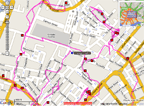
Live Reporting from Futuresonic
Waag Society is doing live reporting from Futuresonic using the GeoTracing TraceLand testbed application. GeoTracing is a software platform for creating multimedial geo-applications. What these applications have in common is that they allow you to tell your multimedial story via your movement through the landscape, whether on foot, skates, by bike or other means.
Posted by jo at 04:04 PM | Comments (0)
Leonardo Electronic Almanac
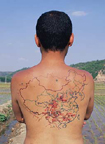
LOCATIVE MEDIA SPECIAL ISSUE
LOCATIVE MEDIA SPECIAL ISSUE; Guest Edited by Drew Hemment: A special issue of LEA, announced at the first event of the Pervasive and Locative Arts Network (PLAN) at ICA, London in 2005, is released to coincide with the final exhibition and conference of PLAN during Futuresonic 2006, Manchester, this weekend.
LOCATIVE MEDIA ESSAYS; Edited by Drew Hemment -- Anne Galloway and Matt Ward: Locative Media as socialising and spatializing practice :: Alison Sant: Mapping The Emerging Urban Landscape :: Leslie Sharpe: Swimming In The Grey Zones :: Lily Shirvanee: Locative Viscosity: Traces Of Social Histories In Public Space :: Julian Bleecker and Jeff Knowlton: A Brief Bibliography And Taxonomy of Gps-Enabled Locative Media :: Malcolm Mccullough: On Urban Markup: Frames Of Reference In Location Models For Participatory Urbanism :: Michele Chang and Elizabeth Goodman: Asphalt Games: Enacting Place Through Locative Media :: Steve Benford, Martin Flintham, Adam Drodz, Nick Tandavanitj, Matt Adams and Ju Row Farr: The Design And Experience Of The Location-Based Performance Uncle Roy All Around You :: Lalya Gaye and and Lars Erik Holmquist: Performing Sonic City: Situated Creativity In Mobile Music Making: Sally-Jane Norman: Locative Media & Instantiations Of Theatrical Boundaries :: Misha Myers: Homing Devices For Unhomely Times.
LOCATIVE MEDIA GALLERY--Curated by Suhjung Hur, Annie On Ni Wan, Andrew Paterson, Locative Media, on and off the beaten track
Paula Roush Bowville Fictitious Constituency
Teri Rueb Choreography of Everyday Movement
Angela Piccini Guttersnipe: on the road to Helsinki
John Evans, Drew Hemment, Theo Humphies and Mika Raento LOCA:
Location Oriented Critical Arts
Qin Ga Long March
Jesper Dyrehauge, Marie Markman and Nis Romer Planteundersøgelser Taeyoon Choi in collaboration with I&P Media Art Team Shoot me if you
can
Jang-Won Lee sunTracer
Mark Shepard Tactical Sound Garden
Erica Block and Hilary Ramsden The Walking Project: Desire Lines,
Walking and Mapping Across Continents
LOCATIVE MEDIA CURRICULUM AND BIBLIOGRAPHY: Collaboratively developed by Drew Hemment, Steve Bull, Elizabeth Goodman, Pete Gomes, Derek Hales, Hana Iverson, Paula Levine, Lorna MacDonald, Ian MacColl, Ann Morrison, Teri Rueb, Alison Sant, Leslie Sharpe, Jen Southern, Nick West and Nisar Keshvani.
MIT Press Journals
Five Cambridge Center, Cambridge, MA 02142
phone: 617-253-2889 / fax: 617-577-1545 / journals-orders@mit.edu
art / science / technology
http://lea.mit.edu
lea[at]mitpress.mit.edu
Leonardo Electronic Almanac (ISSN: 1071 4391)
Nisar Keshvani, Editor-in-Chief
Established in 1993, Leonardo Electronic Almanac (ISSN No: 1071-4391) is, jointly produced by Leonardo, the International Society for the Arts, Sciences and Technology (ISAST), and published by MIT Press, is an electronic journal dedicated to providing a forum for those who are interested in the realm where art, science and technology converge. For over a decade, LEA has thrived as an international peer reviewed electronic journal and web archive covering the interaction of the arts, sciences, and technology. LEA emphasizes rapid publication of recent work and critical discussion on topics of current excitement with a slant on shorter, less academic texts. Many contributors are younger scholars, artists, scientists, educators and developers of new technological resources in the media arts.
Posted by jo at 03:42 PM | Comments (0)
July 19, 2006
Ruth Ron
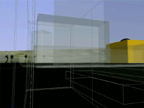
Visible City + Upgrade! Telaviv-Jerusalem
Visible City -- by Dan Collins, Dianne Hansford, and Ruth Ron -- uses Augmented Reality (AR), Mobile Computing (GPS), and 3D Simulated X-Ray Models developed in animation and CAD applications to visualize and navigate the urban core of San Jose (ISEA2006). Augmented reality (AR) in tandem with GPS-based mobile computing applications allows intuitive information browsing of location referenced information. In AR, the user's perception of the real world is enhanced by computer generated entities such as 3D objects, location markers, superimposed text, and spatialized audio. The interaction with these entities is available in real-time to provide convincing and natural feedback to the user. The coupling of Augmented Reality with location based information (GPS) and high-end 3D modeling enables the integration of virtual entities with real world objects in a seamless manner.
![]()
Ruth Ron is an architect and digital artist, whose work focuses on the extension and deformation of real space by using virtual assets. Her work explores the borders between architecture and technology, form and media. She has exhibited in New York, Seattle, Paris and Jerusalem. In her lecture, Ruth will show samples of her spatial installations, online interactive work and some current research of interface between the computer and the physical environment.
Upgrade! Tel-Aviv-Jerusalem: Monday, 24.7.06, 19:30 @Minshar, David Chachmi st. 18, Tel Aviv.
Posted by jo at 04:05 PM | Comments (0)
July 18, 2006
Battleship:GoogleEarth
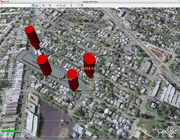
(a 1st Life/2nd Life mashup)
I've started working on a bit of summer laboratory experiment to see how Google Earth could become a platform for realtime mobile gaming. (Follow the link on the Flickr photo page to the URL you can load in your Google Earth client to see the game board in its current state.) With Google Earth open enough to place objects dynamically using the tag, a bit of SketchUp modeling and borrowing an enormous battleship model that construction dude uploaded to the SketchUp/Google 3D Warehouse, I started plugging away at a simple game mechanic based on the old Milton Bradley Battleship game.
Battleship, for those of you who never played, has a simple mechanic — two players set up their navy ships on a peg board, hidden from the other guy. You take turns plugging a peg into your side of the board, with each peg hole designated by a letter/number coordinate grid. When you plug a peg in, you say where you put it — E4! If your opponent has a ship in that coordinate (or part of one, actually), they say, sorrowfully, "Hit!" and you register that peg hole with a color to indicate a hit. If not, you just put in a neutral peg to remind you that you already tried that spot. The game continues into one player has sunk all the other guys ships.
The mechanic I'm experimenting with is simpler. One person places their ships using Google Earth and the other person goes out in the normal world with a mobile phone, a GPS connected to the mobile phone. The phone has a small Python script on it that reads the GPS and sends the data to the game engine, which then updates the Google Earth KML model showing the current state of the game grid. When the player who's trying to sink the ships wants to try for a hit, they call into the game engine and say "drop". The game reads back the coordinates at which the "peg" was dropped and shortly thereafter, the other player will see the peg appear at the coordinate it was dropped. If the peg hits one of the ships, it's a Hit, otherwise it's a miss.
Next Steps
As I continue developing the engine, I'll probably have the game engine let you know when you call in to do the "drop" whether it was a hit or not, or the opposing player can text or call to indicate the same.
I want to put in a "ping" command for the call-in battleship control center to help whoever's wandering around in the world navigate a bit. (Although the game is only really practical if you limit the boundaries over which it can be played.)
I need a lighter weight battleship — the current SketchUp model is too large, in data size terms and takes too long to initially load (although, it only needs to be loaded once.)
Goals
* Experiment with "1st Life" action reflected in "2nd Life" worlds (verso of the folly Ender suffered in Orson Scott Card's simply fascinating Ender's Game
* Learn KML
* Learn SketchUp
* Learn Python for S60
* Make a mobile/pervasive game in which one has to move around in order to play
Equipment
* Google Earth client
* Apache+Tomcat+MySQL (Java and JSP on the server-side computer)
* Nokia N70 and a little Python app to connect to the Bluetooth GPS and upload the data to the server
* Voice Application (for the battleship control center to drop/ping)
* SketchUp
Time Committed: * About 2 days learning stuff, and 1/2 a day programming the computer to make it do things.
Why do I blog this? To keep track of and share the near future laboratory experiments I'm doing this summer.
Technorati Tags: mobile, pervasive electronic games, pervasive media, play, urban play
[blogged by Julian Bleecker on research techkwondo]
Posted by jo at 08:22 AM | Comments (0)
July 13, 2006
GLOWLAB 09: july :: august 2006

Networks, Mobility, Interventions
The projects in Glowlab 09 examine urban architecture by investigating the social spaces enabled by public networks, mobile communication devices and direct intervention. In viewing the work, one might re-imagine the city as space which is defined through the nature of the interactions that take place within it.

Public Broadcast Cart by Ricardo Miranda Zuñiga: Transforms a shopping cart into a mobile radio station, transmitting via miniFM and the Internet. The Public Broadcast Cart is designed to enable any pedestrian to become an active producer of a radio broadcast by reversing the usual role of the public from audience to producer.

Hundekopf by Brian House and Sue Huang (Knifeandfork): A location-based narrative project utilizing SMS text-messaging to explore the experience of riding the Berlin Ringbahn.

Relay: Toronto by Germaine Koh: An architectural intervention that turns a building into a sort of urban lighthouse, relaying text messages received on a mobile phone by flashing the building lights in Morse code.

Lee Walton's Western Shift by Allard van Hoorn: An open-environment collaboration between researchers, architects, designers, artist, curators and all kind of cultural producers. Its aim is to stimulate fresh ways of looking at urban living and discover alternative solutions.

SpeedWave by Otino Corsano: A photographic based performance piece inspired by the established location of a regularly monitored Toronto speed trap. A camera on a tripod replaces the laser gun to document waves of local traffic.

Talking Cities [magazine review] by Krista Jenkins: A review of the recently published Talking Cities magazine, the print accompaniment to the exhibition of the same name, taking place at Zeche Zollverein in Essen, Germany.
Glowlab is an artist-run production and publishing lab engaging urban public space as the medium for contemporary art and technology projects. We track emerging approaches to psychogeography, the exploration of the physical and psychological landscape of cities. Our annual Conflux festival, exhibitions, events and our bi-monthly web-based magazine support a network of artists, researchers and technologists around the world.
Posted by jo at 02:11 PM | Comments (0)
July 11, 2006
Simon Elvins' Silent London
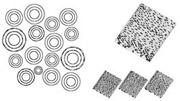
Mapping Sound
Simon Elvins is concerned with sound as an ubiquitous force. Through a series of projects he has been documenting how sound is an often ignored dimension of our physical environment. Silent London plots quiet spaces in the English capitol using noise level data. An embossed print shows quiet areas raised up from the paper, bringing them to the attention of the viewer, while noise areas become blanked out valleys. noisy areas raised up from the paper while quiet areas become blank areas of peace. His FM Radio Map serves a dual purpose. On the one hand it plots the physical locations of commercial and pirate FM radio stations broadcasting in London. But circuits conductive pencil lines placed on the back of the map also turns it into a physical interface. Using a modified radio the map can be aurally “navigated” by placing metail contacts on points on the map.
These projects are poetic but ultimately functional. Taking a conceptual design approach (Elvins studied Communication Art & Design at the Royal College of Art), they present numerical data in an aesthetic context. By choosing low-tech materials (paper, electronics) Elvins creates fragile objects whose material qualities belie their sophisticated technical content.
Simon Elvins is concerned with sound as an ubiquitous force. Through a series of projects he has been documenting how sound is an often ignored dimension of our physical environment. Silent London plots quiet spaces in the English capitol using noise level data. An embossed print shows quiet areas raised up from the paper, bringing them to the attention of the viewer, while noise areas become blanked out valleys. noisy areas raised up from the paper while quiet areas become blank areas of peace. His FM Radio Map serves a dual purpose. On the one hand it plots the physical locations of commercial and pirate FM radio stations broadcasting in London. But circuits conductive pencil lines placed on the back of the map also turns it into a physical interface. Using a modified radio the map can be aurally “navigated” by placing metail contacts on points on the map.
These projects are poetic but ultimately functional. Taking a conceptual design approach (Elvins studied Communication Art & Design at the Royal College of Art), they present numerical data in an aesthetic context. By choosing low-tech materials (paper, electronics) Elvins creates fragile objects whose material qualities belie their sophisticated technical content.
Parallel to Elvin’s interest in sound is his fascination with mapping of physical and intangible forces. Both the aforementioned projects are classic mapping projects, while Notation is a more abstract exploration of how sound can be represented visually as marks on paper. Reminiscent of experiments with graphic notation (see Eno etc), the project consists of studies of representations of tonal patterns using pencil on paper.
The Notation project page seems to indicate that these drawings can ultimately be used to produce sound, but no details are available. If so, it would be an inversion of Elvin’s excellent Paper Record Player, where he constructed a functional record player out of paper, complete with its own conical paper amplifier.
(Thanks to TomC. See also Mount Fear.) [blogged by Marius on Generator.x]
Posted by jo at 09:24 AM | Comments (0)
July 07, 2006
Marc Tuters and Kazys Varnelis
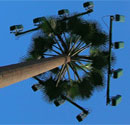
Beyond Locative Media
"Locative media has been attacked for being too eager to appeal to commercial interests as well as for its reliance on Cartesian mapping systems, yet if these critiques are well-founded, they are also nostalgic, invoking a notion of art as autonomous from the circuits of mass communication technologies, which we argue no longer holds. This essay begins with a survey of the development of locative media, how it has distanced itself from net art, and how it has been critically received before going on to address these critiques and ponder how the field might develop.
At the 2004 Transmediale festival in Berlin, a locative media project titled .walk (dot-walk) received an honorable mention in the prestigious festival's Software Award. Developed by Utrecht-based arts collective Social Fiction, .walk combined computer code and "psychogeographic" urban exploration. Participants of .walk left the doors of the gallery to follow a randomly generated path through the city, thereby, according to Social Fiction, "calculating" the city as though it were a "peripatetic computer." The success of this simple project is representative of a larger event taking place in the media art world, in which, having left behind net art, locative media escaped the bounds of the screen to enter the city at large." Continue reading Beyond Locative Media by Marc Tuters and Kazys Varnelis.
Posted by jo at 03:57 PM | Comments (0)
July 06, 2006
Always ON
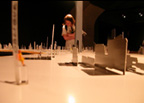
New Augmented Space and its Memory
The concepts of place, proximity and distance are going to be substantially rewritten by the locative media evolutions. The origins of this process are not only related to the abstract digitalization or to the latest hi-tech gadgets, but they are more significantly rooted in social changes induced by the overflowing of the net space. The social access and the subsequent construction of net space started in middle nineties, so the perceived 'space', as a public, collective and shared dimension was slowly literary doubled in the digital dimension. The next step is the actual ongoing process of joining back these two halves (real and virtual space) in an augmented reality that is a real experience. If the man on the moon broke the 'external' boundaries perception of that time, the net integrated in the urban space has definitively broken the actual inner spatial boundaries outdating the established physical perception as the only possible coordinates to sense the space.
The net is based on one hand on a subject (its IP) directly addressable from every (good or evil) point of view. On the other hand the same subject is able to add his own data and memory to his own space, building a digital environment piece by piece. These tough changes are investigated and enhanced in the impressive work made by the Sonarama 2006 curatorial team (José Luis de Vicente, óscar Abril Ascaso and Drew Hemment and Advanced Music). After Micronations (2004) and Randonnée (2005) the last part of this contemporary territory conceptual mapping has been accomplished through a selection that emphasize different "permutations of the mobile syntax" as de Vincente defines it. In the ground floor of the CCCB, the exhibited works were placed in dark corridors and rooms, that like a maze, was an ideal location.
The most awaited project was undoubtedly Blast Theory's premiere of 'The day of the figurines', a social multiplayer game played via sms, reflected in a fictitious world of real figurines. With more than three hundred players in three days (actually it can hosts up to one thousand players) it shaped a small world that was reflected in a physical update. In fact authors moved figurines and forms by hand every twenty minutes, updating the representation of the online latest developments. Here again the usual 'virtualization' of reality structures was inverted. The process was the opposite of webcams: instead of taking a glimpse of a real space, the mapping of the online process was a slow update of a plastic scenario, much more attractive and meaningful to our instincts than a real-time colorful graphic on a screen. In the locative media horizon, many are the shades of the distance.
Zexe.net was a project by The Golden Nica winner Antoni Abad with the same concept of giving mobile phone with cameras to special group of people and selecting their pictures/vision, focused on latin taxi drivers, gipsies and prostitutes. How far is their own landscape, represented through our shining technology? And changing perspective how far is our own home, if we can easily see it from a satellite view? Jeremy Wood's Meridians, a psychogeography text composed as a gps-draw on a very famous London area, remind us the shock of zooming on a photograph (not anymore an abstract color representation) of our own daily territory. This is impacting our neighborhood vision, temporary establishing a center where we live (or we are at the moment) and considering the world as a surrounding. It's a sort of ego-geography, able to stunningly visualize as real what we've already seen as a zoomed out draw.
Amongst the other showed (or performed) projects included Michelle Teran's classic Life's a User's Manual, Counts Media social platform Yellow Arrow, the last Transmediale software art award winner Socialfiction's .walk (article on Neural 23), another psychogeographical approach in Alejandro Duque's TTSM (Typewriter Tracklog sewing Machine), a new iPod version of the imaginative G-Player, the relationship between space and sensations in Christian Nold's Bio Mapping, the performance by accident, treasure hunt Geocaching practices and the RFID hacking of Preemptive media's Zapped! like the coackroach with an RFID on his back confusing a supermarket reader because of its unpredictable movements. The urban space is a collective memory mirror. And the memories of the last thirty years have been mediatised more than any previous period. The process of easily juxtaposing personal memories, histories and territories would enable another new level of consciousness of reality, stratified on our mediated identity. View the Sonar 2006 photo gallery. [posted on Neural]
Posted by jo at 12:27 PM | Comments (0)
July 04, 2006
Architecture and Situated Technologies
![]()
Pre-Symposium Discussion
A three-month long discussion will prepare the Architecture and Situated Technologies symposium in October 2006. Contribute or follow the discussion. This symposium is a coproduction between the Center for Virtual Architecture at the University at Buffalo, The Institute for Distributed Creativity, and the Architectural League of New York.
Introduction: The Architecture and Situated Technologies symposium, organized around the notion of an "encounter," will articulate new research vectors, sites of practice, and working methods for the confluence of architecture, art, and situated technologies.
What opportunities and dilemmas does a world of networked objects and spaces pose for architecture, art, and computing? How might this evolving relation between people and "things" alter the way we occupy, navigate, and inhabit the built environment? What is the status of the material object and the embodied human relationships in a world privileging networked relations between "things"? How do distinctions between space and place change within networked media ecologies? What post-optimal design strategies and tactics might we propose for an age of responsive environments, smart materials, embodied interaction, and participatory networks?
While there is an explosive growth of mobile devices, the social uses of technologies are not sufficiently studied in terms of architecture. What distinguishes the emerging urban sociality enabled by the Wireless Internet? How do these dynamics, including (non-)affective giving destabilize rationalized 'use case scenarios'?
These are just a few urgent questions that the symposium will raise.
Through a combination of public and closed segments (workshops, presentations, and panel discussions), the symposium will stage a set of encounters between invited participants, an audience encouraged to participate, and the City of New York.
List facilitators:
July: Trebor Scholz
Topics: Networked Public Sphere, Autonomous Uses of Situated Sociable Media
August: Omar Khan
Topics: Performance Paradigms, Responsive Architecture and Artificial Ecologies
September: Mark Shepard
Topics: Locative Media, Tactical Urbanism, Situated Aesthetics
Posted by jo at 11:39 AM | Comments (0)
Architecture and Situated Technologies
![]()
Pre-Symposium Discussion
A three-month long discussion will prepare the Architecture and Situated Technologies symposium in October 2006. Contribute or follow the discussion. This symposium is a coproduction between the Center for Virtual Architecture at the University at Buffalo, The Institute for Distributed Creativity, and the Architectural League of New York.
Introduction: The Architecture and Situated Technologies symposium, organized around the notion of an "encounter," will articulate new research vectors, sites of practice, and working methods for the confluence of architecture, art, and situated technologies.
What opportunities and dilemmas does a world of networked objects and spaces pose for architecture, art, and computing? How might this evolving relation between people and "things" alter the way we occupy, navigate, and inhabit the built environment? What is the status of the material object and the embodied human relationships in a world privileging networked relations between "things"? How do distinctions between space and place change within networked media ecologies? What post-optimal design strategies and tactics might we propose for an age of responsive environments, smart materials, embodied interaction, and participatory networks?
While there is an explosive growth of mobile devices, the social uses of technologies are not sufficiently studied in terms of architecture. What distinguishes the emerging urban sociality enabled by the Wireless Internet? How do these dynamics, including (non-)affective giving destabilize rationalized 'use case scenarios'?
These are just a few urgent questions that the symposium will raise.
Through a combination of public and closed segments (workshops, presentations, and panel discussions), the symposium will stage a set of encounters between invited participants, an audience encouraged to participate, and the City of New York.
List facilitators:
July: Trebor Scholz
Topics: Networked Public Sphere, Autonomous Uses of Situated Sociable Media
August: Omar Khan
Topics: Performance Paradigms, Responsive Architecture and Artificial Ecologies
September: Mark Shepard
Topics: Locative Media, Tactical Urbanism, Situated Aesthetics
Posted by jo at 11:39 AM | Comments (0)
July 03, 2006
Turbulence Commission
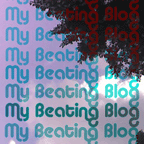
My Beating Blog by Yury Gitman
My Beating Blog is an attempt to take the journaling aspect of blogging into a surrealistic future in which the author literally and metaphorically bares his heart. For three weeks, a series of posts contextualizing heart-rate visualizations, GPS-maps, and personal journal entries will give online users a rare entrance into personal medical-grade statistics, stalker-level location tracking, and the private thoughts of the blogger. Inevitably, issues regarding privacy, exhibitionism, and voyeurism playfully emerge as the blogosphere is infused with biofeedback and location technology. Rather than play into a dystopian or Orwellian future, blogs and biofeedback are given poetic license, reframing our awareness of our own and each others' beating hearts.
My Beating Blog is a 2005 commission of New Radio and Performing Arts, Inc. for its Turbulence web site. It is supported by the Jerome Foundation in celebration of the Jerome Hill Centennial and in recognition of the valuable contributions of artists to society.
Yury Gitman is a designer, inventor, and award-winning artist. He has exhibited at the Biennale of Electronic Arts, Perth, Australia; Isle de France, Paris; Ars Electronics, Austria; and Eyebeam, among others, New York City. Gitman was one of the first people to use the Internet from inside the New York subway. He did this by employing a network of his "Magicbikes" ("wireless bicycle hotspots"). He was awarded the Ars Electronica Golden Nica for Net Vision in 2003. In 2005 he opened Banana Design Lab, a product design company focusing on lifestyle designs to entertain the soul.
Gitman has worked with non-profits such as NYCWireless, the Lower Manhattan Cultural Council, and the Downtown Alliance to promote open Internet policy and New Media Art practice in New York. He teaches an Electronic Toy Design class in the Design Technology MFA program at the Parsons School of Design. He received a Masters degree from New York University's Interactive Telecommunication Program and a Bachelor of Science in Science, Technology, and Culture from the Georgia Institute of Technology. Gitman's work has featured in local, national, and international media including BBC, The New York Times, Newsweek, NPR, New York 1 TV, Tech TV, CNET, ID Magazine, Readymade, Village Voice, Adbusters, and Utne Reader. [Related networked_performance posts 1, 2, 3, 4, 5, 6]
Posted by jo at 01:35 PM | Comments (0)
June 23, 2006
GPS EXPO 2006

It is the salt flats :: It is America :: It is free
GPS EXPO 2006: Greetings geocachers, anthropologists, mappers, landscape photographers, GIS users, artists, backpackers, and others with a nominal interest in the Global Positioning System. The event will happen in UTAH and it might be interesting to you. It is real, really informal, free, non-sponsored, and on the salt flats of the GREAT SALT LAKE. Just people and the creative things they are doing with GPS putting together their interests at an amazing place at the same time. The location is on public land, is rugged although perfectly flat and normally drivable, and it requires no particular permission to assemble there. If you take proper safety precautions (H20, sunglasses) you might find it an interesting day of navigation and others navigating with GPS. Cheap to moderate hotel rooms are available in the nearby casinos in West Wendover, NEVADA.
Please join the group and document your project or experience at GPS Expo 2006.
Posted by jo at 06:36 PM | Comments (0)
June 22, 2006
Networked Place Book

Call for Comments
"As a culmination to the Networked Publics program, we are publishing a collaboratively written group book with the MIT Press. As part of this process, we are soliciting reader comments for inclusion in the book. Below is a draft of the essay on Networked Place (note that there is a word document attached too... it is likely easier to read). We intend to take the comments that we received and append them to the essay in a virtual symposium that will follow each chapter. In doing so, we hope to create a more dialogic forum within the book. Please leave your email addresses so that we can get in touch with you about your contribution.
Introduction: Contemporary life is dominated by the pervasiveness of the network. With the spread of the mobile phone worldwide (arguably history’s most successful gadget) and the growth of always-on broadband in the developed world, technological networks are becoming easier to access and more ubiquitous. The “always-on,” “always-accessible,” network—or at least the promise of that condition—has produced a broad set of changes to our concept of place, linking space to network to create networked place.
"The following essay addresses both the networking of space and the spatiality of the network. We identify a series of conditions symptomatic of the culture of network “space”: the everyday superimposition of simultaneous real and virtual spaces, the development of a mobile sense of place or “telecocoon,” the emergence of real virtual worlds, the rise of the network as a socio-spatial model, and the use of mapping technology as a means of understanding the world. At the same time, we recognize that these changes are not simply produced by technology. On the contrary, the development and practices of technology (and the conceptual shifts that these new technological practices produce) are thoroughly imbricated in culture, society, and politics.
Taken together, these changes are already radical, but they may not be radical enough. These could well be the first steps in restructuring our concept of spatiality. The changes we listed above—and describe below—may be mere evidence of the early days of sociocultural shifts of which we can only be partially aware, just as the first theorists of modernism and postmodernism could only partially understand the emerging condition of their day." Continue reading Networked Place by Kazys Varnelis and Anne Friedberg, Networked Publics.
Posted by jo at 05:41 PM | Comments (0)
June 20, 2006
Floating Points:

Locative Media, Perspective, Flight
The primary concern in locative media has been, understandably, location. This has been a great new leap in terms of art, technology, science and narrative. Locative Media Art consists of artworks utilizing locative technology to trigger artworks in a specific physical space.
Locative media art goes back to early experiments such as Telepresent by Steven Wilson in 1997 that was an object equipped with GPS left to be communally interacted with and moved while continually sending images via the Internet.
Another key development was the GPS drawings of Jeremy Wood in 2000 in which he discovered that by tracing his movements as he drove or walked with GPS that he could form shapes formed by the sequence of plotted movements. Other projects worked with Geo-Annotation which placed a comment or reflection on a physical location (similar to what hikers for years would do at posted signs on certain trails). Then came the project 34 North 118 West that was the first locative narrative.
34 North 118 West was a mapping of a four block area of Los Angeles where the primary non-passenger rail yard and related infrastructure at the turn of the last century and the original grand passenger station of Los Angeles (La Grande station) once stood. The majority of the buildings are the same but have changed in usage in time, state of disrepair and who has come to live and work in them in waves of development and housing.
Other buildings were destroyed over the years and only the ghosts of historical information and personal accounts remain. The project created a "narrative archaeology" as the layers in time were to be agitated into being. In one place would be narrativized data from 1936 a few hundred feet from a spot before a building that triggered something from 1910.
Now groups such as the C5 collective are doing work such as the GPS mapping of the entire great wall of china and then placing the coordinates in another location. This type of work creates a layered commentary and plays with form and semiotics as well as referencing the Situationists who developed absurd commentaries like a walk through the streets of Paris following a map of another city..." Continue reading Floating Points: Locative Media, Perspective, Flight and the International Space Station by Jeremy Hight with Alexander van Dijk, Hz Journal, #8, June 2006.
Posted by jo at 09:46 AM | Comments (0)
June 16, 2006
Mapping System/Bird's Eye View

Overlapping of city space and web space
[posted by Yukihiko YOSHIDA] Collaboration of Performance Artist and Mapping System / Media Art Team Un-simultaneous / Tokyo: Hidenori Watanabe (photon.co); Yukihiko Yoshida (dance critic, digital community); Taro Nishimoto (artist, director); and Kazuho Kimura (editor, "Save the Shimokitazawa").
We are taking a lot of pictures of "Image of the city" and archiving them in the web-space now. Moreover, we can plot them on the map of Google Earth/Maps automatically or manually, by using "Mapping System".
Now, we can experience both of bird's eye view/overall aspect and looking up/personal aspect with a familiar tool. A new interpretation to the city will come to the consideration field when individual's aspect are overlapped in the bird's-eye view. But, it is necessary to set the theme "Of what do you take a picture?" to derive a persuasive result of workshop.
The collaboration with the performance artists is planned in this workshop. It is a collaboration of Artists who do the expression activity by a personal body and "Mapping system", the tool of bird's-eye view.
Let's think about "Overlapping of city space and web space", "New interpretation method of city space", through walking in the town, taking a picture, and mapping.
Please prepare the camera phone with the GPS function or Digital camera and GPS device if possible when you participate.
"Mapping system" is developed by Photon, Inc. Please refer to "Sakura Mapping Project" project. (Green Photon + Executive committee of Earth Day Tokyo). http://mapping.jp
Posted by jo at 08:59 AM | Comments (0)
June 15, 2006
Mike Pearson and Mike Brooks
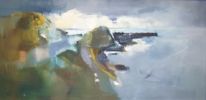
In Comes I + Zero Minus One
In Comes I: Performance, Memory and Landscape by Mike Pearson: In Comes I is about performance and land, biography and locality, memory and place. The book reflects on performances past and present, taking the form of a series of excursions in the agricultural landscape of eastern England, and drawing from archaeology, geomorphology, folklore, local and family history.
Mike Pearson, a leading theatre artist and solo-performer, returns to the landscape of his childhood-off the beaten track in Lincolnshire-and uses it as a mnemonic to reflect widely upon performance theory and practice. Rather than focusing on author, period and genre as is conventional in the study of drama, the book takes region as its optic, acknowledging the affective ties between people and place.
Offering new approaches to the study of performance, he integrates intensely personal narrative with analytical reflection, juxtaposing anecdote with theoretical insight, dramatic text with interdisciplinary perception. The performances, ranging from folk drama to contemporary site-specific work, are seen in their relationship to their cultural and physical environment. 272p, c. 40 b/w photos and map (University of Exeter Press 2006)
Zero minus One: The appropriation of existing and emerging technologies and their influence on performance practice’ by Mike Pearson, PARIP 2005--International Conference | 29 June - 03 July 2005.
"Workshop Abstract: The relationship between performance and technology can be traced back to the origins of human communication and interaction. Within the field of theatre, performance and live art, many practitioners have explored this relationship, using technology as a tool, to play with our perceptions and reflect on our lives (e.g., Fluxus, ‘body artists’ such as Acconci; experimental theatre companies such as the Wooster Group and the works of Wilson and Lepage). Alongside this, cyber-oriented artists such as Orlan and Sterlarc have extended this work by actively creating an ongoing performative dialogue between corporality and cybernetics.
In further developing the visceral body through the use of technical and digital tools, Orlan and Sterlarc re-examined the mutuality between the individual, the sociocultural and the biological. New emerging technologies continually challenge this triad. Pervasive platforms such as mobile telephony, locative media and massively multiple online game (MMOG) technologies, provide new performative forms and experiences. Consequently our notions of the spaces and places around, through and within which performance occurs are persistently pushed as virtual, parallel timelines become everyday practices. Alongside these openings, the role of the ‘audience’ continually shifts as they become actively involved, even co-participants within the performance.
As contemporary practitioners working in this field we persistently struggle to adequately articulate our practices and theoretical locate our work. In attempting to explore the different theoretical perspectives emerging within this field, this workshop brings together practitioners in the field of digital performance. Common across our practice is the appropriation and redesigning of existing and emerging technologies for performative purposes. From a theoretical perspective we draw on sociocultural psychological theory; cultural, film and new media theory; cyber theory, robotics and anthropology.
In order to adequately discuss this area, we have chosen the workshop format as a means through which to explore key research questions. Each participant will present their perspective, from which an open discussion with those attending will follow. Our discussions will be augmented with extracts for our work in this area. The open discussion format will explore in more detail convergences, divergences, connections and slippages within this field. The aim of the workshop is to distil a set of methodological principles, which we consider best articulates our practice and future trends within this area. The workshop will specifically address the following questions:
1. How are new emerging technologies (virtual, haptic, tangible, mobile technologies, robotics) incorporated into performance and how do they reorganise and reconstruct our notion of performance and performativity?
2. What kinds of terminology and methodologies are useful for discussing the design of new techno-performative tools and how does their design relate to existing approaches within other disciplines?
3. How does the appropriation and creation of new techno-performative tools extend the performers’ body and mediate or signify their intentions?
4. How do techno-performative tools change the spatial and temporal dimensionality of the performance – what kinds of experiences do they afford and constrain?
5. Within new digital performances what kinds of relationships and transactions emerge e.g. audience and or performer as spectator, witness, collaborators etc?"
Session abstract: Who are you looking at? by Mike Pearson and Mike Brookes
Since 2001 Pearson/Brookes has created a series of multi-site performance works, including Carrying Lyn (Cardiff, 2001), Polis (Cardiff, 2001), Metropolitan Motions (Frankfurt, 2002) and There's someone in the house (Exeter, 2004).
Within these works actions are staged at dispersed locations in the urban environment - often within the public domain - and recorded on low grade technology: tapes and discs are then returned immediately to a venue now rendered porous. Here the record of what happened ‘out there, ‘just now’ is assembled, ordered dramaturgically and replayed.
The works pose a number of questions. As each performance is generated in a number of places, often simultaneously, is co-presence any longer a useful definition of performance? Where is this performance actually happening? And is the feedback loop of action/response/ readjustment any longer an essential feature of performance? How many audiences are there here?
The document has repositioned itself within the performance rather than being a ‘post-event’ phenomenon. Is the audience already watching a document? And as the work remains resolutely analogue - transporting physical objects that then have to be rewound/lined up - time itself is troubled. When did this happen?
Mike Pearson and Mike Brookes present an overview of the series and the issues it raises - not least of distinctions between professional practice and scholarly practice in the field of ‘practice-as-research’.
They introduce developing DVD-ROM work, created by Mike Brookes, presenting strategies through which he is attempting to appropriately reconstitute the material of these events – within the form and limits of this alternative media - whilst embodying the original propositions of that material. The intention being to allow a direct encounter with the work - its structure, accumulation and consequences - rather than to reproduce any particular view of the physical and ambient constructs on which that encounter originally stood.
[via nicholas_senn, Critical Spatial Practice]
Posted by jo at 03:35 PM | Comments (0)
Autotopography:
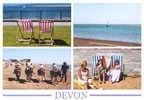
Graffiti, Landscapes & Selves
Dee E. Heddon's essay discusses the ways in which subjectivity and place converge in the practice of "Autotopography" or the writing of oneself in and on the landscape. Her discussion of graffiti, as it appears scattered throughout the landscape, marks the passage of subjects through the environment as it teases out elements of her own subjectivity. Heddon's process of narativizing space, time, and self tells a fascinating tale of appearing and disappearing identities hidden in the cracks and crevices of everyday life.
"...For some time now I have been interested in autobiographical performance -- some form of the theatrical, in which performers explicitly use personal material in their work. Within this general field of autobiography and performance, one area of research concerns performances that are dependent on being located in personalised space -- what could be called, then, site-specific autobiographical performance. A recent example of this would be the performance Bubbling Tom (2000), by the UK based performer Mike Pearson, which saw Pearson return to the village of his childhood, to reflect upon and re-enact certain memories, events and persons associated with his five year old self, in that place..." Autotopography: Graffiti, Landscapes & Selves by Deirdre E. Heddon.
Posted by jo at 03:24 PM | Comments (0)
June 14, 2006
Landlines Workshop
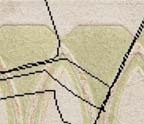
Urban Digital Peel
Artist/Researchers at the University of Huddersfield Centre for Excellence in Digital Design Jen Hamilton and Jen Southern are offering a series of workshops at the Media Centre in Huddersfield next week (June 19 – 23, 2006). The workshop introduces a new technology they call "Landlines".
Landlines uses GPS-enabled mobile phones to notate urban environments. The programmed phone sends images and spatial co-ordinates live to a website. Personal memories of a place, controversial regeneration, and historical are uploaded, and archived as line maps and 'tracked' photographs on a website.
For Hamilton and Southern, these maps can be used to discover what specific places mean to people, and how these places are used. The workshop investigates the correspondence between planning, urban regeneration and design, with the Landlines technology. Workshop is open to all.
Workshop Agenda:
- Introduce the Landlines application;
- Have participants use Landlines to make a map of the area, according to their own specifications and ideas;
- Return to the Media Centre and discuss the maps made by participants, and see individual map notation on-line
- Discuss Landlines potentials; outline and ‘brainstorm’ modifications
‘Landlines’ technology was developed in an artist/industry partnership between Hamilton and Southern and Onteca Ltd, Liverpool, and funded thru a NESTA ‘ITEM’ grant in 2004.
Sign-up Details: There are half-day workshops:
Monday 19 10 am – 1 pm 2 pm – 5 pm
Tuesday 20 10 am – 1 pm 2pm – 5 pm
Wednesday 21 10 am – 1 pm 2pm – 5 pm
Friday 23 10 am – 1 pm 2pm – 5 pm
and ONE full day workshop:
Thursday June 22 10 am – 12 pm 1 pm- 5 pm
All participants please REGISTER!
To do that send an email to: jen[at]24elements.net Include your name, contact phone number, chosen date, and whether you are attending a morning or afternoon session. Minimum group size is 5 people; contact phone number: Jen @ 01484 424862;
All participants will be contacted via email regarding their sign-up. There is no cost to participate in this workshop. For all day workshop (Thursday only) lunch will be provided. Workshop location: The Media Lounge, main floor (enquire at front desk to be directed to room) @The Media Centre 7 Northumberland Street Huddersfield, HD1 1RL Media Centre tel: 0870 990 5000
Posted by jo at 12:49 PM | Comments (0)
Matthew Slaats
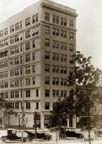
My Name is Madison
Taking Madison, WI as its subject, My Name is Madison is an Augmented Reality Game that allows users to explore and interact with the urban landscape from a multitude of perspectives. This project approachs the city as a layered environment. Players understand the development of place through the eyes of history, culture and fantasy.
Using GPS enabled hand held computers, participants take on the roles of both recipient and creator, performance in context. While walking about the streets, they are provided with information that enhances their understanding of the environment and then gives them the tools to create their own interpretations of place. Documentation of these events will be posted to mynameismadison.
The project opens as a part of the Games, Learning and Society Conference taking place in Madison, WI, June 15-16.
Posted by jo at 12:28 PM | Comments (0)
Christina Kubisch
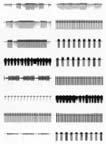
Electrical Walks: Samples of Raw Sounds
In 2003, Berlin-based sound artist Christina Kubisch began an ongoing project called Electrical Walks. This project employs specially built headphones that receive electromagnetic signals from the environment and convert them into sound. Kubisch maps a given territory, noting “hot spots” (ATM machines, security systems, electronic cash registers, subway systems, etc.) where the signals are particularly strong or interesting. She then loans the headphones to the public, allowing participants to undertake an auditory dérive through the invisible network of electromagnetic information.
To date, Kubisch has undertaken her own personal walks in Germany, England, France, Ireland, Japan, Latvia, Sweden, Switzerland, Slovakia, Spain, Taiwan, and the United States, and has held public walks in Berlin, Cologne, Karlsruhe, Bremen, Oxford, and London. To accompany the interview with Kubisch in Cabinet no. 21, she has provided us with thirty sound samples gathered by her while walking through various cities. Go to Cabinet Magazine to listen. [via BLDGBLOG]
Posted by jo at 09:38 AM | Comments (0)
June 13, 2006
Geotagthings
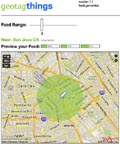
Assigning URLS Locations in the Physical World
Geotagthings--by Julian Bleecker and Will Carter--is a simple way to assign any web resource — anything with a URL - a location in the normal, human physical world. The Internet and other networks are very rapidly spilling out into the physical world. Whether you call it pervasive networks, ubiquitous computing or the geospatial web, one can easily anticipate that the networks need geographic semantics. In the physical world, location means more than a uniform resource locators (URLs). In the physical world, the data that is sluicing around also needs to know where it is according to an additional set of geographic information, such as latitude / longitude, or relative location to canonical landmarks, or simply the town or city in which that previously non- geotagged data has relevance.
Geotagthings is an important component of the larger toolkit of collaborative mapping projects. It provides a bottom-up resource for networked public contributions to mapping the web and making web resources "findable" and relevant to activities in the physical world. Geotagthings is pluggable. It's not a destination, nor a community site. It's meant to be used by destinations and community sites, or simply while going about your business, surfing the web. [via pasta and vinegar]
Posted by jo at 12:19 PM | Comments (0)
Régine Debatty at Sonar

Google Earth & Google Maps Hacks
From UFO to George Clooney sightings, from the nearest Kosher restaurant to the nearest sex offender, from the location of avian flu outbreaks to a review of the greenest golf course, from fresh beers to a new partner to share them with… As part of its restless bid to rule the worlds – both the online and the offline ones - Google has made it easy for us to find anything we need. Google wasn’t the first to offer interactive online street maps and routing but its powerful and highly readable system makes us wonder why we used to be so thrilled with good old Yellow Pages.
When the search engine released Google Maps in February 2005, independent programmers seized the opportunity to customize the system. Four months later, Google released the API that took the mapping application to the next level, allowing hackers and amateurs to refashion maps that geographically illustrate any kind of vital or outlandish information. Diluted into this grassroots plethora of Google Map hacks (have a look at the Google Maps Mania blog and you’ll see what I mean), one can find here and there projects that explore the possibilities of Google Maps under an artistic perspective.
It doesn’t mean that artists are slow to jump on the bandwagon. They just didn’t wait for Google to engineer the tools that would allow them to renew our experience of topography. I’m not only referring to the locative media trend which emerged over the last half decade but also to works that anticipated, well ahead of their time, what Google Earth would one day be. In 1994 already, ART+COM came up with "Terravision", an installation that enabled users to navigate –topographically but also chronologically– in a 3D model of the globe by moving a tracking device in front of a projection of the Earth.
And in the ‘80s, Michael Naimark’s "Golden Gate Fly-over" moviemap allowed users to navigate around the San Francisco Bay Area at fast speeds using images filmed by a gyro-stabilized helicopter camera and satellite navigation. Hopefully, the pieces selected for the Digital Art a la Carte section demonstrate that if one of the roles of artists is to pioneer technologies and applications, another one is to offer a fresh perspective on those that have already fallen into the mainstream.
Anders Weberg & Robert Willim, "Surreal Scania"
http://recycled.se/surreal/img/stills/index.htm
Christine Hanson, "Delocator"
www.delocator.net
Jim Nachlin, "GarbageScout"
http://garbagescout.com
Michael Frumin, Eyebeam R&D "OGLE"
http://ogle.eyebeamresearch.org
Rick Silva, "Satellite Jockey"
http://satellitejockey.net
Steve Coast, "Openstreetmap"
http://wiki.openstreetmap.org
Zack Denfield, Nika Smith, Brent Fogt, Kyle Mulka, "Blue Puddle"
www.bluepuddle.org
Sonar Festival--Digital à la carte: 15 June, 2006
Régine Debatty writes and makes research about the way artists are (mis)using emerging technologies. She is also a consultant for corporations, festivals and art commissions.
Posted by jo at 11:44 AM | Comments (0)
Shadows
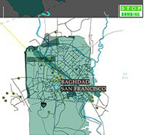
Paula Levine
"...Shadows from another is a series of hypothetical mappings, both web based and site specific, that use Global Positioning Satellites to imagine the impact of political or cultural changes that takes place in one location, upon another. Collapsing what is ‘foreign’ and what is ‘domestic,’ these hybrid spaces are new territories, redefined through new border or land configurations.
The longitude and latitude of each bombsite in San Francisco is marked using a GPS device, the same technology used by the military to target sites in Baghdad, Iraq. These sites are mapped, chronicled and documented with photographs, showing what currently exists at these locations. The series offers variations on the impact of political or cultural traumas, such as wars, shifts in borders and boundaries as the transposed spaces collapse the safety of distance and allow distant and foreign events to be translated and experienced on local ground." From New and Recent Art by Paula Levine, newmediaFIX.
Posted by jo at 11:05 AM | Comments (0)
Sonic Graffiti
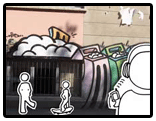
Geo-tagged musical graffiti
Chia Ying Lee's Sonic Graffiti invites urban artists to collaborate and create music together, while allowing the passersby to enjoy it as well. A system of devices enables graffiti artists to create and geo-tag music in the urban space with real spray cans:
- The sound cap has to be snapped on the top of spray cans to spray out sounds and do simple sound manipulations with gestures. Users create music by overlaying/remixing various paint/sounds from the caps. Each cap can store up to 4 sounds in its memory card. They can be loaded from computers or portable devices like iPod, mobile phone, etc. Gestures to manipulate sound include fade in/out and scratch. Several artists spraying at the same time can create a sound composition.
- The controller is used for listening to the music with earphones when creating, and positioning sounds. It also comes with a recording part can be used for collecting sound samples from the city.
- The Boom box provides a shared listening experience for a group of creators in the public. Collaborations can be achieved both synchronously and asynchronously.
- Audiences can download a dedicated software player to install in mobile devices. Each graffiti is a small radio station. The player tunes into the music of the nearest sonic graffiti automatically while you go through the city. You can also mark the locations of music you like, hence make a personal sonic graffiti map.
This project gives graffiti audio meanings. It may change people’s viewpoint about graffiti. The music can also serve as the soundtrack reflecting the vibes of the city.
More details on Chia-Ying Lee's thesis blog. My images of her installation.
Related: spatial graffiti, Wearable inkjet printer for street art, Audio messages left in space, Graffiti Analysis projections, Hektor the graffiti machine, emergency spray can, Bench'Mark. [blogged by Régine on we-make-money-not-art]
Posted by jo at 08:19 AM | Comments (0)
June 12, 2006
Neighbourhood Satellites
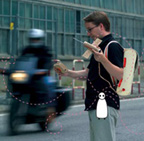
Environment-Sensing Adventures in the City
As we move through the city, mobile devices allow us to enjoy remote networking and immersion in personal entertainment. These preoccupations, however, lessen our sensitivity to what is happening directly around us, and often we learn about our own environmental conditions through mediated sources. What if mobile technology could reconnect us to our surroundings by observing environmental data directly, data that had been obscured from us before?
Neighbourhood Satellites--by Myriel Milicevic--consists of handheld sensing devices, powered by light, which enable people to monitor their local environment in a playful way, combining physical exploration and real-world data with digital gameplay. Each satellite monitors air quality, cellular signals, and light levels. The data it collects is presented in three different modes. ‘Status’ mode simply displays the current conditions. In ‘game’ mode the satellite leads a parallel existence inside a small video screen, navigating amongst the offending pollutants to be analysed. Its orientation mirrors the position of the satellite in your hand as you capture specimens and avoid self-contamination.
Greater pollution produces more challenging gameplay. You may have to go elsewhere to find cleaner air, less radiation, or more light to recharge. In ‘map’ mode the system receives data from all the other ‘satellites’ being carried by people in the area, and displays on a map their location and contamination level. Carriers might choose the cleanest path to walk or, in a spirit of risky play, purposely seek the most contamination; either way, the city’s pollution topography is dramatically plotted.
Through this playful grass-roots monitoring, the presence of contaminants in a community can be known and charted by anyone. This awareness encourages a more conscious individual behaviour, which spreads cumulatively to neighbouring communities. QuickTime Movie (by Andrea Pierri)
Posted by jo at 04:30 PM | Comments (0)
June 09, 2006
Digital Cartographies:
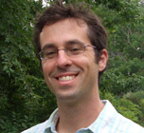
From Metageography to Locality in Online Navigation
"Abstract: When Internet technology entered into popular culture in the 1990s, the virtual dominated the discourse with talk of cyber-worlds, fragmented communities and disembodied individuals. Today, location and social connection define the parameters of the media. This new orientation has redirected network activity away from early predictions of virtual isolation and towards a social connectivity that is decidedly located and contextual. In this essay, I examine changes in the popular understanding of digital space and digital subjectivity. I begin with a discussion of the metaphor of mapping in postmodernism and cyberspace and I suggest that such metaphors, premised on the conceptual distinction between real and virtual, have given way to the localized and embodied mapping of Web 2.0. Technical, industrial and cultural changes in digital culture over the past several years have created a distinct digital social space wherein the virtual world is anchored by the growing and persistent visibility and parallel commodification of everyday life." From Digital Cartographies: From Metageography to Locality in Online Navigation by Eric Gordon.
Posted by jo at 10:56 AM | Comments (0)
June 06, 2006
Remote
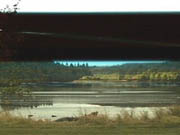
From Installation to Itinerary
Remote--Plimsoll Gallery, Hobart, Tasmania; 3-23 June 2006: 'Remote' brings together artworks by five artists that connect the local and global through digital media – Susan Collins (UK), Pete Gomes (UK), Derek Hart (UK/Tas), Nancy Mauro-Flude (Tas/Netherlands) and Martin Walch (Tas).
These artists explore their relation to the real world and their works demonstrate how that transaction might be constituted today when any firm sense of presence (real space) and immediacy (real time) is exacerbated by technologies that problemmatize notions of nearness and remoteness, such as the televisual, tele-communications and global positioning systems. What is a common point of departure for all is a confounded sense of place and proximity. The resulting inventory includes screen and projection-based moving image work, webcast transmissions, site-specific interventions and locative media.
Curated by Vince Dziekan (Monash University, Melbourne), the exhibition’s distinctive scenography is characterised by its distribution across the Plimsoll Gallery and its surrounding environment. This incorporation of other locales in the immediate proximity of the Centre for the Arts into the overall sweep of the ‘expanded’ exhibition results in the transformation of the exhibition from being experienced as an installation into something more likened to an itinerary.
This is further supported by the addition of a locative media artwork by the artist/curator created specifically to direct and focus the exploration of this broader ‘ecology’ of spaces. The work promotes the mobility and agency of the viewer by linking distributed media contents to a series of locational markers that situate this narrative across the ‘in-between’ spaces of the exhibition.
The exhibition experience is supplemented and extended by an exhibition website, designed by Superbia. Extensive information about the artists and inventory is available, plus descriptions regarding the exhibition’s scenography and locative media aspects. Two essays have been commissioned for the online catalogue: a curator’s essay by Vince Dziekan and a contributor’s essay by Scot Cotterell (Tas).
For a press package or more information, contact: Vince Dziekan [vince.dziekan[at]artdes.monash.edu.au]
Posted by jo at 10:32 AM | Comments (0)
June 05, 2006
New Cartographies of Networks and Territories

ELSE/WHERE: MAPPING
The blog ELSE/WHERE: MAPPING promotes the book of the same title. The book charts the ascendancy of mapping (in the digital age) as a fundamental design process--a powerful interdisciplinary strategy that links people and places, data and organizations, and physical and virtual environments.
The site outlines the contents of the book's four sections [networks, conversations, territories, mapping] juxtaposing archival maps and experimental prototypes to open a new dialogue among disciplines.
The book also includes a visual representation of the text.
Posted by michelle at 03:08 PM | Comments (0)
Re:Project
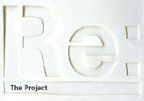
Locating déjà vu
The Re:Project is a technological probe and visual database of recounted moments of déjà vu experienced by you. Signs planted around San Francisco pinpoint exact locations of previous moments of déjà vu, and are color coded in relationship to which type of phenomenon occurred there. On each Re:Project sign is a URL and GPS coordinate. By using a mobile phone, you can text message your location and any relevant information/ description of your experience to the URL provided. This catalogues your déjà vu experience, and connects you to the Re:Project community, where you receive text message notifications of the déjà vu phenomenon as they occur around the city. Each text message includes the location of the occurance and a statment or question, which is meant to challenge your established understanding of the site and provoke a new, or at least different, view of your environment.
The Re:Project hopes to reinterpret the phenomenon of déjà vu through existing technologies, forging connections between mental and physical spaces that are otherwise left undiscovered. [via textually.org]
Posted by jo at 12:00 PM | Comments (0)
June 01, 2006
Turbulence Commission:
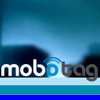
"mobotag" by Marta Lwin
mobotag reveals the hidden layers of a city through an active exchange of location based media and text messages via the cellphone. It's collaborative phone tagging of the city. Part virtual graffiti, part walking tour, "mobotag" creates a spontaneous and easy way for tagging a neighborhood via the cellphone. Send and view messages, images, videos and sounds. See art, read stories, and watch a hidden layer of the city reveal itself. Respond with your media and participate in the creative expression and mapping of your neighborhood. By sending a text message to "mobotag", with your city location, you begin an interactive tour of a neighborhood. Using a unique geocoding feature, "mobotag" tells you what other messages exist in your local area. In the near future "mobotag" will also feature art projects including "flyHere," a mobile phone audio installation featuring native bird calls; "bugBytes," collectible graphical bugs originating at major telecoms around NYC; and "lookHere," a written work in short form by a native NY writer.
"mobotag" is a 2006 commission of New Radio and Performing Arts, Inc. (aka Ether-Ore) for its Turbulence web site. It was made possible with funding from the Jerome Foundation.
BIOGRAPHY
Marta Lwin is an artist, technologist, and researcher who recently completed her masters at the Interactive Telecommunications Program at NYU. Her background is both in art and activism. In the early to late 90's she worked with Greenpeace, UNEP, and Women's Environmental Network and Reclaim the Streets (UK). After joining a loose network of artists at Backspace in London, Lwin became interested in the creative use of technology as it relates to biology. Currently, her work focuses on the intersection of art and technology and includes projects that critically challenge and subvert accepted perceptions of the relationship between nature and technology. Her work has been shown at galleries in Europe and New York. Publications covering her work including networked_performance, Engadget, Core77, Treehugger, Cool Hunting, MocoLoco, WorldChanging, Rhizome and We Make Money Not Art.
Posted by jo at 11:38 AM | Comments (0)
May 30, 2006
Virtueel Platform
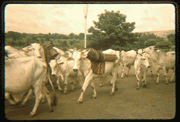
MOBILE HABITS
MOBILE HABITS: How do you trace a cow in West-Africa? Antropologists and media artists take up the challenge--Date: 29 june 2006; Time: 9.30 - 17.30; Fee: 100 Euro, student discount fee 25 Euro; How to apply: send an email with your CV and short bio to: info[at]virtueelplatform.nl
Both the arts and sciences have carried out extensive research into the issues of mobility and space. Both fields use new media such as GPS and GIS to back up their research. As a result the more recent research into mobility and space has been given a big boost. Both art and science now need each other as never before. The ‘Mobile Habits’ workshop brings artists, designers and scientists together and challenges them to exchange concepts and new working methods in relation to space, place and mobility.
Locative media artists and designers are opening themselves up to theories about mobility and space from the worlds of anthropology and social and at the same time social scientists are discovering the different cartographic and visualisation techniques found in the world of art and media design.
Mobile Lifestyles: Esther Polak is an artist working in the field of ‘locative media’. She is currently researching the possibili! ties of setting up a project in Nigeria with the Fulani, West African nomadic cattle farmers. Her initial research came up with a variety of people and researchers, including vets, anthropologists and social geographers, with a shared interest in mobile lifestyles. These various fields have come up with a number of innovative practical and theoretical tools that could be used to set up a project proposal with a well thought out, interdisciplinary basis.
Talkshop: The setting will be a ‘talk-shop’ – a cross between a workshop and a talk show. The morning session will focus on concepts and methods using a series of project presentations/case studies. The afternoon will be more interactive, with participants critically analysing the case studies in terms of what kind of insight they aim to generate – artistic, historic or practical.
Participants: Taking part in the workshop will be an interdisciplinary mix of media artists, designers and social scientists (anthropologists, social geographers) working in the field of place, mobility, storytelling and visualisation. In order to get a balanced interdisciplinary mix we ask to send a CV and short bio when applying to participate. Deadline june 8th 2006.
Speakers/support team:
Esther Polak
Esther Polak is a visual artist working in the field of new media. She is best known for two ‘locative media’ projects, AmsterdamREALTIME and the MILKproject. Both projects use GPS to &lsq! uo;imagine’ the contemporary landscape. In both projects the par ticipants were given a GPS tool to carry as they went about their daily lives. Their movements were mapped and the participants were asked to reflect upon the routes they had made. The projects resulted in large public installations. Esther Polak in constantly in search of new ways of researching space and can as such be seen as part of a long European tradition of ‘imagining the landscape’.
www.milkproject.net
www.waag.org/realtime
Christian Nold
Christian Nold is an artist and cultural activist who has spent ! the past few years mapping human emotions in the urban landscape. His research project is called Biomapping. It looks at the various ways that we as individuals can obtain information about our own body. Security technology has brought about a situation in which we are losing ownership over our own body and health. This project aims to give people access to their own biodata, to interpret and share it.
www.softhook.com
http://biomapping.net
Hanne Kirstine Adriansen
Hanne Kirstine Adriansen is a senior research fellow at the Danis h Institute for International Studies. Her training is in human geography and she has fieldwork experience from West Africa and the Middle East. Her research interests include pastoralists and their use of mobility, dryland management, and community development. She takes special interest in understanding different people\'s perception of concepts such as space and place.
Ab Drent
Ab Drent is a Master of Science in Rural Development and Management of Natural Resources in the tropics. His disciplinary specialisation is anthropology and ecology. He has followed afoot over more than 500 km nomadic Fulani herders in the Extreme North of Cameroon during ten months. Drent has written an extensive case study about the transhumance cycle of a nomadic group and tested the suitability of traditional social theories to describe the relation between man and nature. He proposes two Actor Oriented approaches and Actor Network Theory as better suited to describe the complexity and unpredictability of nomadic mobility. In a related quantitative study Drent used GPS data to build a Correlated Random Walk model to investigate the relation between mobility and environmental factors. Currently he is preparing a project with Esther Polak to visualize nomadic mobility in alternative ways combining science and art.
www.virtueelplatform.nl/mobilehabits
Virtueel Platform
Keizersgracht 264
1016 EV
Amsterdam
Nederland
Email: info[at]virtueelplatform.nl
Posted by jo at 09:19 AM | Comments (0)
SonarMatica presents Always On
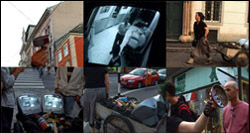
Into the Streets
ALWAYS ON--curated by Drew Hemment, José Luis de Vicente, Óscar Abril Ascaso and Advanced Music--is a display dedicated to mobile culture and location projects. It is an initiative based on exhibition and participation, taking SonarMática out onto the streets for the first time. Advance tickets for Sónar by Night as well as general passes for the three days and two nights of Sónar 2006 are already on sale.
This year, Sonarmatica presents itself more participative than ever: a game involving relationships using mobile telephones for nine hundred players at the same time organised by Blast Theory; a walk through Barcelona's electromagnetic old quarter of Ciutat Vella with Michelle Teran; and a geocaching session are some of the ideas at the exhibition.
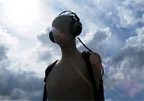
:: Participation Projects :: Those wishing to register to take part in the participation projects should go to the information stand in the exhibition: Blast Theory (UK), Day of the Figurines; Michelle Teran (CA), Life: A User's Manual; Akitsugu Maebayashi (JP), Sonic Interface; Counts Media (US), Yellow Arrow; Geocaching
:: Exhibition Projects :: Antoni Abad (ES), Taxistas, gitanos y prostitutas transmiten desde móviles en www.zexe.net; Alejandro Duque (CO), TTSM, http://soup.znerol.ch, http://co.lab.cohete.net, www1.autistici.org/communa/platanal;
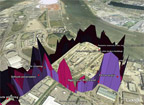
Jeremy Wood (UK), Meridians; Jens Brand (DE), gPod / G-Player; Preemptive Media (UK), Zapped!; Proboscis (UK), Urban Tapestries / Social Tapestries; Christian Nold (UK), Bio Mapping; Mark Shepard (US), Tactical Sound Garden Toolkit; Socialfiction (NL), .walk; Jeff Knowlton / Naomi Spellman (US), The Interpretive Engine for Various Places on Earth; ExtraMàtica, raster-noton, Essential Room.
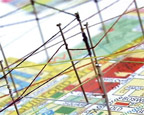
Advance tickets for Sónar by Night as well as general passes for the three days and two nights of Sónar 2006 are already on sale. Advance Tickets On-line: www.ticktackticket.com. By phone: +34 93 445 06 60: from abroad, opening hours Mon-Fri from 10.00am to 10.00pm; 902 150 025: from Spain, opening hours Mon-Sun from 10.00am until 10.00pm, from abroad, opening hours Sat-Sun from 10.00am until 10.00pm.
At any www.ticktackticket.com Sales Centre in Spain. At FNAC in France, Switzerland and Belgium: (www.fnac.com). Distribution cost not included.
Note: Neither general passes nor accreditations give admission to the Thursday the 15th concert at the L'Auditori de Barcelona
All the information at:
www.sonar.es/sonarmatica
Posted by jo at 08:55 AM | Comments (0)
May 26, 2006
HTTP Gallery
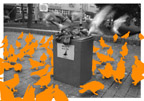
Urban Eyes
HTTP Gallery is pleased to present Urban Eyes, an intermedia project by Marcus Kirsch and Jussi Angesleva. Private View: 1st June 2006 7-9pm; Exhibition: 1st June - 9th July 2006, Friday- Sunday: 12 noon-5 pm; Unit A2, Arena Business Centre, 71 Ashfield Rd, London N4 1NY; tel: + 44 (0)20 8802 2827; info[at]http.uk.net
Urban Eyes uses wireless technology, birdseeds and city pigeons to reconnect urban dwellers with their surroundings. The Urban Eyes feeding-platform stands in one of London's public spaces. By landing on the platform, pigeons tagged with RFID chips send aerial photographs of their locality to surrounding Bluetooth-enabled devices. In this work pigeons become maverick messengers in the information super-highway, fusing feral and digital networks. HTTP Gallery provides an interface to the project, mixing live and documentary footage and offering visitors an opportunity to experiment with Bluetooth.
Being one of the last remaining signs of nature in a metropolis such as London, the urban pigeon population represents a network of ever-changing patterns more complex than anything ever produced by a machine. However pigeons' movements are based on a one-mile radius around their nest. Any pigeon you see everyday shares the same turf as you. Urban Eyes crosses and expands human mobility patterns offering to reconnect you with your neighbourhood.
In the 1960s, situationists Debord and Jorn composed psycho-geographic diagrams of Paris, which described navigational systems based on their drift through the city. For this, they used Blondel la Rougery's Plan de Paris a vol d'oiseau, a bird-eyes map of Paris. Inspired by this methodology, Urban Eyes enlists our feathered neighbours to establish a connection between the bird-eyes view of the city as now distributed by Google Earth and our terrestrial experience. [Related]
About Marcus Kirsch and Jussi Angesleva
Marcus Kirsch holds an MA in Interaction Design from Royal College of Art. He was invited to the 2004 Seoul Biennale and as exhibiting artist and to last year's Rotterdam International Film Festival and DEAF Festival. He was awarded a silver Art Directors Club NY and a fusedspace.com award in collaboration with Jussi for 'Urban Eyes'.
Jussi Angesleva holds MA in Audio Visual Media Culture from the University of Lapland in Finland, and MA in Interaction Design from the Royal College of Art and has shown at the Tokyo Metropolitan Museum of Photography, Siggraph, ZKM and Science Museum London. He has received awards from Royal Society of Arts, NESTA, from D&AD (together with Ross Cooper), Prix Ars Electronica and the Art Directors Club of Europe. He is currently working at ART+COM in Berlin, Germany and is a co-founder of new media agency Prosopon.
For more information and images, please contact Stephanie Delcroix
This project is supported by Arts Council England (London), V2 lab (Rotterdam, Netherlands) and Furtherfield.org.
Posted by jo at 05:36 PM | Comments (0)
Poker Club, Scotland
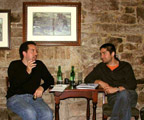
Haque + Bleecker
The Poker Club at the Beehive Inn in Edinburgh featured Usman Haque (artist / architect) and Julian Bleecker (technologist / artist / think tank leader) to discuss the "internet of things" and "open source architecture". Hosted by New Media Scotland.
Both presenters took us through a short run down of their work and then there was a lively exchange between everyone present. Hopefully there will be a podcast from New Media Scotland in the near future.
Haque's presentation was broken into three categories: Invisible Stuff, Collaborative Stuff (produced by non experts - or vernacular creativity) and Social Space. He talked about Architecture as an operating system for the collaborative production of space. He stressed the importance of the necessity of the system (whether an augmented object or space) to have the capacity to build 'its' own perceptual categories. Several examples of previous and current work were shown.
Bleecker started with the question 'Is life hackable?' He characterised the upsurge of activity as a renewed or second order humanism. The term 'change agents' was used and it was pointed out that these are no longer well positioned parties such as New York Times reporters. Several projects were shown which showed how digital networks can shape physical activities in a sort of network practice - social practice continuum. It was stressed that we're not just talking about data transactions.
Some interesting points that came up in the discussion:
:: We are surrounded by invisible information, how do we make this visible or legible?
:: Technology extends the zone of our perception/agency.
::Is the web of objects the end of subjectivity or a new beginning for subjectivity?
:: The role of human beings as filters.
The issues emerging for me are what do we mean by 'understanding' in relation to all the information we have access to and how do we have agency within it? One thing that came up over and over was the spatial or prepositional nature of our relationship to the digital networked public. As Bleeker points out in Why Things Matter are we 'on' or 'in' the network?
[posted by John Marshall on Designed Objects]
Posted by jo at 12:22 PM | Comments (0)
Google Bono
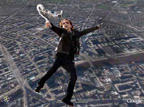
Probability of Seeing Bono in Dublin
Stunned is pleased to announce the Bono Probability Positioning System version 2: Google Bono. We know that for a visitor to Dublin an important attraction is the possibility that they may see U2 frontman and international celebrity Bono.
Google Bono (beta) is a mashup utilising Dublin's extensive surveillance camera network in conjunction with facial recognition software, Google Maps and advanced probabilty techniques to allow visitors to determine the probability of seeing Bono in any of the most probable locations in Dublin's city centre in real time. [blogged by Joel Holmberg on Eyebeam reBlog]
Posted by jo at 07:59 AM | Comments (0)
May 25, 2006
IN[ ]EX
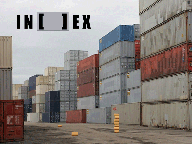
Container Culture
Panel Discussion: RHYTHMS OF URBANITY: MAPPING THE PUBLIC SPHERE THROUGH SOCIO-POLITICAL FORCES--Thursday, May 25 at 7 pm; Room 403, Vancouver Art Gallery.
This public discussion among artists Kate Armstrong, Bobbi Kozinuk, M. Simon Levin, Laurie Long, Leonard Paul, Manuel Piña, Jean Routhier, and curator Alice Ming Wai Jim will speak to “container culture” and the idea that the public sphere is rapidly being privatized and now reflects more on the movement of goods and capital than on the expression of individual rights. in[ ]ex, their interactive, city-wide media art project, will first be exhibited in connection with Centre A and the World Urban Forum in Vancouver, Canada in June 2006, and then in San Jose, California in connection with the Container Culture exhibition at ISEA in August.
In[ ]ex is an audio sculpture which creates a mesh network by releasing thousands of embedded wooden blocks into the world. The mesh network collects and processes data to form a sound environment in the space of a shipping container. This project takes place in the context of shipping and distribution of goods and the movement of people in the two port cities of Vancouver, British Columbia, and San Jose, California. In[ ]ex engages both the subject of things and the mechanisms by which things are distributed in the global economy.
Posted by jo at 10:12 AM | Comments (0)
May 18, 2006
Cabspotting
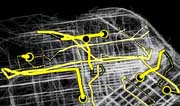
Taxis Mapped in Real Time
Cabspotting: As part of Invisible Dynamics, Stamen, a collaboration with The Exploratorium and Scott Snibbe, has been exploring visualizations of GPS data generated by Yellow Cab taxi cabs in San Francisco. In these frame-by-frame maps of the locations of cabs in the Bay Area, the city ebbs and pulses like the beating of a heart. These movies are available on the cabspotting site.
Invisible Dynamics is a research project sponsored by The Exploratorium which explores the meanings and representations of place. Working across the domains of art, design, cultural geography, cartography, information design, sociology, hydrology, marine sciences, and history, Invisible Dynamics hosts residencies and workshops, as well as developing exhibitions and public programs. Using new technologies for the representation and analysis of spatial information, the project investigates the complexities of the San Francisco Bay Region in the context of the Pacific Rim. The contiguities of bay waters, shores, industrial zones, the interlacing and often unseen systems that give this area its character are all a part of the project focus—extending to explorations of the entire Pacific Rim.
Posted by jo at 09:52 AM | Comments (0)
May 12, 2006
MoBeeline + The Compass Coat
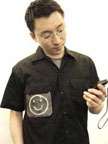
Wearables
MoBeeline allows people to send data about a user’s emotions to another’s clothes via SMS. The MoBeeline wearable Bluetooth accessory can receive data from a mobile phone. For example, one mobile phone user can send operative directions to the other's clothes and share his/her feelings and emotions by sending signals to the other person's clothes. According to the emotion the user wants to communicate, He or she will be able to modify the colors or patterns of the garment, or send emoticons to LEDs on the garment.
Video. Developed by Chang Soo LEE and HyeJoo Lee at the ITP. [blogged by Regine on we-make-money-not-art]
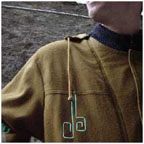
The Compass Coat, by Stijn Ossevoort, uses compass technology to read direction. The display of the information is integrated into the design of the coat offering information for both the wearer and the people around him. North is indicated through glowing plant-like shapes like a tree which is covered with moss in the main wind direction.
The coat contains magnetic sensors and 24 sections that can light up individually, using Electro Luminescent wires. The section that points north lights up while its surrounding sections glow dimly. As soon as the wearer turns, the light gradually moves onto the new section that points north.
Related: CabBoots, the navigation shoes, A belt with with tactile sense to show you the way, Melodious Walkabout. [blogged by Regine on we-make-money-not-art]
Posted by jo at 11:22 AM | Comments (0)
May 04, 2006
Palpable City
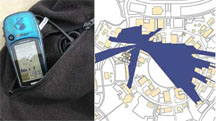
Wearing Tactile Space
Palpable City is a location aware garment that allows walkers to feel the spatial form of the urban grid as vibro-tactile rhythms on their body. The rhythms of the city space are parameterized by local conditions as the walker encounters them, reflecting the influence of time, light, temperature and humidity on the experience of space. The tactile space created can only be explored by moving through it.
The system consists of a GPS and a torso tactile display that communicates tactile textures related to the spatial form of the environment. Vibrotactile actuators are used to produce sensory saltation. Sensory saltation occurs across the senses resulting in the perception of apparent motion.
Three mechanical stimulators are placed on the forearm. The stimulator closest to the wrist delivers 3 short pulses, followed by 3 more at the middle stimulator, then 3 more at the last one. Instead of perceiving 3 pulses at each of the stimulator sites, the observer perceives that all of the pulses are distributed with approximately uniform spacing from the site of the first stimulator to the site of the third. The sensation is described as if a tiny rabbit was hopping up the arm from wrist to elbow.
Using variations in these parameters, a group of concepts which can be perceived through the tactile sense emerged. For example, a single point can be perceived as a direction. Taking advantage of sensory saltation, lines can be perceived, as can their length, straightness, spatial distribution and smoothness. More recent research suggests planes and 3D forms can be perceived. Tactors on the body can create a 360 degree "field of touch" where lines and forms can be perceived not just on the surface of the body, but through the body.
A work by Eric Conrad. Presentation at Subtle Technologies, June 1-4 2006, Toronto, Canada.
Related: The city as a musical interface [blogged by Regine on we-make-money-not-art]
Posted by jo at 08:17 AM | Comments (0)
May 01, 2006
Mapchester:
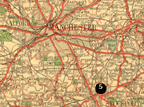
Making an open-source map for Manchester
Mapchester: Making an open-source map for Manchester--Saturday 13th and Sunday 14th May, 2006. When bands like the Happy Mondays stalked the Hacienda, Manchester was dubbed 'Madchester'; now, a new generation of phreaks are in town, renaming the city 'Mapchester', showing that it isn't just music that puts the city on the map.
Mapchester is a collaborative 'wikimap' project, generated and maintained by users in the same way as Wikipedia. It kicks off with a Mapping Weekend, when Manchester is mapped in a weekend! A number of spin off projects will then take place during the Futuresonic festival, 20-23 July 2006 under the Mapchester banner, and the data generated will be used in a test-case festival guide.
Mapchester will generate a new kind map of Manchester - produced by collective, community effort that will be completely copyright-free. Mapchester was first proposed at the PLAN workshop, as a test-case for how a city could be mapped and a guide for a festival created on collaborative and open principles.
Mapping Weekend invitation: We are seeking map hackers and citizen cartographers to participate in mapping the city for free. Our goal is to bring together as wide an array of different people who are interested in mapping and get them to walk / cycle / drive / bus / train / skate / etc / along city streets recording GPS tracks and noting down road names. These tracks will then be put online in the OpenStreetMap database and edited into map features. We hope that collectively people will work to completely map whole quarters of the city over the weekend.
Please spread the word about Mapchester and forward this invitation to come and map Manchester to other people who might be interested.
Getting involved:
|||| How: Just come along and choose an area of central Manchester to map. Head out with a GPS device (Global Positioning System, which monitors signals from satellites to record location) and notepad to record street names and other notable features. You can map for the whole day or just for a few hours. No prior mapping experience needed - intro briefings and equipment training will be provided.
|||| When: Saturday 13th and Sunday 14th May, 2006. Welcome briefings held at 10am and 2pm both days.
|||| Where: Mapchester HQ, Lower Ground Floor, 117-119 Portland Street, Manchester M1 6ED, see http://manchesterdda.com/article/12/ . (The space has been generously provided by the Manchester Digital Development Agency and they are also helping in signing people up to take part.)
|||| Registering: if you are interested in participating please send an email: mapchester@manchesterdda.com or call Jo Blackwell on tele: 0161 255 8111. (Please indicate on what days you want to participate and whether you have your own GPS / laptop.)
|||| Refreshments: Drinks and a sandwich lunch will be provided for participants.
|||| What to bring: If you have it please bring your own mapping equipment (GPS, laptop, camera, notepad + pencil, etc). If you don't have a GPS receiver, don't worry, there will be a number of extra units available on each day. If you have never used a GPS receiver, don't worry either, hands on training will be provided.
|||| Further questions: please contact Martin Dodge (m.dodge[at]manchester.ac.uk).
Some background:
Mapchester is an experiment in 'citizen cartography' that we hope will make a significant contribution to wider efforts in so-called 'open-source' mapping. This an emerging and rapidly growing cartographic activity, driven in part by technology (cheap GPS equipment and online collaboration tools, like OpenStreetMap.org), but also by a very different ethos to knowledge production. Under open-source models the right of authorship are de-centred and the ownership of knowledge is seen as a common resource that can be distributed and re-used without restriction or license. As such 'opening' up mapmaking has real potential to empower people to create their own knowledge and encourages re-use of cartographic resource in novel, creative ways.
The map data produced for central Manchester will contribute to OpenStreetMap.org, one of the leading projects in the open-source mapping field. Currently, OpenStreetMap has mapped 25,000 kilometres of roads in the UK, including all motorways. However, thus far the majority of this data is for London and Birmingham and many other major cities are hardly mapped at all. It is hoped that an intensive effort to build a map of the whole of a city in a weekend will inspire others and be important to build momentum across the country.
All the map data generated for Mapchester will be free to view, edit and use via the OpenStreetMap platform. An editable map will also be created and used as a test-case festival guide for the Futuresonic International Festival, held in Manchester 20-23 July 2006.
Mapchester mapping weekend is supported by:
|||| Future Everything / Futuresonic International Festival
|||| University of Manchester, School of Environment and Development
|||| Manchester Geographical Society
|||| Manchester Digital Development Agency
Mapchester organising committee:
Steve Coast (OpenStreetMap.org); Drew Hemment (Future Everything); Mick Lockwood (Salford University); Martin Dodge & Chris Perkins (Geography, University of Manchester).
Thanks to:
Mikel Maron (WorldKIT), Libby Miller (FOAF), Ben Russell (PLAN), Steve Benford (Mixedreality Lab) and all others supporting this project.
Please spread the word about Mapchester and forward this invitation to come and map Manchester to other people who might be interested.
Posted by jo at 11:06 AM | Comments (0)
April 26, 2006
Sense of the City
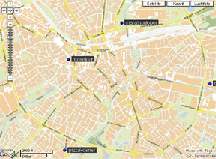
Observe Live Tracings
Launched last friday, Sense of the City involves ten civilians wandering in/around the Dutch city of Eindhoven with mobile phones and GPS; they're making traces with on-the-spot media and are being followed in real-time (in Dutch, best viewed with Firefox). The intention is to make their personal experience of the city visible. The project is by GeoTracing: contact Just van den Broecke at jus[at]justobjects.nl.
Posted by jo at 10:27 AM | Comments (0)
April 20, 2006
Anne Galloway
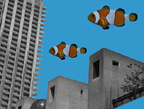
LOCATION-AWARE TECHNOLOGIES, SPATIAL-ANNOTATION, AND THE FATE OF URBAN COMMUNITY
Location-aware technologies such as GPS and RFID are increasingly being used for a variety of European and North American urban spatial-annotation projects. These desires to “tag” the world-around-us, I argue, can be understood as particular intensifications and materialisations of Western political longings for unified community in times of fragmentation and diversity. But what senses of belonging are we presupposing when we attempt to bind collective memories to singular places? And what kind of community is possible when the technologies and protocols that underpin such projects may be understood, following Mackenzie, as 'kludge' or an 'ill-assorted collection of poorly matching parts, forming a distressing whole'? Borrowing concepts from Giorgio Agamben, Jean-Luc Nancy and Marc Augé, I explore tensions between mobility and dwelling, difference and commonality, memory and forgetting. Accordingly, questions concerning political and ethical participation, and the role of affective encounters such as alignments, identifications and appropriations take on special force. Ultimately, it is my position that any kind of technologically-enabled communalism or collective memory that privileges unity and order threatens to undermine the senses of contingency and potentiality necessary for a politics of hope in everyday urban life. [blogged by Anne on Purse Lips Square Jaw]
Posted by jo at 11:30 AM | Comments (0)
Love City
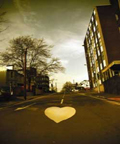
Locative Menage a Trois
Nottingham-based technology artists, Active Ingredient (authors of 'Ere Be Dragons), are to launch an interactive game that will link the people of Leicester, Nottingham and Derby. Love City will allow people to text each other in a game that awards points for making connections with people from the other cities.
The game uses mobile cell location to track users' positions in the three cities. When a player moves between mobile phone 'cells', s/he (Player 1) receives an SMS that includes an update about Love City and the status of other players in their area or in one of the cities. Players can then connect with each other by sending a text to another person in another place. If Player 2 accepts Player 1's message of love, a connection is made and these form a "bonded pair". If a second connection is made from this group to a third player, then a triplet or Ménage à trois is created.
When a triplet is formed, Player 1 is awarded an avatar known as the "offspring" which acts as an agent for them in this particular cell. Subsequent connections with this agent are relayed to the original player who may be far from the cell but can still connect and initiate a process which leads to the creation of more offspring and points for them. Thus their empire grows.
The first test of the game, commissioned by Three Cities, will take place on April 3 – 9 2006.
The full-scale public project is likely to take place at the end of the year when a big-screen projection of the game will be broadcast in the main public spaces of each city.
Via Media Arts Education. [blogged by Regine on Textually]
Posted by jo at 07:47 AM | Comments (0)
April 04, 2006
eRuv: A Street History in Semacode
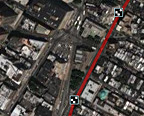
Inscribing a Story on a City with 2D Barcodes
eRuv is a digital graffiti project installed along the route of the former Third Avenue elevated train line in lower Manhattan. The train line, dismantled in 1955, was more than just a means of transport; it was part of an important religious boundary — an eruv — for a Hasidic community on the old Lower East Side. Using semacodes, the former boundary is reconstructed and mapped back onto the space of the city. Pedestrians with camera phones can then access location-specific historical content linked through the semacodes.
What is an eruv? An eruv (pronounced ey-roov) is a structure erected around orthodox Jewish communites throughout the world. It usually consists of a series of poles connected by a cord that circumscribe an urban neighborhood, often incorporating existing municipal infrastructure such as utility poles and electrical wires. They are erected with the permission of local authorities and in accordance with the lengthy and complex set of architectural laws set forth in the Talmud. The construction of eruvin (or eruvim, plural for eruv) stems from the observation of Shabbat, the weekly sacred day of rest (Friday sundown to Saturday sundown) that includes a prohibition against carrying objects outside of one's home, or private domain. The reason Jews construct eruvin is that according to most Rabbinic authorities, the shared public space within an eruv is considered the private domain of a community. In this way, observant Jews can carry their keys or prayer books on the Sabbath while acting in accordance with sacred principles.
Is Manhattan an eruv? Natural topographic boundaries such as rivers, cliffs and ravines can also form one or more legitimate sides of an eruv. For this reason, it is possible from a number of Talmudic perspectives to consider the entire island of Manhattan an eruv. This has been debated over the centuries-long course of Jewish habitation in the city — rabbis differ over the extent to which the island would require physical intervention for it to qualify as an eruv.
The old East Side eruv: In 1907, Rabbi Yehoshua Siegel, a renowned Talmudic authority who had immigrated to the Lower East Side from Poland, published Eruv V'Hotza'ah, in which he wrote:
With regard to the city of New York, where we are presently living, the issue has come before the trembling ones that it is possible to permit carrying on Shabbat throughout the East Side. The argument is that the water which surrounds it on three sides should be considered a complete wall because of its depth. The fourth wall is a door frame like none other: the elevated iron pathway which stretches the length of the city, from one end to the other, from the water of the southern tip, South Ferry, to the water at the northern tip, without any interruption to Harlem.
The eruv was soon refuted by other prominent rabbis and rejected en masse by Lithuanian Jews who also lived on the Lower East Side at the time.
What is semacode? A semacode is like a bar code that you see on your groceries. Except that instead of holding product information it represents a URL, or web address. You can print semacodes on a piece of paper or on an adhesive sticker and put them places. This way you can put web addresses on walls or streets, or on anything. In order to use them, you need a semacode reader, or a compatible camera phone that is connected to the Internet.
Visit eRuv for more information
Posted by jesse at 07:18 PM | Comments (0)
March 26, 2006
Who owns the Internet? We have a map that shows you.
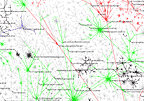
Visualization of Internet Ownership
From CIO: What is this ball of colors? It is the North American Internet, or more specifically a map of just about every router on the North American backbone, (there are 134,855 of them for those who are counting). The colors represent who each router is registered to. Red is Verizon; blue AT&T; yellow Qwest; green is major backbone players like Level 3 and Sprint Nextel; black is the entire cable industry put together; and gray is everyone else, from small telecommunications companies to large international players who only have a small presence in the U.S. If you click on the map it will take you to much bigger version complete with labels that tell you the address of many of the routers.
Read the post at Blogs.CIO and download the Internet backbone map (PDF).
Posted by jesse at 12:33 PM | Comments (0)
March 23, 2006
MeHere
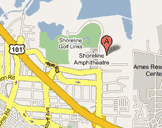
google mapping tools
Glen Murphy is a UI engineer at google who also produces software based art work that explores "what isn't, but could be". He says he likes to "computationally connect wonder and reality". His recent project MeHere is a GPS Tracker for Google Maps featuring Google Earth integration and the ability to share your location with other users and applications (eg Greasemonkey scripts). See his precursor project MovinGmap.
Posted by michelle at 02:47 PM | Comments (0) | TrackBack
March 16, 2006
Wanderer

Continuous Motion Propels Game
The game Wanderer was developed during the CARGO WORKSHOPS 2005 in Oostende, Belgium. The theme of the workshop was to create an innovating game that uses Global Positioning System (GPS). The game Wanderer is played outside. The object of the game is that the player has to be in a continuous motion and has to respond to auditive signals provided through a headphone that is connected to the game system. Because the game is not mapped onto the coordinates of the physical space, it can be played in any location. The player is continuously confronted with the objects in public space functioning as game obstacles. In this way the game transforms the meaning of the physical object in public space. More about it here (English). [blogged by nicolas on pasta and vinegar]
Posted by jo at 11:09 AM | Comments (0)
March 12, 2006
CHINA GATES: Mobile Music Performance

Work for Tuned Gongs and Wrist Conductor
The Digital Art Weeks 2006, organized by members of the Computer Science Department of the ETH Zurich, is looking for up to twelve persons who are interested in contemporary music and art who would be interested in participating on a voluntary basis for the performance of a new Mobil-Music work under the direction of Sound Artist, Art Clay using GPS and mobile computer technologies.
Aesthetically, the work China Gates for tuned gongs and Wrist Conductor is rooted in works for open public space and belongs to a series of works, which celebrate the use of innovative mobile technologies to explore public space and audience. The work is technically based on possibilities of synchronizing a group of performers using the clock pulse emitted by satellites. The GPS Wrist Conductor signals each player when to hit the gong. An intense rippling effect results as the players gradually move around the park and the music of the gongs shift back and fourth from intense chords to exotic melodies.
The preparation for the event will take place in the form of a mini-workshop on mobile music and sound in open space.
Persons interested in participating are asked to apply by sending a message to the below stated email address. Please include a short biography (50 words) telling us about yourself and why you would you like to participate. Selected players will receive a festival pass for all Digital Art Weeks 06 events. Send to arthur.clay[at]inf.ethz.ch
Posted by jo at 11:30 AM | Comments (0)
March 03, 2006
Taking The Time For A Walk
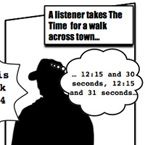
Between Performer and Radio Time
This project is an adaptation of Time Server which was first performed for the Foundry's Late Late Breakfast Show, broadcast in London on Resonance 104.4FM between midday and 1pm on July 22.
The work entailed Simon Pope walking from the NTP (network time protocol) server at University of London Computer Centre in Guilford Place, London, to the Foundry in Old Street, London, 'taking the time' and delivering it to the radio show from where it was broadcast live on FM radio. The aim of the work was to investigate the interaction between 'clock time' and 'circadian time', using radio broadcast's conventional standardized time as a gauge.
In Taking The Time For A Walk--by Simon Pope in collaboration with The Foundry--a radio broadcast of 'clock time' is 'returned' to the Foundry's radio show. Simon Pope will walk from the line of the meridian as it intersects London, 'talking the time' with him as he goes; this 'time', as moderated by the 'body clock' and movement of the performer, then becomes the standard time that the radio station uses in its radio broadcast. [a NODE.London event]
Posted by jo at 10:56 AM | Comments (0)
Littoral Walk
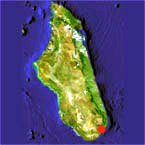
Imagining Madagascar
Littoral Walk by Pete Gomes: In 2006 I will travel to Madagascar to work in an endangered area of littoral forest with the charity Azafady. In March I will use GPS to walk, in south London, a scale coastline of the outline of an area of Madagascan forest under threat by a mining project which will bring devastating changes. 100 prints of my large-scale performance-drawing will be for sale, with proceeds going to Azafady.
I will be in a region populated by the Antanosy people, the poorest people in Madagascar, working on projects providing a social and ecological infrastructure, health, education, lemur conservation and forest mapping using GPS. It has been my lifelong dream to go to Madagascar. This London walk is an imagined sense of myself in a specific location; for me, somewhere between future projection, imagination and a dream.
I am part of Remote, a gallery exhibition in Hobart, Tasmania where Littoral Walk will be repeated by a third party on my behalf. 4th March "littoral walk" @ Clapham Common. [A NODE.London event]
Posted by jo at 10:42 AM | Comments (0)
March 01, 2006
Surreal Scania
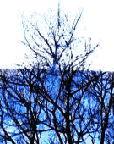
Movies On The Go
Following the trajectory established by photography, film and video have become our most relied upon methods for documenting the visible world, from TV news to home videos. Of course, the reliance on photographic truth--which is really just an index of visible light on a reactive surface--is now being displaced by more abstract and mathematical forms of depicting 'reality,' like global positioning systems. And just as photographic reality was toyed with from the early days of the medium--see Hippolyte Bayard's 1840 photo of his own 'death,' for example--contemporary artists are challenging the new truth tools. Surreal Scania, a new work by the Swedish team of Anders Weberg and Robert Willim, fuses a series of lush and seductive video montages with geocoded data to examine 'how aura and attraction are connected to different places.' All of the videos are available for download, as are corresponding sets of data that can be used to 'locate' the video's geography in 'real' space and on Google Earth. For those with portable video players, you can take a clip with you and compare it to the 'real' N 55 37.501/E 013 02.215. - Ryan Griffis, Net Art News, Rhizome.
Posted by jo at 12:20 PM | Comments (0)
February 28, 2006
Christian Nold

Greenwich Emotion Map
Greenwich Emotion Map by Christian Nold, Oct 2005 - March 2006: 6 month artist commission hosted by Independent Photography as part of 'Peninsula', a series of artist commissions on the Greenwich Peninsula.
Artist Christian Nold has been invited to collaborate with local residents from the Greenwich Peninsula to explore the area afresh and build an emotion map of the area that explores people's relationship with their local environment.
The project is set up as a series of participatory workshops that invite people to borrow a Bio Mapping device and go for a walk. The device measures the wearer's Galvanic Skin Response (GSR), which is an indicator of emotional arousal in conjunction with their geographical location. The resulting maps encourage personal reflection on the complex relationship between us, our environment and our fellow citizens. By sharing this information we can construct maps that visualise where we as a community feel stressed and excited.
As part of Node London, two separate public workshops will take place in March at Independent Photography, where people will be able to see the collective Greenwich Emotion Map as well as participate by going for their own walk in the local area.
A printed 'Greenwich Emotion Map' wall poster will be available from Independent Photography as well as a number of other local Node London venues.
"Will seeing other people's experiences, allow us to engage differently with our environment?"
Please contact us if you want to join in christian[at]emotionmap.net
Posted by jo at 10:39 AM | Comments (0)
Dowsing Poplar

Collaborative Mapping of Poplar
Saturday 4 March 2006 2-4 pm free: You are invited to join Melissa Bliss in creating a collaborative map of Poplar using dowsing and GPS. Full instruction in dowsing will be given. Please dress warm as we will be outside. Meet at Chrisp Street Idea Store (aka the library), 1 Vesey Path (south end of Chrisp Street Market), East India Dock Road, London E14 6BT--DLR All Saints, Bus 15 115 D6 D8. Info/booking: melissa[at]livingcinema.com
Posted by jo at 10:12 AM | Comments (0)
February 21, 2006
Surreal Scania

Exploring Imaginary Geographies
Surreal Scania is a web-based art project from Sweden that combines digital video with GPS-tech. What makes places attractive? Can a wet and dirty road running through a barren field be appealing? What are the common denominators between a heavy industrial harbour and a nature reserve? In the project Surreal Scania these questions are examined. Digital video is combined with GPS-technology to explore different visual representation techniques. At the same time processes of place marketing and branding are surrealized...
Exploring Imaginary Geographies: How do different places become interesting? Can a wet and dirty road running through a barren field be appealing? What are the common denominators between a heavy industrial harbour and a nature reserve? In the project Surreal Scania we examine these questions.
Digital technology, in form of video equipment and GPS-units has been used to look into how aura and attraction are connected to different places. Filmmaker Anders Weberg and cultural analysist Robert Willim started by visiting various points within a specific region. This time the region was Scania, located in southern Sweden. On the different locations video material has been collected, which was then used as the raw material for a number of short films. These films are now available for download. At the moment we provide six different films, but more will be added to the collection in the future.
The films can be seen as comments to process of place marketing and branding. In choosing the places, the aim has been to mix both geographical locations that are seen as tourist attractions and locations off the beaten track. In the digital manipulations, made by Anders Weberg, the visual raw material is transformed to highlight a dreamlike and surreal imaginary geography. All films are based solely on sound and video from the different geographical points.
All the films are accompanied with files containing the exact geographical coordinates for all the different places. By using Google Earth it is possible to view aerial photos of the points represented in the different films. Using a GPS-unit it is also possible to visit the locations where the visual raw material was shot. And as the films are provided in various file formats optimized for most mobile video players, it is possible to enjoy the filmic representations on the very spots where the material was filmed. In this way the imaginary can be compared to the real. But what is real or imaginary? With Surreal Scania we want to explore different visual representation techniques, and we also want to recognise the fact that our imagination has an important role in forming the experiences of these locations.
Anders Weberg.
A seasoned film maker, he has specialized in the expressions that digital technologies provide. He directs movies from features to experimental shorts to music videos. The purpose of Anders´work is to mix genres and ways of expression to explore the potential of visual media.
More info about Anders: http://www.recycled.se/
Robert Willim
Researcher in ethnology at Lund University. He has done research about the cultural dimensions of digital media and the transformations of industrial society. For the past several years he has channeled his research within this field to focus mainly on music and the arts.
More info about Robert: http://www.robertwillim.com/
[posted on random]
Posted by jo at 11:15 AM | Comments (0)
February 08, 2006
Urban Tapestries

Feral Robot for Public Authoring
The first of 2 planned Robotic Feral Public Authors has been completed and is ready for its first field trial in London Fields next week: The robot has two sensors (air quality and carbon dioxide) and GPS location sensing. The sensors were selected to reflect the concerns voiced in our community pollution mapping workshop back in November, which identified air pollution as the key environmental issue of local residents. The robot communicates its Lat/Long position and sensor readings back to the Urban Tapestries public authoring system via a WiFi connection. For the field trial in London Fields we will be meshing two battery-powered Locustworld meshboxes with SPACE's own public WiFi network. more >>
February 03, 2006: The first live trial of the Proboscis/Birkbeck Feral Robot took place in London Fields today: A group from Proboscis ... and Birkbeck College Computer Science dept ... braved the freezing weather to test the robot out in the field. We adapted a Locustworld meshbox to act as a battery powered mobile mesh node with SPACE Media's wifi network broadcasting into the southern part of London Fields. more >>. A short film (1 minute Quicktime MP4). Documentation from last November's Community Mapping Workshop in London Fields. [via Urban/Social Tapestries]
Posted by jo at 12:36 PM | Comments (0)
February 02, 2006
Transmediale 06: Maurice Benayoun
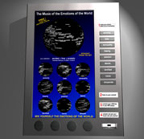
Emotion Vending Machine 2006
Also at Transmediale 06: Maurice Benayoun's Emotion Vending Machine--The mechanics of the world’s emotions evolve in the zone where economics and politics converge, in the world of product placement. Through its concept of artistic merchandizing, the Emotion Vending Machine deals with the production of emotions in an ironic way. The Machine takes Internet data as a global pool of emotions. Users can select up to three emotions from a list of nine emotional states, including hate, desire, or despair. The emotions are represented by 3D-maps of word clusters, extracted from the web and generated in realtime.
These maps show the emotions of the world as they are present on the web at that moment, mapped onto the actual position of major cities on the globe, a mix which can also be read like a music score. The musical interpretation deciphers the cities and their emotional polarity to produce a specific musical result by adapting rhythm, coloration and evolution to the selection of the emotional states made by the user. After listening to the personal result through the integrated speakers, users can plug in their USB stick or MP3 player to load their emotional sound remix.
Music: Jean-Baptiste Barrière; Software: Birgit Lichtenegger, Artem Baguinsky, Marloes de Valk (V2); Production: CITU, Paris.
Posted by jo at 03:32 PM | Comments (0)
The Snow Show 2006
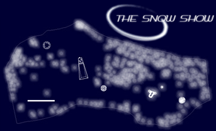
Bridging Art and Architecture
The Snow Show explores the issues related to Art and Architectural investigation by creating works from the ephemeral materials of snow and ice. An artist was partnered with an architect and invited to develop a work together—this conversation created a bridged between the art and architectural worlds. The teamed participants include Kiki Smith and Lebbeus Woods, Yoko Ono and Arata Isozaki, Carsten Höller and Williams & Tsien, Daniel Buren and Patrick Bouchain, Paola Pivi and Cliostraat, Jaume Plensa and Norman Foster.
Where are you by Jaume Plensa and Norman Foster: The white austerity of snow transforms the landscape profoundly. Like in a desert of sand, snow eliminates whatever narrative element there might be in the landscape, to give us the soul of the place in all its purity. GPS technology can give us our precise geographical position, a location in motion. This new form of portrait (of the landscape as much as the body) is, like snow, a metaphor of the ephemeral.
Conceived in 2000 by independent curator Lance Fung, The Snow Show has since constructed seventeen structures that furthered the discussion of interdisciplinary collaboration and set the tone for the current Snow Show. This year, the artists and architects have created interactive experiences inspired by the dramatic natural beauty of Sestriere and the athletic competitions of the Olympics.
03 February - 19 March 2006.
Sestriere, Turin
Posted by jo at 01:43 PM | Comments (0)
February 01, 2006
Beatriz da Costa
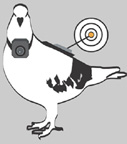
Pigeons that Blog
PigeonBlog--currently being developed by Beatriz da Costa--provides an alternative participatory way to environmental air pollution data gathering. It equips Urban Homing Pigeons with GPS enabled electronic air pollution sensing devices, capable of sending location based air pollution data as well as images to an online Mapping/Blogging Environment in real time....PigeonBlog uses a combination of Siemens’ XT 56 miniature GPS/GSM unit, an electronic automotive CO and NOx sensing unit and the Atmel AVR microprocessor. Detailed tech and datasheet information is forthcoming on this site.
However, in addition to being used for PigeonBlog, Cina Hazegh is currently working on broadening this platform towards a more general Open Source Hardware cell phone project....Pigeons releases will occur once a day throughout the duration of the festival on the ISEA premises. Release location: ClockTower in San Jose. The first release will take place during the opening ceremony of the festival on tuesday evening. Additional “White Dove” releases are planned at strategic high pollutant areas within the San Jose region. Exact locations are to be determined. [blogged by nicolas on pasta and vinegar] Related: Urban Eyes
Posted by jo at 09:29 AM | Comments (0)
January 27, 2006
Anne Galloway
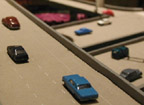
On Spatial Annotation
I'm really looking forward to being a guest lecturer in the Contemporary Architecture Discourse Colloquium at Yale School of Architecture on March 31st. This is what I'll be talking about:
LOCATION-AWARE TECHNOLOGIES, SPATIAL-ANNOTATION, AND THE FATE OF URBAN COMMUNITY
Location-aware technologies such as GPS and RFID are increasingly being used for a variety of European and North American urban spatial-annotation projects. These desires to “tag” the world-around-us, I argue, can be understood as particular intensifications and materialisations of Western political longings for unified community in times of fragmentation and diversity. But what senses of belonging are we presupposing when we attempt to bind collective memories to singular places? And what kind of community is possible when the technologies and protocols that underpin such projects may be understood, following Mackenzie, as “kludge” or an “ill-assorted collection of poorly matching parts, forming a distressing whole”? Borrowing concepts from Giorgio Agamben, Jean-Luc Nancy and Marc Augé, I explore tensions between mobility and dwelling, difference and commonality, memory and forgetting. Accordingly, questions concerning political and ethical participation, and the role of affective encounters such as alignments, identifications and appropriations take on special force. Ultimately, it is my position that any kind of technologically-enabled communalism or collective memory that privileges unity and order threatens to undermine the senses of contingency and potentiality necessary for a politics of hope in everyday urban life.
And on a related note, NY Times: Making Connections, Here and Now
"These [mobile social software] programs are in their infancy, now being used mainly by technology aficionados, but their potential is vast. In the future, users may subscribe to the mobile posts of bloggers who review neighborhood lunch spots or to business travelers who share city-specific survival tips."
Vast potential, eh? My god, we're dull.
I continue to be impressed that projects like Urban Tapestries led to projects like Social Tapestries, while Dodgeball was "acquired" by Google. [blogged by Anne on Purse Lips Square Jaw]
Posted by jo at 02:56 PM | Comments (0)
NYT on Location-Based Services

Making Connections, Here and Now
The NYT features a smart article about location-based services (By ETHAN TODRAS-WHITEHILL). Well-known projects like Dodgeball, Yellow Arrow, Social Light, Rabble, Street Hive or Rave Wireles are presented.
Mostly, those systems allow proximity-based interaction (ping registered participants when participants/friends are in the vicinity) or location-based annotations/blogging (i.e virtual post-its)… allowing the so-called “geospatial Web, the Internet overlaid on the real world”. Food for thought certainly for the current vocabulary disambiguation!
The article raises the issue of location-awareness, be it passive or active as they call it:
What the industry calls passive location awareness on the part of cellphones is critical to growth in mobile social software. It simply means that a phone knows where it is because it is equipped with technology like a Global Positioning System. Most current location-based services do not automatically keep track of where you are; you need to tell them by sending a text message. Passive awareness in your cellphone, by contrast, lets sites like Socialight or Dodgeball keep track of where you are all the time and send you relevant information posted by others.
But getting passive awareness on your phone is not easy.
(…)
cellphone users are suspicious of passive location awareness because they do not want to get unsolicited location-based text messages, or geospam, from advertisers as they pass stores.
Besides, the conclusion is very interesting:
As for other mobile social programs, a press officer for Verizon Wireless suggested that in the future the company might let its customers use such services through an off-network, “trusted content provider” model.
And geospam? It may actually materialize, and even the developers of mobile software are not thrilled by the idea.
“The billboards are already there,” said Mr. Allen of Yellow Arrow. “I don’t need a message in my pocket to tell me McDonald’s is around the corner.”
So true…[blogged by nicolas on pasta and vinegar]
Posted by jo at 02:49 PM | Comments (0)
January 12, 2006
Space, Spatiality and Technologies
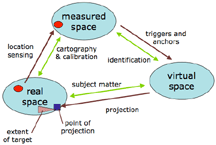
Managing Multiple Spaces
A. Dix, A. Friday, B. Koleva, T. Rodden, H. Muller, C. Randell, A. Steed, Managing Multiple Spaces. In P. Turner, E. Davenport (eds.) Space, Spatiality and Technologies, Kluwer, 2005.
The authors’ aim is analyse the way in which multiple spaces, both virtual and physical, can co-exist. By this we mean that people and objects may have locations in and relationships to both physical space and one or more virtual spaces, and that these different spaces together interact to give an overall system behaviour and user experience.
They use 4 cases (City, CityWide, the Drift Table and Ambient Wood) to see how multiple physical and virtual spaces interact. The choice of the different environment is pretty pertinent since there are mobile applications and an interactive table. They then discriminate 3 types of space: real space– the locations and activities of actual objects and people in physical space
measured space – the representation of that space in the computer and the representation of locations of objects and people from sensor data, etc.
virtual space – electronic spaces created to be portrayed to users, but not necessarily representing explicitly the real world. [...] [blogged by nicolas on pasta and vinegar]
Posted by jo at 03:22 PM | Comments (0)
January 11, 2006
Rush Creek Wilderness Trail

First Computationally Derived, Unofficial Public Wilderness Trail
The Rush Creek Wilderness Trail is possibly the world’s first computationally derived, unofficial public wilderness trail. It traverses the backcountry of far northeastern California, extending to near the border with Nevada. It was first "discovered" by a computer algorithm called a "virtual hiker" that pre-explored the landscape by "hiking" through a virtual landscape consisting of data provided by the United States Geological Survey. The virtual hiker found a traversable hiking path between the trailhead and the terminus, both of which were very much arbitrarily chosen by Brett Stalbaum, the author of many virtual hiker algorithms for C5 Corporation. The results of the virtual hiker's exploration produce a tracklog (computer file) that can be uploaded to a GPS device and then followed by a real hiker through the actual landscape. There is no "trail" per se, only a rugged overland backcountry track that can be followed with the assistance of a GPS device. The trail provides beautiful views of the Great Basin desert environment, plentiful wildlife viewing opportunities, and the unique experience of comparing the wayfinding abilities of a virtual hiker to your own wayfinding skills and intuition.
Phase 1 of the trail (From the Rush Creek Wilderness Trailhead to Rush Creek Spring) was opened by Stalbaum December 27th and 28th of 2005. Phase 2 (from Rush Creek Spring to the Nevada Border), will be opened sometime during 2006. Documentation of the project, the trail, and directions can be found here: http://www.paintersflat.net/rush_creek
Posted by jo at 11:10 AM | Comments (0)
January 09, 2006
Mapping New York Communities:

An Introduction to GIS
Mapping New York Communities: An Introduction to GIS and Community Demographic Analysis Workshop - One Day Workshop: This fast paced, hands-on workshop teaches the fundamentals of how to use a Geographic Information System (GIS) in a way that is particularly relevant to social service providers, planners and researchers. Participants learn to make thematic maps of their community, geocode addresses and perform spatial queries and analysis. Participants also learn to extract and map Census variables such as race, poverty, language, education, health and many other demographic variables. Exercises are designed for beginners. Intermediate Excel skills required. Each students is assigned a computer on which to work for the day.
When: March 2nd and 3rd, 2006 (8:30 am - 4:30 pm) Note: This is a one day workshop. Please choose which date is most convenient for you. Where: NYC Seminar and Conference Center 71 West 23rd Street, Suite 515 New York, NY 10010 - Limited seating, please register early Fee: $399. To register online or telephone us 877.241.6576.
Workshop Materials
Materials include a comprehensive workbook (75 pages), which includes the presentation, exercises and reference worksheets, ArcGIS (ArcView 9.1) software 60-day trial CD set, a subscription to the Planners' ToolBox subscription service which provides access to new 2004 Tiger/Line geography files (already converted to shapefiles) such as streets, zip codes, school districts, voting districts, census tracts and many other useful geographies. The subscription also includes the Analyzing Your Community Workshop: Using the Census to Better Analyze Changing Places and People online web workshop.
Workshop Agenda
Lesson 1
Learn the basic functions of ArcGIS 9.1
Adding data and geography layers
Working with Layouts
Lesson 2
Introduction to Census Bureau's American Factfinder
Downloading Census and American Community Survey data to map
Downloading free geography files including tracts, zip codes, blocks and several others
Preparing Census tract data in Excel to import into ArcGIS
Lesson 3
Creating thematic (color shaded) maps to display data
Joining data with geography files
Working with legends and interval breaks
Lesson 4
Address mapping (geocoding)
Downloading free business addresses
Lesson 5
Performing location queries
Performing attribute queries
Creating target area shapefiles
Lesson 6
Elements of good maps including colors, fonts and map must haves
Critique of several maps
New Urban Research, Inc. is a social research company located in Portland, Oregon. More information. Contact: New Urban Research, Inc. 3323 NE 33rd Ave Portland, Oregon 97212 -- 877.241.6576 -- info[at]urban-research.info
Posted by jo at 09:29 AM | Comments (0)
January 02, 2006
Locative Networking

Non-Authoritarian Experiences
"...Arguably, locative media can offer an opportunity for the public, participatory and site-specific art of the last century to reinvent itself in the twenty-first and complete its project of critical revision. Mobile, location-sensitive devices, semantic mapping and biometrics are all locative and wearable tools that are being deployed in non-authoritarian ways on the street and in the body. Even the critics would agree that locative media art at its best enhances locative literacy and augments the ambiance of the physical places. It carries the ability to intervene on local level whether by creating an on-site experience about the place, transporting us to another site or choosing to abstract us from the location.
Using audio systems and GPS receivers both 1831 Riot!, an interactive play about Bristol Riots of 1831, and My Lodging and Some Others, a bus tour operated by international artists group e-Xplo around spooky, nocturnal Berlin, are pursuing similar artistic ends. Perhaps, locative networking will be the next quiet leap in driving wireless technology forward to reawaken our sense of geography, to annotate public space and challenge the ownership of the imperceptible electromagnetic zone around us." From Locative Networking by Iliyana Nedkova. [via pasta and vinegar]
Posted by jo at 04:46 PM | Comments (0)
December 18, 2005
Silence of the Lands
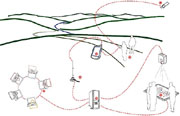
Shared Individual and Collective Sound Cartographies
Silence of the Lands enables participants to collect ambient sounds, then to create and share individual and collective cartographies. These sounds represent subjective interpretations of the soundscape of the urban or natural settings that affect the everyday life of the community, and act as conversation pieces about natural quiet.
1. Data catching: ambient sounds are collected using a PDA. The sounds are linked to the person that collected them, and associated to GPS data; 2. Data description: the sounds are then stored in a database, visualized on a GIS map, and made available for audio-streaming in the web community as individual soundscapes. Participants can access, manage, and eventually modify their own individual soundscapes, associating to them several descriptors; 3. Data interpretation: participants can interact with the collective soundscape. By playing with physical objects in an interactive environment, participants are encouraged to interpret the collective soundscape and create an idealized, virtual one.
A project by Elisa Giaccardi in collaboration with Gianluca Sabena, Hal Eden, and Gruppo Sfera. Currently under development at the Center for LifeLong Learning & Design, University of Colorado, Boulder. Related: Streetscape. [blogged by Regine on we-make-money-not-art]
Posted by jo at 05:57 PM | Comments (0)
December 13, 2005
GSPS: GumSpots™ Positioning System
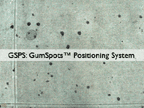
Location Positioning Via Sidewalk Pattern Recognition
GSPS: GumSpots™ Positioning System--by Jason Kaufman and James Sears--is a pattern recognition technology which can be used for a variety of location aware services. Their demonstration of GSPS lets you enter and view hidden data on city sidewalks. A user would take a photograph of the GumSpots with a cellphone and submit it to the GSPS service. The GSPS service would then determine the location and orientation of the image and return the image with extra hidden data displayed on the image. In this case the hidden data will be text as well as 'connect the dot' drawings. A user also has the ability to add hidden text by submitting a note with their image. [via ITP Winter Show, 2005] [Complete list of works here]
Posted by jo at 12:29 PM | Comments (0)
December 12, 2005
Pac-Lan
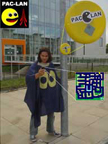
Ghosts in a Maze
Researchers in the Department of Communication Systems, Lancaster University (UK), have developed a game which can be played by up to five players on mobile phones. Pac-Lan enables players to keep track of one another’s position through images on their mobile phones as they chase one another round campus.
Each phone has been programmed with a maze, which is based on a map of the University Campus. Players have to collect points from RFID tags, which have been attached to yellow disks on lampposts around the University. When a player collects their points by holding their mobile phone against the disc the virtual reality maze on each mobile phone is updated with the player’s position. Each player shows up as an animated character (Pac-Lan or Ghost) moving round the screen. This enables a team of "ghosts" to track the player down and catch them.
I do hope that wearing the gown is compulsory for players. More in LU News, The Engineer. More pacman in the streets games: Pac-Manhattan, Human Pacman. List of Location-based mobile phone games. [blogged by Regine on we-make-money-not-art]
Posted by jo at 08:21 PM | Comments (0)
November 29, 2005
'Location is not enough!'
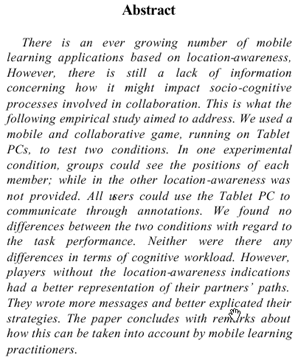
Nova, N., Girardin, F. & Dillenbourg, P.:'Location is not enough!': an Empirical Study of Location-Awareness in Mobile Collaboration" (.pdf). Full paper for IEEE International Workshop on Wireless and Mobile Technologies in Education, Tokushima, Japan. Nicolas' slides are here (.pdf). [blogged by nicolas on pasta and vinegar]
Posted by jo at 09:50 AM | Comments (0)
Spacerace
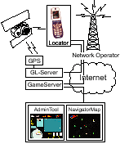
Virtual Crystals Treasure Hunt
Spacerace--by Stephan A. Drab and Gerald Binder--is a location based game for mobile phones designed to demonstrate the possibilities of an Assisted GPS empowered mobile phone:
"The goal of the treasure hunt game Spacerace is to collect as many virtual crystals as possible in a small outdoor area. In order to collect a crystal, the Captain has to get near the virtual position of the selected crystal. He is guided by an Assisted GPS phone which shows the current distance to it. He is supported by the Navigator who has an overview of the position of the Captain and all the crystals they have to collect.
The Navigator tells the Captain which crystal to go after and where it is located by giving him directions in terms of points of the compass. The captain selects the suggested crystal number and tries to find it using the Navigator’s directions and the distance displayed on the screen of the mobile phone. After getting close to the desired virtual destination the crystal is collected and the team scores an amount of points. Crystals have a lifetime after which they disappear. The amount scored by the team after finding a crystal is dependent on the remaining lifetime. The faster the team finds the crystal, the more points they get." [blogged by nicolas on pasta and vinegar]
Posted by jo at 09:33 AM | Comments (0)
November 21, 2005
Data Portraits

Social Maps of Time & Space
a series of aesthetic data visualization sketches as insightful 'portraits' of how people use data about them, through a visual representation of information patterns created during mobile conversations. one of the sketches investigates the spatial distribution & relationships between the places & users. the graphic shows the representation of the cities for each user based on how many times they were called & the total amount of time spent on during the conversations. currently, these graphics are seen as 3D environments that can be implemented as interactive visualizations, enabling users the control of a camera to browse the scene from a desired point of view (i. e. as if traversing a visual narrative). see also ispots wireless network visualization. [mit.edu] [blogged on information aesthetics]
Posted by jo at 02:58 PM | Comments (0)
November 18, 2005
1:1 Track
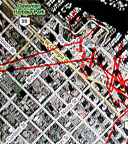
a locative media project
1:1 Track, by Anna Scott & Brenda Cleniuk, is a performative research project in locative media. The project is process-based and open to audience interaction and will be realized in two parts; the second of which will take place in the spring of 2006. The work takes as its starting point, the geospatial architecture of the Hotel Vancouver as tracked by the global positioning system (GPS) in an attempt to uncover meaningful coincidences in the relationship between technology and the supernatural. The artists invite interested persons to join them in a demonstration of their protoscientific methodologies in obtaining data. Embarking on a walk through Greater Vancouver, the artists respond to spikes in the GPS readings allowing haptic or random visual clues to navigate and determine their movements throughout the City. Peripatetic walks will commence Friday November 18 at 11:00 am and Saturday November 19, at 11:00 am and 3:00 pm starting outside the main entrance of the Hotel Vancouver on Georgia Street.
Walks are from 1 - 2 hours in length and may involve short boat trips or excursions to public parks and other landscapes. Special Media Consultant: Jen Hamilton.
Posted by jo at 06:11 PM | Comments (0)
November 16, 2005
blubox + fotobox
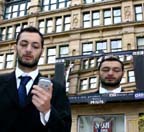
networked public art
"my current research title explores public art as a playful mediated urban environment. to clarify my terminology, I use >playful< to refer to a game-based situation. playing is fun, interactivity can be playful, playfulness mostly experienced by two or more people. i was cautious not to use the word >game-based< or as to describe my art practise as game design. i am however interested in addressing the notion of >game-play<, a term which was mainly used within the context of gaming during the development of video game design in the early 1980’s.
whereas the term >mediated< is not only referring to a space that has been modified such as by the installation of a variety of media tools but also in establishing a mode of >social interaction< that can be generated by such tools. referring to >public art< in the title is aiming to drive forward the debate of >new genre public art<. this development comes out of the more traditional practise of public art, concerning itself not only with the site-specificity of a public place but addresses the significance of audience in the development of the artwork. the emphasis is to widen and define a more >inclusive< mode of public art practice.
my >blubox< artwork is piloting an example of the above mentioned terms and practises and sits amongst 4 other case studies of artists using mobile and wireless media devices. >blubox< which is a systems-based art project, enables the public to network together via bluetooth to play with various designed mobile applications in a coordinated city environment. i am now inclined to change my research title to outline exactly what my art practise is researching: public art as a wireless network." [blogged by Maria N. Stukoff on mobilebox]
Via Locative:
"blubox is a unique bluetooth software and hardware application designed and developed by Maria N. Stukoff and Jon Wetherall for the creative use of mobile phones via bluetooth. as part of this development we are invited to trail the first phase of blubox technology - called fotobox an interactive installation with a public LED screen display - at the 3rd Salford Film Festival in
salford/manchester tonight...
...the next phase of blubox will platform a 3D game environment controlled and played via bluetooth technology. we aim to release the framework for this mobile phone game by march 2006..."
Posted by jo at 08:15 AM | Comments (0)
November 14, 2005
VGMap
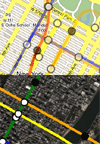
Vector Overlays for Google Maps
VGMap is a new library created by Eyebeam R&D that allows designers, developers, and mapping geeks to overlay data on top of Google Maps in a richer way than is possible using their standard system. It is called VGMap because it adds vector-drawing capability to the already-awesome GMap API.
The Google Maps API enables point and line data on their maps in the form of markers, and polylines. This has yielded a lot of great applications, such as Housing Maps and the GMaps Pedometer (see more at Google Maps Mania). What it does not allow for is vector graphics, which precludes the use of Google Maps for more sophisticated GIS applications. Flash provides for vector drawing, as well as a well-worn interactive and animation functionality. This VGMap library is simply the glue between GMap and Flash, as well as a handful of Flash ActionScript libraries and sample code to simplify the process of drawing over the map correctly.
Posted by jo at 09:00 PM | Comments (0)
Shoot me if you can
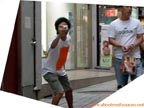
Replace a gun with fun
Shoot me if you can is an urban game inspired by first person shooting online video games. Replace a gun with fun, and shoot the opposing team with a cellular phone equipped with a digital camera. Participants; shooters are given a team color and phone number printed on the sticker. Shooters have to take a picture of the opposing team. If successful, she/he sends the picture to the opponent team member, via multimedia SMS system. Different rules exist for variations in game. Tactics are an important part as well as team work and understanding of the urban environment. This work is a commentary on abundance of digital image in our culture, desire to photograph and violence of surveillance camera. Active public participation in encouraged through website and the game. [via pasta and vinegar]
Posted by jo at 06:02 PM | Comments (0)
November 10, 2005
GPSdiary.org
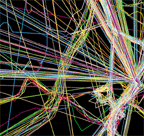
Follow Along
GPSdiary.org is an online archive of an art project, in which artist Thorsten Knaub recorded his daily movements over the course of a year by carrying a Global Positioning System(GPS) receiver on him.
The GPS utilises special satellites in the earths’ orbit to record any change of one’s position on the surface of the earth. Therefore any kind of movement will be charted according to the latitude and longitude grid system, e.g. a walk to the local shop results in a small 'drawing', a day spent at home will be recorded as a dot only but a journey on the London Underground results in a straight line between the tube station where he is out of range of the GPS satellites.
GPSdiary.org makes it possible to view each days’ trajectory individually and hence follow the artists’ daily routine and movements. [via rhizome]
Posted by jo at 05:46 PM | Comments (0)
GeoDrawing
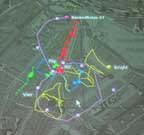
Drawing 8s in the Night
With GeoDrawing, a GPS-based mobile drawing game for the Amsterdam Museum Night, "teams would go into the city where they compete on who would (geo)draw the most beautiful "8" by walking with a GPS and a mobile phone. They could embellish their drawings with photo’s and video’s taken and submitted on the spot. The competitive element was creativity with both the drawing and the media. All submitted media were tagged to the geographic locations where they were taken. The player’s movements, tracks and media could be followed in real-time through a webbrowser." [via pasta and vinegar]
Posted by jo at 05:00 PM | Comments (0)
November 08, 2005
Proximity Lab
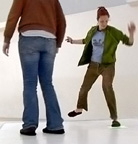
Footprints
Proximity Lab is a participatory installation and experimental interface platform designed to visualize relationships between users and mediated spaces. The 8-foot by 16-foot walkable surface is fitted with RFID technology. Participants wear shoes fitted with RFID tags, enabling the system to track and record their positions in real-time. Images projected directly onto the floor are accompanied by stereo sound as a continuous response to the actions and interactions of participants.
Proximity Lab can discern the individual identities of participants regardless of how or where they move. Conceived as an experimental physical interface system, it allows architects with diverse intentions and aesthetic goals to create repeatable experiments in physical interaction. By Evan Karatzas. [blogged by Regine on we-make-money-not]
Posted by jo at 08:15 AM | Comments (0)
October 31, 2005
Electrical Walks
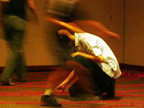
Amplified Currents
Electromagnetic induction is based on the sounds resulting from the mutual interaction of magnetic fields. Audio artist Christina Kubisch developed magnetic headphones with magnetic coils that respond to electrical fields in the environment. At first she tried to filter the hum of the electrical wires out of the headphones. But the increase and spread of "unwanted" electrically-produced sounds inspired Electrical Walks. With special, sensitive headphones, the acoustic perceptibility of aboveground and underground electrical currents is thereby amplified.
The palette of these noises, their timbre and volume vary from site to site. They are ubiquitous. Light systems, transformers, anti-theft security devices, surveillance cameras, cell phones, computers, elevators, antennae, navigation systems, automated teller machines, neon advertising, etc. create electrical fields that are otherwise undetectable.
With the headphones and a map of the area, upon which the especially interesting electrical fields are marked, the visitor can set off for a special kind of stroll in cities. The perception of everyday reality changes when one listens to the electrical fields; what is accustomed appears in a different context. Nothing looks the way it sounds. And nothing sounds the way it looks.
Electric Walks is part of Her Noise, an exhibition featuring 5 installations by artists who use sound as a medium to investigate social relations, inspire action or uncover hidden soundscapes, at the South London Gallery, 10|11|2005 - 18|12|2005. See also the interview of Christina Kubisch in Audiohyperspace. Related: aetherspace, Electroprobes, the Amazing All-Band Radio, etc. [blogged by Regine on we-make-money-not]
Posted by jo at 12:20 PM | Comments (0)
Digital Storytelling Festival
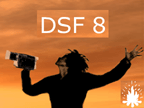
Scape the Hood
Just wanted to let everyone know about the 8th annual Digital Storytelling Festival in San Francisco Oct 7-10 hosted by KQED, public broadcasting. There will be a large locative media presence. The opening night party is the launch of the 'Scape the Hood mediascape, Using GPS-enabled HP iPAQs and software developed by HP Labs, participants will walk the streets and listen to the neighborhood stories, taking in the sights, sounds, and smells from both the physical and virtual worlds.
Peel back the layers of the neighborhood and explore narrative archeology with us. Hear the stories of Project Artaud, once the American Can Company, now transformed into a dynamic live/work space for artists. Experience the Mission Village Market, a bustling flea market on Saturday, but just a ghost of itself on Sunday. Transport to the environs long since erased by the overlay of the city.
Join us for food, fun and the release of the Scape the Hood mediascape, an experiment that combines storytelling and emerging technology by overlaying a digital landscape on the physical world.
The Digital Storytelling festival also includes a session on Situated Storytelling with panelists Nick West, Hana Iverson, Jo Reid, as well as a gaming session discussing place-based tools and techniques.
For more information on the mediascape: lrule[at]kqed.org
Leslie Rule
Project Supervisor
Digital Storytelling Initiative
KQED, Public Broadcasting, San Francisco
(cel) 415-225-1925
New website is up: www.kqed.org/dsi
Posted by jo at 09:29 AM | Comments (0)
October 29, 2005
Locative Media as Socialising and Spatialising Practices:
Learning from Archaeology
"Abstract: Pervasive computing and locative media are emerging as technologies and processes that promise to reconfigure our understandings and experiences of space and culture. With the critical hand of material and cultural studies, we start to shape questions about locative media representations of urban mobilities, and begin to unearth some of the struggles and tensions that exist within these fields of operation. By looking at archaeology’s constitutive processes of collection, ordering and display we highlight some of the problems found in mapping people and objects in space and time, and ask what kinds of social/spatial relations are made possible in particular locative media projects. Ultimately, we take archaeology’s critical focus on authorship and ownership, explain its relevance to locative media, and suggest questions to consider in the future research and design of locative media." From Locative Media as Socialising and Spatialising Practices: Learning from Archaeology (draft) (PDF), by Anne Galloway and Matt Ward.
Posted by jo at 11:32 AM | Comments (0)
October 28, 2005
PLAN: Mikel Maron
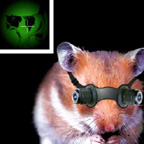
Locative Animals
Mikel Maron’s presentation of his contribution for the Open Plan workshop is very insightful and original. I like his ‘locative animal‘ concept very much:
"My [Mikel Maron] angle in my application to the Workshop was Locative Animals. Nothing much happened on this, but I did get to meet a researcher with similar interests, Shaun Lawson. Here’s the blurb I submitted on Locative Animals.
My interest in Locative Arts has been somewhat on the fringes of the predominantly urban, socially focused arts projects. The natural world is under ever greater stresses, and these technologies, usually employed to buffer nature, can and have been effectively used to raise awareness of the non-human world and give it a voice. The idea of over saturation of technology has been parodied by projects like "Augmented Animals," though in reality new communication modes are being employed by wildlife researchers to track elephants and reindeer by SMS and GPS. I’ve been gathering various resources on spatial technology and spatial understanding in animals under the moniker Locative Animals.
Nature is not separate from urban experience, though most city dwellers would not be that aware of the populations living in their midst. Sensing and tracking of wild fuana and flora in urban environments could raise awareness of wildlife in a tangible, positive way. Bird watchers are particularly active and independent; tools to bridge individual bird monitoring into larger situated databases and patterns could be another interesting application of the technology. Another interesting area is Porton Downs, site of much controversial chemical testing, but due to the lack of intensive human activity, also home to many rare species that have disappeared from the rest of the UK. If access is be attained, artistic investigations of nature on this site would be potentially very insightful.
This concept grows out of my interest in spatial models of ecosystems, and spatial niches. Birds may not be able to navigate human buildings that competently, but they can migrate to precise locations over 1000s of miles, with senses evolved for the purpose. In other words, a map is only one (and sometimes inferior) way to get around. The Nottingham Jubilee Campus was a pretty successful brownfield restoration, melding natural and urban fabric." [blogged by Nicolas on pasta and vinegar]
Posted by jo at 09:24 AM | Comments (0)
October 25, 2005
Morgan Schwartz
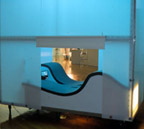
Chance Encounters, Deliberate Interventions
Pursuit of Happiness: Porta-Sky is an urban sanctuary and think tank for two. Periodic trips into the dark relaxation chambers of movie theaters became a routine survival technique for the subjects of modern society. In our post-modern world, where work and leisure have collapsed, the Internet has become a space of convergence. "Porta-Sky" is a physical corollary – a non-space, a hallway from here to there. Providing a personal view of a virtual sky, this video projection space offers alternate imagery to an anxiety-ridden sky. The unit features dual, synchronized DVD video projections, a deployable surveillance blimp and custom designed form-fitting reclining seats.

Situated in the Gallery@Green St (adjacent to the Green St. Subway station on the Orange Line in Boston, MA), Pressure was a site specific installation where computer controlled sensors manipulated the sights and sounds of daily commuting to address issues of accelerated culture and the evolving metaphors for speed and progress. Pressure seeked to explore the psychology and physicality of individuals in the contemporary urban landscape.
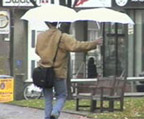
umbrellaSpace is an urban gesture. It is a design solution to a social problem. The intervention adjusts perceptions of boundaries and comfort held by observers on the street. This umbrellaSpace adopts the umbrella as a familiar, recognizable, urban form and recreates it. A permeable space of interaction is transformed from a private, individualized space. An individual in the urban sphere operates this new umbrellaSpace. He or she can choose to invite people on the street into this space. I’m interested in exploring the range of responses this intervention precipitates on the street: sociological, visual, performative. Schwartz is looking for people interested in operating the UmbrellaSpace as well as videographers and photographers interested in documenting the events.
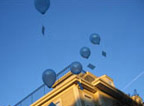
Currently in development at the Berwick Research Institute and on exhibit at Glowlab: Open Lab, Whether/Weather consists of aerial beacons that are dispersed into the weather system. The beacons are helium powered with LED blinkers. Like seeds, these beacons drift with the wind and carry information/stories/memories that hopefully germinate wherever they land. Whether used by an individual or a large organization, the project explores the idea of memory and memorialization through ephemeral and participatory public art. The person who happens upon one of the beacons that has landed, will encounter a message and the option of logging into a website to find out more about where/why the beacon originated. They can contribute their own response at this point and even decide to re-launch the beacon. By logging when/where the beacons are launched and when/where they are found Schwartz is visualizating whether/weather patterns. He hopes that the project will function like a collective 'message in a bottle' and tap into romantic and poetic possibilities of communication and chance discovery.
Posted by jo at 10:02 AM | Comments (0)
October 18, 2005
Three Crosses of Queensbridge
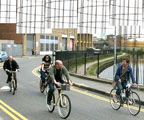
Acoustic Conversions
London-based artist Kaffe Matthews' Three Crosses of Queensbridge is a symphony for radios and bicycles. Replacing notes written on a musical staff are drawings on a neighbourhood map: providing various itineraries for visitors to follow on bikes, the artist broadcasts an electronic composition over a live radio signal. Cycling around the streets with radios receiving the broadcast, participants become performers and passers-by become accidental audience members.
The work is part of the Sounds like Drawing exhibition, at the Drawing Room, East London, 13 October - 20 November 2005. [via Regine on we-make-money-not]
Posted by jo at 06:18 PM | Comments (0)
October 14, 2005
Touch

Exploring User Centred Applications for NFC and RFID
Touch is a research project at the Interaction Design department at the Oslo School of Architecture and Design. Touch takes a user-centred approach to Near Field Communication (NFC). NFC is a technology that enables connections between mobile phones and real-world objects: bridging the gap between the real and the virtual. The project offers the possibility of radically simplifying existing applications and providing a new spectrum of local services through the mobile phone. At AHO we have multiple disciplines, including interaction design, industrial design, urbanism and architecture; a group with significant interest in the areas possibilities of NFC technology.
Posted by jo at 11:11 AM | Comments (0)
October 13, 2005
City Streets Transformed

Stories come to life in San Francisco experiment
We call this 'narrative archeology', because we're peeling back the layers of the neighborhood.
"Artists, writers, educators and others convening for this year's Digital Storytelling Festival in San Francisco will have the opportunity to participate in a unique storytelling experiment that uses emerging technology to merge the digital and physical worlds.
The experiment, called Scape the Hood, will transform a few seemingly drab city blocks into a landscape rich with sound, sights and stories. Using GPS-enabled HP iPAQ Pocket PCs and a location-based software platform developed by HP Labs, participants will be able to walk around the neighborhood and learn about its history and culture -- and about impending changes to its character.
Artists, mayonnaise and the ice cream truck
Over the course of four days beginning October 7, festival-goers may learn about how a painter's memories of his mother's death inspired a mural, or how artists transformed a canning plant into one of the nation's first live/work spaces or how a vibrant flea market brings together a diverse community.
Participants may hear the gurgle of a creek that ran where a street now lies or the jingle of the ice cream truck or the sound of trains that once carried corn oil to a mayonnaise factory that has since become a Starbucks.
"These stories aren't obvious from the streets," says Abbe Don, a researcher at HP Labs and executive producer of the project. "We call this 'narrative archeology,' because we're peeling back the layers of the neighborhood."
Previous HP Labs experiments
Scape the Hood follows on earlier HP Labs work on pervasive multimedia experiences. Working as part of the Mobile Bristol project, a test bed for technology and user research in mobility and future mobile services, scientists in HP Labs Bristol (UK) have recreated a series of these experiences including what is believed to be the world's first global positioning system "radio play."'
Researchers in Bristol, working with partners from Bristol University, developed the software used in Scape the Hood to place media files, such as sounds and images, in a location to blend in and augment a physical area. Associated software, loaded on to HP iPAQ handheld computers equipped with GPS satellite positioning, allows the user to access automatically the different media files as they move from place to place. An Open Source version of the software is available from Mobile Bristol.
Digital Storytelling Festival
Scape the Hood will take place on the streets surrounding KQED Public Broadcasting, which collaborated on the project through its Digital Storytelling Initiative with HP and a group of San Francisco Bay Area artists, storytellers and technologists including representatives from Antenna Theater, the Project Artaud artists' cooperative, San Francisco State University. The project was supported with a grant from HP.
The Digital Storytelling Festival, this year celebrating its 10th anniversary, aims to promote and evolve the art and practice of digital storytelling, offering workshops, panel discussions and speakers. KQED is the premier sponsor and host of this year's festival.
For more information, see the Digital Storytelling Web site." -- Jamie Beckett, Oct. 2005, Hewlett-Packard.
Jamie Beckett is managing editor of the HP Labs Web site and a veteran newspaper reporter and editor.
Posted by jo at 11:35 AM | Comments (0)
Map to Sine
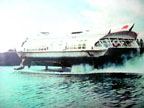
Cartiographic Translation in Sound Experienced by Russian Hydrofoil
Map to Sine is a two-part project by South African artist James Beckett (1977) as part of the international exhibition of contemporary art ADAM, produced by SMART Project Space. Map to Sine is a series of translations from image (cartographic) to sound, based on much of the fascination and formal study of the German Serialist musicians. Exercise such as the rotation of musical pattern, the arbitrary expansion of spacing and the imposition of shape applied directly from nature all formed part of their practice.
With the generous support of the transport company Connexxion, Beckett will host passengers to a live translation of surrounding information of the North Sea Canal, aboard a Russian Hydrofoil - a water rocket of eighties design. The Bulgarian performance artist Zhana Invanova (1977) offers a live explanation of the system in both Russian an English for the benefit of an educational composition.

Dates: Friday 14th, Saturday 15th, Sunday 16th October 2005; Times: Leaving Amsterdam 15:00hrs; 16:00hrs; 17:00hrs; Where do you catch the boat? Connexxion fast service between Amsterdam and Velsen-South (direction IJmuiden); Departing behind Amsterdam Central Station, just to the left of the ferry which crosses the North-Sea Canal; 25 minutes there, 25 minutes back. For more information: www.connexxion.nl
Posted by jo at 10:18 AM | Comments (0)
October 12, 2005
Placing Voices
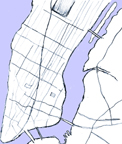
mobile-sound-blog
Voices of strangers heard in passing are key threads in the fabric of urban experience, subconsciously coloring our perception of a place. Yet such features are inherently unrepeatable, unique to every individual's listening experience, and, unlike a photograph, the location of a recording is difficult to recognize. Placing Voices, by Brian House, is a mobile-sound-blog software which uses the built-in sound recording feature of mobile phones (which is optimized for voice) and MMS messaging to place these fragments on a web-accessible map of the city as they occur. The objective is to express a map in terms of these experiences, to restore some claim to my memory of physical spaces over the transient voices heard within them.
Posted by jo at 05:03 PM | Comments (0)
Locative Space:
Situated and Interconnected
Locative media refers to a mobile media movement in which location and time are considered essential to the work. As locative blogger extraordinaire Thomas Angermann of Angermann2 say in response to a post to Mapping Hacks by Schuyler Earle, "at one level, thinking ‘locative’ means doing geo stuff without actually having learned the traditional geo toolsets [read, geographic information systems (GIS), ED]".

From a term proposed originally at an obscure workshop in the Baltic several years ago locative media now gets 220,000 hits currently on Google. On any given day a steady stream of locative projects are documented in blogs such as Networked Performance and We Make Money Not Art. Critical theory has however come out against locative media.
In his "Drifting Through the Grid: Psychogeography and Imperial Infrastructure" published in Springerin, Brain Holmes' advocates "conceiv[ing of] the worldwide communications technologies as Imperial infrastructure". According to Holmes, since GPS satellites are controlled by the US Army, "when you use locating device...: you are interpellated into Imperial ideology." While traditionally maps may have been a a form of visual knowledge generated by and for Imperial ideology, new practices of information technology begin to open up the practice of mapping to civic society. A great number of projects beyond locative media are working to Make Things Public. The idea here has to do with making the flows of Networked Society visible and transparent.
Perhaps the locative project par excellence is MILK, winner of this year's Golden Nica at Ars Electronica. With MILK, the artists, Esther Polak and Ieva Auzina, used GPS traceroutes to create a form of landscape art for network society. MILK is based in part on a project by Polak and the Waag Society, "Real Time Amsterdam" in which Amsterdam bicyclists created a map of city's bizarre traffic routes by the sedimentation of their GPS transponders over a period of weeks. Polak's latest work connects Manuel Castells's "space of flows" with his "space of place" by tracing the path of an agricultural product, in this case milk, from its origins in rural Latvia to a cheese vendor in the Netherlands.
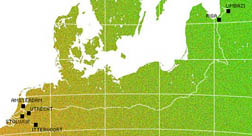
MILK suggests a powerful vision of locative technologies which allow one to trace the origins of foodstuffs—a much sought after ideal in this era of global mega-viruses—thereby making visible the networked society. I believe it was this reading of MILK that drew Bruno Latour to include the project in his ZKM exhibition "Making Things Public."
To be fair, the MILK project's artists are not interested in Latour's reading, seeing their work more as a form of romantic landscape art, indeed when making the project they came to a fork in the route that led in one direction to McDonalds and in the other to the Dutch cheese show, they chose the former. Nevertheless, Latour's reading is the one that interests me here and I am looking at MILK's as emblematic of that condition, regardless of the project's intent.

A different project at Latour's exhibition, Issue Crawler, suggests to me another dimension by which we could map the Network Society more effectively. Issue Crawler maps of the hyperlink structure around debates on the Internet, allowing us to see all of the actors in a particular network and how they relate to one another, much as in a Mark Lombardi drawing. This potential project would, then, combine Issue Crawler's situational analysis with the locative analysis of MILK. Where MILK suggest a notion of space from here to there, Issue Crawler develops a more relative notion of location in reference to. To really determine one's "locativity" it would surely be necessary to consult both of these perspectives.
In a CTheory article entitled "Operational Media", Jordan Crandall speaks of the "resurgence of temporal and locational specificity witnessed in new surveillance and location-aware navigational technologies". The Minority Report vision of the future, of which we are constantly reminded by MIT is suppoised to be one of smart objects with IP addresses communicating with us, with one another. and with "everyone else". Here the question of location becomes crucial. My tracklog and my social network amount to a marketer's dream. To know where I am, is to know how to sell [to] me. This has led critics like Holmes and Crandall, to accuse locative media of being, in, another critic, Andreas Broekman's terms , the avant garde of the Control Society.
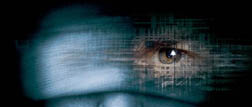
In Giles Deleuze's Society of Control thesis (L'autre journal, Nr. I, Mai 1990), "[w]e are in a generalized crisis in relation to all the environments of enclosure." Deleuze states "Enclosures are molds, distinct castings, but controls are a modulation... that will continuously change from one moment to the other". For Deleuze "The family, the school, the army, the factory are no longer the distinct analogical spaces...". "[E]veryone knows that these institutions are finished..." states Deleuze "it's only a matter of administering their last rites...". According to Crandall, locative media is implicit in a "machine-aided process of disciplinary attentiveness, embodied in practice, that is bound up within the demands of a new production and security regime." Yet, as Deleuze states, "there is no need to fear or hope, but only to look for new weapons".
According to Bruno Latour: ""Things" are controversial assemblages of entangled issues, and not simply objects sitting apart from our political passions. The entanglements of things and politics engage activists, artists, politicians, and intellectuals. To assemble this parliament, rhetoric is not enough and nor is eloquence; it requires the use of all the technologies -- especially information technology -- and the possibility for the arts to re-present anew what are the common stakes." As a locative artist, I envision a practice of networked technologies that might convert Crandall's "machine-aided process of disciplinary attentiveness" into new civilian tactics. [blogged by Marc Tuters on netPublics]
Posted by jo at 11:46 AM | Comments (0)
October 11, 2005
Glow Positioning System
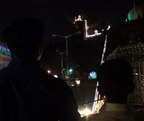
At the General Post Office, Mumbai
There are many ways to locate a city. One way is to distance oneself from it- to look it up in an atlas, a picture, or to go out to sea or up a hill to watch the twinkling lights, and point out the streets we know. Another way is to move within the streets themselves; to awaken the more proximate senses, to touch the city itself. The historical space between and across these two extremes is richly populated: by maps, movies, mondo nuovo, grids and drifts, 'oramas and 'oscopes, flaneurs, heterotopias, travelling shots and shooting travelers.
In recent times, Global Positioning Systems (developed originally for US military use) have allowed for an unprecedented connection between the mover and the map. GPS devices tell us where we are at all times, everywhere on the globe. Implying that we will travel, globally. In Glow Positioning System--by Ashok Sukumaran--a different kind of travel is implied. This is an interior voyage, a circular tourism of a place we know.
A 1000-foot ring of lights encircles the General Post Office intersection in Fort, Mumbai. The lights travel between buildings, across roads and onto trees and lampposts, forming an image-scape that is starkly visible at night. A hand-crank mounted on the pavement provides a way for the audience to "scroll" this landscape. It allows the physical length of the view to become a chronological one- to be viewed at a speed determined by the user.
The ring responds to panoramic desire, that age-old search for an image to immerse our selves in. From Cycloramas to VR (via the tradition of urban panoramas in painting and photography), the "surround view " has been a recurring element of urban and cinematic manifestos. Of course, the city surrounds us already. Here we just connect the dots, and look again.
In any city, various forms of lighting create a distinct nighttime experience - floating us away from from the concrete views of daylight. In India, this is a pervasive medium- think of Diwalis in the city, or weddings, for example. Chases, bursts and strobes provide moving effects, a vivid transarchitecture. "Chinese" string lights - they cost about $2 for 14 feet - have made a nighttime "presence" feasible for almost anybody. For this project, such lights (and others) were installed on the facades and rooftops (and sometimes interiors) of several homes , a real-estate office, a razor-blade manufacturer's office, a transit lodge, an abandoned bank, several shops and restaurants, and a 150-year old "heritage" structure (the GPO). Local lighting decorators I was working with designed and installed the lighting, in collaboration with home and office owners.
The lights are then connected in a virtual loop, which overlays the concrete urban architecture and the electrical grid. The hand-crank interface is mounted on the pavement near the Kabutarkhana (pigeon coop) . As you turn the crank, the lit part of the ring of lights moves, for example from the Kothari building onto the trees, or from one minaret to the next. Changing the speed of rotation causes variable persistence effects, both actual and perceived. A path of movement is traced upon the concrete city, and our heads turn to meet it. The crank mechanism itself refers to not only its specific history in the moving panorama, but also a general history of the moving image: as a driver for cinema. Like cinema, the experience does not depend on the observer being physically displaced. Yet there is the clear sense of an actual landscape, and the promise of a haptic journey.
This entire project is a kind of poetic infrastructure, a layer on top of the urban design and conservation Plans that define "inner city" precincts. In a playful and accessible way, it attempts to rewire the use-based definitions (post office, eating, shopping, etc) of this public space.
Glow Positioning System was commissioned for the Mumbai Festival 2005 by the Jindal South-West Foundation.
![]()
Ashok Sukumaran was recently awarded the main prize of the UNESCO Digital Arts Award 2005-"City and Creative Media".
Posted by jo at 05:11 PM | Comments (0)
Art Center Nabi + Seoul
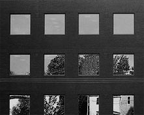
Urban Play and Locative Media
Emerging technologies such as wireless network, locative media, and pervasive computing have brought about new perceptions and social interactions in urban environment, transforming the ways we experience our cities. The concepts of space, time, and social relationship in urban environment are put in flux, while there are growing interests among communities of artists viewing city as social playground, public space, fluid canvas, and invisible layers of network.
Art Center Nabi is organizing an international workshop in partnership with the city of Seoul to initiate cultural and artistic projects exploring the theme of Urban Play and Locative Media.
On the cross platforms of art, design, technology, and social sciences, submissions are sought to deal with the issues of participation, play, process, and engagement in urban environment incorporating various locative and pervasive media technologies. We are looking for fresh and thought provoking insights and projects that are to reflect on but not limited to the critical issues as following:
-How new communication media opens up new ways to engage people in public domain?
-In what ways people participate and play in urban environment in dynamic formation of city?
-What kind of urban games are possible using emerging technologies? And what kinds of collective ‘vibes’ can be generated through these games?
-How can physical or virtual spaces in city be created, experienced and accessed by collaborative or competitive movement of people?
-How can diverse aspects of city whetollaborative or competitive movement of people?
-How can diverse aspects of city whether cultural, historical, social, or personal be reflected and shared through participatory gestures?
-How can disparate neighborhoods or different communities be linked, interact or confront in playful gestures?
* Area in focus: Myung Dong in Seoul
We are also initiating calls that manifest and explore diverse aspects of metropolis Seoul, specifically focusing on Myung Dong area. Myung Dong is one of the representative sites located in central Seoul with its historic background, highest land value and concentration of commerce and people. The city government is undertaking a major redevelopment plan that possibly includes new zoning and new IT infra, in order to make Myung Dong as the symbol of ‘New Seoul.’ For our purpose, Myung Dong can serve as a test bed in exploring the theme of ‘Urban Play and Locative Media’ with cultural and artistic approaches.Dong can serve as a test bed in exploring the theme of ‘Urban Play and Locative Media’ with cultural and artistic approaches.
More info on Myung Dong (in Korean):
http://www.myungdong.co.kr/md/main_down_1.html
Please contact us [urban2005[at]nabi.or.kr] to receive more information on Myung Dong in English.
Posted by jo at 04:57 PM | Comments (0)
Sensory Threads

Adding Sentient Knowledge to Machine Data
Sensory Threads aims to stimulate and inform a public debate on how personal biosensor data is collected and used in biomedical science. It will combine an artistic with an evidence-based approach, building and testing a prototype body biosensor network that uploads data to Urban Tapestries. This will allow participants to map experiential and emotional annotations to their readings – adding a whole new layer of sentient knowledge to machine data. It is intended to demystify how data is collected, what it produces and how we can correlate it to other factors affecting health such as environmental pollution.
By testing our ideas in real world situations we hope to investigate how empirical data collected from sensor readings attached to the body can be interpreted in a variety of different ways by different disciplines, revealing its limitations for healthcare applications and in the long term for the public. We aim to address the social, cultural, environmental and ethical concerns implied by the reliance on sensor data for understanding the complex interactions between the body and its environment...
Posted by jo at 03:19 PM | Comments (0)
Picking Pockets on the Lawn:
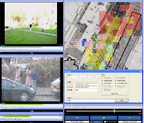
The Development of Tactics and Strategies in a Mobile Game
"Abstract: This paper presents Treasure, an outdoor mobile multiplayer game inspired by Weiser’s notion of seams, gaps and breaks in different media. Playing Treasure involves movement in and out of a wi-fi network, using PDAs to pick up virtual ‘coins’ that may be scattered outside network coverage. Coins have to be uploaded to a server to gain game points, and players can collaborate with teammates to double the points given for an upload. Players can also steal coins from opponents. As they move around, players’ PDAs sample network signal strength and update coverage maps. Reporting on a study of players taking part in multiple games, we discuss how their tactics and strategies developed as their experience grew with successive games. We suggest that meaningful play arises in just this way, and that repeated play is vital when evaluating such games." From Picking Pockets on the Lawn: The Development of Tactics and Strategies in a Mobile Game by Barkhuus, L., Chalmers, M., Tennent, P., Hall, M., Bell, M. and Brown, B.; Proceedings of UbiComp 2005, Tokyo, Japan.
Posted by jo at 02:54 PM | Comments (0)
October 05, 2005
Transactions of CHI:
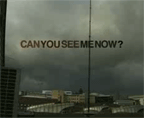
Can You See Me Now?
"We present a study of a mobile mixed reality game called Can You See Me Now? in which online players are chased through a virtual of a city by ‘runners’ (i.e., professional performers equipped with GPS and WiFi technologies) who have to run through the actual city streets in order to catch the players. We present an ethnographic study of the game as it toured through two different cities that draws upon video recordings of online players, runners, technical support crew, and also on system logs of text communication. Our study reveals the diverse ways in which online players experienced the uncertainties inherent in GPS and WiFi, including being mostly unaware of them, but sometimes seeing them as problems, or treating the as a designed feature of the game, and even occasionally exploiting them within gameplay. In contrast, the runners and technical crew were fully aware of these uncertainties and continually battled against them through an ongoing and distributed process of orchestration.
As a result, we encourage designers to deal with such uncertainties as a fundamental characteristic of location-based experiences rather than treating them as exceptions or bugs that might be ironed out in the future. We argue that designers should explicitly consider four potential states of being of a mobile participant – connected and tracked, connected but not tracked, tracked but not connected, and neither connected nor tracked. We then introduce five strategies that might be used to deal with uncertainty in these different states for different kinds of participant: remove it, hide it, manage it, reveal it and exploit it. Finally, we present proposals for new orchestration interfaces that reveal the ‘seams’ in the underlying technical infrastructure by visualizing the recent performance of GPS and WiFi and predicting the likely future performance of GPS." From Can You See Me Now? by Steve Benford, Andy Crabtree, Martin Flintham, Adam Drozd, Rob Anastasi and Mark Paxton + Nick Tandavanitj, Matt Adams and Ju Row-Farr
Posted by jo at 08:30 AM | Comments (0)
October 04, 2005
Field Works:
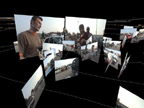
landscape + activity visualizations
"Currently close to my place in Geneva, there is an interesting art exhibition by MASAKI FUJIHATA called “Field Works” (at the Centre Saint Gervais). It happens to be close to locative media arty concepts:
Masaki Fujihata has worked for some fifteen years on new forms of visualizing knowledge, space and time. He is intrigued by the possibilities of recording three-dimensional data and has elaborated a complex yet ultra-lightweight electronic system that goes along with him in his travels around the globe, enabling him to capture in a surprising way the landscapes he has encountered. This equipment consists of a backpack topped by a GPS receiver and a wide-angle video camera to which are attached a directional microphone, a pocket computer, and an electronic compass.
Kitted out with his equipment, Fujihata records the regions he visits, inviting us to tag along with him on his singular walks. Each of the sites where these walks take place was chosen in terms of the possibility of developing a project there linked specifically with its geography and history. (…)
All of the material (images, interviews, spatial coordinates, camera positions) gathered in the course of these trips is brought together in a computer. At the editing stage Fujihata cuts and recomposes the itinerary along the route recorded by the GPS, attaching frames—their orientation and movements—to its tangled threads and thus staggering the shots throughout the space-time. Viewers can then see recreated on the projection screen the different views captured during the walk. These are exactingly restored to their spatiotemporel sequence thanks to the coordinates furnished by the GPS, which serves as a thread running through the reading.
This three-dimensional cartography introduces a topography that immerses viewers in the experience of a virtual excursion. They navigate in front of a screen, building other stories while following the GPS itinerary, which guides them through the twists and turns of a landscape that has been laid out by multiple points of views." [blogged by nicolas on pasta and vinegar]
Posted by jo at 08:30 AM | Comments (0)
October 03, 2005
PLAN & Mixed Reality Laboratory
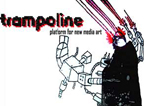
Discussion at Trampoline
The Pervasive and Locative Arts Network and Mixed Reality Lab, Nottingham University will be holding a presentation as part of TRAMPOLINE on Thursday 6th October at 8.30pm, Broadway Mezz Bar, Broadway Cinema, Nottingham. Representatives of PLAN and MRL Drew Hemment, Ben Russell and Steven Benford will be discussing their recent activities in encouraging discourse between artists, scientists and engineers in the field of pervasive and locative media. Come along to this discussion and find out more about the innovative research, development and artistic production which is being pursued in this area.
PLAN: A new international and interdisciplinary research network in pervasive media and locative media has been funded as part of the Engineering and Physical Sciences Research Council (EPSRC) Culture & Creativity programme. The network will bring together practicing artists, technology developers and ethnographers with the aim of advancing interdisciplinary understanding and building consortia for future collaborative projects. It will be of relevance to people working in the arts, games, education, tourism, heritage, science and engineering.
The network will stage three major gatherings. Each gathering will have a distinct form and focus: an initial workshop to launch the network and assess the state of the art; a technology summer camp for artists and technologists, including hands-on prototyping sessions using the facilities at Nottingham's Mixed reality Laboratory; and a major public conference and participatory exhibition as a central component of the Futuresonic 2006 festival in Manchester; as well as a supporting web site and other resources.
Mixed Reality Lab: The Mixed Reality Laboratory (MRL) is an interdisciplinary research initiative at the University of Nottingham. The MRL brings together leading researchers from the Schools of Computer Science, Engineering and Psychology to research mixed reality - new technologies that merge the physical and digital worlds. The MRL is focused on the development and application of mixed reality to visualisation, learning, knowledge management, control systems, ethnomethodological studies, leisure and co-operative work.
Posted by jo at 11:50 AM | Comments (0)
September 30, 2005
OpenStreetMap
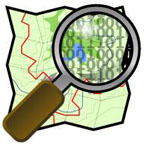
Cartographic Resistance
OpenStreetMap (OSM) is a project aimed squarely at providing free geographic data such as street maps to anyone who wants them. This is because most maps you might think of as free actually have legal or technical restrictions on their use, holding back people from all walks of life who would like to use a map for one reason or another.
OpenStreetMap is (or is almost) a free editable map of the whole world. It is still being written. OpenStreetMap allows you to view, edit and use geographical data in a collaborative way from anywhere on Earth. It comes in three major flavours: 1. Viewer--allows you to browse a map like any other; 2. Applet Editor--allows you to enter new data in your browser. Streets, points and areas can be entered and given metadata like names and whether cars or bikes can travel on them. You can upload GPS traces you've made and also edit the types of data you associate with the geographical data. You have to log in for this, so that the server can keep track of things; and 3. Home editor--this is for more advanced users who want more flexibility and prefer a dedicated application for editing data. [via]
Posted by jo at 09:23 AM | Comments (0)
With Hidden Numbers
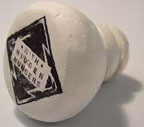
RFID Audio Mixer
With Hidden Numbers, by Meghan Trainor, uses embedded RFID tags to trigger an audio database and illustrate a technology that promises to become more prevalent in the coming years.
Dozens of handmade objects created with plaster, rubber and other traditional sculpting materials, each contain a unique number broadcast with a passive RFID tag. In addition the artist herself had a RFID tag embedded in her arm.
The system allows the audience to handle and scan the objects to activate audio triggers. Depending on the objects selected the result can be like a physical audio mixer, sometimes like a physical database query. The artist could trigger events with the tag in her arm as well, even when physically separated from the installation.
From the article The Accidental DJ in the WW Daily:
"When Trenor holds one of the objects near a scanner, it triggers a recording of an authoritative male voice reading numbers. When she waves the scanner over her arm, it plays "Hey Mamy, you sexy, you beautiful" from the rap song by Fannypack. Soon, she's holding two objects at once, dancing and interweaving samples of sound like a DJ scratching on vinyl."
The title references Marcel Duchamps’ 1916 sculpture With Hidden Noise which examined the concept of mass-production and was inserted with a noise making object unknown to Duchamp.
See also her Junkie's Little Helper. [blogge by Regine on we-make-money-not]
Posted by jo at 08:30 AM | Comments (0)
September 27, 2005
ANTIPODE/2
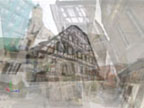
The Anti-Map
ANTIPODE/2 interweaves photography and cartographic process to reconstruct in virtual space the landscape of two cities juxtaposed within one another. This mapping process captures not only the structural pattern of the cities, but the events occurring at moments in time, progressing along the path taken by the photographer. This operates as an antithesis to the traditional cursory representation of maps. It occurs at the street level, recorded visually as seen by the eye of the observer and then viewed from the originating perspective; witnessing the flow of pedestrians and traffic, commerce and cultural activity. It is an "anti-map"...
ANTIPODE/2 was part of Segue/Überlappen, a collaborative exchange project between faculty and students of UMBC, Baltimore Maryland, USA, and Fachhochschule Schwabisch Hall, Germany, June 5-19, 2005.
Posted by jo at 03:06 PM | Comments (0)
September 22, 2005
PLAN Exhibition @ Futuresonic 06
![]()
Call for Proposals
The final exhibition and conference of PLAN - The Pervasive and Locative Arts Network will take place in Manchester during July 2006 as a part of the Futuresonic 2006 festival. PLAN is currently developing the scope and format of the exhibition, and the PLAN Technology Workshop in October will feed into this planning.
Advance Expressions of Interest: If you have a proposal for a new project that you would like to develop with PLAN to be included in the exhibition then please send an initial outline to us immediately, to arrive no later than Friday 7th October.
Open Call: If you have an existing project, or a project that will be completed before July 2006 without support from PLAN, the submission deadline is Friday 16th December.
About PLAN - The Pervasive and Locative Arts Network: The Pervasive and Locative Arts Network (PLAN) is an international and interdisciplinary research network funded as part of the Engineering and Physical Sciences Research Council (EPSRC) Culture and Creativity programme. The network aims to bring together practising artists, technology developers and ethnographers with the aim of advancing interdisciplinary understanding and building consortia for future collaborative projects.
Aims of the PLAN Exhibition: The PLAN Exhibition will showcase new concepts in pervasive and locative media, with a focus on large scale public experiences that communicate the possibilities and research challenges to a broad audience. The exhibition will form part of an art festival, but is anticipated to include social, political and scientific projects as well as projects where the aims are primarily aesthetic or about audience participation. Further details on the scope and focus of the exhibition will be available after the PLAN Technology Workshop during October.
How to Submit Expressions of Interest: Initial expressions of interest and proposals are invited for the PLAN exhibition that will take place in Manchester during July 2006 as a part of the Futuresonic 2006 festival.
Please send your proposal _by email_ to Hazel[at]cs.nott.ac.uk.
Supporting materials and a hard copy of the submission should also be
sent by post to:
Dr Hazel Glover
Equator Research Project Manager
School of Computer Science & IT
University of Nottingham
Jubilee Campus, Wollaton Road
Nottingham NG8 1BB
Tel: 0115 846 6780 Fax: 0115 846 6416
Advance Expressions of Interest: If you have a proposal for a new project that you would like to develop with PLAN to be included in the exhibition then please send an initial outline to us immediately, to arrive no later than Friday 7th October.
Open Call: If you have an existing project, or a project that will be completed before July 2006 without support from PLAN, the submission deadline is Friday 16th December.
PLAN EXHIBITION SUBMISSION FORM
About You
Your Name:
Address:
Telephone:
Mobile:
Email:
Website:
Short Biography or CV (150 Words):
About Your Project
Name of Project:
Brief Description of your Project (200 Words)
New or Existing Project
Is your project:
A An existing project
B A new project
If your project is new, please do you need support from PLAN to produce
the work?
A Yes
B No
Production Plan
Please provide a brief outline of how you plan to produce your new project. Please answer the following questions: How are you planning to do it? Who are the people involved and what will their responsibilities be? What is your production timeline?
Budget
Submit a short budget showing the costs associated with making your project. If you have funding sources for your project, please indicate this in your budget, stating if applied for or confirmed.
Examples of work
We would like to see examples of your past work. If you want to post examples of your work, please send them to:
Dr Hazel Glover
Equator Research Project Manager
School of Computer Science & IT
University of Nottingham
Jubilee Campus, Wollaton Road
Nottingham
Posted by jo at 07:14 AM | Comments (0)
September 21, 2005
In The Weather
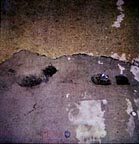
Self-Guided Walking Tours
A map of a walk records the memory of a singular experience. The map provides a route; when directions given by another are followed, the route becomes a path. Walking becomes an exploration of the city at once private and shared.Melinda Fries and Bonnie Fortune share an interest in exploratory walking and have collaborated as In The Weather since 2004. This year they published In the Weather self-guided walks/Chicago, which includes walking directions by 16 Chicagoans. The booklet is dispensed freely at 10 locations throughout Chicago.
In The Weather--included in in the current exhibition URBAN / RURAL / WILD--is seeking submissions to be included in an online database, intheweather.org, from which users may download Walking Directions. Walking Directions can be from/to any place and the walk can be of any length. Walking Directions can be given in writing, drawings, photographs, or other forms; maps are encouraged. To submit a set of Directions or to ask questions, please send email to: submit[at]intheweather.org. [via eyebeam reblog]
Posted by jo at 09:47 AM | Comments (0)
September 19, 2005
Digital Derive & Redefining the Basemap

Basemaps as Sites for Reinvention
Kazys Varnelis from the Annenberg's Networked Publics research lab forwarded me this link that he's found on Archinect. The Digital Derive project will be shown at the M-City exhibition (curator: Marco De Michelis) in Kunsthaus Graz, Oct 01, 2005 - Jan 08, 2006.
"Digital Derive harnesses the potential of mobile phones as an affordable, ready-made and ubiquitous medium that allows the city to be sensed and displayed in real-time as a complex, pulsating entity... Digital Derive (re)presents the city displayed simultaneously in the Kunsthaus Graz and in a publicly accessible website... The Real-Time City Map will register and visually render the volume and geographic source of cell phone usage in Graz, thus showing a different layer in the use and experience of the city. Furthermore the users of A1 Mobilkom Austria in Graz will be tracked anonymously by 'pinging' their cell phones as they move through the city. The record of this movement will be collected, processed and finally displayed as set of dynamic traces showing their paths through the city on the same map..."
The rendering of the peaks & valleys of cell phone usage here is reminscent of some oceanographic map of a deep sea trench, as if the city were drowned in a tsunami of spectrum (immersive media?).
As astonishing as this image is, the Digital Derive project arguably reproduces a static notion of urban space by using a conventional GIS overlay aesthetic. As Ali Sant notes in a text she has written about her Trace project, a collaboration with Ryan Shaw, entitled Redefining the Basemap:
"Current collaborative mapping projects using locative media technologies have often overlooked the conventions of the basemap as a site for reinvention. Although these projects imagine alternative organizations of urban space through the way it is digitally mapped, they remain bounded by datasets that reinforce a Cartesian and static notion of urban space."
Thus reading the Digital Derive through Ali, perhaps the next big step for locative projects interested in mapping how a space is actually practiced will be to deform the base map into a kind of cartogram of cell usage.
Here I consider those famous purple maps of the last US election as deeply inspirational. [blogged by marc tuters on USC Interactive Media] [Related]
Posted by jo at 12:23 PM | Comments (0)
The Hunt for Mr. X:
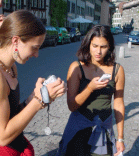
Bringing a Board Game to the Street
"Scotland Yard" is a popular board game in Europe, where players have to catch Mr. X. Mr. X moves hidden through the streets of London. He has to show his location every 4th turn. The detectives know which kind of transportation he uses. With this information they have to figure out his position and surround him. When the detectives catch him, they win, if Mr. X escapes he wins.
Bringing the game to the street: transformation into a live action game 4 groups with 4 players hunt Mr. X and Mr. Y in the old city of Berne. Hunting by MMS: Every ten minutes, Mr. X sends a picture of his current location. The detectives have to identify the position by the pictures and find Mr. X. They catch Mr. X by taking a picture of him." From "The Hunt for Mr. X: Bringing a Board Game to the Street [PPT] by Niklaus Moor (Swisscom Innovations). [via techkwondo] [Related]
Posted by jo at 11:51 AM | Comments (0)
CuteXdoom
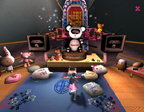
Society's Obsession with Fabricated Characters and All Things Cute
CuteXdoom is a mod for the PC game Unreal Tournament 2003 that explores society's obsession with fabricated characters and all things cute, or kawaii. The goal of CuteXdoom is to become a member of the toy worshipping Yumi-Co cult and gain access to their temple by collecting enough toys to present as an offering to the robotic panda guru. (This sort of exploration of society's addiction to cuteness reminds me of Satoshi Kon's compelling anime series Paranoia Agent, which can be seen in the U.S. on [adult swim].) Anyway anime referencing aside, CuteXdoom was created by Yumi-Co, a collective of game designers, illustrators, sound artists and coders that was founded by Anita Fontaine. She worked as the art director and designer for this project and currently works for the Mobile Digital Commons Network in Canada. She is also participating in the Toytakeova exhibit this fall in Australia. I really could go on and on, but I'll end it with this last plug: also check out some of the locative media projects she's worked on: Ghost Garden and Global Heart Rate. [blogged by Carol T Chung on Cool Hunting]
Posted by jo at 10:39 AM | Comments (0)
Trampoline

Final Call for Submissions
Trampoline is dedicated to the promotion of new technology art and artists and aims to present cutting edge art in an informal atmosphere; encouraging new artists to exhibit work to a real audience, whilst providing a platform for established artists working in new directions. Trampoline began life in 1997 as Nottingham's first ever platform event for new media art.
This one day/night event is based in Broadway Media Centre, the creative hub of Nottingham. The facilities/spaces which Broadway has to offer include: large lively bar/café space, a smaller bar space, foyer, cinema screens and projection onto the outside of the building.
In the two forthcoming events we hope to expand the reach of Trampoline, no longer restricting it to one venue but encouraging participating artists to explore the potential of public spaces around Nottingham too.
October Trampoline – in conjunction with PLAN. This Trampoline event will focus on locative and pervasive media. There will be an examination of how new media is entering the fabric of our everyday lives, installing itself into to every part of our environment, the new dimension of our reality, the dimension of data. Site will also be a particular concern, in order to investigate notions of locative and pervasive media more fully we would encourage artists not only to consider the space of Broadway cinema as the site for their proposed work but to also examine spaces beyond this, in particular public spaces around Nottingham. Extended Deadline for Submissions: September 23rd
1st December Trampoline – Opening event for Radiator Festival December’s Trampoline event will reflect the core concern of the Radiator Festival this year, the relationship between performance and new technology. How can the body and new media connect with each other? We are calling for work that not only investigates the relationship between the performer’s body and new technology but also the body of the viewer, the audience. Deadline for Submissions: November 7th
We encourage proposals of work in all formats, as long as they reflect upon elements of new media. Video, installation, performance, web art, computer programmes, music and more are all welcome. We would also like to encourage initiatives which give the Trampoline audience an insight into the workings of new media and an opportunity to develop their own small creative works, for example in the format of workshops/group activities.
If you have any queries please contact Emma Lewis, Trampoline Coordinator emma[at]trampoline.org.uk +44 (0)115 9559956
Download an application form, and send submission material to: Trampoline Submissions Broadway Cinema 14 - 18 Broad Street Nottingham NG1 3AL UK (include stamped addressed envelope if you wish your material to be returned).
Posted by jo at 09:54 AM | Comments (0)
September 18, 2005
Glowlab News
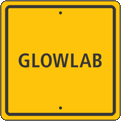
GLOWLAB.04 :: FORGOTTEN and more
GLOWLAB.04 :: FORGOTTEN--Our latest issue is now online, and features some great new projects by Glowlab and guest artists, including:
:: kanarinka--12 Inches of Weather; Weather experiments on the body :: Sharilyn Neidhardt --Into the Groove; Interview with musician and audio archivist Steve Espinola :: Emily Conrad--Lost Phone: 18,900 Google Entries; Lost phone in the back of New York City taxi. Last Friday, around 1am. It must happen all the time :: Sal Randolph--whereyouare; Join in documenting the endangered, lost, or ephemeral beauties of your neighborhood. whereyouare is a participatory experiment, mixing collaborative multimedia, folksonomy tags, and rss feeds to build a portrait of places that matter to us :: Holly Tavel--Xanadu Revisited; Two years on, Xanadu gives up the ghost.
With special guests: Leah Dilworth :: Lost and Found at the City Reliquary; Tour the City Reliquary, Brooklyn's store-front museum dedicated to civic pride and all around good neighborliness; Tianna Kennedy :: On Forgotten, Neglected, and Discarded Objects and Subsequent Utopian Projects Or, the Meandering Story of EV, which recounts the amusing first sally of the ingenious crew as they dragged a thing that had been forgotten from the Bronx to the Lavender Lake; Michele Gambetta :: The Rider Project 2005; The RIDER Project has been created by artists who rent a Ryder Company truck, retrofit it with walls, gallery lights, a generator for electricity, and create a mobile gallery to display art throughout N.Y.C.; Petr Kazil :: Urban Spooklights; Who wouldn't get excited by the appearance of a mysterious light in the distance - in a place where no light is expected?
Glowlab: Open Lab, curated by Christina Ray: A nine-week-long psychogeography festival and exhibition; October 14 through December 11.
Please join us this fall as we head up to Boston for our show at Art Interactive, a non-profit arts space dedicated to contemporary, experimental and participatory artwork.
In Fall 2005, Art Interactive is conducting a nine-week-long experiment. We have invited artists affiliated with Glowlab, a network of psychogeographers, to use the Central Square neighborhood as the site of their research and fill the exhibition space with the results of their investigations. PSYCHOGEOGRAPHY, a term coined by the Situationist International in the 1950s and appropriated by contemporary artists, is used to describe projects that produce affect in relation to the geographic environment. Rather than making maps in the traditional geographic sense, these artists utilize maps and geography to conduct located experiments with (among other things) people, trash, bikes, clothes, the sky and the gallery space itself. Often making use of mobile technologies and existing in the hybrid spaces of the Internet and the physical world, their projects produce new understandings of location and identity as shifting, fluid, singular and irreducible.
Central Square, Cambridge, MA, will never be the same again. Join us for nine weeks of public walks, talks, tours, workshops, concerts, group bike rides, and other ways of exploring the Central Square neighborhood. Each weekend of the festival, different Glowlab artists will be present to lead participatory public events inside and outside the Art Interactive space. Visit the online schedule at http://www.artinteractive.org/calendar for more details about upcoming events or email info[at]artinteractive.org.
Opening Reception: Friday, October 14th, 2005, 6 - 9pm
Gallery Hours & Location: Art Interactive is open Saturdays and Sundays from 12 - 6pm or by appointment. The gallery is located at 130 Bishop Allen Drive, at the corner of Prospect Street in Cambridge, MA. For more information, please contact info@artinteractive.org, call 617-498-0100 or fax 617-498-0019. Press release with downloadable press kit:
http://www.artinteractive.org/shows/glowlab/glowlab_press.html
Posted by jo at 10:21 AM | Comments (0)
September 16, 2005
Grand Finale_Yellow Arrow:
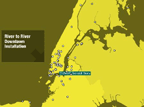
The Secret New York
Yellow Arrow: The Secret New York is a public art project that celebrates the extraordinary details of the city that often pass unnoticed. Upon encountering a Yellow Arrow, the public participates by calling 212.201.2005 from mobile phones to hear an audio message that tells a secret story about the location where the arrow points.
This Saturday marks the Grand Finale with 20 Yellow Arrow sculptures visible across Manhattan and Brooklyn from 12-8 pm, at places like: Union Square, Chinatown, The Lower East Side, East Village, Lower Manhattan, Williamsburg and DUMBO. This is is a fantastic opportunity for people to experience some of the most compelling content of the summer in one single day.
Over the summer the project has touched a lot of people in all 5 boroughs and there are some very fun stories about bringing it all together. Creators of the project will be leading two behind-the-scenes tours to share these anecdotes and insights. Tour 1_Lower Manhattan meets at Battery Park at 12 pm and will visit 5 nearby Yellow Arrows. Tour 2_East Village meets at corner of Ave. B and E. 7th St. at 6:00 pm and will visit 6 Yellow Arrows, grab dinner in the area and head to the after-party.
The day-long installation and tours will be followed by a celebration at the Lotus Lounge (35 Clinton St at Stanton), with drink specials, video projection and a sound installation on the street.
Grand Finale, Downtown Manhattan, Williamsburg and DUMBO; 12-8 pm; Full map available.
Tours:
Tour 1_Lower Manhattan 12 pm at Battery Park
Tour 2_East Village 6 pm at corner of Ave. B and E. 7th St
Grand Finale Party--Lotus Lounge, 35 Clinton Street at Stanton, Lower East Side, Manhattan.
Posted by jo at 10:22 AM | Comments (0)
September 15, 2005
MOBILE MUSIC TECHNOLOGY
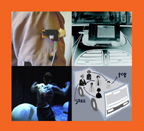
New Forms
THIRD INTERNATIONAL WORKSHOP ON MOBILE MUSIC TECHNOLOGY, 2-3 MARCH 2006, BRIGHTON, UK.
Combining mobile technology and music promises exciting future developments in a rapidly emerging field. Devices such as mobile phones, walkmans and iPods have already brought music to the ever-changing social and geographic locations of their users and reshaped their experience of the urban landscape. With new properties such as ad hoc networking, Internet connection, and context-awareness, mobile music technology offers countless new artistic, commercial and socio-cultural opportunities for music creation, listening and sharing. How can we push forward the already successful combination of music and mobile technology? What new forms of interaction with music lie ahead, as locative media and music use merge into new forms of everyday experiences?
Following two successful workshops that started to explore and establish the emerging field of mobile music technology, this third edition offers a unique opportunity to participate in the development of mobile music and hands-on experience of the latest cutting-edge technology. The programme will consist of presentations from invited speakers, in-depth discussions about the crucial issues of mobile music technology, hands-on group activities and break-out sessions where participants can get valuable feedback on their work-inprogress projects. The invited speakers include Michael Bull (University of Sussex, UK), often dubbed by the press as 'Professor iPod' for his iPod and car stereo user studies that reveal fascinating trends for mobile music.
The workshop will take place at the University of Sussex in Brighton, UK. Brighton is situated on the British 'Sunshine Coast' and easily accessible: only 30 minutes from London/Gatwick airport and 60 minutes from central London.
Don't miss this chance to help shape the mobile music landscape of the future!
CALL FOR PARTICIPANTS
We invite practitioners, artists, designers and researchers from all areas, including music, technology development, new media, sound-art, music distribution, locative media and industry to register for this international mobile music workshop.
CALL FOR WORK-IN-PROGRESS
Are you working on a mobile music project and looking for feedback from like-minded people to help you to move on with your ideas? We invite submissions of work-in-progress projects exploring the topic of mobile music. Projects will be discussed, receive critical review as well as support with ongoing problems and issues. Your work should not be completed yet, but either be on-going or just about to get started. Potential projects could include but are not limited to mobile music systems or enabling technologies, interface design, on-going or planned user studies, ethnographic fieldwork, art pieces and other areas relevant to mobile music.
Submissions should include a presentation of the project, explain its relevance to the field of mobile music and describe issues and problems that could be discussed during the workshop. Please include a short biography with the submission. Accepted project authors will be given time to present and discuss their work and will receive feedback by smaller groups of workshop participants including specialists in the field. Authors are encouraged to bring material and prototypes to the workshop.
CALL FOR MOBILE PLATFORMS AND SYSTEMS
In addition to the presentations, discussions and project feedback sessions the workshop will also offer handson group activities to explore technological platforms. We are looking for mobile platforms, systems, installations, applications or devices that include music features or can be used for musical projects. The workshop participants will get hands-on experience with these platforms, so they should be suitable for groups of at least 8 people. This provides you with the opportunity to introduce your platform to experts and practitioners in the field of mobile music and to gain valuable feedback. We invite you to submit a platform description, explain how it can be used for mobile music and how larger groups can use it during the workshop.
Details are here.
Posted by jo at 10:33 AM | Comments (0)
September 14, 2005
MOBILE CARTOGRAPHIC COMMAND CENTRE (MC3)

Collaborative Cartography and Unlicensed Wireless Communication
The MC3 is a mobile, educational installation that converges all geo-annotation data being produced by the MDCN’s projects into a single location, visually constructing a continually evolving cartographic model of the MDCN. The MC3 is an outreach project that disseminates the Network's research to the public “on the street” via a large, mobile truck or semi-permanent installation. As well as visualizing the MDCN’s cartographic data, MC3 transfers and repurposes vast databases of digital information from the "expert user" field of GIS to the emerging field of “locative media,” thereby making “inaccessible” data accessible via the Montreal and Banff networks as well as online through the MDCN website. Movie.
Posted by jo at 10:47 AM | Comments (0)
Space Invader

Urban Invasion
Anonymous French street artist Space Invader makes mosaics from the eponymous video game, which he puts up in public spaces of his victim city. His Invasions are part of a global project. Each attack is complemented by a map of the city showing all the target sites. The most recent invasion occured in Bangkok.
"...Currently the computer icon has led us to rediscover the prehistoric form of communication - the hieroglyph - through the use of icons in the extended landscape of the net, communication platforms, games, and their new iconology or visual vocabulary that has risen through the development of software programs. Andy Deck's, Gylphiti and Space Invader's Invasions create a context with graffiti that appropriates private space. Similar to graffiti, the hieroglyph writer marks on the subway and temple walls. Andy Deck's Glyphiti, is a multi-user collaborative drawing platform calling on the spirit of graffiti is a site specific project using code that filters through private sectors of the net, creating a public domain and a collaborative drawing space that recall the uses of prehistoric hieroglyphs with pixels replacing the mark, to create a real-time icon.
In Space Invader's invasion the attack is addressed in the public domain where the Space Invaders' mosaics lurk the cityscape, and the players are anonymous. Space Invader and Deck introduce the cross-pollination of new media, as the closest notion to public art production by depicting a position of narrative from the maker to the public space-whether it be the streets or the net-continually questioning the definition of PUBLIC. Space Invader uses the aesthetics of a Byzantine iconographer as an instrument through which a work is executed, a work that goes beyond the individual..." From Copy It, Steal It, Share It by Michele Thursz. [via]
Posted by jo at 09:00 AM | Comments (0)
Superstar Tokyo
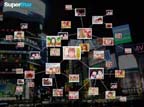
Who's Photographing Whom?
Superstar is a multiplayer photo-based game designed for Ubicomp 2005, Tokyo. The game is free, and open for anyone with a phonecam and self-portrait Puri Kura stickers of themselves. The game uses Japanese Puri Kura stickers as a starting point for an experiment in social networks, automated phonecam image analysis, and urban visual culture. The goal is to see and be seen, using tiny images woven into the fabric of Tokyo streetlife.
To play, place your own stickers (with a star on it to recognize participants) wherever you want and collect the stickers of other players by shooting them with your phonecam. Whenever a player snaps a Superstar sticker both players earn points. A link is then created between the two players. From this point on, any time either player earns points (by shooting a new sticker or by having their sticker shot) the other one will also earn points (though not as many).
Superstar thus builds a network of connections that forms a social, pyramid scheme. Successful players will be the ones that forge connections with other active players. Automated image recognition (e.g. Mobot technology) will decipher who is photographing whom when players email their images to SuperstarHQ via their phonecam. A message is returned via SMS indicating points earned.
Developed by Frank Lantz, Kevin Slavin (areacode) together with Kamida (makers of Socialight), Michael Sharon and Dan Mellinger (Kamida). Details in the PDF. [blogged by Regine on we-make-money-not]
Posted by jo at 08:35 AM | Comments (0)
September 13, 2005
Cellphonia: In The News

A Locative-Based Karaoke Opera
Cellphonia: In The News is a locative-based karaoke opera cued and performed by the cell phone with lyrics daily RSS newsfeeds which generate both the score and moving images, available anytime anywhere small groups gather, and also allowing outside users to contribute as a remote chorus.
Cellphonia is an open source cell phone and Internet application that creates a street theater live opera via a conference call shared by user/participants. A server coordinates the instant RSS Newsfeed libretto that is transmitted as text to each of the participant. The server queries the cell phones of the participants to determine each phones capability. In this way the server can make a scalable set of media that takes maximum advantage of each participants phone, allowing a large number of cellphone users to participate anytime anywhere.
The daily newsfeed and the location of each phone algorithmically generates music and a libretto that the participants sing, karaoke style. By using robust tried and true multiline conference call technology, a sophisticated and interactive score can generate cues and musical interludes that lead each singer through the piece. Additionally, using SMS, WAP and various other ubiquitous text formats the libretto with ongoing visual cues are "pushed" to each user. In this way the location, time of day, and news all converge to create a unique and ever changing social experience.
Primary Artist: Steve Bull
Collaborator: Scot Gresham-Lancaster, Composer
Grant Administration: Harvestworks
Related: A Phone is a Phone is a… by Molly Kleiman, NY ARTS.
Cutlass: Connecting the Real World to the Virtual.
Posted by jo at 12:12 PM | Comments (0)
September 12, 2005
Map-o-matix
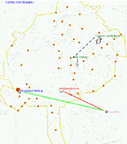
Collaborative Mapmaking
Map-o-matix--by Yves Degoyon, Sergio Moreno, Jaume Nualart and others--is a collaborative environment for creating and editing maps, the maps can contain physical elements (oil resources, telecomunication antennas...) as well as abstract ones (human organisations, web sites, rss, ... ) and relations between these entities. Behind this tool is the idea of editing and publishing tactical maps, maps that are not only physical but also the maps of control structures and of localized social infrastructures. [via]
Posted by jo at 10:49 AM | Comments (0)
September 09, 2005
The Urban Lottery:

A Game to Think Through the City
"The game consists of a journey through a series of images, concepts and words that have different meanings for contemporary urban residents. For women, for example, everyday life in the city is a very different experience than it is for men. The gaze of a person who walks through city streets on his or her way to a factory job is different than that of a person who contemplates them from an office in a downtown skyscraper, or who looks out in fear across the heavily fortified fences that protect his or her private space.
The Urban Lottery invites you on a never-ending adventure-to think through the city and to think about yourself in relation to the city that you inhabit. It does not matter what city you live in. What matters are the ways in which you explore, discover and understand that city and your relationship to it. Most important, however, are the ways in which you become involved and participate in building a better, more democratic city in which there is room for all." Part of Translocal Flows: Migrations and Contested Urban Spaces in the Americas. [Posted by Anne on space and culture]
Posted by jo at 02:42 PM | Comments (0)
September 06, 2005
WatchMe
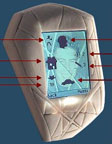
Communication Between Closely-Knit Group
WatchMe, by Natalia Marmasse, and Chris Schmandt, will be a platform for mobile communication and awareness, in the form of a watch, which addresses these limitations.
WatchMe enhances communication for a subset of people with whom we want an open channel of rich communication and for whom we want to be available. These are typically people from our "inner circle" with whom we have an established relationship, some common grounding, and a basis of trust. By sharing personal context information with our "insiders" we can enhance the instances of non co-located communication, and by providing channels of non-verbal communication we can foster more (verbal or non-verbal) communication and increase the existing sense of connectedness. The approach is to provide insiders with updated remote awareness information.
This mutual awareness serves two different purposes. First, it can strengthen the sense of presence of people we care about and may encourage further communication, besides being a form of non-verbal communication in itself. Second, it will provide insiders trying to contact us with enough information to make an informed decision regarding our availability and the most appropriate communication medium.
This project addresses mobile communication and awareness of people in a closely-knit group. It aims to enhance the telecommunication between them by providing relevant telepresence and a mobile platform facilitating various channels of verbal and non-verbal communication. Related: RealPlayer Movie; MPG Movie; UbiComp Paper (pdf).
Posted by jo at 10:08 AM | Comments (0)
September 02, 2005
URBANtells
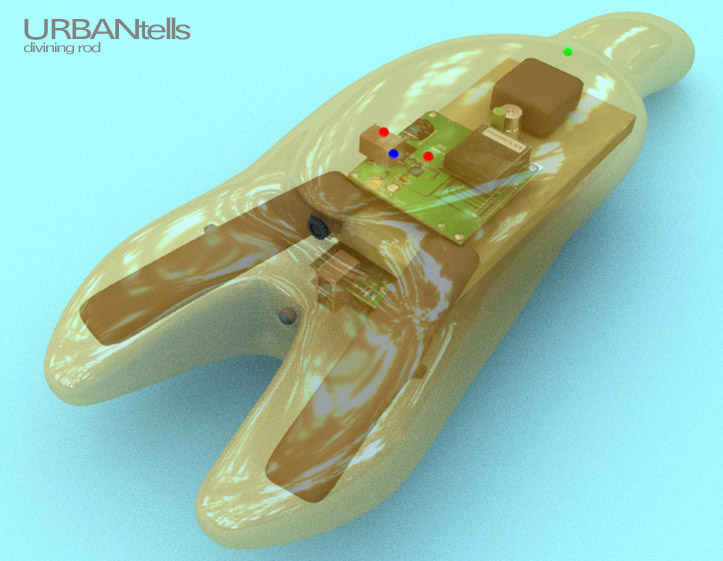
Exploring the City with Digi-Diviner
URBANtells is a mobile sound installation in which the user explores a neighborhood on foot, "data-diving" with a handheld device called digi-diviner. Participants will provide their cell phone and email address to an attendant at a kiosk. In return, they will be given a digi-diviner to walk and explore the neighborhood. A minute or so after they go outside a real time mix of sound art and verbal information triggered by their location will start to play through an earbud attached to the diviner. The information is a mix of recordings of residents and historians, text-to-speech synthesis, recitations, musique, and other processed sound. The information will address the complex layers of personal and collective histories and experience in urban environments, and the degrees to which these acoustic "tells" influence behavior and development within a community similarly to traditional, physical structures.
Users will be able to upload sounds, text, and still images they capture with the diviner en route. This information will be available to other users. Upon returning to the kiosk, participants will receive an interactive Google map of their specific walk via email, containing buttons to play sounds and view images they may have uploaded during their trip. Urbantells, a project by James Rouvelle, Joe Reinsel and Steve Bradley, opens June 2, ‘06 at Art Interactive, Cambridge, MA. [blogged by Regine on we-make-money-not]
Posted by jo at 08:30 AM | Comments (0)
September 01, 2005
Miragraphy

RFID Enabled Mirror
Hitachi announced yesterday a new mirror that functions as a computer display. It will be available for purchase in Japan on September 30. It combines a half mirror and a diffusion film to directly display digital information (text, photos, video, tv shows, websites, flash movies etc.) on a mirror surface using a LCD projector. This technology, called Miragraphy, also integrates sensors, RFID readers, barcode readers, cameras, etc. So, the mirror can automatically respond when people are around and personalize digital contents based on their sensed identities.
The Miragraphy device could potentially be used at restaurants, bars, hotels, trainstations, airports, sports clubs, show windows, designer clothing shops, and accessory shops. [blogged by konomi on RFID Japan]
Posted by jo at 10:38 AM | Comments (0)
August 31, 2005
Readers for "Mobtagging DisCourse" and "Triggered by RFID" at Mediamatic
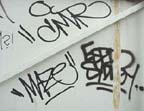
Theory, Projects, Criticism, Resources
Reader for Mobtagging DisCourse: Mobtagging is the practice of a large group of users who freely apply and exchange tags (metadata) to a set of unstructured online information. The aim is to describe content more adequately, personally or pinpoint interesting information faster than a search engine or online directories. Mob – or Social tagging can provide more precise search results for specialized interests and as such is a form of Commons Based Peer Production (CBPP).

Reader for Triggered by RFID: Radio frequency identification is a technology that is now situated in the elevator of technical development. A growing number of logistical companies see the advantages and possibilities of RFID for managing large bodies of objects. But what uses can this technology be applied to that are not in the logistical realm? How can it serve and/or change society and human interaction? How does it change the concept of information and information networks as we know them today? This reader compiles a number of resources on the technical and philosophical aspects of RFID.
Posted by jo at 07:17 AM | Comments (0)
August 29, 2005
denCity.net
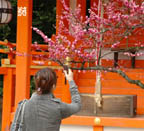
Virtual Networks of Real Places
denCity.net--by Kai Kasugai und Philipp Hoppe--examines the enrichment of real urban sites by a virtual dimension of information and networking, being accomplished by localisation of the virtual. It is about moderating between "virtual reality"-networks and the city as physical existence. Places and objects of the city get a virtual identification in the form of a QR(bar)-code. This code contains - in digitally readable form - the most important information of the respective location: its tag-ID and GPS-coordinates. Shot and decoded on the fly using a common camera-cellphone, through the tags one connects to the dataweb, which consists of site-specific information.
denCity.net provides information to the specific place. From there, you can browse through the web of tags. The tag is the key. Once shot, you can always return to the places, virtually. It's the city in your pocket. Anyone can tag places and thus create a new denCity-site. Just log in to denCity.net - create a spot on the map and print the tag to attach it to the real-world location.
One could think of the most different kinds of content. Public an commercial tags for example basically contain information of opening hours, offers, events etc.; they form a dense map of the city's service- and supply-infrastructure. In terms of organisation, denCity.net develops a hybrid structure between the functional mixture in the real urban space on the one hand and the associative zoning / grouping of topics in the dataweb on the other. A contracion of space ist generated, places move closer and build a functionally denser texture. Private tags, in contrast, contain matters of rather informal kind. Everyone can create and attend them, for instance "spots" (virtually anyone can create new spaces by creating a tag at site, thus giving it character/properties/information) which emerge at street corners or trees and mean a personal reference to an urban place. These tags are virtual forums in the actual cityscape and live of comments of passerbies and interested.
denCity.net is a map-based database-system. It links information (on the "virtual" level) and in doing this considers the locality of the tags (on the "real", urban level). All relevant information and data links concerning the particular user-request are released cartographically and depend on the desired degree of locality.
This information exchange layer, through the tags's crosslinkings and referencing among each other, features a multidimensionality which oscillates between the local and the virtual. The tags are digital yet visible marks in the city, at the same time virtual and physical addresses. They establish interfaces between locality and virtuality.
dencity.net not only ties a dense net of information but also directly affects the urban density because of the information beeing site specific. Informational and actual density are strongly interdependent. Fluctuations of density are immediately documented, trends become noticeable much earlier. Through this, flexible planning and interaction is made possible, which for instance facilitates reaction to shrinking processes (mentioned in a recently published spacial planning report (Raumordnungsbericht 2005) of the "German federal office for building and regional planning" (Bundesamt für Bauwesen und Raumordnung). Furthermore, it has to be mentioned, denCity is an emergent system, which could fundamentally question or at least amend urban planning methods. In this context also consider the current debate on "governance" and the "shrinking cities"-design competition.
This internet presence of denCity is a demo version, that simultaneously serves for development as for presentation of the project. The final user interface will principally be the mobile phone, on which all functions are available. The decipherment of a QR-code via a mobile camera phone is a already a common technology in Japan, mainly used in the shopping sector. Through the WAP-compatibility of denCity.net, ie. the direct access on tag information via mobile phone, we intend to demonstrate how the future utilisation will feel like.
denCity.net is an experiment concerning the territorialisation of the virtual and the deterritorialisation of the physical, en route to an augmented perception of urban reality and density. It's about "density", "city", about "den" (which in japanese means "electronic"), and about "nets"...
Posted by jo at 11:38 AM | Comments (0)
August 24, 2005
Node Explorer

It Knows Where You Are
"This tiny electronic prototype, called an Node Explorer, detects exactly where I’m standing within the 850-acre parkland surrounding Ashton Court, because it’s equipped with an internal Global Positioning System (GPS) based on satellite signals, accurate to within about three yards.
On screen, I see myself as a little red dot moving slowly over the grass. Depending on where I wander, an entirely different heritage or cultural story is presented through a combination of pictures, sound effects and narrative, all related to where I’m standing and what I’m looking at.
I walk to the bottom of the lawn. Ping! With the sweeping façade of Ashton Court spread like a film set, the screen shows me how the building has changed over the centuries, images building upon images as a voiceover explains why the place looks as it does now.
The tone of the script is light, brief but serious - a cross between Radios 2 and 4. (Later, I discover that the material has been written by an ex-BBC producer and narrated by a local radio presenter.)
I move 50 feet towards some flowerbeds and… ping! I’m urged to look up at the fourth window from the left where the 19th-century stunner Emily Smythe - “the most beautiful woman in the West of England!” - once gazed from her bedroom at the rural landscape stretching to the city. The screen shows me her picture. It tells me that men used to swoon at the sight of her. It shows me her bedroom. I walk to the front of the building. Ping! I learn that the writer CS Lewis was a patient here during the First World War, when this became a military hospital." [via It knows where you are... and pasta and vinegar]
Posted by jo at 10:36 AM | Comments (0)
Node Explorer

It Knows Where You Are
"This tiny electronic prototype, called an Node Explorer, detects exactly where I’m standing within the 850-acre parkland surrounding Ashton Court, because it’s equipped with an internal Global Positioning System (GPS) based on satellite signals, accurate to within about three yards.
On screen, I see myself as a little red dot moving slowly over the grass. Depending on where I wander, an entirely different heritage or cultural story is presented through a combination of pictures, sound effects and narrative, all related to where I’m standing and what I’m looking at.
I walk to the bottom of the lawn. Ping! With the sweeping façade of Ashton Court spread like a film set, the screen shows me how the building has changed over the centuries, images building upon images as a voiceover explains why the place looks as it does now.
The tone of the script is light, brief but serious - a cross between Radios 2 and 4. (Later, I discover that the material has been written by an ex-BBC producer and narrated by a local radio presenter.)
I move 50 feet towards some flowerbeds and… ping! I’m urged to look up at the fourth window from the left where the 19th-century stunner Emily Smythe - “the most beautiful woman in the West of England!” - once gazed from her bedroom at the rural landscape stretching to the city. The screen shows me her picture. It tells me that men used to swoon at the sight of her. It shows me her bedroom. I walk to the front of the building. Ping! I learn that the writer CS Lewis was a patient here during the First World War, when this became a military hospital." [via It knows where you are... and pasta and vinegar]
Posted by jo at 10:36 AM | Comments (0)
August 22, 2005
Masaki Fujihata
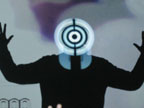
Innovative Public-Led Expedition
bodydataspace (b>d>s) have created a Multi-Media Design Studio with 3-D Exhibition Space for the newly renovated Jaywick Martello Tower. The premiere exhibition for the inaugural opening will be Mersea Circles by Masaki Fujihata. It is a 3-D interactive installation that emerged from an innovative public-led documentation process in August 2003. Taking place on Mersea Island, just off the Essex coast, some 150 people participated all using DV cameras and GPS. As they explored the terrain and its people they captured, with position data, their discoveries and experiences of the landscape, talks and interviews. From the myriad of data gathered, internationally renowned artist, Masaki Fujihata created his latest work.
In addition to the above exhibition, the event on Saturday, 17th September will include a live performance of Soft Ices by artist Mark Storor and composer Jules Maxwell at 3pm. There will also be a site-specific exhibition from the photographer John Kippin.
[b>d>s] is a design unit that delivers artist-led projects into architectural applications and uses interactive technologies to enable people to learn, develop and extend within intelligent data spaces, ultimately enabling the public to have a direct impact on the content of the space they inhabit. It combines the specialist knowledge and creative direction of its founders Ghislaine Boddington (body technology artist) and Armand Terruli (architect/video artist) in a unique collaboration that explores the artistic and technical opportunities present in the fusion of body, data, and space.
Masaki Fujihata / Mersea Circles / COAST: Masaki Fujihata is one of nine artists who have produced artworks for COAST, Essex County County’s ambitious art project celebrating the Essex coast. Mersea Circles is housed permanently at the Jaywick Martello Tower as well as the Ars Electronica Museum in Linz.
Saturday, 17th September 2005
12.30-3pm (invite only)
3-6pm (open to public)
Jaywick Martello Tower, Jaywick,
Clacton-On-Sea, Essex CO15 2LF
Entrance is FREE
Jaywick Martello Tower is the latest digital arts venue to open in the UK and one of the most unusual. This heritage project has transformed the Napoleonic tower’s first floor into a state-of-the-art environment where b>d>s have created a multi-media studio for exhibitions, events and workshops. It includes a floor to ceiling curved projection screen for immersive three-dimensional and audio-visual installations. This unique tower will act as a national resource for commissioning and presenting digital art from regional, national and well-known international artists.
The venue is the accomplished result of a 3-year collaborative venture between Essex Council, Bishops Park College and bodydataspace bringing together the arts, community and education. The Jaywick Martello Tower is managed by Bishops Park College, one of the brand new pioneering schools built under the Labour Government.
DIGITAL ARTS VENUE OPENS
Saturday, 17th September 2005
12.30-3pm (invite only)
3-6pm (open to public)
Jaywick Martello Tower, Jaywick,
Clacton-On-Sea, Essex CO15 2LF
bodydataspace (b>d>s) have created a Multi-Media Design Studio with 3-D Exhibition Space for the newly renovated Jaywick Martello Tower, featuring the work of international Japanese artist Masaki Fujihata.
Jaywick Martello Tower is the latest digital arts venue to open in the UK and one of the most unusual. This heritage project has transformed the Napoleonic tower’s first floor into a state-of-the-art environment where b>d>s have created a multi-media studio for exhibitions, events and workshops. It includes a floor to ceiling curved projection screen for immersive three-dimensional and audio-visual installations. This unique tower will act as a national resource for commissioning and presenting digital art from regional, national and well-known international artists.
The venue is the accomplished result of a 3-year collaborative venture between Essex Council, Bishops Park College and bodydataspace bringing together the arts, community and education. The Jaywick Martello Tower is managed by Bishops Park College, one of the brand new pioneering schools built under the Labour Government.
The premiere exhibition for the inaugural opening will be Mersea Circles by Masaki Fujihata. It is a 3-D interactive installation that emerged from an innovative public-led documentation process in August 2003. Taking place on Mersea Island, just off the Essex coast, some 150 people participated all using DV cameras and GPS. As they explored the terrain and its people they captured, with position data, their discoveries and experiences of the landscape, talks and interviews. From the myriad of data gathered, internationally renowned artist, Masaki Fujihata created his latest work.
In addition to the above exhibition, the event on Saturday, 17th September will include a live performance of Soft Ices by artist Mark Storor and composer Jules Maxwell at 3pm. There will also be a site-specific exhibition from the photographer John Kippin.
Entrance is FREE.
For b>d>s Press Invites, additional INFO and IMAGES contact Jamie McLaren:
Tel: 07949 111 871 or 020 7357 0823 / Email: jamie@bodydataspace.net
Partners of the renovation project include Essex County Council, the Heritage Lottery Fund, European Union through the Intereg IIIB programme, English Heritage, the Essex Rural Renaissance Fund, Essex Environment Trust, Park Resorts, EEDA and Tendering District Council.
NOTES TO EDITORS:
bodydataspace
b>d>s is a design unit that delivers artist-led projects into architectural applications and uses interactive technologies to enable people to learn, develop and extend within intelligent data spaces, ultimately enabling the public to have a direct impact on the content of the space they inhabit.
b>d>s combines the specialist knowledge and creative direction of its founders Ghislaine Boddington (body technology artist) and Armand Terruli (architect / video artist) in a unique collaboration that explores the artistic and technical opportunities present in the fusion of body, data, and space.
Masaki Fujihata / Mersea Circles / COAST
Masaki Fujihata is one of nine artists who have produced artworks for ‘COAST’, Essex County County’s ambitious art project celebrating the Essex coast. To find out more about the COAST project go to http://www.coastart.org
Mersea Circles is housed permanently at the Jaywick Martello Tower as well as the Ars Electronica Museum in Linz.
Managed by the local secondary school, Bishops Park College, it is planned that the Jaywick Martello Tower will be a catalyst for change, developing digital vocational skills. It will provide inspiration for the local community and attract interest and visitors from around the country and overseas to this unique location.
The site provides public access during the summer for environmental and historical groups, schools, tourists, walkers and visitors from overseas.
A permanent on the ground floor for a series of specially-commissioned permanent artworks by artist John Kippin on the theme of Essex coastal landscapes and the history of its military installations, linked with sites abroad.
A base for community arts projects with links to local schools.
Observation facilities on the on the roof, including a purpose-built look-out station, to be used by the National Coastwatch Institute (NCI). Visitors will also be able to use this facility.
The National Coastwatch Institute is a charity run by volunteers (principally retired people), who provide a visual watch to back up HM Coastguard.
European Interreg is a trans-European body which supports and finances international cross-border projects to achieve balanced regional development.
For information on the centre including the performance event Soft Ices and the work of John Kippin, contact: Keith Watson, Digital Arts Development Officer (c/o Bishops Park College):
Tel: 07802 748 484 / Email: mailto:keith@deluxe-arts.org.uk
Bishops Park College is not so much a school in the community but the community in a school with public library, family support day centre, cyber café, early year’s office and a purpose built neighbourhood nursery. The idea of community was a guiding principle in the overall design of the school, funded by the Private Finance Initiative.
The Head Teacher is Mike Davies.
LINK to Guardian Unlimited Feature on Bishops Park College: http://education.guardian.co.uk/egweekly/story/0,5500,1510479,00.html
Posted by jo at 09:14 AM | Comments (0)
August 18, 2005
Psychnology

How Space Affords Socio-Cognitive Processes during Collaboration
"ABSTRACT: This paper reviews the literature about social and cognitive functions of spatial features used when collaborating in both physical and virtual settings. Those concepts come from various fields like social, cognitive as well as environmental psychology or CSCW (Computer Supported Collaborative Work). We briefly summarize the social and cognitive affordances of spatial features like distance, proxemics, co-presence, visibility or activity in the context of physical and virtual space. This review aims at grounding in an explicit framework the way human beings use space to support social interactions. This review can be used as a starting point to design efficient applications that take spatial context into account." From A Review of How Space Affords Socio-Cognitive Processes during Collaboration by Nicolas Nova, Space, Place & Technology: Presence in Mediated Experiences (#2),
Psychnology.
Posted by jo at 06:49 PM | Comments (0)
Location-Based Gaming

Industry Does Not Understand Location Technologies
In a Mobile Games Analysis, Kurt Uhlir says that the industry has still many false impressions about LBG. They must understand the complexities, strengths, and weaknesses of location technologies. They need to move past the “all or nothing” belief. Each positioning technology (GPS, WiFi, GSM, …) has its own complexity that is mainly underestimated by developers and publishers. The difficulties involve with integrating spatial data, and the accuracy that are needed in various games situations. When designing games, writing storylines and setting expectations, the industry must think about how accurate the average location will be, how often the player’s location can be updated, how the game will deal with the occasional inaccurate location reading and what the benefits are ton incorporating location into game play. [blogged by fabien on 7.5th Floor]
Posted by jo at 06:26 PM | Comments (0)
August 16, 2005
TECHSTYLE NEWS: Issue #52 - August 15, 2005
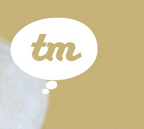
Next Generation Mobile Technology
Techstyle News is a free monthly newsletter providing summaries and commentaries on stories related to the next generation of mobile technology and style, produced by Thinking Materials.
In this issue: (1) Hardwear News: Motorola and Oakley announce cellphone sunglasses; Texas Instruments launches mobile single-chip solution; MP3 sunglasses from Global American Technologies; Digital locket from Beatsounds; Digital picture pendant from Spectare; (2) Softwear News: IBM software lets you carry your PC around your neck; and (3) Events: Mobicom 2005 in Cologne; Ubicomp 2005 in Tokyo; Wearable Futures in Newport.
HARDWEAR NEWS
MOTOROLA AND OAKLEY ANNOUNCE CELLPHONE SUNGLASSES
Motorola and Oakley has announced the expected availability of RAZRWIRE Bluetooth eyewear in early August. The Bluetooth module is designed to complement the overall look of the sunglasses, creating truly wearable technology. The controls include two volume buttons and a single button used to handle incoming and outgoing calls. RAZRWIRE allows you to carry on phone conversations while up to 30 feet away from your compatible Bluetooth-enabled cell phone. Bluetooth Sniff Mode technology increases the battery life of RAZRWIRE, offering continuous talk time of more than five hours and standby time of up to approximately 100 hours.
http://oakley.com/about/razrwire/
TEXAS INSTRUMENTS LAUNCHES MOBILE SINGLE-CHIP SOLUTION
TEXAS Instruments has announced the launch of its single-chip mobile solution. Manufacturers such as Nokia, Motorola, and Ericsson are expected to launch handsets based on the solution in nine months. Mr Tom Engibous, Chairman, said: "The single-chip solution will bring down power and space consumption by 50 per cent and cut costs by 30 per cent". With this, he said, there is the possibility of $20 cell phones on the horizon. The small chips can be easily integrated, bringing phone technology to all kinds of products.
http://news.com.com/Is+a+20+cell+phone+on+the+horizon/2100-1039_3-5823239.html
MP3 SUNGLASSES FROM GLOBAL AMERICAN TECHNOLOGIES
Global American Technologies have launched the Fio MP3 sunglasses. The retail prices are $200 to $400 at storage capacities of 128MB up to 1GB, include 3D stereo sound earbuds in each arm, support MP3/WMA/ADCPM and have a reported battery life of 8.5 hours. Transfer is via USB 2.0 to either a Mac or a PC, with an integrated microphone providing digital voice recording capabilities.
http://www.techtree.com/techtree/jsp/article.jsp?article_id=5284&cat_id=505
DIGITAL LOCKET FROM BEATSOUNDS
The Digital Locket EMP-Z II Plus from BeatSounds tries to be more than just a wearable MP3 player. This tiny music player has a small, oval color screen that can display a photo. The Digital Locket measures 2 inches by 1.8 inches, weighs 0.9 ounce and has a battery that lasts up to 16 hours before it needs recharging. It can play digital audio files in the MP3 or Windows Media audio formats and comes with its own software for transferring photos and music from a computer over a USB connection. An FM radio tuner and a voice recorder are also tucked inside. Prices start at $80 for the 256-megabyte version and go up to $150 for the model with a full gigabyte of memory.
http://beatsounds.com/Pb/index.asp?CurrentCatID=C1035889862578133
DIGITAL PICTURE PENDANT FROM SPECTARE
The Pixi Digital Picture Pendant is a necklace with a 1-inch, 96 x 64 pixel LCD screen and enough memory (512 KB) for storing up to 54 extremely low-res digital photos. For viewing up to 2 hours in slideshow mode, or longer in manual mode. The pendant is USB 1.1 compatible and compatible with photos in JPEG format.
http://chipchick.blogs.com/chip_chick/2005/08/pixi_digital_pi.html
SOFTWEAR NEWS
IBM SOFTWARE LETS YOU CARRY YOUR PC AROUND YOUR NECK
Researchers at IBM are testing software that would let you tote your home or office desktop around on an iPod or similar portable/wearable device so that you could run it on any PC. The virtual computer user environment setup is called SoulPad, and consumers install it from a x86-based home or office PC. SoulPad uses a USB or FireWire connection to access the network cards for connecting to the Internet, the computer's display, the keyboard, the main processor and the memory, but not the hard disk. After the person disconnects the system, SoulPad saves all work to the device, including browser cookies or other digital signatures that a PC keeps in its short-term memory.
http://www.research.ibm.com/WearableComputing/SoulPad/soulpad.html
EVENTS
MOBICOM 2005 IN COLOGNE
ACM MobiCom 2005 is dedicated to addressing the challenges in the areas of mobile computing and networking. This single-track conference serves as an international forum addressing networks, systems, algorithms, and applications that support the symbiosis of mobile computers and wireless networks. It will be held August 28 through September 2 in Cologne. Speakers include representatives from Bell Labs, Daimler Chrysler, NTT DoCoMo and MIT. Particularly interesting could be the panel on Wearable computing with, among others, Steve Mann.
http://www.sigmobile.org/mobicom/2005/
UBICOMP 2005 IN TOKYO
UbiComp 2005, the Seventh International Conference on Ubiquitous Computing, will be held September 11-14, 2005 in Tokyo. The conference provides a forum in which to present research results in all areas relating to the design, implementation, application and evaluation of ubiquitous computing technologies. Papers include submissions from Intel, NTT, Nokia, Microsoft and IBM. There are also thirteen workshops to participate in.
http://ubicomp.org/ubicomp2005/
WEARABLE FUTURES IN NEWPORT
Wearable Futures is an interdisciplinary conference, to be held in Newport on 14-16 September, which aims to bring together practitioners, inventors, and theorists in the field of soft technology and wearables including those concerned with fashion, textiles, sportswear, interaction design, media and live arts, medical textiles, wellness, perception and psychology, IPR, polymer science, nanotechnology, military, and other relevant research strands. We will be examining how some broad generic questions will be explored in relation to wearable technology including but not restricted to: aesthetics and design, function and durability versus market forces; the desires, needs and realities of wearable technologies; technology and culture; simplicity and sustainability; design for wearability.
http://artschool.newport.ac.uk/smartclothes/wearablefutures.html
Posted by jo at 09:57 AM | Comments (0)
MAY YOU LIVE IN INTERESTING TIMES
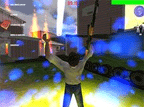
Exploring Digital Technologies in the Context of Public/Shared Spheres
MAY YOU LIVE IN INTERESTING TIMES is Cardiff’s inaugural festival of creative technology - a three-day programme of events being held across the capital. The festival is being developed between Chapter and Bloc (Creative Technology Wales) and includes a two-day conference, new commissions, residencies, screenings, and artists’ projects in public sites across the city.
Artists are increasingly engaged with or inspired by digital technology - exploring consumer and communication technologies such as the worldwide web, mobile networks, file sharing, and computer gaming. Because digital technology is a participatory medium with global reach, artists tend to explore digital technology in the context of public and shared spheres. Often digital art is situated somewhere between public art and street culture where the technology itself is used as a ‘site’ for the production and presentation of art works. Although digital technology is often claimed to go beyond physical limitations, engagement with technology is always embedded in real spaces, whether this is explored from a user or network perspective.
Artists include: Blast Theory, Anri Sala, Grennan & Sperandio, TJ Wilcox, Jen Southern & Jen Hamilton, Scanner, Sarah Morris, Michelle Teran, Eddo Stern, Stefhan Caddick, Nina Pope & Karen Guthrie, Tim Davies, Rosalind Nashashibi, Tenant Spin, Andy Fung, Paddy Jolley, Mircea Cantor, STAR Radio, Valérie Jouve, Chris Evans, Mike Mills, Artstation, and many more.
Conference day 1: 28 October - Locative media and emplacement Speakers include: Prof Michael Corris, Head of Art & Photography, University of Newport; Claire Doherty, Director, Situations; Nina Pope, artist; Heath Bunting, artist; Giles Lane, Proboscis; Steve Benford, Professor in Collaborative Computing, University of Nottingham; Dr Sarah Green, Social Anthropologist, University of Manchester; Jen Southern & Jen Hamilton, artists.
Conference day 2: 29 October - Gaming Speakers include: Ju Row Farr, artist, Blast Theory; Stuart Nolan, researcher; Christopher Sperandio, artist; Eddo Stern, artist; David Surman, Lecturer in Computer Games Design, University of Newport; Alex Mayhew & Emma Westecott, Games Producers & Directors.
Conference Prices: £50 per day / £90 weekend ticket – organisations; £30 / £50 – early bird booking before 7 October £20 per day / £30 weekend ticket – individuals /concs; £15 / £25 – early bird booking before 7 Oct Party, The Point, Cardiff, 29 Oct, 8pm: Special Guests Scanner, Michelle Teran, Proober Glombat, Cymbient, Christopher Rees DJs.
The site will feature live streaming, artists’ projects, downloads, full biographies and images, conference booking and travel details, press section and the chance to receive regular updates on festival activity.
For further information about the programme and conference please contact: Gordon Dalton, Festival Coordinator: gordon@mayyouliveininterestingtimes.org 44 (0) 29 2031 1059 / 0779 234 1654
The festival is a Cardiff 2005 event and is presented with the support of: Cardiff County Council, Millennium Commission, the Arts Council of Wales, WDA, Cywaith Cymru . Artworks Wales, BBCi, Creative Mwldan, Millennium Stadium, Mute, G39, The Big Sleep, Elfen, Zenith Media, UWN, National Museums and Galleries of Wales, Sequence, Coolpants, Ping Wales, Oriel Mostyn and @Wales. http://www.bloc.org.uk/cgi-bin/showbig.cgi?id=55
Posted by jo at 09:51 AM | Comments (0)
August 12, 2005
Phones Make Korea a Silent Society
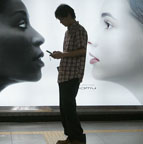
Living Without Saying a Word All Day
"The mobile phone bill of college student Oh Su-hyeon (21) for the month of July lists 648 text messages and four hours and 55 minutes of talk -- an average of 21.6 text message a day and an average nine minutes and eight seconds of conversation. ”I used to spend about two hours on the phone every day, but now I send text messages. All you need to do is state your business, there's nothing superfluous and it's convenient." [...]
If in an age of near-ubiquitous communication people have become paradoxically quiet, it is because means of communication that replace the spoken word, like chat programs and text messengers, are cheap, convenient to use and accessible everywhere. There are people who say they could live comfortably without saying a word all day, and who send so many SMS and chat online so much that sometimes they find it awkward to talk. Yet it is the telephone that is at the heart of these changes, a device that is rooted more than anything else in the attempt to allow people to talk. [...]
Cell phones with GPS navigation systems have also created a world where no one needs to ask directions, and DMS systems allowing people to watch TV on their phones have replaced gossip as a way to kill time. But the changes are taking place elsewhere too. Manned subway ticket booths are being visited by much fewer people. Cho Dong-hwan, the manager of Gwanghwamun Station on subway Line 5, says of the 28,000 passengers who use Gwanghwamun Station daily, over 80 percent use transport cards. ”The overwhelming majority of passengers using the ticket window are asking for senior citizen tickets.“
There are concerns that the silent society could aggravate alienation and isolation. But experts say there is no need to expect the worst: it is merely that communication is changing, from face-to-face to other forms, yet the flood of communication itself has not stopped. [...]
Yonsei University sociologist Kim Ho-gi says young-generation ”cool“ means a preference for writing over speech. ”Speech is loaded with feeling, and because young people prefer communication styles that convey meaning simply and clearly while keeping their own emotions in check, they like communicating through text messages." Link [via ratchet up]
Posted by jo at 09:09 AM | Comments (0)
August 09, 2005
In Memory of Franz Feigl
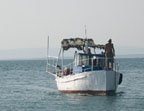
The Myth of Bolshevik
Network activists and friends of the medien.KUNSTLABOR want to travel by boat from Amsterdam to the Black Sea. Final destination of the journey is the island St. Anastasia, formerly known as Bolshevik (1945 - 1990). The boat is named after Franz Feigl, an Austrian artist and network activist who lived in Amsterdam and died in 2001 at a young age.
The boat will record on its journey all open wireless lan access points. This activity, if conducted by car, is called war-driving. The peaceful goals of the Motorship Franz Feigl aim at highlighting the possibility of opening up networks and creating a free infrastructure (see Funkfeuer, Freifunk,
Consume).
The boat will also communicate via packet radio and pictures will regularly be sent by GPRS to http://stroem.ung.at. MS Franz Feigl has already travelled from Amsterdam via Linz to Vienna. In Linz at the wharf of the Times Up collective repair work on the boat was done. It has travelled safely from Linz to Vienna under captainship of Franz Xaver.
Tomorrow, Wednesday August 9, the MS Franz Feigl is due to leave for Bratislava, where it will arrive om Thursday or Friday. On Monday, August 15, it will arrive in Budapest.
The project is carried out in collaboration with 05-trov and mobil.KUNSTLABOR.at
SMS Kontakt: 00436764902223
Chat: irc.kunstlabor.at#kunstlabor
E-mail:boot[at]kunstlabor.at
[via netbehaviour]
Posted by jo at 12:35 PM | Comments (0)
August 08, 2005
Vis-a-Vis:
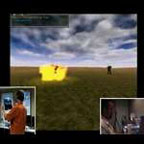
Mobile and Pervasive Electronic Gaming
After WiFi Bedouin and other mobile, location-based games, one of Julian Bleecker's current project along with Peter Brinson is called Vis-a-Vis. They’ve cobbled together a mobile gaming framework composed of light-weight, outdoor viewable TabletPCs, the Torque available source game engine, a GPS, a mil-spec 3D sensor that’s able to measure where one points the TabletPC. The plan with Vis-a-Vis Games is to take ordinary electronic gaming off the old fashioned video game console and desktop PC and moves it out into the real world. One of their current demos is an implementation of the Red Light, Green Light game. [blogged by fabian on 7.5th Floor]
Posted by jo at 09:25 AM | Comments (0)
August 07, 2005
Sim Civics
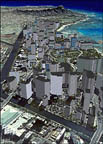
Public Participation in Regional Planning
Sim Civics by Jeff MacIntyre, The Boston Globe, August 7, 2005: New game-like computer software is empowering ordinary citizens to help design better cities. Can the professionals and the public learn to play well together?
[Image: SIM ISLAND--This 3-D image of Honolulu was created using GIS software from the company ERSI, as part of Honolulu's six-year planning initiative. (Courtesy of ESRI/City of Honolulu).]
"FIFTEEN YEARS AGO, the future of urban planning arrived in the form of a wonkish but strangely addictive new computer game. In SimCity, a player assumed the twin roles of mayor and city planner, creating elaborate cityscapes, managing zoning, transportation, and growth, while fighting off poverty, crime, traffic, and pollution..."SimCity...has probably introduced more people to urban planning than any book ever has."...Today, a new generation of GIS applications, known as ''scenario planning" or ''decision support" tools--which allow users to visualize, project, and manipulate a wealth of environmental data--have made citizens into major players in the gaming of urban futures. Across the United States...these tools are enabling an unprecedented level of public participation in broad regional planning initiatives..."
Posted by jo at 09:26 AM | Comments (0)
August 05, 2005
Trolley Spotting
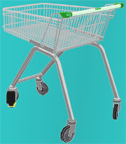
Investigating the Private Lives of Shopping Trolleys
Trolley Spotting--by Adele Prince--is a project that uses an interactive map to display her findings from recent ‘trolley spotting’ trips. On 14 May 2005 Adele visited Nottingham, carrying out an extensive survey of trolley activity in the local area. She photographed and logged every single trolley she discovered. Jam-packed with trolley data, the website allows you an insight into the private lives of shopping trolleys which have escaped the local supermarkets. Adele is making three versions of the Trolley Spotting map, each localised around the different venues on the exhibition tour. In Nottingham, she is working with Marks & Spencer and special turquoise Trolley Spotting tags will be attached to their entire fleet of trolleys for the duration of the exhibition.
Posted by jo at 10:36 AM | Comments (0)
August 03, 2005
Hitching Stealth with Trevor Paglen
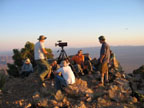
Experimental Geographer
"...Experimental lecturer and all around academic outlaw Trevor Paglen is a new breed of researcher for the University of California at Berkeley. He has been more aptly called by his peers an underground geographer, armed with a telescope, a GPS device, some light field military listening equipment, a car trunk full of cameras and maps, and one hideously nondescript corporate infiltration suit. Swapping between his other outfits as an intervention artist, and investigative journalist, a prison-abolition activist, punkrocker and total sound head, not to mention a third degree master in the art of panoptic trespass, he takes a wildly experimental approach to studying the strategic and practical boundaries of contested public/private space.
Altogether, he's concocted his own strain of what he prefers to call 'experimental geography' that he uses to trace the immense networks of undisclosed borders, shadow lairs and underground finanscapes edified by corporate, state and national defense collusion..." From Hitching Stealth with Trevor Paglen; Text by Bryan Finoki/Photos by Trevor Paglen, Bryan Finoki, & Bill Luoma, Archinect. (2005) [via]
Posted by jo at 10:12 AM | Comments (0)
July 27, 2005
Social Machines

Continuous Computing
"...After a decade of hype about "mobility," personal computing has finally and irreversibly cut its bonds to the desktop and has moved into devices we can carry everywhere. We're using this newly portable computing power to connect with others in ways no one predicted--and we won't be easily parted from our new tools...
There is something different about the latest tools. They are both digital, rooted in the world of electrons and bits, and fundamentally social, built to enable new kinds of interactions among people. Blogging, text messaging, photo sharing, and Web surfing from a smart phone are just the earliest examples. Almost below our mental radar, these technologies are ushering us into a world of what could be called continuous computing--continuous in the usual sense of "uninterrupted," but also in the sense that it's continuous with our lives, in all their messy, social, biographical richness..." From Social Machines by Wade Roush, Technology Review, August 2005.
Posted by jo at 11:01 AM | Comments (0)
July 19, 2005
From Image to Interface:
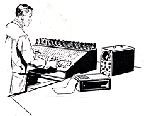
Preemptive Media
"The Preemptive Media Collective (PM) reengineers your thinking about mobile digital technologies imbedded in everyday environments. In live performances and real time actions, the PM art, technology and activist collective disturbs, dislodges, and redesigns new media technologies that we often ignore, like the bar codes on driver's licenses or radio frequency information devices used for EZ pass on highways...
At the forefront of what is called locative media, Preemptive Media repositions highly specialized technologies within the democratic discourse of low-tech amateurism. The emerging locative media movement has gathered steam and attention since 9/11 and the 2001 Patriot Act, which authorizes unprecedented data mining, invasions of privacy, wiretapping, and internet surveillance." Read From Image to Interface: Preemptive Media by Patricia R. Zimmermann, MediaChannel.org, July 8, 2005.
Posted by jo at 07:28 AM | Comments (0)
July 13, 2005
FLORA
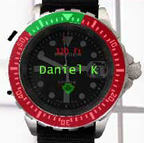
Location-Aware Watch
The FLORA (Fluorescent Light Organizing Radio Accessory), by Daniel Kantor, is a location-aware watch that helps people locate others, a mixture of a compass and the game "Hot and Cold".
When set on the Watch Mode, the FLORA displays time and date, like any other watch. To select which buddy to track, activate the Buddy Mode. The FLORA then dims the watch features and displays the name of the closest buddy to you. Once the buddy is selected, the Track Mode will change the face to red and green with green indicating the direction of the buddy being tracked. The buddy's distance will be displayed in feet. If the buddy is located in a different floor in mall a direction arrow will indicate which direction your friend is (up or down). [blogge by Regine on we-make-money-not]
Posted by jo at 08:22 AM | Comments (0)
July 07, 2005
Sleeping Dogs Lie - Part 2 - untitled

Navigable Cinema
Sleep and Insomnia. Alcohol. Drugs. Crime. Love making. Rock 'n' Roll. Memories. Distances seem to change. In the night, one's thoughts go from city to city, from one place to another, dreaming of another life in each other's place.
e-Xplo will create and present four performances of Sleeping Dogs Lie, a specially commissioned audio coach tour of nocturnal NewcastleGateshead in a coach equipped with an audio system and GPS receiver. The performance combines pre-recorded and live electro-acoustic sound, transforming the ordinary coach into a navigable cinema.
We cannot escape the politics of the sites we choose, and even in mapping a tour, even in struggling for the visual element, we cannot avoid the specifics of the place entirely. Having said that, how may our concerns be heightened by the visual, historical, architectural, acoustic and political circumstances of Newcastle? The night challenges us to enter a process of constructing and reconstructing topographical views on the subject.
e-Xplo develops maps, routes, sound and film materials as reflections of a multifaceted investigation into location, context, social identity, landscape, and the public space of information.
Each work proposes distinct but related topics, thus focusing on specific issues for concrete places while searching for broader insights.
e-Xplo is the framework for the collaboration between Erin McGonigle, Heimo Lattner, and Rene Gabri. Since 2001 they have organized bus tours in Budapest, Massachussetts, Berlin, London, Eindhoven/Rotterdam, Turin, and New York. [via net art review]
Posted by jo at 10:43 AM | Comments (0)
July 05, 2005
Targeting the 'Art' Around Every Corner
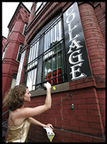
Yellow Arrow Stickers Make a Personal Point About a Public Space
"...Launched last summer by Counts Media, a New York-based arts and gaming company, the Yellow Arrow Project is a kind of geographical blogging. Adherents have been placing the palm-size stickers -- each with a unique code -- on street signs, city monuments, store windows, abandoned buildings -- anywhere, really, that observers encounter what they deem to be "art." Then, using a cell phone, they send a brief text message -- which could be an interesting historical fact, a restaurant review or just some goofy poetry -- to Yellow Arrow. People who come across an arrow can call the Yellow Arrow phone number, punch in the sticker's code and receive that message." Continue reading Targeting the 'Art' Around Every Corner by Tommy Nguyen, Washington Post, Saturday, July 2, 2005; Page C01. [via smartmobs]
Posted by jo at 07:52 AM | Comments (0)
APCompass
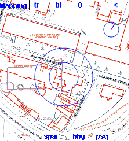
Pioneering and Exploration
APCompass, by David Wiltshire, is the prototype application of the gpsMiddleware platform. It uses GPS technologies integrated with a community maintained database to allow people to explore their local wireless networks. There is an emphasis on pioneering and exploration as users seek out new nodes to extend the database. The project considers issues of privacy, by ensuring every action performed by the user is broadcasted to a central server for anyone to see. Drawing on David Brin's idea of a ‘Transparent Society' APCompass encourages collaboration and accountability as users appreciate the fact that their actions are being constantly monitored.
gpsMiddleware is a custom built C++ application developed explicitly for providing a link between a palmtop computer and a global positioning system. The underlying software is available for download and adaptation for members of the community, so that it can be used as a basis for developing a range of creative applications. [via we-make-money-not]
Posted by jo at 07:49 AM | Comments (0)
Urban/Social Tapestries
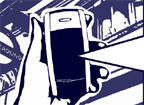
Final Reports
Proboscis has recently released the final reports on the Urban Tapestries project. You can order them here. ]The reports are free for private use by individuals, academics and non-profit organisations in the arts and civil society sectors.]
Urban Tapestries: Public Authoring, Place and Mobility A Proboscis White Paper by Giles Lane & Sarah Thelwall: This white paper presents our vision for public authoring and our conclusions on its relationships to place and mobility. We argue for design solutions to focus on actual people in real world contexts and situations, offer insights from the public trials of our prototypes and set out Proboscis’ own future vision and research agenda. Finally we recommend a series of policy proposals for realising a public knowledge commons, structured around place.
Urban Tapestries: Project Report
A Proboscis Report by Giles Lane & Sarah Thelwall
This report gives a chronological account of the development of the project and provides detail of and context for the key issues that arose over its two year span. In describing the activities and outcomes of the project it also connects the completion of Urban Tapestries to the research brief for Social Tapestries, a follow on research programme. A summary of the outputs, press coverage, some statistics and project credits are listed at the end of the report.
Urban Tapestries: Observations and Analysis
A Proboscis Report by Giles Lane, Alice Angus, Victoria Peckett & Nick West
This document presents the observations and qualitative evaluation of participant activity and feedback from the bodystorming experiences, the public trial of December 2003 and the field trial of June/July 2004.
Complimentary copies are available for affiliates, project funders and partners. Commercial organisations, government departments and government agencies are requested to purchase reports – bound copies will be posted to the billing address.
Posted by jo at 07:32 AM | Comments (0)
July 04, 2005
DigiDress

Peaking in Public
DigiDress--by Per Persson, Younghee Jung, Jan Blom, Ionific--is a matchmaking system that allows colocated people to be aware of potential partners in their vicinity. In an encounter between spatially proximate people, how can information in digital realm support and augment existing social behavior, practices and experiences taking place in real space?
The DigiDress application allowed mobile users to create a page on their phone with text and imagery describing themselves, their interests, dreams, things they are proud of, favorite jokes or any other content. Pages were then viewable by other users within Bluetooth range (typically 10-20m), without the page owner’s explicit consent. In this way, DigiDress users could take a ‘peak view’ at others without revealing their identity, similar to peaking at non-acquainted people in public spaces.
Posted by jo at 07:00 AM | Comments (0)
June 30, 2005
Monopoly Here & Now
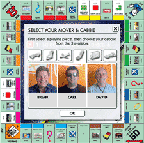
London as a Real-Life Playing Board
"We have turned London into a real-life playing board, and real taxi cabs into real-life playing pieces. All you have to do is make as much money from rent as possible, from five other cabs who are your opponents in the game. We've kitted out 18 cabbies with GPS (Global Positioning System), meaning we can pinpoint their exact whereabouts in London. They will be going about their normal day, picking up and dropping off customers all over town. All that you've got to do is spend the £15m we give you on properties from around the Monopoly Here & Now board, distribute your apartments and hotels and choose your cabbie. You are placed into a game with your cabbie and 5 other taxi drivers, all travelling around London. Every time one of the other cabs stops outside one of your properties, you get paid rent. Any time your cabbie lands on a property you don't own, you pay up. Simple!"" [via smartmobs]
Posted by jo at 11:06 AM | Comments (0)
Foundcity
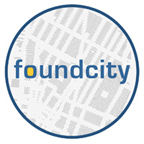
The Dynamic Nature of Place and Space
From The Feature: "...many projects have approached the idea of annotating space before but few have succeeded as well as FoundCity in giving this networked effort a more personal quality. By overlaying the perspectives of thousands of people, FoundCity approaches the dynamic nature of place and space."
Foundcity--by John Geraci, Christina Ray, and John Schimmel--is a social mapping tool for creating a personalized map of your life on-the-fly. Using your mobile phone, you "tag" or capture photos throughout the day, label them with any words you want, and send them to your map. At home, you access and customize your map, which you can share with friends, keep private, or publish openly. As a visitor to the Foundcity site, you view a map of all tags and connect with the people and places that share your interests. By plugging in to the network of Foundcity users, you learn what others value in the city as you surf their hotspots. By publishing your own tags, you share what you know about your city.
Posted by jo at 10:35 AM | Comments (0)
June 27, 2005
NEIGHBOURHOOD GAMES
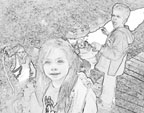
Transcending Existing the Boundaries
So what happens when kids come to the end of the level on their gameboys - what if they don't even have Gameboy? What is the fascination in sitting around in the park all evening? What is the most daring place you have seen tagged? Who decides when the game starts... and when it's over? What does a neighbourhood mean?
Neighbourhood Games--by John Paul Bichard--sets out to explore the possibilities of introducing cross-media games into the everyday neighbourhood environment, to propose ways in which games can be meaningfully structured across a broad range of channels, including fixed and mobile digital spaces and the "real" environment of the local neighbourhood.
Neighbourhood Games looks at ways in which gameplay normally associated with digital frameworks can be organised and played with or without these technologies. Key to this are not only the motivations and rewards a game sets up but also the nature of that gameplay in relation to environment, the aspirations of the game players and the existing social organisation in a particular locale.
The aim is to explore games methodologies that have the potential to enable a range of players to engage in play scenarios that are situated in the everyday environment and how far these are able to transcend existing the neighbourhood 'boundaries'.
Posted by jo at 12:47 PM | Comments (0)
June 22, 2005
Anne Galloway

Case histories (Mobile Bristol)
People have often asked me which of my case studies is the 'best' project - like they can be definitively ranked - to which I have always, and truthfully, answered, "I think all five are really interesting. That's why I chose them." **
"Cases are rarely chosen because they are thought to be representative, but generally because of their illustrative significance. Criticism of case studies should therefore be directed towards their logical consistency and not towards their statistical generality" (Mitchell as cited in Jackson 1984:107).
In other words, don't evaluate a case according to how well or poorly it represents (all versions of) the subject, but rather evaluate it according to its own strengths and weaknesses, to whether or not its individual story is convincing. And actually, in my dissertation I refer to them as case histories rather than case studies. While a case study "uses evidence governed by the rule of exhaustiveness", a case history, in the tradition of Freud and Foucault, involves "evidence governed by rules of 'intelligibility', denying the natural science project of producing final pronouncements."
In Michel Foucault, Cousins and Hussain (1984) further explain that Freud's interpretations of dreams and Foucault's case histories do not :
"accord privilege to the search for origins which function as a point from which a causality and a narrative can be deployed and where elements borrow their identity from their origins. Beginnings are only 'configurations of elements' not origins ... [Case histories] neither 'demonstrate' metaphysical positions, nor do they reconstitute the analysand's past as a [final] 'history'... [Instead they] make a problem intelligible by reconstituting its conditions of existence and its conditions of emergence."
So why, for example, is the case of Mobile Bristol interesting? What is its "illustrative significance"? Well, for one, its ability to work - and I would argue, rather gracefully - across traditional boundaries between private and public interests:
"The Mobile Bristol Toolkit is a limited version of the Mobile Bristol Application Development Framework which has been created to ease the development and deployment of locative media. The [free download] toolkit enables almost anyone to author location-sensitive, media-oriented, mobile applications called mediascapes and to try out their creations on a handheld device with an attached GPS unit."
Not surprisingly, the commercial version of the application development framework comes with fewer limitations on its use and greater support, and has led to customer products as diverse as Node and the BBC Festival of Nature Walk. On the private-side of things, they also work for themselves, and with industry partners, to research technological issues for infrastructure rollout.
At the same time, Mobile Bristol has collaborated to varying degrees with artist-researcher projects like Urban Tapestries and the currently-on Stimmen über Berlin - "the realisation of a dream of peeling back the layers of a city, accessing those stories, those events that remain undocumented, the happenings and thoughts that shape people's everyday experience". Additionally, Mobile Bristol's own research, especially in the 'lifestyle and experience design' area, has often involved working with artists on popular public projects (like Riot 1831!).
This slippage between private and public is particularly interesting (and not easily-resolved) when questions of ethics and accountability arise - but that's something for another time.
** I did originally (in 2003) choose one other interesting project, but they declined to participate in my study. [blogged by Anne Galloway on purse lips square jaw]
Posted by jo at 11:05 AM | Comments (0)
June 21, 2005
Civic Maps
A Mapping Module for Civicspace and Drupal
Here is a first pass functional mapping module for civicspace and drupal as demonstrated here: http://civicmaps.org/?q=2005_06_20_Scappoose_Events
Essentially if you were to install drupal and civicspace you could have a location blogging site up and running quite easily now. Are there any other such services in the world at all right now? I don't think so; so I do believe (at least from our limited perspective) that this is something that may be genuinely useful. Here is the site for the download: http://maps.civicactions.net#download
This is hot off the presses and undoubtably there are defects. However it is a milestone in our development work here and as is often said 'publish early and publish often'. Having reached this milestone I wanted to briefly summarize what the deeper purpose of this was since it is not documented on the site:
* Civicactions, (Anselm Hook) and quite a few others are continuing to look for ways to help energize real world community not just virtual community. The challenge is that a lot of our urban landscapes are somewhat mechanized. They've scaled up to industrial proportions but we have not equivalently developed an industrial scale voice. Although possibly a romantic view, there is the feeling that in earlier and smaller communities it was much easier to inadvertently be a part of the social knowledge commons of that community. The hope here is that rich client side mapping tools that are dispersed over many many servers (instead of centralized) will help create a more true, richer and authentic voice than what we get from the commercial mapping sites.
* This work although free is actually quite expensive. It is time consuming and labourious to develop for very little financial gain. At the same time if somehow services like this could 'raise all ships' then perhaps we might not have quite so much a need for money in our society. Money is a substitute for awareness. As local currencies show one undervalued function of money is as a discovery tool or a catalyst. If I were better connected to my own physical neighbourhood I might be able to message all my neighbours asking who could lend me a ladder, or a boat or some such thing - rather than purchasing one or renting one. Or equivalently I might have a lot of free time on my hands and could volunteer for some fun local neighborhood project if only my peers knew I was interested. For many people, especially in mobile urban societies, it is hard to have that kind of groundedness and trust. Tools that accelerate that process, that show us our landscape, our peers, where our friends are or have been, the knowledge that they shared... well these are all ideas that are out there and have been discussed quite a bit - but it still doesn't feel as if they have really been exercised. So this is more of the same in a sense; continuing to try to push out tools that help get computers to come out and play with us, and help us in the real world, instead of sucking us into a virtual contextually disjointed reality. If 80 percent of human discusion involves space and location then 80 percent of our tools should support this.
We definitely appreciate feedback and even flames - post your thoughts on the http://civicmaps.org site. This process is driven by user feedback and interest. Continually in open source development one is trying to pick the absolute best project and absolute best use of time that one can possibly pursue. Feedback on this particular project will dictate if it gets more attention and time.
Anselm Hook [originally posted to locative]
Posted by jo at 09:07 AM | Comments (0)
Rixome
![madrix_final_b[1].jpg](http://www.turbulence.org/blog/images/madrix_final_b[1].jpg)
Become a Walker
rixome is a network and a tool that turns mobile screens into windows that show the virtual and public dimensions of our point of view. A walker (a rixome user) can see on his/her mobile phone/PDA/laptop screen the virtual interventions that have been added to the location where s/he now stands. For example, a spoken message can be left on a given location for other "walkers" to hear through headphones whenever they pass by. The message can also be written, or it can be a 3D animation or image, a photography, a drawing, a video.
Remote rixome users can also check vía Internet the traces left by others but s/he won't be able to add an intervention similar to those published in situ. Developed by gelo for his at Master of Art and New Technologlies at the Universidad Europea de Madrid. [blogge by Regine on near near future]
Posted by jo at 08:54 AM | Comments (0)
June 17, 2005
Anne Galloway

Inscription, Enrolment and Agency
"The state is going to be recording everything we do, why shouldn't we make our own recordings -- if only to challenge the accuracy of what others capture?"
In Inscription: Surveillance Turned Inside Out, Howard Rheingold talks to Microsoft sociologist Marc Smith about "ways to use tomorrow's panoptic snooping technologies".
I was instantly struck by Smith's use of the term "inscription" - instead of "authoring" and despite AURA's call to "annotate the planet" - a term which Rheingold describes as relating "to behavior that leaves traces detectable by others." But because words do things, because speech acts, inscription also means enrolment** in particular contexts, identities and practices.
The current obsession with tagging and projects like Urban Tapestries, Yellow Arrow, Grafedia, MapHub (and, oh, about a million others now) all work off the general idea that "regular" people can, and indeed should, declare and order their experiences and ideas, and share them with other people.
I don't know where or when "bottom-up" became an absolute social, cultural and (cough) ethical good, but classification, authorship and/or publication are not simply matters of production, or more specifically, about changing the means of production. First of all is that pesky matter of consumption and use: how are people actually consuming and using this information? Second, into which (unequal) arrangements or assemblages do all these practices enrol us?
For example, do we really want to say that when Microsoft or Nokia record everything that it is inherently better than when The State does it? What kind of agency do we actually have? When we use our blogs for 'impression management' or when we post pictures of ourselves to Flickr to have more control over what appears in searches, what kind of agency is that?
** In the work of Michel Callon and Bruno Latour, enrolment refers to the "process in network-building in which actors' support is gained for development of a sociotechnical entity, their role defined and their interests and identities orientated to suit." In other words, an actor/actant must be made relevant to others (interessement), be made indispensable to others (translation), and be granted consent by others (enrolment). [blogged by Anne on purse lips square jaw] [Readers' comments]
Posted by jo at 09:26 AM | Comments (0)
June 13, 2005
Social Tapestries
![]()
Public Forum, 1st July 2005
Proboscis will be holding a half-day public forum on the Social Tapestries research programme hosted at the Stanhope Centre for Communications Policy Research on Friday July 1st 2005 1-6pm. The event will bring together practitioners from the arts, industry, government, civil society organisations and academia to review the work underway for Social Tapestries and stimulate public debate on the issues.
This event is a pre-competitive forum for the free exchange and flow of ideas intended to generate opportunities for dynamic partnerships that find common ground between artists, culture organisations, civil society organisations, academia, government and public agencies, business and industry. To book a place please complete the online form. Places are limited to maximum of 70. [blogged by on giles on urban tapestries]
Posted by jo at 10:34 AM | Comments (0)
GeoSkating
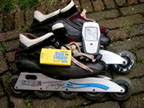
Multimedial Skate-Maps
GeoSkating aims to automate the generation of interactive, multimedial skate-maps by using the Global Positioning System (GPS), Mobile Phones and the Internet. The key idea is that while skating, GPS position data is being assembled and published to a server through a mobile phone. At the same time the skater can enrich the GPS data with road surface ratings and by submitting media items (pictures, videos). The server will draw geographic maps showing road quality through colouring plus the submitted media on the GPS locations where they were captured. In addition, skaters can also be seen moving in real-time on the map while skating!
Posted by jo at 09:44 AM | Comments (0)
June 10, 2005
Yellow Arrow
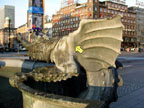
Pointing to the Hidden Stories of the City
"The project Yellow Arrow lets you discover hidden layers of your city and place your own stories in the urban landscape. The project uses text messaging (SMS) as a way to link personal messages to certain locations, which mean something special to someone. You point the attention to the spot by placing a yellow arrow sticker with a unique code, thus making it possible for others to receive the story. Thomas Petersen asked the Yellow Arrow organization a few questions about the project, now that the project is being launched in Denmark. [Get your arrows at the website. Also, sign up for an invitation to the launch party at a secret location, Saturday June 11th at 8 pm!.]" Read interview.
Posted by jo at 08:36 AM | Comments (0)
June 09, 2005
Decoy

Where Data Lives
Decoy is a wireless data project in public space based on bluetooth. Data might be accessible almost everywhere via internet, but it is actually saved or "living" at a particular geographical position. Just the last node of a network remains comprehensible to the user: the LAN-wall-outlet, a modem, a mobile phone, etc. In addition to cables there is a dense wireless network over todays settled areas. Overlapping data-bubbles as big as their radius of range.
The aim of decoy is to pinpoint certain spots in this invisible data space. and these spots themselves are referencing the "real" space. To do so, small bluetooth-servers with a radio range of about 10 meters are placed in public space. These servers are communicating with passing by bluetooth-enabled-devices (e.g. mobile phones, PDAs or laptops). If the owner of these passing-by-devices wants so, he or she will receive a picture. In this aspect a Decoy is something like an invisible poster, graffiti or a direction sign which gets alive by the mobile in the pocket. [via neural.it]
Posted by jo at 09:34 AM | Comments (0)
June 03, 2005
Significant Sites - a Summer Solstice Dérive
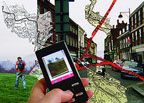
An Invitation to Participate
Significant Sites-a Summer Solstice Dérive is inspired by the Situationist practice of dérive. John and Cathy Rogers set out to chart the layers of place that make up High Wycombe as it undergoes a period of transition and redevelopment. After conducting and initial period of investigation through a series of dérives and interventions they intend to stage a grand psychogeographical event on June 18, 2005 during the Summer Solstice.
A Walker will embark on a ritualistic perambulation to link up the significant sites, or Nodules of Energy that surround the town. He will use the town's matrix of ancient footpaths to achieve this circuit. Using a videophone he will send moving images to a base station in a prominent position in the town centre where they will be projected onto a screen where spectators will be able to watch the walk as it happens.
The relayed image of the walker is presented alongside a montage of archive film and present day photographs of the town together with a simulated image of the town. In addition to the video clips the walker will send reports from his location via voice and text messages.
Spectators will be able to interact with the walker giving him directions to places they consider to be significant sites and furnish him with information and folklore about the areas he walks through.
People will be encouraged to set out on their own dérives and send back images and text to the base station for projection and relay to the audience.
Posted by jo at 02:14 PM | Comments (0)
June 02, 2005
Netzfunk

The Art of Silence
Netzfunk, a group of people working on the art of silence, is producing a soft technologies workshop in Santiago, Chile, through the end of June,for the aesthetic post-graduate program of the University of Chile. The main goal of this workshop is to transgress the apolitical view that holds sway over technological objects, altering its functional profit context to a political discursivness.
This course is divided into three practical projects, that will end with a performance in real time, where GPS and a software written on PHP for such instruments, will be used that will allow one to extend 'the' point of location on a radio to 25 meters. Additionally, the GPS will be able to download files in different digital formats (audio, text, video and images), that will match with the documents and statements obtained by the collective, which have been previously compiled. This action will be realized from three different locations in the city of Santiago. Such a piece will be the _first_ contemporary artistic work to be performed in Chile under Creative Commons license, from which it will be expected that an official launching will follow. [by Ignacio Nieto via net art review]
Posted by jo at 07:41 AM | Comments (0)
May 31, 2005
Neighbourhood Satellites
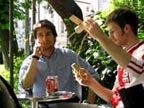
Environment-Sensing Adventures in the City
Neighbourhood Satellites is one of my favourite projects. Ever. I've spammed Myriel Milicevic with messages asking her if she'd send me pictures, when she'll have something online, etc. So far, there's only the PDF of her brilliant thesis project. Proper website is coming soon.
Neighbourhood Satellites are handheld sensing devices that monitor people's local environment. In its current prototype form, the satellite is able to sense air quality, light, and the presence of cell phone signals.
The data collected is presented in three different modes:
- In "status" mode, it displays the current conditions.
- In "game" mode, the satellite leads a parallel existence inside a video screen, navigating amongst the offending pollutants in need of analysis.
- In "map" mode, the system receives data from the other "satellites" carried by people in the area, and displays on a map, their location and contamination level. This mode could generate some interesting behaviours: A group of players, gathering in larger numbers at polluted street junctions, navigating their satellites through thick air, might just as well be interpreted as a silent protest.
The way the satellite is tilted by the hand controls its navigation on the screen. So the satellite’s position in the hand is just as relevant to the game as the position of the player inside a space.
The satellite also communicates through tangible behaviour. For example, when approaching air pollutants onscreen, the satellite inside the game will suck in air to capture specimen. Simultaneously, the physical satellite emits streams of air that the player can feel in his hand. A gentle vibration accompanies the sensation.
Note to Myriel: Hope you're not mad at me because I didn't wait for the website...
Related: Flower Power. [blogged by Regine on near near future]
Posted by jo at 07:37 AM | Comments (0)
May 27, 2005
ARTISTS AND MAPPING:
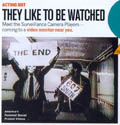
Situationism and Locative Media
"The Situationists were no different from the Dadaists and the Surrealists in their desire to suppress art. Art and culture should be part of everyday life, and it is an interesting component of recent art, that the Situationist International is often associated with emerging locative media, ubiquitous computing and urban life.
The post-war movement Lettrist International, along with Asger Jorn and his International Movement for an Imaginist Bauhaus (IMIB), were precursors of the SI. Jorn, a close friend and collaborator with SI leader Guy Debord, is considered one of the most notable Situationist artists." From ARTISTS AND MAPPING: Situationism and Locative Media by Ana Boa-Ventura, Net Art Review, May 24, 2005. Also in NAR's series WEEKLIES: ART AND MOBILE TECH, 05/01/2005 - 05/07/2005, 05/08/2005 - 05/14/2005, 05/15/2005 - 05/21/2005.
Posted by jo at 08:10 AM | Comments (0)
Next OPEN PLAN event:
![]()
PLAN TECHNOLOGY CAMP
OPEN PLAN: Venue: Mixed Reality Lab, University of Nottingham; Date: October 2-8, 2005; Deadline for Expressions of Interest: July 4, 2005
Cross-disciplinary teams will be formed to work on seed project ideas and develop methodologies, encouraging cross disciplinaryexperimentation. Proposals may develop into real projects or may be entirely hypothetical. There will be opportunities to take the projects further, in particular as part of the PLAN final exhibition at Futuresonic 2006 in Manchester UK during July 2006.
Please send a 2-page expression of interest, including details of your areas of interest, experience and expertise to the address below by Monday 4 July 2005. Suggestions for seed ideas in the area of locative-based media are also welcomed. Places at the workshop are limited and the steering committee reserves the right to seed ideas and put together diverse teams from the best submissions, based on the expressions of interest together with views generated at the ICA Event.
Posted by jo at 07:25 AM | Comments (0)
May 25, 2005
FLOAT
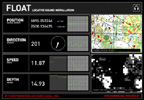
Listening to Place
In FLOAT--by Tuomo Tammenpää and Tamas Szakal--the ship is the play-head and the route is the track. Depth, direction, speed and surrounding islands build the score of the sound installation. The ship plays the track as it moves across the Baltic Sea. On the surface, there are shapes of islands and the coastline, drawn on the sea. The multitude of ship routes and passages that connect countries and cities together weave a vast invisible network of paths.
The sea, especially the deep unknown, holds its mysterious nature in the era of extreme traveling. There is a fascination for the dimensions of waterbodies and the secrets it possesses. The power of a storm, the long horizon and the incomprehensible raises respect among most of us.
Crossing the various locations, the voyage, provides a lots of information, which can't be seen or heard. Taking a ferry on the Baltic Sea is usually just transportation or entertainment on board. In both cases, the sea itself is insignificant. This sound installation makes some of the invisible dimensions and the silent layers of data, audible. The ferry travels through a map moving high above the bottom of the sea floor, sometimes shallow, sometimes deep. The passage in time generates various data. All these data streams: the GPS coordinates, distance to islands, depth, direction and speed are translated to sounds. The result is a slowly developing soundscape that invites the traveler to listen to the place in time. [originally posted by inf* from information aesthetics, ReBlogged by marisa on eyebeam reblog]
Posted by jo at 10:44 AM | Comments (0)
May 24, 2005
C5 GPS Media Player

Massive Performative Expeditions
The C5 GPS Media Player--this month's artport gate page--was developed in conjunction with "The C5 Landscape Initiative," a series of projects initiated by C5 that involve mapping, navigation and search of the landscape using GIS (Geographic Information Systems). "The Landscape Initiative" examines the changing conception of the landscape as we move from the aesthetics of representation to those of information visualization and interface. Consisting of three parts -- "The Analogous Landscape: Rim of Fire," "The Perfect View," and "The Other Path" -- "The Landscape Initiative" consists of massive performative expeditions all over the world that involve network technologies and explore the status of our relationship to the landscape in a networked data world.
For "The Analogous Landscape," members of the C5 team climbed mountains such as Mt. Shasta (14,162 ft.) in the Cascade Range of North America, Mt. Whitney in California (14,162 ft), and -- with two teams simultaneously -- Mt. Fuji, the tallest mountain in Japan at 12,395 ft. (3,776 m) and Mt. Lassen in California (10,457 ft.). The respective journeys were tracked by means of the Global Positioning System (GPS) and Digital Elevation Mapping (DEM), with the goal of establishing analogies between the journeys through the different terrains. For "The Other View," C5 asked people who are making use of GPS technology in their travels -- thus "geocaching" them -- to recommend locations they experienced as sublime and then revisited the places according to the original coordinates in order to photograph document them. The goal of "The Other Path" was to accurately track the Great Wall of China and then use pattern matching procedures in order to find an analogous "significant path" in the US.
By means of the C5 GPS Media Player, visitors can access the GPS track logs of each C5 member's route in the different manifestations of the project,
see associated media documentation (photographs / video), and investigate multiple track logs to compare the landscapes. Exploration does not only unfold in the traversing of landscape but in raising the question whether strategies of navigation can be translated from one site to another (or whether similar sites induce the same techniques for exploration).
The C5 GPS Media Player suggests a trajectory from personal experience and live performance to a data representation of this very experience and the possible contexts for understanding it. The virtual track logs and overlapping paths accessible through the GPS Media Player form their own kind of landscape -- rooted in a personal interaction with the actual landscape yet accumulating into a virtual, relational set of data that transcends both the subjective and actual. The different forms of data combined at the website -- from photorealistic documentation to simulation -- are a reflection on the construction of reality and a shared resource that invites investigation by its users.
"The Landscape Initiative" is currently on view at SF Camerawork. The exhibition features digital photographic prints, fabricated sculptural objects, 3D visualizations and digital video.
C5 Corporation specializes in cultural production informed by the blurred boundaries of research, art, and business practice. Focus is on the development of tactical strategies involving information visualization, databases, and distributed networks.
C5 projects have been featured at institutions such as ICA-London, The Whitney Museum of American Art, The Walker Art Center, Center for Creative Inquiry at ASU, and the Cantor Center for the Arts. C5 representatives have participated in international symposia and festivals including Transmediale, Berlin; Ars Electronica, Austria; AUT, New Zealand; and the II International Biennial in Buenos-Aires.
Previous projects include Radio Controlled Surveillance Probes RCSP, 16 Sessions, YDSTYDS (You Don't See That You Don't See), 1:1, and SoftSub. Full documentation is available at www.c5corp.com=20
C5 members:
Joel Slayton
Steve Durie
Geri Wittig
Bruce Gardner
Jack Toolin
Brett Stalbaum
Amul Goswamy
Matt Mays
Posted by jo at 01:05 PM | Comments (0)
THE PATH MORE OR LESS TAKEN
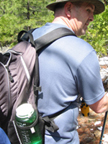
C5 and their Landscape Initiative
"...Close to midnight, following a more ore less successful 14-hour, 14-kilometer assault on the California "other path" of the Great Wall of China, [Joel Slayton] summarizes the day's events:
We continually seek something definite. Where are we? How do I get there from here? . . . Determining what leads to what is the demeanor of the short path, . . . [which] is like a paragraph in a great run on sentence. Go here, go there, go around that, go back, move, stop, start, faster, slower. . . . To get there from here is not a matter of direction but rather the inference of similarity, memory and discovery. Every short path is an other path and every other path is a set of directions." From The Path More or Less Taken by Steve Dietz. [Related]
Posted by jo at 12:50 PM | Comments (0)
May 23, 2005
Let's Do Lunch [2005] - TAKE2030

Pervasive Connections- Instructions Included
"Pervasive Connections was an event organised by SPACE Media Arts and Iniva 'focusing on opportunities for artists to work with new social technologies'. The day comprised of presentations, workshops and panel discussions and tickets were sold out, mainly to artists, arts organisers and producers. Let's Do Lunch by Take2030 which 'tracks Hackney's public access wireless nodes and its lunch menus along bus route 26 in the form of a series of documentary videos' was also installed in the Space gallery.
A recurring theme was artists' arguably halting adoption of wireless and locative technologies and the lag in their response to the cultural questions and opportunities they give rise to." Continue reading Ruth Catlow's review at Furtherfield.
Posted by jo at 01:12 PM | Comments (0)
May 19, 2005
WiFi Bedouin @ Vectors
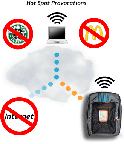
Call for Projects
What would you do with a mobile Internet?
Vectors: Journal of Culture and Technology in a Dynamic Vernacular is seeking proposals for creative or scholarly uses of a mobile server/transmitter unit known as the WiFi Bedouin for inclusion in its Mobility issue to be published in late Summer 2005. Designed by Julian Bleecker, the WiFi Bedouin uses a portable 500mW 802.11b transmitter and Mac OS X based web server that is ready to receive your portable web content. The system includes basic software for web pages, group chat, an open blog and iTunes music streaming, but users are free to add custom software as desired.
We are particularly interested in projects that use the Bedouin to investigate issues related to the intersection of physical and virtual spaces and questions of locality, proximity, materiality, community, etc. Once your project or event has been completed, we will ask you to submit documentation of the project outcomes for inclusion in the Mobility issue of Vectors.
Please submit your WiFi Bedouin proposals to vectors[at]annenberg.edu by May 25, 2005.
Projects should be able to be completed and documentation submitted by
July 1, 2005.
Proposals should include the following information:
--Name of applicant(s) and contact information
--Project title
--One sentence description
--Brief explanation of project goals and interests
--Approximate timeline for completing the project
--Previous work or experience in related areas
Posted by jo at 11:56 AM | Comments (0)
May 18, 2005
Technojewelry
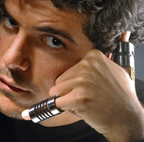
Let Your Fingers and Toes Do the Talking
Technojewelry incorporates emerging electronics into everyday attire. Focusing on the hands and feet as nonintrusive locations for useful innovations, these concepts prove that new devices needn’t look alien to your person and that we can make technology adapt to our lifestyles rather that the other way around.
Penta Phone and Ring Phone are concepts for mobile phones. The design takes its cue from the universal gesture for using a telephone, but is feasibly grounded in the nanotechnology research emerging from start-ups and established companies. Calls can be initiated by raising the hand to the proper position, and voice-activated interaction will allow instant communication. The little-finger units will vibrate to indicate incoming calls and the thumb unit will beam the sound towards the ear when the hand is held in the listening position.
Using similar low-power, nano-derived technology, GPS Toes are toe rings that communicate to a GPS receiver kept in a purse or worn on a belt. Wearing one on each foot, the GPS Toes device will guide the wearer to a preset destination by vibrating and lighting up to signal upcoming direction changes. The left toe ring will indicate left turns and the right toe right turns, whether driving on the highway, walking on city streets, or hiking on the mountain trail.
Also read The Experience of Enchantment in Human-Computer Interaction by John McCarthy et al. [via pasta and vinegar]
Posted by jo at 10:37 AM | Comments (0)
May 11, 2005
Locative Media in the Wild

Human Interaction with Space
An invitation to researchers, faculty, staff, and graduate and PhD students to submit a letter of interest for a 4-day interdisciplinary workshop--Locative Media in the Wild--to be held July 20th- July 23rd*, 2005 at the Crooked Creek Research Facility in the White Mountains of Inyo County, California. Convened by Brett Stalbaum and Naomi Spellman, Interdisciplinary Computing Arts, University of California San Diego. Funded by the UCSD Center for the Humanities and the UC Humanities Research Institute the goal of this workshop is to share knowledge, methods, and tools between various research disciplines that have a focus on human interaction with space. Our hope is to identify common interests as well as blind spots among a range of disciplines, in order to enrich the various practices represented, and to inspire new areas of research. Four individuals will be chosen to participate. Each will be provided with overnight accommodations, all meals, travel expenses ($300 cap), and $500 compensation.
BACKGROUND The fields of cognitive science, anthropology, archaeology, sociology, psychology, dance, art, computer science, the earth sciences, and geography are concerned with the negotiation of space. Recent advances in wireless telecommunications, sensor technology, and Geographic Information System tools have inspired a tide of experimental creative projects. These tools are being used to address how communication, navigation, and big data are played out in space. As the landscape and urban streets become the canvas for ubiquitous computing applications, what kinds of possibilities emerge? How can research across multiple disciplines enrich the various practices?
WORKSHOP GOALS AND ACTIVITY While the workshop is intended to yield useful tools and problem-solving methods for all workshop participants, we are most concerned with fostering an interaction among disciplines, and examining and expanding upon how researchers approach spatial problems. Discussion and facilitated activity will set up a framework for activity over the 3-day workshop. Participants will be asked to present and demonstrate their own approach to spatial problems, and to collaboratively address problems outside their discipline.
The problem(s) addressed will be culled from workshop participants. Possible approaches include but are not limited to: Geographic Information System software, GPS-enabled mobile phones, narrative strategies, social navigation, performance (performative engagement of surrounding), data visualization, and data mining. Mediated or unmediated, digital or analogue a variety of means to communicate with and through space will be explored. A people-centered approachwill be emphasized in a supportive and flexible environment. Results of the workshop will be made publicly available online. Results will serve as a basis for ongoing multi-disciplinary research in this area.
WORKSHOP PARTICIPANTS Participants may be at any stage in their career, and do not need tobe affiliated with an institution, academic or otherwise.
WORKSHOP LOCATION The physical location should inspire activities with a range of possible scales, problems, methods, and outcomes. By placing the research group outside of a familiar context, participants will be encouraged to rely on each other to address problems that engage the surrounding. The Crooked Creek facility is located at 10,000 feet in the White Mountains in Central California. Facilities and labs include dormitory-style rooms, a weather station, a Geographic Information System lab, and high-speed telecommunications.
TO SUBMIT A LETTER OF INTEREST Please email a short letter of interest to naomi.spellman@gmail.com with "Locative Workshop" in the subject line. Attach your CV. Explain how your research activity or practice relates to this general theme. Include any specific information you deem relevant. Letters of Interest should be received by June 10, 2005. Questions should be directed to naomi.spellman[at]gmail.com or stalbaum[at]ucsd.edu.
*Date of workshop to be confirmed
ADDITIONAL INFORMATION An online discussion and bibliography hosted by Brett Stalbaum and Naomi Spellman, November 2004: Exploring and defining the social and cultural implications of Geographic Information System tools and computerized mapping in a multidisciplinary setting: http://34n118w.net/UCHRI/
Posted by jo at 09:53 AM | Comments (0)
May 09, 2005
MDCN Symposium
![MDCN_eflyer[s].gif](http://www.turbulence.org/blog/images/MDCN_eflyer[s].gif)
Art on the Move in Montreal
The MDCN Symposium featured presentations on the following MDCN projects:
Global Heart Rate: Project Lead/Chef de projet : Sara Diamond; Project Participants/Participants au projet : Tom Donaldson, David Gauthier, Anita Johnston, Geoff Lillemon--Global Heart Rate is a large-scale game experience for players and learners in specific urban and natural outdoor environments. It will eventually be networked over distance and amongst time zones. The current version takes place in Banff National Park. These participant-driven mobile experiences are both fun and informative, utilizing the structure of a game todisseminate interactive knowledge about a particular topic, such as Banff's wealth of natural history. Technically, these experiences include real-time synchronous and asynchronous processes, allowing immediate and/or thoughtful response.
Players use mobile telephones and a wearabletechnology component that enters information from sensor data. A rich, information-sharing experience for participants is enhanced by Global Heart Rate's use of micro movies, blue tooth networking, GPS mapping and data caching. Other research outcomes include a mobile gaming authoring system and iterative engineering/content methodology. Mimichi and the Flower Throw games are developed using participatory design methods.
Digital Cities: Project Lead/Chef de projet : Michael Longford & Kajin Goh; Project Participants/Participants au projet : Amitava Biswas, Daniel Lemay, Bita Mahdaviani, Antoine Morris, Rongxin Zhang
Digital Cities presents a locative media project designed for Parc Émilie-Gamelin using sound, image and GPS (Global Positioning System) sensors. An exploration of the urban environment as a wireless ecology, the project looks at the ways in which memory is inscribed in space, drawing on field recordings, oral history, and archival material to form a deeply-layered spatio-temporal mediascape. The viewer's orientation in space shapes the nature of their audio-visual experience. As they move through the site, different media events attached to GPS coordinates are triggered, ranging from sound (heard through headsets) to images and micro-movies (displayed on a handheld PDA). This project repositions our relationship within space and information flows somewhere between the public and the private, the material and the immaterial, and the virtual and the real.
CitySpeak: Project Lead/Chef de projet : Jason Lewis; Project Participants/Participants au projet : David Bouchard, Zehuan Liu, Bruno Nadeau, Alexander Taler, Frank Tsonis
CitySpeak is an investigation of how data acquired from an urban environment’s virtual networks can be used to investigate the same urban space’s physical environment. Using the Île sans fil hotspots in Montréal, CitySpeak selects several locations in the city that are rich nodes of both virtual and real-world traffic, and samples the geo-encoded data related to these particular locations. The dynamic qualities of the data are processed using a database called Next Text to construct ‘texts’ that interpret the data and determine how the texts will be represented visually. The resulting stream of text is layered back onto the locations using both very intimate (PDAs) and very public (large-scale projections) technology.
Mobile Cartographic Command Centre (MC3): Project Lead/Chef de projet : Marc Tuters & Karlis Otto Kalnins; Project Participants/Participants au projet : Jesse Cizauskas, Luke Moloney, Jaanis Garancs, Adrian Sinclair, Gabe Sawhney
Advances in peer-to-peer technology are changing how we connect to the internet as well as to each other, bringing about the idea of a niche-driven Commons. This installation presents the research of the MC3 mobile media lab, an art-led technology development project that explores concepts around unlicensed wireless communication, and civic engagement in the Canadian context. Housed within a modular field-research unit, the installation functions as a forward command post for map interpretation, digital piracy, and civic surveillance via an airborne remote visualization system.
Policy Report: Project Lead/Chef de projet: Barbara Crow; Project Participants/Participants au projet : Candice D'Souza, Ganaele Langlois, Samantha Moonsammy
The policy component of the MDCN project is reviewing and assessing the current status of national and international, industry, and social movement regulations of wireless communications in several countries. [blogged by tobias van veen on MDCN]
Posted by jo at 12:00 PM | Comments (0)
May 03, 2005
Mobile Bristol - Active Posters

Point and Scan
The Mobile Bristol Centre is part of the DTI’s City & Buildings Research Centre: "The purpose of Mobile Bristol is to provide an experimental test-bed for technology and user value research in pervasive mobile media. The vision of the test-bed is to provide a digital canvas over the city onto which rich situated digital experiences can be painted and new commercial ventures can be explored. As you walk through the city a diverse range of digital media experiences such as soundscapes, games, interactive media and art bring the city alive and augment the ambiance of the physical places."
Active Posters is part of the project in 2005: "Active posters are standard printed advertising posters that would be found on hoardings, at bus stops, outside cinemas or the Underground. Unlike standard posters, they have special "barcodes" printed on them. These are read using standard camera phones and link the poster to online content, applications and services." [blogged by Jon on Diablog]
Posted by jo at 09:37 AM | Comments (0)
April 27, 2005
Floating Points 2: Networked Art in Public Spaces

Tune in TONIGHT!
Anne Galloway will moderate a panel discussion with participants Julian Bleecker, Elizabeth Goodman, Greyworld, and Teri Rueb. After each artist has presented their work, she will engage them by asking the following question:
"Isabelle Stengers has described the creative enterprise as an “adventure of hope” - inherently political processes in which we resist the probable and fully engage the possible. And Chantal Mouffe has pointed to other “social imaginaries” crucial in revitalising an everyday politics of hope. What kind of hope do you see in networked public space? How do you see hope acting in your work? What possibilities and imaginaries drive you?"
DATE & TIME: April 27, 2005; 6:30 p.m. (EST, US); VENUE: Emerson College, Bill Bordy Theater, 216 Tremont Street, Boston and streamed live.
Posted by jo at 11:42 AM | Comments (0)
eRuv
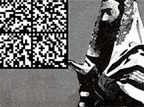
A Street History in Semacode
eRuv: A Street History in Semacode, by Elliott Malkin, is a digital graffiti project installed along the route of the former 3rd Avenue elevated train line throughout Lower Manhattan. This train line was part of a religious boundary called an eruv for the immigrant Polish Chasidic Jewish community in the first half of the 20th century.
The train has since been dismantled and most of the Chasidic Jews have moved away, so what was once both a physical and symbolic enclosure is now purely imaginary, a psychic boundary that intersects present-day communities in Lower Manhattan, most notably in Chinatown.
Each location along the eruv corresponds to a semacode ID. New Yorkers or tourists using a compatible camera phone can receive audio content (in Chinese, Spanish, Yiddish, and English) associated with that location, true stories from the past associated with that point in space. Participants will also have the option to leave their own "oral history," a voice message about their experience with that same space or a reaction to the historical reconstruction.
It is important for eRuv to be provided in the above four languages, as the purpose of this project is to undermine the sorts of boundaries that separate cultures in New York across time and space. eRuv uses boundaries and awareness of boundaries as a way of undermining those very cultural boundaries.
The work will be part of the Provflux, an event dedicated to artistic and social investigations in psychogeography. May 27-29, in Providence. [blogged by Regine on near near future]
Posted by jo at 07:02 AM | Comments (0)
April 26, 2005
Provflux 2005
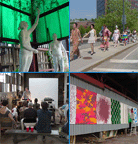
Implementation to be Featured
"Nick and I recently got word that Implementation has been accepted by Provflux 2005, both as an Intervention (live event) as an exhibition. Implementation’s second gallery exhibition will take the form of mounted photos from the project, a DVD of distance shots, and take-home sticker sheets on display at CUBE2 Gallery in downtown Providence, Rhode Island from May 19th until the end of the month, and we’ll be in Providence May 27th-29th for the event itself, with a goal of distributing, placing, and documenting the entire novel in one weekend in one location. Bring your digital camera and camping gear if you want to join us. Implementation joins about 50 other public interventions, games, urban exploration, lost space recovery, and tech mapping projects for this fluxist/situationist/public art happening." [blogged by Scott on grandtextauto]
Posted by jo at 09:10 AM | Comments (0)
April 25, 2005
Itinerant

A Site-Specific Sound Installation in Boston Common
Itinerant--by Teri Rueb--is a site-specific sound installation in Boston, Massachusetts. It invites people to take a walk through Boston Common and surrounding neighborhoods to experience an interactive sound work that re-frames Mary Shelley's Frankenstein, the classic tale of conflict between techno-scientific hubris and the human spirit. The project engages a search for an elusive character who is doppleganger to both the doctor and the creature. Sounds, 'played' by visitors as they move through the city, create a series of frames within which to reflect upon our highly mobile, technologically saturated society and issues of identity, place, and displacement. Mobile and locational media (GPS) formally underscore themes in the work. The sonic overlay is also presented as an interactive map on the web, creating a formal re-framing and displacement of this site-specific work (needs Flash Player, headphones and broadband connection).
Equipment may be picked up through May 7, 2005 at the Judi Rotenberg Gallery, 130 Newbury Street, Boston. "Itinerant" is a 2005 commission of New Radio and Performing Arts, Inc. (aka Ether-Ore). It was made possible with funding from the Jerome Foundation and the LEF Foundation.
Posted by jo at 01:34 PM | Comments (0)
Location33
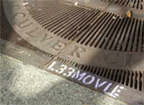
Envisioning Post iPodalyptic Mobile Music
Location33 investigates the potential for new types of music made possible by location tracking and wireless technologies. Listeners, with a GPS enabled PDA or mobile phone, walk around downtown Culver City, California and create a musical album that merges the traditional model of the song cycle with interactive narrative, location awareness, and game play.
Twenty nodes throughout the Culver City area act as portals into the world of the album. Each node is linked with a fragment of a song and when a player approaches one of the portals the music file is streamed to their device.
Each day a specific song is active. It is composed of fragments representing a verse, a chorus, or a bridge. As players walk around, they piece together the fragments, and develop the sense of their path being a song. Each day yields a different song, and all of the components for each day are composed within the limits of a singular musical idea or theme. The album is generated over the course of the week.
The album also focuses on a particular story element, which is sung by one of the characters, Mack, Mackbot, or the Narrator. It is up to the player to discover these musical story fragments and piece them together to form a cohesive story. In particular, the Narrator’s purpose is to contextualize the album within the setting of Culver City and to help the player with hints and instructions.
Location33 also adds elements of game play, asking the player to move around the space to find story fragments in a type of musical and narrative scavenger hunt.
Besides, players can alter the temporal structure of the album, performing time travel operations to experience the album without having to be in Culver City on each day of the week.
Location33 is the thesis project of William Carter, student in Interactive Media at the USC School of cinema and TV.
Read the PDF and doc presentations to see how it works. [blogged by Regine on near near future]
Posted by jo at 12:17 PM | Comments (0)
Walking as Knowing as Making
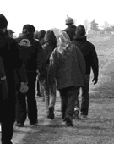
One Foot in Front of the Other
"With all the attention that 'locative media' seems to be getting within new media communities, it only makes sense that the actual process of moving bodies through space and place should be seen as a site worth investigating. The history of artists exploring the performative nature of walking--from Richard Long to Yayoi Kusama--provides one starting point for many contemporary practitioners. To give this developing history some context, the College of Fine and Applied Arts at the University of Illinois at Urbana-Champaign is hosting a symposium called Walking as Knowing as Making: a Peripatetic Investigation of Place.
About to start it's fourth, and final, session, the symposium has already delved into the social, environmental and aesthetic dimensions of walking with talks and guided walks by such notables as long time 'walking artist' Hamish Fulton. The upcoming fourth installment, beginning on 28 April, includes presentations by artist Walid Raad (of the Atlas Group) and architectural theorist Jane Rendell among others. If you're too far to walk to the events, you can find discussions and documentation from the symposium online. - Ryan Griffis, Net Art News, Rhizome.org
Posted by jo at 10:53 AM | Comments (0)
lifeClipper

The Walking Experience
lifeClipper is an open air art project. It offers an audiovisual walking experience in a virtually enhanced reality. Technically it is based on portable computer equipment worn by an individual. When walking around in a chosen culturally interesting area or impressive landscape the visitor's position and viewing direction is measured by means of GPS and the found situation augmented according to defined presets. Image and sound are displayed on an HMD (Head Mounted Display). Live captured image and sound are treated in real time by altering parameters as well as by adding music (composition, spoken text and sampling of documetary material), photo and video material (documentary and fictively arranged).
Through interventions on habitual ways of listening and seeing, reality becomes questioned and day-to-day situations become an adventure. Users feel as though they are watching a film in which they participate as active observers and in which they get attention from virtual players. The borders between subjective and objective perception become blurred as the user is immersed into space and action but also contemplates artistic compositions and cultural reflections. Read a review.
Posted by jo at 09:28 AM | Comments (0)
Loca: Location Oriented Critical Arts
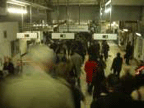
Discoverable
Loca: Location Oriented Critical Arts is an interdisciplinary project on mobile media and grass-roots, pervasive surveillance. A person walking through the city centre hears a beep on their phone, glances at the screen and sees a message: "We are currently experiencing difficulties monitoring your position: please wave you network device in the air." Or "Our server suggests that you may be late. You haven't been charged for this advice."
Loca looks at what happens when everyone can track everyone, when surveillance can be effected by consumer level technology within peer-to-peer networks without being routed through a central point. The idea is to enable anyone with a device that has Bluetooth set to discoverable to be tracked.
As the project develops inferences based on analysis of the data (sever-side) will guide communication with the Bluetooth users. People should be able to participate to the project through their own mobile phone without any additional technology, and without their device needing to be modified in any way.
Pervasive surveillance has the potential to be both sinister and positive, at the same time. The intent is to equip people to deal with the ambiguity and find their own conclusions.
A project by Drew Hemment, John Evans, Theo Humphries, Mika Raento.
[blogged by Regine on near near future]
Posted by jo at 07:25 AM | Comments (0)
April 22, 2005
Footsteps of Hans Christian Andersen
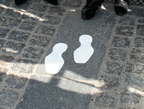
Footstep Hack
"A virtual discovery of Copenhagen in the footsteps of the famous author Hans Christian Andersen has been hacked, possibly by 'gay-activists'. Footsteps of Hans Christian Andersen - A Sound-Walk through the author's Copenhagen is a part of the Danish celebration of the 2005 HC Andersen bicentenary. The project invites people to follow in his footsteps and listen to audio narratives via their mobile phones at selected locations.
The route is marked with 2000 footsteps painted on the sidewalks - however, by adding a few extra footsteps it was diverted to the doorstep of local gay-clubs. The small hack might be a statement, rather than a prank. The HC Andersen anniversary has been criticized by the gay community for ignoring the author's homosexuality. E.g., a papercut by HC Andersen portraying two men holding hands inside a heart was used as a motif in a Christmas decoration by the fashionable department store Magasin du Nord - but instead of two men holding hands, the original artwork was 'corrected' to a woman and a man." See article (Danish) [blogged on guerrilla-innovation]
Posted by jo at 01:17 PM | Comments (0)
Sound as Multi-User-Choreography
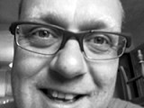
Steve Symons in Conversation with Sabine Breitsameter
"During the last months, the Manchester based artist Steve Symons has been presenting his interactive sound installation Aura in Europe and North America, on big public squares.
Aura is based on the Global Positioning System, which means that it relates sounds to the respective positions and movements of the environment's visitors. Each visitor has to wear a headset and a small rucksack on the back. By this, not only the individual sound-space relationship becomes audible, but also, the visitors are able to distinguish other installation's participants from the passers-by." Continue reading Sound as Multi-User-Choreography
Posted by jo at 09:55 AM | Comments (0)
April 20, 2005
9PIN

Mapping the SCAN Community
In summer 2003, a call for artists was sent out for the project 9PIN. The call asked artists to respond to the (then) 9 geographical locations occupied by the consortium members of SCAN. Proposals were submitted for a series of residencies and commissions looking at the possibilities for networking and mapping in the SCAN community. James Coupe, Hedley Roberts and Rob Saunders, Hywel Davies, Armin Medosch and Ivan Pope were chosen because of their range of inventive approaches to the SCAN network.
From Armin Medosch’s data visualisation research starting with a comparison between real and virtual ports through to Hywel Davies’ compilation of a sound database, gathered from each of the consortium venues, for the composition of new material by both himself and other musicians and composers, each of the artists involved in 9PIN makes a significant contribution to their own areas of practice and dissemination of content, whilst helping SCAN to cohere a very disparate group of organisations brought together by their desire to collaborate on high quality experimental work.
Ivan Pope brings his sketches and ideas using GPS, to enhance his interest in psychogeography, to his workshops, while James Coupe and Hedley Roberts take on the difficult task of examining and building an intelligent system which reflects activity (data drawn from sensors installed at SCAN’s member organisations) at each venue in the SCAN network.
The 9PIN project is premised on research and development and brings together artists and makers who are at the forefront of their field. This is a flagship project for SCAN and sets a precedent for the organisation’s aspiration to facilitate an environment for practitioners to develop their process outside of other areas of institutional research whilst working towards high quality outputs for the SCAN network.
SCAN is the innovative new media arts agency in the south of England. As a network of organisations, SCAN is committed to the delivery and facilitation of collaborative works.
"SCAN presents a unique model of networking across a number of diverse arts organisations in the south of England. We commissioned the 9PIN project to explore the network and build a model for SCAN as a whole. We invited artists with an interest in data analysis and mapping to produce a body of high quality work. They have come up with some extremely creative interpretations of the commonalities and differences across the organisations in the network"- Helen Sloan, Director of SCAN
The aim of 9PIN was that each artist should make a significant contribution to their own area of practice, whilst helping SCAN to make connections between the disparate group of organisations that constitute the SCAN network. 9PIN is a flagship project for SCAN and sets a precedent for the organisation’s aspiration to facilitate an environment for practitioners to develop their process outside of other areas of institutional research whilst providing high quality outputs for the SCAN network.
Posted by jo at 09:50 AM | Comments (0)
d>Art.O5
![]()
Distributed Art
d>Art.O5 is the eighth edition of dLux media arts acclaimed annual showcase of recent Australian and International single channel, short experimental digital film and video, web and sound art. Under the sub-title "Distributed Art" d>Art.O5 will both focus on art forms that have an inherently distributed nature (web art, mobile phone art) and investigate new methods for distribution of digital art. (podcasting, BitTorrent, Bluetooth etc.).
d>Art.O5 will consist of an exhibition of sound, web, and mobile phone art and a screening program of experimental film and video art. The exhibition will take place at the Sydney Opera House Exhibition Hall in August/September 2005. The screening program will be presented during this same period.
dLux media arts is now calling for works for the following categories of d>Art.O5:
- d>Art.O5 Screen: Open to Australian citizens or permanent residents only
- d>Art.O5 Sound: Open to Australian and International artists
- d>Art.O5 Web: Open to Australian and International artists
During the exhibition the sound and mobile phone art will be available for distribution to the private devices (mp3 players, mobile phones) of the visitors. After the exhibition period, the sound and screen works will be distributed online through podcasting and BitTorrent, respectively. The web works will be presented in an online gallery on the dLux media arts website. All distribution will be under a Creative Commons Attribution-NonCommercial-NoDerivs License.
The call for entries closes on June 15th. Any entries not completed by this date will not be accepted. Entrants will be notified of the selection results by July 1st.
For more information and to make a submission to d>Art.O5, please visit http://www.dlux.org.au/dart05
Posted by jo at 09:38 AM | Comments (0)
April 19, 2005
Mogame + IPerG
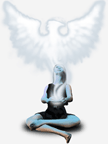
Body and Game Controller
"One of the central features in the future will no doubt be networked play. Most traditional games are inherently social, and a mobile gaming device with network access provides opportunities for social gaming virtually anywhere, anytime. The possibilities for new game mechanics, taking advantage of the full range of contextual information provided by pervasive systems, expand the research and design space further. This is one of the major research directions being explored by some ongoing projects in the Tampere GameLab. This is also where new approaches to Huizinga's bounded 'magic circle' of game playing are tried out and investigated." From The City Shaman Dances With Virtual Wolves–Researching Pervasive Mobile Gaming by Frans Mäyrä, Receiver #12.
Posted by jo at 11:24 AM | Comments (0)
2home, james
![]()
Guarantee of the Performative
"Via text messaging English might evolve the markers of a locative case. Like Finnish with suffixes, e.g. houseto, clubto, house2, club2. But more likely with prefixes, 2house, 2gym. Very telling about the phenomenology of pointing, mapping and readiness to go.
There is an archaic locative case in Latin, which primarily was used in references to cities and small islands. But also, apparently, military command ("militiae"). When one thinks about it, the locative has much in common with the imperative, what Deleuze and Guattari, after Foucault, call "order-words," a kind of hierarchical sign. An order-word implies Austin's guarantee of the performative, sometimes covert, the "I make this so" of announcement, pronouncement, declarative, ontological presentness, magic. But more than that: the thing itself, which is often a scenario whose context bleeds far into the recesses, is so. (The classic example is marriage.)" From 2home, james, blogged by tobias van veen on MDCN.
Posted by jo at 09:35 AM | Comments (0)
April 13, 2005
PUBLIC TRANSPHERE
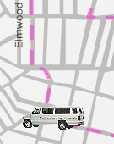
A Two-Way Mobile Communication Solution
Public Transphere is a free public transportation service for passengers from different parts of the city. Riders are encouraged to discuss their everyday realities, share opinions and exchange concerns about their communities. The event aims to bring residents of Buffalo together on an itinerant free speech platform, creating a nomadic, convivial environment in which they can converse about the communal experience of living in Buffalo.
Jesse Fabian imbues the vehicle with a small amount of self-awareness through sensation and self-localization. Through its many eyes, ears, its mechanical and electronic self-analysis, its data links, and its sensitivity to space, the vehicle assembles elements to form a picture of its whole self. The vehicle is reactive to its environment and its occupants. It participates in the journey as its passengers do.
Paul Visco will be manipulating live data collected by Jesse Fabian en route and enabling the public to explore these images, audio streams and GPS data feeds at http://www.public-transphere.info. At this site, the public will also be able to communicate live with the participants in the Public Transphere project, creating a unique two-way mobile communication solution during the event.
Public Transphere will be a two-day public event, taking place in a van touring three Buffalo neighborhoods: Allentown, the Buffalo Niagara Medical Campus and the Fruit Belt. The bus will be traveling among these three areas on Saturday, April 23 and Sunday, April 24 between the hours of 11:00AM and 2:00PM and from 3:00PM until 7:00PM.
Date: Sat. & Sun., April 23 and 24
Time: 11:00AM – 2:00PM, 3:00AM – 7:00PM
Place: Allentown, Buffalo Niagara Medical Campus, Fruit Belt
Cost: Free and Open to the Public
Contact: Arzu Ozkal Telhan at ao9 @ buffalo.edu and 716 - 400 6728
Public Transphere is the thesis project of Arzu Ozkal Telhan, an MFA candidate in the Art Department at University at Buffalo. Arzu Ozkal Telhan, Minoo Amini (UB, Center for Urban Studies), Jesse Fabian (UB, The Department of Media Study) and Paul Visco (UB, The Department of Media Study) are collaborating on this project.
Posted by jo at 10:45 AM | Comments (0)
April 12, 2005
Urban Tapestries
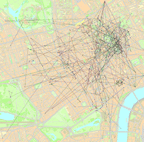
Experimental Ethnography, Technological Identities and Place
"Urban Tapestries provides a mobile location-based platform to connect people with the places they inhabit through their stories, experiences and observations. Currently based on an 802.11b mesh network in the heart of London, ordinary people author their stories of the city and embed them in the places that inspire them. Others who are logged into the system can read these stories, author their own and engage the largely invisible, multidimensional layers accumulating in the city. Our research asks if people use UT in meaningful and interesting ways. Drawing from theories of everyday life and urban space, we have developed experimental ethnography as a method for investigating the relationships between communication technologies, users and the socio-geographic territories around them. [blogged on pasta and vinegar]
Respondents are asked to play with an early Urban Tapestries prototype and this research explores what they do, their technological identities, their relationship to place and the meanings they generate. Urban Tapestries facilitates the negotiation of boundaries and we found that it does augment notions of connectivity – to place and to those within that place. However, our research revealed that some do not interpret this connectivity positively." From Urban Tapestries: Experimental Ethnography, Technological Identities and Place, an LSE Electronic Working Paper by Roger Silverstone and Zoetanya Sujon.
Posted by jo at 12:40 PM | Comments (0)
April 08, 2005
Mobile Digital Commons Network Symposium
![]()
Sampling the Spectrum: The Politics, Practices and Poetics of Mobile Technologies
Hosted by the Mobile Digital Commons Network (MDCN), this symposium--May 5th-8th, 2005, Montréal, Canada--examines the impact of mobile culture and the evolving idea of a wireless commons. Over the course of four days, we will investigate how wireless technologies enrich and modify public life in Canada, challenge our notions of space and place, and shape our day-to-day experiences.
Leading researchers, scholars and artists from around the world have been invited to present their cutting edge work in these fields and contribute to an ongoing discussion on these subjects. This event will also serve as a public unveiling of the projects that constitute the launch of the MDCN.
The MDCN connects those members of the academy, the arts and industry whose work revolves around mobile, wireless, and digital technologies in Canada. Funded by Canadian Heritage, our goals are threefold: to facilitate interdisciplinary research; to foster cultural production and public participation; and to develop forward-thinking policy on wireless technologies.
Posted by jo at 02:26 PM | Comments (0)
The places of locative media
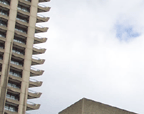
Case, not Place
"Karlis Kalnins said that "Locative is a case, not a place" - which sounds catchy but confuses me.
If the locative case "indicates a final location of action or a time of the action" then how is 'locative' not a place? From what I gather, Karlis was trying to introduce the concept of time, but I've never seen a definition of location that excludes time. Location and its most common synonym, situation, are always already space-time coordinates. [blogged by Anne Galloway on purse lips square jaw]
To me, what makes the locative case most interesting is how it expresses the cessation of movement, or the end of mobility. So side-stepping the disciplinary society vs. society of control debate, I'm intrigued by the tension that exists when mobile technologies are used to stabilise or freeze relations.
[Note to self: find out if anyone has discussed locative media representations in terms of diagrams, indexes, signs, icons and/or symbols. See A Thousand Plateaus p. 142 for definitions]
And I'm not sure exactly how this is related, but I keep thinking about this NY Times story about people taking pictures of the Pope:
"In the past, pilgrims would take away with them a relic, like a piece of cloth on the saint's body. Here there's been the transposition to a level of unreality. They're bringing home a digital relic ... With the cameras of the world focused on it, St. Peter's has become the sancta sanctorum of the digital world. While they're waiting in line they could be chanting or praying but instead they're taking pictures because they're caught in a parallel event.""
Posted by jo at 09:44 AM | Comments (0)
Pervasive Connections
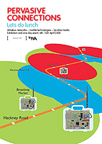
Lets Do Lunch
PERVASIVE CONNECTIONS/LETS DO LUNCH A one day event and exhibition focusing on opportunities for artists and local communities to work with new social technologies.
TAKE2030 takes its richair wireless lunchboxes out to lunch in Hackney and brings the conversations back to Space. Let's Do Lunch tracks Hackney's public access wireless connection points along bus route 26. Lunch dates will be set up with community members to exchange practical skills and visions for a wireless Hackney. The exhibition at SPACE will include a map of Hackney's wireless outposts along bus route 26, documentation of 7 lunch dates and auto transmitting wireless lunch boxes. Pump the signals, realise a wireless Hackney.
Pervasive Connections/Lets Do Lunch
Wireless Networks - Mobile Technologies – Locative Media Event
Saturday 16th April 10.30 – 5pm
Exhibition 6th – 16th April (Weds – Sat 1 TO 6pm)
SPACE, The Triangle, 129–131 Mare Street, London E8 3RH
£5 (includes lunch) booking required
Talks:
Introduction to Wifi - Saul Albert from Wireless London
Artist talk by TAKE 2030 linking to the exhibition Lets Do Lunch.
Workshops:
Network self provision– James Stevens Making flowers with palm top devices – Peter Chauncy Film for mobile phones – Melissa Bliss and Jes Benstock Public authoring and sharing local knowledge – Giles Lane
Panel discussion:
Featuring artists, activists and media practitioners, including James Stevens, Peter Chauncy, Graham Harwood, Matsuko Yokokoji, Rokeby, TAKE 2030, Indri Tulusun. Chaired by Pete Gomes – Wireless London
Let’s Do Lunch - 6 April – 16 April 2005. (Wed – Sat, 1-6pm)
Pervasive Connections/Lets Do Lunch is organised by Space and inIVA as part of Discover Hackney.
Booking To book a place on the one day event ‘Pervasive Connections’, please contact SPACE Media Arts on 020 8525 4344 or spacemedia@spacestudios.org.uk
Further information
http://www.spacemedia.org.uk
http://www.spacestudios.org.uk
http://www.iniva.org /
Directions
Bus: 26 & 48 from Liverpool Street, 106 & 254 from Bethnal Green, 55 from Old Street.
Tube: Bethnal Green.
Train: Hackney Central Silverlink.
Posted by jo at 09:19 AM | Comments (0)
April 06, 2005
PLAN Slides
![]()
Presentation Slides Now Available
The slides from the first PLAN event are now availaible. Pervasive and Locative Arts Network [PLAN] is a new international and interdisciplinary research network in pervasive media and locative media funded as part of the Engineering and Physical Sciences Research Council (EPSRC) Culture & Creativity programme.
The network brings together practitioners from a range of disciplines including artists, technology developers and ethnographers, with the aim of advancing interdisciplinary understanding and building consortia for future collaborative projects.
Posted by jo at 07:45 AM | Comments (0)
March 31, 2005
SCOOT
![scootFront[1].gif](http://www.turbulence.org/blog/images/scootFront[1].gif)
Tool for Enhancing Relationships Between Specific Groups and New Urban Spaces
SCOOT is a mixed reality experience designed by Deb Polson and Marcos Caceres, to explore the potentials of location-based games. Players have to solve clues located both in the real world and the virtual world. They interact with strange objects, receive information via SMS to their phones and have to text their answers to the games clues back to SCOOT.
As part of their journey around the site players will be introduced to the area and its surrounds. This orientation will not only be spatial, as the game explores also the history of the place and its dynamics. [via near near future]
Posted by jo at 11:08 AM | Comments (0)
March 30, 2005
GPS-Art
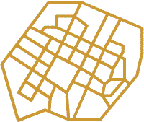
GPS-Trans Net-Cellphone Performances
GPS-Art is a new field of art activity based on motion in open spaces. GPS-Art is the global interactive instrument used for the creation and processing of audio and video material. It integrates elements of audio-visual installation to be used as a new media transmission. The project is based on large outdoor scales of cities and open spaces; it is ready to be realized on land, air, underwater as well as in outer space.
All GPS-Art projects use the GPS-12 device (Global Positioning System), as well as the cell phone system. GPS-12 refers to the 12 satellites hanging above the Northern half of the globe; it's used for navigation and measures in an interactive way many topographic parameters including latitude and speed. These measurments are the starting point of many art projects of GPS-Art. Since 2001 GPS-Art has been realized by a series of GPS-Trans net-cellphone performances.
Posted by jo at 05:13 PM | Comments (0)
FLOATING POINTS 2: Networked Art in Public Spaces

Tune in TONIGHT!
WHO: Pete Gomes and 38 North 118 West’s Jeff Knowlton + Naomi Spellman; DATE & TIME: March 30, 2005; 7:00 p.m. (EST, US); VENUE: Emerson College, Bill Bordy Theater, 216 Tremont Street, Boston and streamed live.
PETE GOMES' work fuses new technologies and cinema. His "Geocinema" project utilizes Global Positioning Systems (GPS) and other devices to explore what it means to be able to return to the exact location where a film was made and how to utilize this ‘unseen’ information in the film. Gomes is a freelance director and digital film lecturer at the Architectural Association, London. He is also founder and director of "Park Bench TV" and "mutantfilm."
38 NORTH 118 WEST focuses on site specific experimental works utilizing digital media, computing, and internet resources, and explores inventive ways to use GPS technology with rich cultural content. Jeff Knowlton is an artist, musician, lecturer, programmer, and museum preparator. Naomi Spellman is a transmedia artist and educator. Both teach at the University of California, San Diego.
FLOATING POINTS 2 is co-presented by Emerson College and New Radio and Performing Arts, Inc. (NRPA), a New York-based organization that opened an office in Boston in 2002. The series is made possible by Emerson College and the LEF Foundation.
Posted by jo at 08:55 AM | Comments (0)
March 29, 2005
The Royal Society of Emotional Geocachers
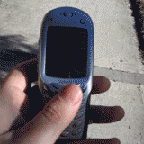
Place is Story>>Character Equals Space
Navigate a hypertext journey of sound, image and video where stories and characters intersect over time and across the city geography as one link leads you on foot to another. Available via GPRS on your mobile phone, or download from the internet on to your PDA (such as a Palm Pilot).
"This site exists for members of the society to document key personal experiences at specific locations. Please join us and add your own story of place. We've designed this site specifically for mobile devices so members may read & comment upon other members experiences in situ. The Rules; be true, place is story, character equals space, every story must connect to another story. Every tale must contain gps co-ordinates, maps and directions."
Posted by jo at 02:30 PM | Comments (0)
March 28, 2005
teletaxi
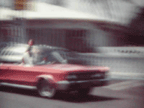
Car #235
Year Zero One is pleased to present teletaxi, a site-specific media art exhibition in a taxicab. The taxi is outfitted with an interactive touch screen that displays video, animation, audio, and information triggered by an onboard GPS (Global Positioning System) receiver which allows the displayed artwork to change depending on where the taxi is in the city. With the combination of the media/gps technology, the mobile environment and the passenger/audience inside the cab. The eleven artists in teletaxi are offered a unique set of possibilities for showing their work - both technically and thematically.
teletaxi will expose interactive media art to a normally passive audience, by presenting works that explore notions of intimacy, mapping, subterranean space, simulated cities, information architecture, data-visualisation, public interventions, surveillance and psychogeography.
Presented by Year Zero One, in Montreal, from March 21 to June, 2005. As part of the DIS/LOCATION: projet d'articulation urbaine programming of DARE-DARE Centre de diffusion d'art multidisciplinaire de Montréal.
Michael Alstad; Mario Côté; Milutin Gubash; David Jhave Johnston; Patric Lacasse; Virginie Laganière; Valérie Lamontagne; Éric Raymond; Doug Scholes
Camille Turner; Myriam Yates.
Opening Friday April first, from 5PM to 9PM, at Square Viger.
Join us at Dare Dare (Square Viger) for a 'fare free' ride in the teletaxi to navigate some of the neighbourhoods and Montreal sites explored by Year Zero One artists and guests.
To reach Taxi Co-op of Montréal, call at (514) 725.9885 and ask for car #235; For more information, contact Dare Dare at (514) 878.1088
[Related]
Posted by jo at 12:54 PM | Comments (0)
March 25, 2005
Pervasive Game Development Today
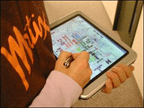
24/7 Immersion
"...Pervasive gaming was first the vision of Swedish company It's Alive!, meaning location-based games that surround you, 24 hours a day, everywhere. When you walk down the street, you're walking through an adventure world draped on top of the real world, and people you meet may be characters in the same game you're playing. Pervasive games are built upon three core technologies: mobile devices, wireless communication, and sensing technologies that capture players’ contexts. It is actually the blend of technologies combined with the location-based and often public nature of game play, gives pervasive games their distinctive identity [Bridging the Physical and Digital in Pervasive Gaming]." From Pervasive Game Development Today by Fabien Girardin.
Posted by jo at 02:10 PM | Comments (0)
March 24, 2005
Blast Theory presents Can You See Me Now?
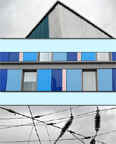
Join the Hunt
Played online and in the streets, BAFTA-nominated Blast Theory challenge you to a game of cat and mouse around a virtual map of Cambridge. Log on using the public terminals situated in the Junction's new café bar or play online at canyouseemenow and be dropped in at a random location from where you must avoid capture by the Blast Theory 'runners'.
Eavesdrop on your pursuers' conversations and swap tactics with other players as Blast Theory (as real actors positioned on the real streets of Cambridge) hunt down your virtual presence with the aid of handheld computers and GPS technology. FREE to play. April 1st-3rd 2-5pm; April 6th-8th April 4-7pm at The Junction, Cambridge.
Artists' Workshop: April 6th 1-4pm; £5/£4 concessions
The player is a key feature in all Blast Theory's work. This afternoon workshop will look at how the audience engages directly with an artwork, in dialogue with other 'players' and the artists.
Using the player as a focus, participants will respond creatively to site/space, game structure and forms of media/communication technologies to inform and stimulate their own media and performance practice. Finally all participants are welcome behind the scenes at 4pm to look at the hardware, software and performance preparation of 'Can You See Me Now?' Blast Theory's award-winning interactive game, presented by the Junction.
Suitable for artists looking to expand their understanding on new performance technologies, participants should come prepared to move, draw and talk.
To book a place call the Junction box office on 01223 511511 or visit in person at The Junction, 2 Clifton Way, Cambridge, CB1 7GX. [via DAN]
Posted by jo at 11:42 AM | Comments (0)
March 23, 2005
Honey, I Geotagged the Kids

How collaborative cartography could enable us...
"...Whether it's wearable computing that tracks our locations no matter what we happen to be doing, cell phones that let us enter our locations, moods or other data, or even all the wireless nodes, satellites and grid networks capable of finding, resolving and comparing all this information, we're talking about an entirely wireless phenomenon. We're also talking about what might prove to the be ultimate legacy of all our hard work here in the wireless trenches: locative media.
The phrase itself was originally coined by Karlis Kalnins, of gpster.net, who applies the precise logic of linguistics to an otherwise seemingly vague field. "Locative is a case, not a place," Kalnins says, meaning it stands for a final location of an action or the time of the action. In other words, it doesn't just happen in space, like a map, but also in time..." From Honey, I Geotagged the Kids by Douglas Rushkoff, theFeature.
Posted by jo at 10:22 AM | Comments (1)
Drift
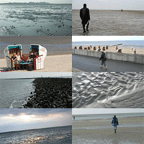
Being Lost
"The ubiquity of GPS (global positioning satellite) and other tracking technologies suggests that "being lost" may itself be an experience that is being lost. However, simply knowing ones geographical location as expressed in longitude and latitude coordinates has little bearing on ones personal sense of place or direction. Drift poses the age-old question "Where am I and where am I going?" in a contemporary moment in which spatial positioning and tracking technologies provide evermore precise, yet limited, answers to this question.
The installation embraces the flow of wandering, the pleasure of disorientation, and the playful unpredictability of drifting as it relates to movement and translation. Sounds blend footsteps on different surfaces with spoken word in different languages. Spoken word passages are drawn from poetry and literature dealing with the theme of wandering, being lost, and drifting. Meaning also drifts as Rousseau, Joyce, Kerouac, Mann, Dante, Woolf, and others are presented in the original and in translation. The Watten Sea becomes a metaphor for hertzian space as visitors are invited to wander among layered currents of sand, sea and interactive sounds that drift with the tides, and with the shifting of satellites as rise and set, introducing another kind of drift.
The installation covers a 2 km x 2 km region that is filled with areas of interactive sound. The region moves with the tide such that at low tide all the sounds are out on the Watt, at high tide they flood the town. Sounds play automatically as you wander through these interactive areas with a Pocket PC, GPS and headphones. The location of the areas changes constantly with the shifting tides - therefore, the best strategy for finding them is simply to wander."
Posted by jo at 09:47 AM | Comments (0)
March 15, 2005
The Transcultural Mapping Reader
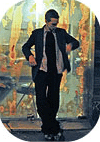
Setting a Boundary for Locative Media
This prototype category 'locative media', a term coined by Karlis Kalnins, was explored at a cross-disciplinary workshop at K@2 in Karosta, Latvia in late summer of 2003. Following discussions in Karosta, a series of Transcultural Mapping workshops were initiated by Rasa Smite and RIXC as part of the E.U. culture 2000 programme...Following the Transcultural Mapping (TCM) open call for papers Rasa Smite and Marc Tuters selected and edited texts for printed publication...and Rasa and Ben Russell put together this online TCM Reader, an extended collection of the raw unedited texts. The TCM Reader can be read as setting some boundary stones for the test category of locative media.
Posted by jo at 02:16 PM | Comments (0)
Treasure Hunt
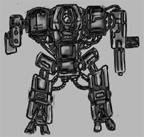
Game Zone
Treasure Hunt is a location based mobile phone game that uses GPS and internet enabled handhelds. We have hidden an imaginary treasure somewhere in your game zone and you must attempt using the clues we give you to try and find it. All players begin the game with one video or picture clue, and a number of multiple-choice answers, only one of which is the correct answer. Be careful when answering the clues, if you answer the clue incorrectly your next clue won’t be so helpful in your quest for the treasure, instead you might find yourself going in circles.
Posted by jo at 09:33 AM | Comments (0)
March 11, 2005
PLAN
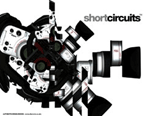
Reflections on the PLAN Launch
"...What is locative media? Judging from the PLAN gathering, locative media is the implementation of any context sensitive mobile technology – GPS, Bluetooth, wireless broadband, Sensors, RFID, etc. – to the end of actively examining and shifting how we interact with our physical environment and with each other. Projects span a wide range including social networking projects, walking projects employing digital mapping tools, and location aware games.
...Locative Media acts as an umbrella for a wide variety of post NetArt practices. As a genre Locative Media has limited currency. It will ultimately be subsumed by an increasingly integrated and ubiquitous computing infrastructure in our environment and by the prevalence of commercially oriented context-aware applications." From PLAN Report: Reflections on the Pervasive & Locative Arts Network launch at the Institute of Contemporary Art in London by Naomi Spellman, February 1-2, 2005, Net Art Review. [Related 1, 2, 3].
Posted by jo at 09:21 AM | Comments (0)
The Shape of Locative Media
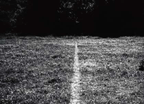
Mute, Locative Media and the End of Suburbia
The Shape of Locative Media, by Simon Pope MUTE 29:: 9.02.05.
"...(W)hat I found most interesting in this article is the focus on spatialising practices, tactics and strategies. He draws out an interesting tension between locative media projects working on a tactical level by resisting 'official' histories (through, for example, public authoring) and at the same time being implicated in institutional strategies of funding, research and development. He also points at tensions between Situationism, especially psychogeography, and Conceptual art as they may play out in locative media projects:
"There’s a wilful skimming of the surface of psychogeography, taking it to mean an unconstrained movement in the streets, and apparently less of an alignment with the wider project of anti-urbanism. This can leave an impression of a practice whose relation to ‘the city’ is closer to the disinterestedness of Conceptualism than the supposed engagement of the SI...[Situationist] devices for mapping the interactions and perceptions of human desires onto Paris, for example, were driven not by chance, as were the preceding scorned Surrealist interventions, but rather as a direct and conscious operation on the city..." [blogged by Anne Galloway on purselipsquarejaw]
The map, for Conceptual artists, seems more useful as a simple, generic method for recording the spatial aspects of a sculptural practice on an expanded scale...This leaves me wondering how those developing locative media understand themselves to be implicated in the spaces that they construct, record and annotate..."
This certainly resonates with my own wondering about how Situationism is being applied to locative media and pervasive computing. I have noted in the past that I'm troubled by the use of superficial Situationism to justify playful design practices rather than for socially and culturally critical approaches to technology and urban life. I've also expressed bewilderment at the lack of discussion about how the structure of GPS, absolute positioning, computing algorithms etc. actually conflicts with more fluid (social and cultural) understandings of spatial experience..." Anne Galloway
Posted by jo at 08:02 AM | Comments (0)
March 10, 2005
PlaceStorming: Performing New Technologies in Context
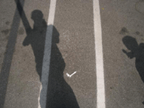
...Performative Aspects of Gaming
"ABSTRACT: We present PlaceStorming, an original method of brainstorming technological concepts, particularly in the area of pervasive computing. PlaceStorming is context-driven and play-based, combining real world environments with the immersive and performative aspects of gaming. In this paper, we discuss the background and techniques we used to create and deploy our method. Examples are drawn from a March 2004 PlaceStorming event to highlight key strengths of the method. Suggestions are made for what produces successful PlaceStorming sessions." From Place Storming: Performing New Technologies in Context by Ken Anderson, Intel Research, and Jane McGonigal, University of California at Berkeley. Proceedings for the 3rd annual Nordic Conference on Computer Human Interface (NordCHI 04)
The PlaceStorming project is a collaborative, pervasive play scenario that uses GPS data, mobile network technologies, and digital media devices to facilitate, as a public practice, context-aware and location-specific academic research. (Jane McGonigal is) developing it in conjunction with a Vectors fellowship from the University of Southern California. The technologies and media employed for v 2.0 are: text and Instant messaging; cell phones; handheld Global Positioning System devices; digital cameras; Web-accessible database.
Posted by jo at 05:23 PM | Comments (0)
Google Maps
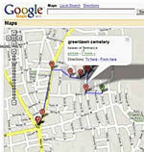
Google Mapping Location-Based Narratives
"My colleague Ken Tompkins recently sent along a link to John Udell’s Walking Tour of Keene. The short video demonstrates how Udell used Google Maps in concert with a bookmarklet to create a walking tour of an area in his hometown that rides on top of the Google Maps UI. Waypoints are marked with GPS data on the Google map and then linked to his content (jpgs and quicktime clips). Udell explains how he did it in a followup post. Other hacks to Google Maps are being posted on a Google Maps Hacking Wiki. Although the current hack is kludgey, it suggests exciting possiblities for location-based narratives that could be delivered in a web browser via the Google Maps interface." [blogged by scott on Grandtextauto]
Posted by jo at 10:03 AM | Comments (1)
March 09, 2005
Building a Mobile, Locative, and Collaborative Application
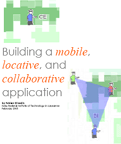
Catchbob Post Mortem
"I wrote a non-academic, post mortem type of document--Building a Mobile, Locative, and Collaborative Application [PDF]--on a treasure-hunt type, Wi-Fi based locative and collaborative mobile game I developed at the Swiss Federal Institute of Technology Lausanne.
The document describes the whole development process, from the technical architecture to the user perception of the game. I talk about the positioning system, the data, the communication tool as well as the user interface. It addresses a large audience. Techies and non-tech-savvy people should not be afraid to have a glance at it." - fabien [via Locative]
Posted by jo at 04:30 PM | Comments (0)
Habitat Perspectives
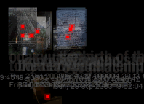
Space=Network of Places
In Habitat Perspectives you can follow the participants live as they post images to this application from the road through GPS enabled mobile media. The target is to conceptualise how the perception of the city differs from participant to participant depending on their everyday habits. Though in the beginning only a black background will predominate in the application, as participants post more and more content, a map of the city, and the map of each of the participants' "places" will slowly start emerging.
"Place is a special kind of object. It is a concretion of value, though not a valued thing that can be handled or carried about easily; it is an object in which one can dwell. Space, is given by the ability to move. Movements are often directed toward, or repulsed by, objects and places. Hence space can be variously experienced as the relative location of objects or places, as the distances and expanses that separate or link places, and - more abstractly - as the area defined by a network of places." Yi-Fu Tuan
Posted by jo at 12:45 PM | Comments (0)
March 07, 2005
Project Research and Software Toys
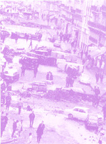
Miscellaneous
"...Situationist International Online: I’ve spent some good hours here recently. The situationists were anticopyright from the beginning, which has made this quite extensive archive of texts from the situationist movement which reached its height in the 1960s possible, including a complete archive of Internationale Situationniste and Guy Debord’s Society of the Spectacle.
Building a Mobile, Locative Collaborative Application: Documentation of the development of CatchBob, a treasure-hunt type, Wi-Fi based locative and collaborative mobile game. The game itself is fairly simple in concept:
The aim of the game for the participants is to find a virtual object on our campus and enclosing it in a triangle formed by their position. The positions are provided by a location-based tool running on a PocketPC or a TabletPC. This tool allows each person to see the location of his or her partners as an avatar on the campus map. Another meaningful piece of information given by this tool is whether the user is close or far from the object: an individual proximity sensor.
Lumiere Ghosting in the New Media Classroom: David Gillette describes a new media curriculum built around Lev Manovich’s The Language of New Media, and its focus on new media development as a form of interactive, multicultural cinema, and using a Cave-like display, the CompuObscura, an interactive new media art work that allows viewers to interact with images on display inside the device.
Jim Bugardner: the guy who invented the Palace avatar based chat system in the 1990s, has lots of generative art, doodads and neat little software toys at this site.
iStory Creator: an application made to allow people the opportunity to create their own iPod text games of the choose your-own-adventure variety."
[blogged by Scott on Grandtextauto]
Posted by jo at 11:07 AM | Comments (0)
March 04, 2005
Geographies of Technology:
Space and Place as Aspects of Specific Actions
"In this paper I would like to investigate some of these issues, specifically focusing on the roles which ‘place’ and ’space’ play in discussions about the physical world. I will argue that some of the existing discussions on ‘place’ and ’space’ have over simplified this distinction. For Place and Space, rather than being easily identifiable aspects of the physical world, are actually the battleground over which much conceptual discussion has raged in philosophy and the social sciences. Exploring these arguments, and contrasting the ways in which place and space have been used, is an entry point into thinking about some aspects of technology’s existence, physical extension and incorporaton into human practice." Geographies of Technology: Some Comments on Place, Space and Technology by Barry Brown.
Posted by jo at 07:55 AM | Comments (0)
March 03, 2005
Floatables
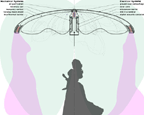
Spaces of Absence
Haque Design and Research asks the question "in an urban environment that is so data-saturated can a distinction between public and private space really claim to exist"? It is the contention of (Floatables) that private spaces are increasingly scarce. All spaces are public, except spaces of absence. If privacy once existed in the home, now such a space no longer needs to be tied to a particular location."
"...The aim of the floatable jellyfish-like vessels that drift around cities is to create temporary, ephemeral zones of privacy: an absence of phone calls, emails, sounds, smells and thermal patterns left behind by others. Through various electrical systems they are also able to prevent access of GPS devices, television broadcasts, wireless networks and other microwave emissions. Finally, by creating a "blurry barrier" and a ground-plane camouflage pattern, they provide shielding from the unembarrassed gaze of security cameras and surveillance satellites." [via]
Posted by jo at 01:34 PM | Comments (0)
March 02, 2005
YellowArrow at DiVA
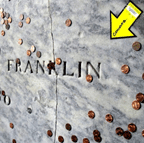
Art in Motion
Digital and Video Art Fair [DiVA] kicks off with an opening after party on March 10th that will definitely be an event in itself. The party will feature special performances by YellowArrow. Attendees are invited to participate in the art in motion. In addition to YellowArrow stickers’ distribution and projections displaying the content of the YellowArrow Global Gallery, mobile YellowArrows will point out a series of live micro performances staged throughout the party and announced via TXT messaging.
DiVA is the first art fair in the United States dedicated exclusively to digital and video art. DiVA will serve as an international destination for collectors, art dealers, museums, curators, and artists. Around forty galleries willfeature the diverse and innovative work of new media artists exploring and pushing the digital envelope. Digitally created work is a dynamic platform of expression in contemporary art that includes film and video, animation, photography, printmaking, sculpture, painting, architecture, and performance.
The YellowArrow is a global public art project that merges graffiti and sticker culture with wireless media, creating an interactive forum for people to leave and discover messages pointing out what counts in their environment.
Participants place arrows to draw attention to different locations and objects -- a favorite view of the city, an odd fire hydrant, the local bar. Each arrow has a unique code, and by sending a text-message (SMS) from your mobile phone to 1.646.270.5537 in the format "+code your message" you associate a short text with your arrow -- messages can range from literary quotations to personal commentaries to game-like prompts to action.
When another person encounters the arrow, he or she sends "code" to 1.646.270.5537 and immediately receives the message associated with it on their mobile phone. Through this location-based exchange of text-messages, the YellowArrow becomes a symbol for the unique characteristics, personal histories, and hidden secrets that live within our everyday spaces. And it's not just places, it's people: YellowArrow TXTshirts are individually coded just like the stickers.
YellowArrow text-messaging is currently compatible with all phones and service providers in the US as well as internationally with those networks under the GSM standard. The website, YellowArrow.org, allows participants to annotate their arrows with photos and maps and is the online gallery of YellowArrows placed throughout the world -- visit to order arrow stickers and tshirts and see announcements about new events and features.
Posted by jo at 11:16 AM | Comments (0)
February 28, 2005
Graffiti as Conversation

Spatial Annotation
"I've been photographing layers of conversation in graffiti, and tagging the pictures with conversation. Prior art for spatial annotation?
Spatial Annotation Projects: a (GREAT) list of spatial annotation projects and platforms. Thanks to physcomp, interactionfield and aware for inspiration." From elastic space [via]
Posted by jo at 02:14 PM | Comments (0)
Towards an Emotional GPS:

Writing Your Own City
"...Psychogeography and cognitive mapping offer two suggestions for recording wireless experiences, using a term we've coined, emotional GPS. Whereas traditional GIS (Geographic Information Systems) and GPS (Global Positioning Systems) tend towards an empirical representation of the world, emotional GPS is biased towards the personal, temporary, and imaginary. In most cases, the prevailing impact of wireless on the definition of a place is not so much on its static form as the potential experiences that this place can afford. The wireless environment provides an alternative use, an augmented interface, or new associative mnemonics. Providing an annotative mapping framework, use of emotional GPS fosters a networked mobility within these environments that undermines the authoritarian bent of traditional GIS and GPS mapping techniques." From Towards an Emotional GPS: Writing Your Own City by Scott Paterson, with Marina Zurkow and Julian Bleecker, Intelligent Agent, Vol. 3 No. 2.
Posted by jo at 10:52 AM | Comments (0)
Geo-Heritage
![]()
Flexible Storytelling
"...Storytelling is one of the oldest art forms of human beings; initiated in the oral tradition, its form has evolved with changes in society and available media with which to work. The oral storyteller often altered the tale as it was told, choosing words based on response from the listeners to build the collective moment. Of particular relevance here is the Australian Aboriginal storytelling tradition in which territory is not perceived of as a piece of land enclosed within borders but rather as "an interlocking network of 'lines' or 'ways through'" (Chatwin 1987). Sung into existence by the ancestors, these stories actually function as maps of their terrain that can be augmented by travelers to account. Interactive in the beginning with the advent of the written medium, storytelling, however, evolved into a non-interactive narrative style..." From Geo-Heritage: A Living Archive of Spatial Culture by Scot T Refsland, Marc Tuters & Jim Cooley. Also read Bits and Bytes of Locative Geo-Heritage by tV.
Posted by jo at 09:55 AM | Comments (0)
February 22, 2005
Experiments in Art and Technology (E.A.T.)
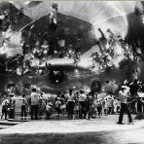
One Forgotten History of Transdisciplinarity
"At a recent meeting of PLAN I mentioned E.A.T. and drew a number of blank looks-so here is one forgotten history of transdisciplinarity and early locative projects:
Experiments in Art and Technology was founded in 1966 by engineers Billy Klüver and Fred Waldhauer and artists Robert Rauschenberg and Robert Whitman. The non-profit organization developed from the experience of 9 Evenings: Theatre and Engineering. This event, which was held in October 1966 at the 69th Regiment Armory in New York City (U.S.), brought together 40 engineers and 10 contemporary artists who worked together on performances that incorporated new technology. It became clear that achieving ongoing artist-engineer relationships would require a concerted effort to develop the necessary physical and social conditions. E.A.T. saw itself as a catalyst for stimulating the involvement of industry and technology with the arts. [blogged by Martin Rieser on Mobile Audience]
The organization worked to forge effective collaborations between artists and engineers through industrial cooperation and sponsorship. Membership was opened to all artists and engineers, and an office set up in a loft at 9 East 16th Street in New York.
Artists and the art community responded enthusiastically to E.A.T. By 1969, given early efforts to attract engineers, the group had over 2,000 artist members as well as 2,000 engineer members willing to work with artists."
Related: Whitman's Phones; PLAN Notes; and On Locative Media's European Reception.
Posted by jo at 02:04 PM | Comments (0)
February 20, 2005
digital cities project
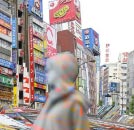
urban database as feedback loop
The Digital Cities Project is a collaboration between several Canadian research insititutions exploring digital technologies inthe urban environment. As part of the Mobile Digital Commons Network they presented at the Pervasive and Locative Arts Network [PLAN] workshop at the ICA in London on February 01-02.
The project research basis: Over the past two decades, several nations have embarked on a “digital” strategy to become key players in the new information economy. Interestingly, despite the heralded innovations these technologies promise, most nations have pursued a similar use of space and place to build isolated multimedia cities. Our research project investigates and analyzes four such multimedia initiatives beginning with the Cité Multimédia and Technoparc in Montreal. This project investigates traces of the “digital city” and its networks, from multimedia districts to virtual environments and mobile devices. The role of technology in the city has been an important focus of cultural research.
While earlier studies have concentrated on urban infrastructure such as electrification and transportation routes, new communications media have given rise to technological systems and networks that re-order the city. Through the workings of new communications media, the social and technological apparatus of cities is transformed, altering the terms of urban theory and representation.
This type of feedback loop not only expands the site of the "interface" from computer terminal to the city, but also multiplies types of input to encompass both physical and virtual data. Our research asks what would happen if the feedback loop were inverted, such that the city controlled the data, and the data's performance were always measured against the changing tides of urban life. Such a circular interplay challenges the discrete status of data, and instead requires a process of continual re-situating and adjustment within urban context. In this sense, we are reversing the logic of the feedback loop, which attempts to maintain system equilibrium in the face of disturbance. By privileging urban dynamics as the "command signal" that guides the data, the database becomes doubly urban, both documenting and being shaped by activities in the urban environment to form an expanded feedback loop.
Posted by michelle at 11:56 PM | Comments (0)
February 16, 2005
Urban Tapestries:

Experimental Ethnography, Technological Identities and Place
"Urban Tapestries provides a mobile location-based platform to connect people with the places they inhabit through their stories, experiences and observations. Currently based on an 802.11b mesh network in the heart of London, ordinary people author their stories of the city and embed them in the places that inspire them. Others who are logged into the system can read these stories, author their own and engage the largely invisible, multidimensional layers accumulating in the city. Our research asks if people use UT in meaningful and interesting ways. Drawing from theories of everyday life and urban space, we have developed experimental ethnography as a method for investigating the relationships between communication technologies, users and the socio-geographic territories around them..." From Urban Tapestries: Experimental Ethnography, Technological Identities and Place by Roger Silverstone and Zoetanya Sujon.
Posted by jo at 08:55 AM | Comments (0)
February 14, 2005
On Locative Media's European Reception
![]()
Lack of Diversity
Though the expertly moderated event maintained a relatively very high level of cohesion, a common criticism that arose in my discussions with other conference-goers regarded the perceived lack of diversity amongst Locative Media projects. While a few visionary art works generated some buzz...the field of Locative Media that emerged from this discourse-driven event seemed best expressed by two particular projects: Urban Tapestries and Blast Theory. While it is only a very young medium...it seems that Locative Media is developing its own stars system of artists supported by the State and, perhaps, somewhat more interestingly, by industry...
...In conclusion it is interesting to note some of Anne Galloway's words from the PLAN event. In her research, which involves Urban Tapestries as a case study, the leading academic in the area of locative media has come to question and problematise the very distinction between the new category of the artist/researcher in locative media, and that of the corporate researcher, suggesting that the latter had a much better developed sense of accountability, professionalism and ethics." From PLAN: On Locative Media's European Reception by Marc Tuters.
Posted by jo at 12:35 PM | Comments (1)
Teaching for the Wireless Commons
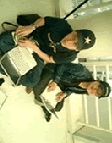
Interview with Elizabeth Goodman
[As part of WebCamTalk1.0]: Trebor Scholz: Please present your thoughts on new media education, in particular your course "Site-Specific: Wireless Networks and Urban Art Practice."
EG: This course was a mixed graduate-undergraduate seminar I taught at the San Francisco Art Institute with Alison Sant. The course examined radio signal as a medium for expression in its own right, with its own aesthetic qualities and cultural significance. It was a diverse class, with undergraduate and graduate students. The class focused specifically on sensing and representing wireless signals; we did not intend it as a technical class centered around any one tool. Using whatever medium they preferred, students were to create their own interventions into what Fiona Raby and Tony Dunne have called the "Hertzian space" of San Francisco. Final projects included a game, a proposal for a video installation, and a GPS-coordinated city tour. There have only been a few classes on wireless networks as art medium thus far, so there weren't many models to draw from.
TS: What did you learn from the experience of teaching a course with so little precedence?
EG: Learning from the experience of this course and from my own experience in school, I'd like to point to some larger issues about the state of interactive art education:
1) Art education: training for what?
2) The importance of historical perspective
3) Defining core curriculum
4) Moving the computing arts away from the computer
TS: Please describe the course more in detail.
EG: The Art Institute in San Francisco, for those of you who might not be familiar with it, is well known for its historical emphasis on conceptual art. Alison and I found that, as so often happens, our students were more comfortable with the conceptual. Partly, this is because it's easier to talk than build. But the greater issue was unfamiliarity with the underlying technologies of wireless networks "the physics of radio waves, the proliferating transceivers, the logging programs and the graphic interfaces" not to mention the pervasive fear of the unfamiliar. Even with the loan of wifi- , Bluetooth-, and GPS-enabled iPaqs from the Exploratorium, some were reluctant to experiment. And those that did were often daunted by the amount of time they had to spend troubleshooting the devices. An increasing number of people comes to courses such as ours with some knowledge of computers, but only few are comfortable with code.
Indeed, some of our students came in with far less knowledge of the tools of new media artists than we had expected. "New media" stretches from video and sound editing, to image manipulation, to animation, to interaction design, and code. The question of documenting and presenting a new media project gets complicated when you've never used a digital camera or created a web page. In addition, students were dismayed by the seemingly endless list of expensive equipment that visiting artists recommended. Laptops, GPS devices, PocketPCs, wifi-cards, specialized radio receivers. Some felt that the medium was simply unaffordable on a student budget, and the school was not planning on picking up the bills.
TS: This is a phenomenon that you also find with much of recent location-based cultural practices that require a whole set of hardware that it still unaffordable to most city dwellers.
EG: There's an interesting and common phenomenon that happens when students--anyone, really--attempts a new medium. You called it "techno-determinism" and I agree. It's a kind of blindness. The sheer difficulty of making any headway with unfamiliar and imperfect technologies such as PocketPCs running an interface to a Bluetooth GPS module, or a Flash animation, leads to the mistaken belief that the technologies themselves are the most interesting part of a project.
TS: How do you approach the confluence of art, theory and technology?
EG: Given students's understandable fears of new, unfamiliar, and un-user-friendly technologies, we need to actively reward exploration, experimentation, and sheer determination. However, the class as a whole suffers when the focus of discussion and critique moves from developing and expressing concepts to solving technical problems. Steering a course between technophobia and techno-obsession is harder than it sounds. One of the great challenges, I learned, of teaching "new media" classes that are not designed to be technical workshops is keeping promising concepts (that are often technologically interesting as well) from derailing into technological minutia. Throughout the class, Alison and I developed some strategies in response to techno-phobia, techno-obsession, and the sheer expensiveness of electronic equipment.
TS: How do you link these emerging cultural practices to their backgrounds in the history of technology, and culture at large.
EG: There is a tendency among the techno-obsessed to think that "new media" is somehow the product of a catastrophic, unbridgeable break with older tools and practices. Alison and I tried to locate the class within a longer history of site specific art and urban engagement. We started by asking students to think critically about the notion of "site" drawing on Robert Smithson's work, the notion of "non-sites" and on Gordon Matta - Clark's building deconstruction projects. We also used sources from urban theory, the Situationists and asked students to think about how we come to know a city "how we travel through it, how we map it, how we remember it. We found that bridging the old and the new produced richer conversations in new students " which is no surprise but also created a comfort zone for San Francisco Art Institute students who were already familiar with mid-twentieth century art movements.
TS: You mentioned that a few weeks into the class you asked students to switch off their computers and go to the drawing board.
EG: Yes, drawing and sketching also proved a useful introduction to the ideas and methods of the class. One of our most successful class exercises required students to create a map of the campus using only mobile phones, paper, and pencils. Working in teams, students had to both agree on how to represent mobile phone signal strength but also what areas they found most significant. The resulting critiques allowed us to talk about some core issues: the representation of temporality, definitions of site, and visualization of the invisible.
In fact, mobile phones became a cheap and accessible medium for students daunted by the expense or unfamiliarity of wifi-enabled laptops and GPS devices. For those of us who think in terms of code, it can be useful to step back and see mobile phones as a platform for development but also simple sensors in their own right. One student even used his mobile phone as a kind of game wheel, dynamically spinning paths through the city based on signal strength.
I would have loved to have my students build applications for mobile phones. But because the class blended art theory and practice, we had to think realistically about time management. We simply did not have enough time to both introduce key concepts and teach programming. As well, showing a project in a gallery is very different than supporting it on a city-wide level. Moving from the university lab to the streets means asking students to simplify their technical needs as much as possible.
TS: Could you come back to the four main issues that you introduced earlier? You started off with "Art education: training for what?"
EG: One of the subtexts running through in-class discussion was the desire to be taught specific tools, Photoshop or Flash, for example. There is a lot of fear about the high cost of education in North America, about getting jobs, and that is reflected in these demands for vocational training. I think many will agree with me when I say that undergraduate art courses should not focus on software. Defining education by the tools currently in vogue reduces learning to a set of instruction manuals. As we have all discovered, learning is often more a changing set of practices than abstract, static data.
Which brings me to my second point: defining a new media core curriculum. I think student calls for software-based training indicate a deep insecurity. Many students are not sure what they are supposed to know and how they are supposed to learn it. That is a very disconcerting situation. And part of the role of a faculty member is to answer those questions through curriculum development.
A curriculum is or should be the articulation of a community's understanding of disciplinary boundaries: what they value, what they exclude, what they require. I had a fairly traditional undergraduate art education, based around a choice of prerequisite classes: drawing, sculpture, photography, graphic design. Drawing was mandatory. As a master's student at New York University, I had another core curriculum: programming, basic electrical engineering, visual design, and communications. Everything was mandatory. Communications included training in Photoshop, video editing, etc. but it came wrapped in a larger conversation about the social significance of technologies.
I personally believe digital media core curricula should include programming and drawing. But I'm not the deciding factor in discipline-wide curriculum development. The faculty of every school has the responsibility to decide what their students should learn. I don't think we'd see wildly divergent curricula. But internal conversations need to happen so that consensus can emerge and students get consistent messages about what they need to succeed.
TS: An additional starting point was your emphasis of moving the computing arts away from the computer. Please elaborate.
EG: To me, this is perhaps the most important point: moving the computing arts away from the computer. One of our greatest struggles during the class was the fixation on the technical at the expense of the conceptual. We suggested refocusing projects, but more than once we found that students did not believe that sketching counted as part of their work as digital artists. Yet in retrospect, it's significant that the semester's most successful exercise was based on drawing.
For us, the lesson was that teaching the digital arts should not be confined to digital media. Many institutions without the budget for expensive equipment can use diagrams and formal logic as a proxy for circuitry. Nothing can totally replace learning by doing, but teaching the underlying principles of computing still helps students. As Casey Reas points out, code creates the tools we use; it's an important medium in itself. I think that teaching drawing can serve as an important bulwark against the fixation on technology, and it can remind students to focus on the underlying ideas that they strive to communicate.
So, I see several issues: I feel conflicted about the perception of the teaching of "new media" as something that is completely new. Another issue is thinking solely of what we produce as solely a function of media. I think we'll do ourselves and our students a service if we think less about newness, less about a specific media, and more about continuing art practices based around the implications of computing.
About:
Elizabeth Goodman's design, writing, and research focuses on critical thinking and creative exploration at the intersections of new digital technologies, social life and urban spaces. She has a master's degree from New York University's Interactive Telecommunications Program and has spent this fall as a visiting lecturer on site specific art and wireless networks at the San Francisco Art Institute. For a course bibliography visit www.molodiez.org/biblio_goodman.pdf. More examples of Elizabeth's work in urban gaming and cellphone interfaces can be found at www.confectious.net. [via Rhizome]
Posted by jo at 11:18 AM | Comments (0)
Peau d'Âne
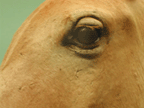
Locating Immaterial Materials
Peau d'Âne by Valérie Lamontagne: in the Charles Perrault fairy tale Peau d'Âne, a young princess, whose family's riches are dependent on a gold-excreting donkey, orders impossible wedding gifts from her father in order to avoid marrying him: three dresses made of immaterial materials. The first is to be made of the "sky" and should be as light and airy as the clouds. The second is to be made of "moonbeams" and should reflect the same lyrical intensity as the moon at night. The third, and last, is to be made of "sunlight" and should be as blinding and warm as the sun above.
Lamontagne will develop three wearables based on the Charles Perrault folk tale. Each dress--as a networked costume--aims to hybridize notions of computer interfacing and fashion. The "patterns" on the interactive material of the dress will morph according to information transmitted from a wireless weathervane to a computer chip implanted in the fabric. Utilizing wireless and solar-powered energy sources, Peau d'Âne goes beyond "making something out of nothing" and becomes a functional article marking another step in our aspiration to build truly ubiquitous objects.
InterAccess Electronic Media Arts Centre
Open Studio: February 19 - March 2, 2005
Work-in-progress Exhibition: March 4 - 24, 2005
Progress Presentations:
Saturday, February 19, 2005; 3 - 5pm
Saturday, February 26, 2005; 3 - 5pm
Valérie Lamontagne is a Montreal-based artist, freelance art critic and curator. She received her BFA (1993) and MFA (2001) from Concordia University (Montreal) where she is presently teaching in the Digital Image/Sound & Fine Arts program. Valérie has been exhibiting in and curating shows across Canada since 1997.
InterAccess is a centre for electronic media arts that enables artists and the general public to explore the intersections of art and technology. It is Ontario's only gallery and production facility devoted exclusively to electronic and new media art.
InterAccess Electronic Media Arts Centre
401 Richmond Street West, Suite 444
Toronto, Ontario, Canada
Gallery Hours: Tuesday - Saturday, noon - 5pm
Free Admission.
Related >>
Posted by jo at 10:56 AM | Comments (0)
February 12, 2005
Location-based SMS
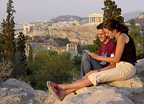
Virtual Post-Its
The German company Siemens, in collaboration with the Ars Electronica Center and the University of Linz, in Austria, is developing a new software called Digital Graffito that delivers location-based mobile messages. According to the new Siemens' press release (Feb. 02, 2005), the messages work as virtual post-its, that is, they are SMS attached to specific places. "When the recipient reaches the defined point, the message appears on his or her display. Unlike the classic SMS, the message is not sent to the addressee as such, but is only activated when the addressee comes within a defined radius of the location specified for the graffito. Another difference is that, if required, the message can be read not only by one person, but also by a number of cell phone users -- like a real graffito plastered on a building wall". One of the foreseeable applications for the software include tourism: tourists visiting a place could receive messages on their cell phones depending on where they are, and where they are looking at. It's like bringing the idea of the museum guided tour to public spaces. Although the software commercial release is only planned for 2 years from now, that's perhaps a sign of how location-based applications may be embedded in the ludic side of our lives in the near future -- besides location-based games. [Posted by Adriana de Souza e Silva]
Posted by at 05:33 PM | Comments (0)
February 10, 2005
Seamful Game
![ubicompclient[1].gif](http://www.turbulence.org/blog/images/ubicompclient[1].gif)
Glitches are Integral
Seamful Game, by Matthew Chalmers from the University of Glasgow (Scotland), is a GPS and WiFi based game played in the streets using PDAs. To be successfull, two teams of runners must develop an understanding of the network coverage and the effect of signal strength. It thus turns the patchy network coverage, usually seen as a problem, into an important feature of the game.
Players travel around a designated area collecting digital "coins" (which appear all over the map, including in places not covered by the 802.11b wireless network) and uploading them to get points. To gain these points, players must upload the coin to the server, by pressing the "upload" button on their PDA in an area where there is 802.11b coverage. If players attempt to upload coins in an area not covered by WiFi, the upload fails and they loose all the coins they are carrying. [blogged by Regine on near near future]
Only by understanding the boundaries of the network, and the effect of signal strength on their ability to upload coins, and thus score points, will players be successful in winning the game.
The "Pick Pocket" feature of the game allows a player to steal coins from other players nearby. The player has to be inside network coverage, and use the GPS to get within 10 meters of another player (also within network coverage). By pressing the "Pick Pocket" button, they can grab any coins the victim is carrying but has not uploaded yet.
Plus, scattered around the map are "Mines". If a player moves to within 10 meters of a mine, it will detonate and the player's PDA will be temporarily disabled.
Posted by jo at 09:36 AM | Comments (0)
February 04, 2005
Aware Project
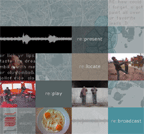
Mediating Fluid Memory
The aware project proposes an experimental location-based medium for mediating fluid memory, ‘story-making’, and aims to facilitate the (playful or critical) re-imagination of the lived city of Helsinki. It explores the positive potential of widespread use of networked, mobile media devices to raise awareness of communal relationships with place, and the real-time organisation/ disorganisation of spatio-temporal meaning.
The project concept is to enable participants to contribute images, sounds and text via their mobile device to a collective online database, to be rebroadcast to the public environment of their origin, either anonymously or tagged with a user-name. However the contributions may be moved around to other cell locations in the city, re-interpreting their meaning and potential relationship to other forms and place. This site has a wonderful Related Links page.
Posted by jo at 08:01 AM | Comments (0)
February 03, 2005
Mudlarking
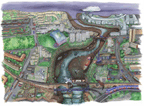
Imaginative Connections
Mudlarking is a reimagining of the traditional guided tour which empowers young people to engage creatively with their built environment. It involves users as co-designers, producing a tour by making use of mobile technologies to both initiate and respond to a scattering of located nodes in and around Deptford Creek. Key Stage 3 students will walk usually inaccessible and fenced off areas of Deptford, making imaginative connections between large and small scale relics that connect histories and stories embedded in the creek itself. Read Mapping Boundaries: Reading Everyday Urban Texts and Users as Architects: Thinking Big/Reading Small by Juliet Sprake.
Mudlarking in Deptford explores how associative histories, stories and visions of Deptford Creek can be woven into a guided tour of the area – one in which the participant actually produces the tour. The site itself provides a rich, immersive stimulus for pervasive technologies to seamlessly engage young learners in creatively responding to a real and live local environment. In giving students opportunities to exploit the well-known form of the guided tour, they can actively explore relations between process and outcome in a project where process is the outcome.
Posted by jo at 06:33 PM | Comments (0)
February 02, 2005
PLAN notes
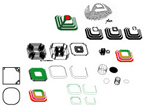
A Veritable Who's Who Gathered in London
The Pervasive and Locative Arts Network [PLAN] is currently meeting in London. Here are the real time notes being compiled by Nicolas Nova, Drew Hemment and Steve Benford. [Thanks to pasta and vinegar]
PLAN is a two day event bringing together leading international figures to review the emerging fields of locative and pervasive media. Wireless and locative technologies are enabling people to break away from traditional computer interfaces. Mobile devices are mediating new kinds of social interaction and responding to physical location and context. [related]
See Tom Carden's Day 2 and Day 1 notes, and Molly's notes too.
Posted by jo at 11:29 AM | Comments (0)
February 01, 2005
Geodetic Landlines

Dynamic Multi-User GPS Drawing Tool for Participatory Exhibitions
Geodetic Landlines--by Jen Southern, Jen Hamilton and Jon Wetherall--is an on-line multi-user collaborative drawing tool for GPS enabled mobile phones, in which users draw by moving in real space. For use in exhibitions in which the audience participates and contributes to the evolving installation, and for collaborative spatial practices between distant locations. It is both a creative and an exhibition tool for multi-user art in which the artist collaborates with a wider social group, addressing some of the problematics of working with process based social practice.
The phone application connects with a separate Bluetooth GPS device and draws a line representing this data to the phone screen, during a journey. This information is then dynamically relayed to a server via WAP. Information can also be requested from the server by a phone using the system. If the user accesses live information from a different city or country they can make collaborative drawings or navigate via the routes and decisions made by a distant audience, allowing them to see their city a new, and be connected to the spatial experience of another place and another individual.
These collaborative gps drawings will be viewed live on a website, or projected into a gallery space, where user choice or live xml feeds of weather, current events or pollution data can be used to modify line colour, thickness and opacity.
Posted by jo at 11:59 AM | Comments (0)
January 31, 2005
GPS::Tron

Classic Tron, Distributed
GPS::Tron, by Thomas Winkler, combines GPS, Bluetooth and GMS or GPRS with the classic Tron game concept--mobile phone plus computer game.
The players' movements in real space, which are tracked by GPS and transmitted to the phone's display, influence his/her position in the game. Each player is represented by a line that gets longer and longer. But the player's own line is never allowed to cross itself or the opponent's line. Which makes the game harder as time passes. The goal is to drive your opponent into a corner so that he can no longer extend his line without breaking the rules and losing. This is a game for two players who can be geographically distant from one another. [posted by Regine on near near future]
Posted by jo at 10:31 AM | Comments (0)
January 25, 2005
GoingPublik
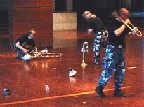
Mobile Multimedia as Mixed Reality
GoingPublik is a sound art work for distributive ensemble and mobile score synthesis. The core idea behind the work is a strategy of mobility by employing a wearable computer system running a software based electronic scoring system. GoingPublik will be performed at Interactive Futures 05 on February 5 from 9:30-10:30 pm. Art Clay will present a lecture "GoingPublik: Mobile Multimedia as Mixed Reality" from 2:30-3:30 PM.
"The core idea in the project is a strategy of mobility and this is accomplished employing a wearable computer system running the software based electronic scoring system as its central element. The program itself basically allows for what might be termed 'composed improvisation' which permits improvisational elements within a compositional structure. This is accomplished by electronically monitoring the performer's physical behaviour during performance. The program then responds by making suggestions to and even demands on the performer to various degrees and at various times.
Since each of the performers is equipped with the same electronic scoring system and because the system revolves around universally shared inputs such as geographical positions obtained via satellites and sensors using the earth's magnetic field, all have a common denominator and are thereby virtually linked. Despite the physical distribution of the performers in space, it is possible to have a commonly shared compositional palette and, at moments of close proximity between performers, to obtain instantaneous synchronized sonic elements. Both aspects needed for creating sonic structure within the work." Read paper >>
Composition Camouflaged: On the Relationship between Interpretation and Improvisation; Interview with Roland Dahinden, Günter Heinz & Thierry Madiot on the World Premiere of GoingPublik by Franziska Martinsen
Posted by jo at 10:05 AM | Comments (0)
January 22, 2005
Headmap
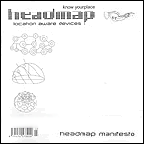
Inside Out
"The Headmap Manifesto [PDF] is a sequence of text fragments dealing with the social and cultural implications of location aware devices. Headmap argues a move from the 'inside' view that developed after the failure of the space programme, the closure of frontiers, the rise of television, early computing, interiorised simulation and drug culture...towards an 'outside' view--a recolonisation of the real world, computers becomming invisible, mobile, networked and location aware, the real world augmented rather than simulated..."
Headmap is an informal guerilla (distributed) think tank. Headmap examines the social implications and applications of location aware devices, augmented social networks, wearable computers, thinking tools and semantic network interfaces.
Posted by jo at 11:27 AM | Comments (0)
January 20, 2005
Magic Location and Locative Media

Horst Konietzny in Conversation with Sabine Breitsameter
"For many years dramaturgue and director Horst Konietzny/Munich has been exploring digital media's performative potential. In 2003 and 2004 his project REACT - Literature in Everday's Life has been investigating the behaviour of passers-by in the urban environment, "captured" by watching authors whose writings are projected - immediately during the writing process - on nearby public screens. Without wireless transmission technologies this project would be impossible. Within the symposia The Art of Mobile Experience (Augsburg 2003 and Munich 2004 ff.) Konietzny created - together with K.P. Ludwig John and Jürgen von Stenglin - a forum for discussing mobile technology's aesthetic effects on art and popular culture." Continue reading >>
Posted by jo at 02:36 PM | Comments (0)
January 19, 2005
Transfers
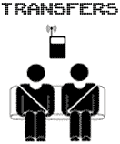
GPS+Video/Audio+You=Mobile Art
Transfers--by Matt Roberts--is a project exploring real-time generation of art and user participation in a mobile environment. Transfers allows a passenger of a taxi to generate a unique piece of art by giving the taxi driver directions. As the taxi moves through the city the passenger experiences a real-time manipulation of live exterior video and audio taken from a camera and microphone mounted in the taxi. The taxi is also equipped with a GPS that feeds an onboard computer data such as speed and direction. This computer is running custom audio/video manipulation software and uses GPS data to make decisions about how the live video/audio feed is manipulated and seen by the passenger. The manipulations of the live feed is displayed on two LCD screens and heard through the cars stereo system. As the user tells the driver where to go the passenger becomes both performer and viewer as they experience a unique piece of art generated by their decisions. The software also records this performance and at the end of the drive the passenger receives a CD with a QuickTime movie file of his or her recorded performance. [via Rhizome] Related >>
Posted by jo at 02:56 PM | Comments (0)
Fictional Space
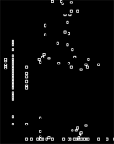
Mapping and the need for Creative Intervention
"Lately I've (Pall Thayer) been toying around with the idea of using *precision, digital locative* media to create fictional space. I've found that bluetooth mapping is better for this than GPS because bluetooth is just one dimensional so to map out a two dimensional space there has to be some *creative intervention*, if you will. This mapping was done by logging bluetooth proximity readings for approximately one hour. The first half hour is used for the x axis and the second half hour is used for the y axis. It's running at 4 times the real speed so you don't have to actually stare at it for half an hour to see the whole thing."
Posted by jo at 12:19 PM | Comments (0)
Location is Everything

Rhizome.org ArtBase Exhibition
Location is Everything--curated by Jillian Mcdonald--explores ways in which artists repurpose mapping as a creative medium; or perhaps it reframes mapping as a procedure that is intrinsically creative. The cartographic forms in these projects are drawn according to, as Mcdonald explains, personal or collective experiences, some informed by external factors like weather data or pop-culture references, and some allowing the map itself or local residents to inform them. These reciprocal actions of forming and informing effect both maps and their makers, suggesting that who? and why? are equally important questions to pose when interpreting a map as simply where?.
Works included in this exhibition are "PdPa" (2003) by Julian Bleecker, Scott Paterson and Marina Zurkow, "[murmur]" (2003) by Shawn Micallef, "Louisiana Walk #14" (1996) by Janet Cardiff, "Atmospherics/Weather Works" (2003) by Andrea Polli, "GPS Drawing" (2000) by Jeremy Wood, "Hlemmur in C" (2004) by Pall Thayer, "Survey Field" (2003) by Germaine Koh, and "Infrasonic Soundscape" (2001) by Hidekazu Minami.
Posted by jo at 12:03 PM | Comments (0)
January 18, 2005
Sound Mapping

Sound Sense of Place
Sound Mapping is a participatory work of sound art made for outdoor environments. The work is installed in the environment by means of a Global Positioning System (GPS), which tracks movement of individuals through the space. Participants wheel four movement-sensitive, sound producing suitcases to realise a composition that spans space as well as time. The suitcases play music in response to nearby architectural features and the movements of individuals. Sound Mapping aims to assert a sense of place, physicality and engagement to reaffirm the relationship between art and the everyday. Paper; Images; Video; mp3.
Posted by jo at 06:51 AM | Comments (0)
January 13, 2005
Mogi
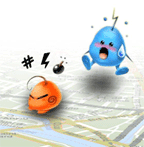
Location-Based Gaming
"Real and virtual have finally met in fun - reporting on Mogi, the brilliant location-based online multiplayer experience in Tokyo. Now phone networks are faster and more mobile devices know where they are, permitting a second generation of location-based multiplayer games. Undoubtedly the leading second-generation mobile phone game is Mogi: Mogi uses both the position of players in the landscape, and the landscape itself to generate play...Mogi is a collecting game - "item hunt". The game provides a data-layer over the city of Tokyo. As you move through the city, if you check a map on your mobile phone screen, you'll see nearby items you can pick up and nearby players you can meet or trade with." From Mogi: Second Generation Location-Based Gaming by Justin Hall, theFeature, April 1, 2004.
Posted by jo at 08:11 AM | Comments (0)
Surface Patterns: Walking Tours
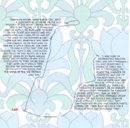
10 People. 10 Walks. 10 Stories Told.
Walking Tours and Audio Tours are two new works by artist Jen Southern commissioned by centrifugalforces and the media centre for Surface Patterns. Both works use a Global Positioning System (GPS) device to explore how memory is linked to urban and domestic places. The GPS device can only describe latitude, longitude and altitude: however, when used to trace the route that someone walks through a place, it can reveal the pattern of the path taken, allowing us to share knowledge of hidden locations and unexpected vantage points along the path.
Traditional maps tell us where landmarks are, what streets are called and where to find the centre of town, whereas the subjective histories and stories explored in this work are played out over time and rely on very different 'memory maps'.
The installation Audio Tours at the media centre uses contributions of unwanted wallpaper, pasted on the gallery wall and threaded or punctuated with GPS patterns of 10 walks. Traces of audio recordings made in conversation with the walkers are manipulated and played back in the gallery, recalling the simple flipping, mirroring and inverting techniques employed in the patterns of the wallpaper. Reflecting different perspectives on the town, the walkers include members of the artists family who grew up in Huddersfield in the 1940s and 50s, as well as a previous Artist in Residence at the Digital Research Unit in The Media Centre who lived in the town for three months. Memories range from the last Sex Pistols gig to architectural history (both public and domestic) and personal freedoms of walking in urban space.
Walking Tours consists of 10 PDFs to download and print, each using a wallpaper pattern, a walked route, and a story about Huddersfield.
Jen Southern is an artist who lives and works in Huddersfield. Her process-based practice investigates everyday journeys between virtual and physical spaces, using socially embedded technologies such as video games and mobile phones. She has been working with global positioning devices for the past two years; recent projects using GPS: Area Code (www.areacode.org.uk) with exhibitions at Magna, The Museum of Science and Industry and Artranspennine 03. Jen's work has been exhibited nationally and internationally in public spaces galleries and festivals.
Posted by jo at 07:53 AM | Comments (0)
January 07, 2005
Traces of Fire
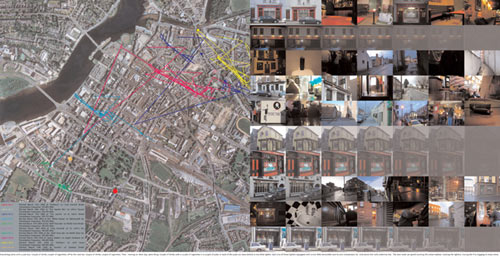
Tracking the lighters
Volkmar Klien & Ed Lear's Traces of Fire was a social experiment that traced the movements of ten cigarette lighters tagged with transmitters to provide location and motion data frequencies.
The artists 'lost' the lighters in pubs in Limerick and observed during two weeks how they were carried around town by unknown people. From the cumulative data, the artists built a series of exhibitions showing patterns in the locations and movements of the lighters around the city.
Tracking the lighters and collecting position data was achieved with the help of transmitters normally used as animal implants in wildlife habitat studies.
Via Urban Habitat Research. (Posted by Régine Debatty)
Posted by Regine at 12:53 PM | Comments (0)
December 31, 2004
The Analogous Landscape: Rim of Fire

Inferencing Techniques for Navigation of Terrains
Defining the nature of resemblance between things that are otherwise unlike is the focus of The Analogous Landscape project. In the tradition of monumental works by environmental artists Robert Smithson, James Terrill, Christo, Richard Long and the Harrison's, C5 intends to produce a large scale conceptual and performance artwork. The Analogous Landscape: Rim of Fire project integrates a sophisticated research agenda within the context of adventure sports, corporate culture and art. Beginning with the successful expeditions in 2003 to ascend Mt. Shasta and Mt. Whitney in California (the highest peak in the continental United States) C5 is planning research expeditions with the intent of climbing 20 volcanic mountains along the Pacific Rim of Fire. The environmental space of the Pacific Rim is a complex dynamic shaped by a context of economic globalization and post-modernization.
The objective of The Analogous Landscape: Rim of Fire project is to develop inferencing techniques for navigation of terrains of similar characteristic. At issue is whether navigation paths can be transposed by analogy on a selected terrain's other. To address this, initial expeditions will be analyzed to produce predictive navigation scenarios that can be imposed on the succession of expeditions. C5 intends to re-describe the landscape as a factor of expeditionary experience. Using GPS (Global Positioning Systems) technology C5 research teams will collect ascent path tracking data that will be computer modeled in three dimensions. Video and photographic documentation of the expeditions will be interactively linked to the tracking data (time and location data) through a unique computer interface design. Each mountain will be computer fabricated directly from space shuttle and satellite DEM (Digital Elevation Mapping). A singular model will be produced directly from a cumulative integration of the track logs. The final installation will include the above elements within an interactive display environment.
Posted by jo at 10:09 AM | Comments (1)
Psychogeography and Imperial Infrastructure
Psychogeography and Imperial Infrastructure, by Brian Holmes, Springerin.
Great social movements leave the content of their critical politics behind, in the forms of a new dominion. This was the destiny of the revolt against bureaucratic rationalism in the sixties. The Situationists, with the practice of the dérive and the program of unitary urbanism, aimed to subvert the functionalist grids of modernist city planning. They tried to lose themselves in the urban labyrinth, while calling for the total fusion of artistic and scientific resources in »complete decors« –»another city for another life«, as the radical architect Constant proclaimed. With the worldwide implementation of a digital media architecture – and the early signs of a move toward cinematic buildings – we are now seeing the transformation of the urban framework into total decor (Lev Manovich: »In the longer term every object may become a screen connected to the Net, with the whole of built space becoming a set of display surfaces«. What kind of life can be lived in the media architecture? And how to explain the continuing prestige of Situationist aesthetics, in a period which has changed so dramatically since the early 1960s? Continue reading >>
Posted by jo at 10:02 AM | Comments (1)
December 29, 2004
Questioning the Frame
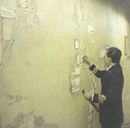
Thoughts about maps and spatial logic
"...Terms such as "mapping," "borders," "hacking," "trans-nationalism," "identity as spatial," and so on have been popularized in recent years by new media theories’ celebration of "the networks"—a catch-all phrase for the modes of communication and exchange facilitated by the Internet.
We should proceed with caution in using this terminology because it accords strategic primacy to space and simultaneously downplays time—i.e., history. It also evades categories of embodied difference such as race, gender and class, and in doing so prevents us from understanding how the historical development of those differences has shaped our contemporary worldview.
..." Read full article Questioning the Frame: Thoughts about maps and spatial logic in the global present by Coco Fusco, In These Times, December 16, 2004. Responses to the article culled from Locative and nettime:
Responses to the article culled from locative and nettime:
Date: Thu, 16 Dec 2004 22:26:27 +0000
From: Pall Thayer
Subject: [Locative] Questioning the Frame
To: locative@x-i.net
hmmm.... I just wish she would mention some of the mapping projects she's talking about. She really seems to have a narrow understanding of what artists are doing with locative media. She seems to suggest that one of the problems is that the artists have too much control over the social picture that the maps portray. And other artforms don't? I'm going to have to read this through a couple of times to make sure I really understand what she's saying but after a couple of scans it really looks rediculous and I almost get the feeling that she regrets not being a "hacker".
Pall
Ewen Chardronnet wrote:
well, she always comes with interesting art critics and post-colonial discourses, but use same dialectics each time. I remember reading same dialectics in her critics on "art and science" hipe and "critical art ensemble trial" hipe. And now the "locative media" hipe... You can be sure there will be a critic on "pervasive arts" and "space arts" soon, etc. and of course better if those arts are done by white male artists
E.
Date: Thu, 23 Dec 2004 17:08:14 +0100 (CET)
From: Brian HOLMES
Subject: [Locative] A Reply to Coco Fusco
As a critic it's important to read your peers, and try to assess the pertinence of your own work in the mirror of theirs. So I was curious to read Coco Fusco's recent article on mapping [www.inthesetimes.com/site/main/article/ questioning_the_frame]. However, I must say that her continuous assertions of cultural authority leave me feeling highly ambivalent. On the one hand, the threads of historical memory she brings up are extremely welcome. On the other, her unwillingness to engage with current conditions and projects tends to reduce the past to a complaint: Why isn't it the present anymore?
It's true that the raw fact of being older than the majority of the people in a given crowd can make you feel uncomfortably lucid. When I went to a conference on so-called "locative" or GPS-based media at the RIXC center in Latvia, I found most of the projects quite naive, developing a few stylistic traits of situationist psychogeography in the absence of any geopolitical critique of power relations, or any philosophical critique of instrumental rationality. In effect, a Cartesian worldview has been built into the computerized technology of graphic information systems, which are undergirded by megaprojects of military origin, or what I call "imperial infrastructure." But rather than just giving a disciplinary lecture with all the answers stated in general terms, I tried to show how changing conditions had made the once-subversive traditions of psychogeography quite superficial, to the point where the aesthetic forms the artists were using seemed to render the very infrastructure of their projects invisible. And when I recently published that paper out of context in Springerin, I took the time to name all the artists and projects in question, so as to establish the precise referents of the critique [springerin.at]. I wish Coco Fusco would make that kind of minimal effort, as it would bring her sharp observations into contact with actual projects, and open up a space of possible transformation.
More to the point: When I began my work on mapping, about four years ago now, as a direct result of involvement in demonstrations against the policies of the WTO and IMF, I too felt that the most important reference was the history of the Third World movements of national liberation, in their relations to the Western civil rights and new left movements of the 60s and 70s. In an early text that was finally published in the book Moneynations, I tried to show how the very concept of the Third World, and then above all, the reality of the Movement of Non-Aligned Nations, acted to open up new imaginary and real spaces within the dominant bi-polar map of the Cold War [http://2002.memefest.org/en/defaultnews.cfm?newsmem=15]. I asked the question whether the emergence of the World Social Forum in Porto Alegre could be compared to the Bandung Conference in 1955. Obviously, the answer was that it could not: both because the current antisystemic movements do not (yet) have the strength that Bandung represented, and because the operative modes of opposition may well have changed fundamentally since 1955.
The global importance of the Third World movements lay in the new kinds of international solidarity that they helped provoke. But something important remains unstated in Fusco's references to these movements, and this is the fact that the major links that tied them to the First World do not exist anymore (nor, indeed, do the movements themselves, for we are talking about specifically national movements in the period of decolonization). One of these links was an aspiration to create a non-Stalinist form of communism, according to the examples given by the successful Cuban and Vietnamese guerrilla insurgencies, and also by Yugoslav self-management (one must remember that the non-aligned movement came officially into existence in Belgrade). Another powerful link was the notion of cultural authenticity, or inherent difference from the Western norm, as a liberating foundation upon which newly independent nations could be built. This Third World concept served as a basis for the struggles toward a multicultural society in the First World. Today, however, the egalitarian aspiration to a self-managed communism has no objective touchstone in reality, leaving those who feel its lack in a deep state of ideological disarray. At the same time, the notion of cultural authenticity has been largely usurped by nationalist or fundamentalist projects which, although they have fortunately not eradicated all work towards equal rights in a multicultural society, have nonetheless made it very difficult to raise the banner of cultural or ethnic difference as a rallying-point for international solidarity.
Instead of relying on the old internationalist slogans (Third Worldist or proletarian), the transnational movements of dissent that gathered strength throughout the 1990s tried to use the communicative power of the discourses of human rights that had gained currency in the 80s, largely through the resistance of people in the former Eastern bloc to totalitarianism, and in Latin America to dictatorship. It was subsequently necessary, in the late 90s, for the Western participants in these transnational movements to take the further step of putting their own bodies on the line, of taking direct action against the international economic institutions, in order to go beyond the abstract character of the human rights discourse. This was a way of responding, in the overdeveloped countries, to the sacrifices of the many "IMF riots" that had been held, often at great cost of life, in what was now being called the Global South. Anyone who believes this step was taken by middle-class white kids acting on internet fantasies, in the absence of direct input from social movements around the world, quite obviously didn't go to any of the demonstrations and paid no attention to the planning process or the reports.
The point, however, is not to suggest that a brief flare-up of worldwide protest has brought about any substantial change. It is rather to recall what a difficult and long-term effort is really needed, both to grasp the way that transnational state capitalism now functions, and to articulate large-scale resistance. When Josh On [www.theyrule.net] or Bureau d'Etudes [http://utangente.free.fr/index2.html] make their complex charts of contemporary power relations, one can be assured that the cold and abstract character of the results is very painful to them. I can testify, particularly in the second case, that they are acutely aware of what is missing from such documents: namely, some affective indication of resistance from below, who does it, how they work and why. What has been achieved in such cartography projects, however, is a contribution to the very large-scale effort to rebuild a critical grasp of the oppressive forces that create the dominant map of the world. This kind of power-mapping is a necessary prelude to any effective resistance or counter-proposition. The fact that the difference between such efforts and the current military maps used by the Pentagon does not appear clearly on American TV is hardly something you can blame the artists for! There is a difference between general culture critique and constructive critique directed toward people carrying out specific projects.
Somewhat like Coco Fusco, I often wonder why contemporary artists appear so broadly unable to infuse the dominant map with representations of - or even better, direct links to - the many and diverse dissenting groups and alternative philosophies that are now emerging in the world, or that have remained active over decades. Unlike Coco Fusco, however, I don't think it's useful or necessary to berate artists today for not having been born earlier. The great philosophical frameworks of national liberation and egalitarian self-management that were able to articulate far-flung resistance movements in the past are inoperative in our time. The urgency is for real individuals of all generations, on all continents, to put their heads and hearts together and create new articulations. The specific job of writers and organizers is then to give those articulations conceptual clarity and popular currency, so that they can effectively challenge the absurd world-views presented on American TV.
As to artists, for whom the naked power structures of the contemporary world must now be quite visible, I encourage them to delve more deeply into the diverse efforts that are being made to resist the imposition of a homogeneous control structure on the entire world. This requires looking outside the boundaries of class, ethnicity and nationality, as certain artists and intellectuals of previous generations effectively did. To live up to the great examples of the past then means imagining something quite different for the future. Need it be said that certain kinds of imagination can serve as the first steps towards a transformation of reality?
Date: Fri, 24 Dec 2004 04:13:32 +0000
From: Saul Albert
Subject: Re: [Locative] A Reply to Coco Fusco
To: Brian Holmes
Hi Brian,
I read both Coco Fusco's piece and your response with interest and a little bemusement. You addressed the lazy generality of CF's rant very well, and touched on a couple of things that provoked me to write back:
Firstly, can we please get away from technological determinism?
Yes, the use of military-industrial technology can be problematic, but that criticism in your text is as widely and as targetlessly applied as Coco Fusco's. Many people are using these technologies (GPS/mobile phones/internet/high-tech gizmos), the social movements that you use as your reference points as much as anyone. In fact, it's not like we really have the choice about using these technologies , being subjects in a technocracy... and it's only out of the appropriation and reuse of these technologies that critique can form and attempt to reconfigure the social and political relations that produced them in the first place. Even on a non-technical level, using these technologies and observing their effects and deployment has been instrumental in the development of a number of political discourses: information and affective labour, precarity, [cyber]feminism etc. The critique develops as much from practice as practice develops from critique.
example: London Free Map - http://uo.space.frot.org/?node=LondonFreeMap
http://chinabone.lth.bclub.org.uk/albums/misc/london_free_map.sized.jpg
Jo Walsh and Schulyer Erle have been working on the 'London Free Map' This project encourages participants to walk, drive, cycle or skate through city streets with GPS units and then use the 'traces' of points representing latitude and longitude that these devices generate to help create publicly licensed geodata. They are also working on adapting existing open source software to enable people to annotate and extend these maps in a very flexible way. The example linked to above shows straight lines representing GPS traces made wandering the streets of Limehouse, East London, an area undergoing a huge urban regeneration process in preparation for the proposed Olympic games in 2012. The labeled points are the locations and names of approved planning permission applications made to the London Borough of Tower Hamlets in the last five years, automatically retrieved from the council's website and plotted onto a scanned out-of- copyright historical map of the area from 1916. This is just one potential use of the London Free Map, a way of visualising physical and historical changes to a space undergoing a huge social and economic upheaval. The potential for further uses and the development of new, as yet unimagined maps from this project seems evident.
Secondly, I found the distinction between these technologically specific, less overtly political projects, and the 'power-mapping' practices of (the wonderful) Bureau D'Etudes and many many others to be a bit thin. I know you share their frustration at having to use the language of power to map power, but the problem is not just in the inability of this form to represent the fertile heterogeneity of the social movements. 'Power mapping' deals in the currency of power, and its representational structure can reinforce the dynamics of the relationships it represents. More worryingly, the unnerving coherence of these representations can also become ised easily - the currency of power made visual, or (worse) 'data visualisation' knits neatly into artistic and authorial currencies and relationships that can become as reactionary and totalising as the military-industrial technologies you were warning against earlier.
I know you know this, your descriptions of the playfulness of the Bureau's maps illustrates the path they choose out of this bind : 'solidarity with aliens'. But people using similar or derivative techniques seem to embrace the solemnity and darkness of their maps without having the escape pod provided by their humour.
What encourages me about initiatives like the London Free Map and many of the projects in the orbit of the 'locative media lab' is that they often work, on a very basic level, to avoid totalising representations. To some extent this is emerging as an informal agreement on technologies, open Semantic Web standards and other esoterica that I'm not really equipped to explain. Also, many of these projects are based on public workshops, working with people and groups on producing representations of themselves, spaces, movement and relationships. Of course none of this is inherantly interesting. Public workshops and 'open' technologies carry their own wealth of dead ends, vices and travesties, but they certainly are politicised - and politicising, in a very different and more subtle sense than that of 'power maps'. The contingency on input from the map-users is the most obvious distinction between these forms of mapping and the two examples of 'power mapping' you mentioned. Of course this aspect of 'participation' in the making of the map is just as worrying in terms of which currencies it evokes, auteurship and the 'framing' of 'public use' in the interests of pseudo-ehthographic artistic value creation etc. etc.. But the locative media lab's engagement with corporations, the way some of it is like cheap corporate R&D in exchange for getting to use fancy devices, the links with 'community groups' funded and instrumentised by arts bodies, and with governments for use of geodata is all messy, difficult, and suspect, but necessary if the technology, and the discourse are going to develop.
This probably warrants more examples, which I'm too tired to start with now.
I guess the problem is that criticising something is difficult because you have to explain why, whereas blithering pleasantries about things you like is not so demanding.
keep up the good work brian!
X
Saul.
Date: Sun, 26 Dec 2004 23:48:54 -0800
From: John Hopkins
Subject: Re: [Locative] A Reply to Coco Fusco
To: locative@x-i.net
>>Firstly, can we please get away from technological determinism? Yes, the use of military-industrial technology can be problematic, but that criticism in your text is as widely and as targetlessly applied as Coco Fusco's. Many people are using these technologies (GPS/mobile phones/internet/high-tech gizmos), the social movements that you use as your reference points as much as anyone. In fact, it's not like we really have the choice about using these technologies , being subjects in a technocracy... and<<
Why no choice? If no choice, isn't that technological determinism to the extreme degree?
It is an incremental process -- each mile you drive onwards in your fossil-fuel burning device, or crank open the thermostat in the house, that drives the social system further onward in its dominance. (it propels the US military machine a bit further in its desparate mission to secure the true power/energy-base of the social structure that is is an integral part of). each time you don't do those things de-poweres that same system.
each time you watch one minute of centrally organized media you give that structure more power. each time you cross social-structural boundaries and engage an Other human directly, you depower those ordained structures.
hmmm.
JH
Date: Mon, 27 Dec 2004 11:32:20 -0000
From: "Armin Medosch"
Subject: Re: [Locative] A Reply to Coco Fusco
Hi Saul, Hi Brian,
let me first make some sort of disclaimer: I am happy that Coco's article (which I have not read, but can roughly imagine what it contains) triggered this discussion about locative media which was long overdue. I think many people have felt uncomfortable with the unarticulated political 'content' or 'meaning' of locative work but have not spoken in public. One reason for that might be that they felt, as I did, that there is a lot of potential in that field and that the (mostly young) people involved did not deserve to be bashed for all their good intentions, even though those intentions sometimes gave relatively weak results. Finally the lid has been blown off and that is a good thing. I now do neither want to argue for or against Saul or Brian but just throw in my two-pence. I also have to say that writing something really meaningful about that whole area would take at least a day and I simply don't have that time right now. So please excuse the immaturity of my words which are quickly written in a sort of email improvisation which I guess was once the spirit of internet discussions which is now often sadly missed.
Saul said at the very beginning of his reply:
>> Firstly, can we please get away from technological determinism?
What does this statement mean? It is indeed important to 'get away from technological determinism'. But what this statement should not mean is that we should not consider or discuss technological determinism.
Saul continues:
>> Yes, the use of military-industrial technology can be problematic,
I would go further and say that 'can be problematic' is not strong enough. It _is_ problematic, always. The instrumental power that is contained in those technologies is a central issue of our time, and by 'our time' i do not only refer to the last couple of years or so but to the last 50 or even 100 years. Therefore I think such statements about technological determinism and military-industrial technology should not be used to quash any discussion about those issues. Those issues should exactly be the starting point of any discussion about 'locative' projects and indeed media art and net art projects. This is where the media art community has failed over the last 20 years which I was able to witness as a grown up person. It is one of the big failures of that community and possibly one of the reasons why it made so little real progress over that period of time. When I say 'real progress' I of course don't mean technological progress, of which we have seen plenty, but a progress in the social use of those technologies, in their accessability and applicability, in their ability to have an actual impact on the improvements of the situation of people.
I am arguing from a point of view of art that is based on a definition of art whose main reason to be is political. Such an art should be able to transcend the current power system. By 'transcending' i don't refer to metaphysics but to the actual socio-historic situation. In this situation and its projection of possible futures it should open up spaces, spaces for alternative ways of thinking, spaces that offer people different opportunities, for instance to realise alternative viewpoints outside the dominant system, or, more practically speaking, to be able to develop ways of resistance and at least limited ways of autonomy. Of course we cannot ask too much from art and the current level of oppression is so high, the ideology of technological determinism so deeply entrenched that it has become very hard to imagine anything that makes a real difference. But at least people should try. I am afraid I could not see that in most locative projects and in most of the discussions that have been had about the topic so far.
Most of the projects (I am aware that such generalisations without reference to particular projects are always lame but simply have not the time to go through bookmarks and list archives now) simply continue the master trope of the narration of hypermodernity, which is about expansion of technological mastery, coupled with economic growth, all under the banner of 'usefulness' for the people. This is how new communication technologies are being advertised. The mobile phone gives you freedom, it improves your social life, you can use it to form Rheingoldian Smart Mobs and if you put a little FOAF into it you can even realise alternative politicised virtual communities with it. Of course you can do all this stuff, it is even true. But by doing so, you are not leaving the established playing field, a field that has been established by the forces of techno-rationality in the service of capitalism.
I know it is a bit unfair to mention that here but the most significant 'locative' projects in that regard are Blast Theorie's mobile games. The critical content of those projects is nil. The whole thing blew up at futuresonica last year but most people could not read the signs on the wall. Of course their projects are resourceful, maybe well programmed, maybe even entertaining. But they are fundamentally affirmative of the world we live in and completely one-dimensional.
Now, to come back to the core question: it is simply wrong to ask if we are allowed to use military-industrial technologies. of course we should use them (and I do that by simply typing an email) but if we do it matters how we do that. do we contribute to the disguise of the political content of those technologies and thereby continue the positivistic narration of expansion and 'usefulness'? or do we use them to expose that which is always subconsciously present, that in this system, as Herbert Marcuse said 40 years ago, power is transferred into technological systems and that our dependency on those system makes us to their reified subjects? It is a general trait of this society that the powers that be try to cordon off the political. The positive side of things (technological things, gadgets, gps, pda's) gets highlighted but not what comes with it, not this hard to pin down element of power that has become nameless and faceless because
it has been inscribed in, is contained in the technological system.
Now, coming back to locative per se, I think Brian is right to say: "In effect, a Cartesian worldview has been built into the computerized technology of graphic information systems, which are undergirded by megaprojects of military origin, or what I call "imperial infrastructure."
Maybe he ment to say Geographical Information Systems (GIS). GIS combined with GPS and so forth truly signify the victory of Cartesian space over real space. Of course this victory is only a fake victory and never a final victory but it defines the current state of the arts in 'mapping'. Is it therefore forbidden for artists to use GIS? Of course not. The project by Jo Walsh and Schulyer Erle that Saul mentions, 'London Free Map' is a very good example. It is maybe not an art project but that does not matter. It tries to democratize GIS power, democratize in the sense of direct bottom up democracy and not fake vote rigging mind manipulating democracy (oh, that word, can someone suggest a better one?). It is experimental and utopian, it relies a lot on FLOSS and is probably difficult to use for people who are not tech-savvy, but that does not really matter at this point; it does not entertain in the way Blast-ed projects try to but that is effectively its strength. It involves fun, but of a different kind. We need more projects of this kind and we need a discourse that is better able to differentiate between projects that open up those other spaces and projects which simply fall into the technological deterministic trap.
I hope we can begin conversations that are critical and constructive and not about our personality disorders of which we all suffer to a certain degree, necessarily, because they are a function of that system we are subjected to. In this sense I agree that a lot of the 'psychogeography post-situationist' talk sounds naive. But at least it shows a desire to get away from Cartesian space and to reconceptualize the highly regulated spaces we live in. It makes a lot of sense to link FLOSS, art and the history and presence of liberation struggles, but that debate needs updates and rejigging too.
Hoping to be able to talk about those issues in a more elaborate way soon and also hoping to hear from other people now
regards
armin
Date: Tue, 28 Dec 2004 02:21:22 -0800
From: karlis
Subject: [Locative] Don't be shy
To: locative@x-i.net
...Executive Summary:
While studying locative media projects, a computer user realizes the value in talking to people.
Extended Commentary:
A romance of the aesthetic of the internet. Be somewhere, anywhere, it doesn't matter, "jack in" to the internet, and you're home, with your office and your contacts and connections. The presently inhabited city, be it Riga, Ljubljana, or Vancouver, is like wallpaper or decor in a restaurant. The principal interaction with the world is through the internet, and the information available there, the rest is somehow peripheral. So naturally when we approached the ability to make computing mobile and location aware, there seemed to be an answer of integration; finally the drift and nomadism would be informed and fulfulled with the power and potential of the network computer. All your revolutionary fantasies come true. Except the devices are retarded and complicated and expensive; they don't work properly, and they make you into a Steve Mann cyborg, someone more appopriately dressed for a mid 1990's DefCon hacker fair in Las Vegas than any part of life in public.
We tried to simplify the gear and determine what it was supposed to do, which was connect us to the network, make us contextually aware within that network, and informationally aware within that spatial context. The equipment had to be "naturally human", so that it is still possible to interact with the environment and the local culture without handicap.
No cyborg head displays or cybergloves, or star-trek tricorders. It also has to be inexpensive and uncomplicated and break-proof.
A beautiful natural language interface was developed (using selective evolutionary algorithms, no less). Billions of client terminals connected to a global information network have been deployed, planet-wide, that use this natural language interface.
They're called people.
Sitting behind my computer and obsessed with the internet for ten years, I totally missed the obvious connection that local people are connections to the whole network, the network of all information connections which includes the internet but also "old Joe Smith" with whatever he's got to offer. It's the same reason why I haven't needed a watch since I was 15 - someone around me always knows the time. The connection to the network is not limited to a GPS satellite signal reciever and a 2.4GHz wireless internet supercomputer laptop. Rather it's just a link to the next node with different information that what you can access on your own. The easiest, most locative way to access that network is by talking to people, and if these studies are urban, there's going to be people. Forget WiFi and GPS. Ask for directions. Ask the nearest person, or if you're aesthetically driven, ask the nearest good-looking one. If they don't have the answer, they might know someone who does, or can suggest an alternative. If they don't speak your language, they'll likely direct you to someone who does.
Maybe that's should be obvious. But as a bedroom caveman computer hack, to look around and find that this perfect system has already been implemented is amazing. It's multi-modal with multiple redundancies. Ubiquitous. Reliable. All-weather. Fuckable.
Maybe an internet legacy of the military paradigm has poisoned our preconceptions about the reliability and desirability of technology vs people. But if we are nice and friendly and not locally despised imperial soldiers, we don't have to bring all our knowledge in a computer. We can talk to the nearest person.
When I was in an busy new space I formerly looked around and saw great potential for overlaying great collections of information and data or media texture in location, if we could develop the system to realize it.
Now I see that this network is already in place, mobile info nodes are walking all around, ready to be engaged, connected to vast networks of people and information. Standard APIs. It's amazing. Sometimes you have to ask a bunch of times, even before you realize the right question to be asking. But if the information is there, someone has it, and you can find it.
The mention of technological determinism and political action, brought up in the context of locative media, seemed to make this "amazing" revelation relevant again. It has been called a serious political action to find ways beyond the gap between people in the very technically-focused and alienated population. Techno-fetish locative media projects made me realize how important and powerful it is just talking to people.
OK!
cheers
karlis
Date: Wed, 29 Dec 2004 14:15:32 -0800 (PST)
From: coco fusco
Subject:
In response to Geert's request, below is my commentary that was published in IN THESE TIMES recently. The comments were based on my lecture at the School of the Art Institute of Chicago in November, 2004. The series is entitled:
MAPPING / CULTURE / BORDER / HACKING /
and the school's description of the series is:
"This lecture series examines the work of artists, artist-collaboratives, and film/video makers whose works address or proceed from shifts in articulations of global culture, politics of the border and dilemmas of transnational or diasporic identities--identity as a spatial concern. Special attention will be given to artists who use the gesture and organizational logic of mapping, cartographic sciences and the grid to locate identity as well as its displacements."
I found this description so baffling and overladen with jargon that it prompted my response.
I have not had a moment yet to respond to Holmes's post. I found it a bit surprising that he would locate a response to an article in a left-wing Chicago newspaper on a list-serve with a primarily European readership (of his allies, I would add). A decision to locate his response HERE as opposed to THERE seems more like a rallying cry to his nettime readership than an address the substance of my argument or to the public in Chicago, a city with a long and venerable history of community and labor organizing, activist media, and radical black politics.
Coco
Posted by jo at 10:19 AM | Comments (4)
Envisioning the ubiquitous city

Control, Misuse, and Subversion
"...The rapid convergence of mobile communications, automated positioning technologies, and geographic information systems (GIS) into "locative media" is raising the possibility of a dramatic transformation of the way we perceive and move about the urban environment, and how we interact with each other in urban spaces. Endless possibilities for locative media are being proposed that promise increased convenience, awareness, transparency, and access to information and social opportunities that break traditional power structures.
Simultaneously, at this moment of realization of the potential of locative media, there is an emerging sense of helplessness at the potential for control, misuse, and subversion of these technologies. Whether by states or anti-state organizations like al Qaeda, locative media extend the ability of the powerful and mobile over the weak and immobile. Cross-referenced information through geographic tagging adds many more dimensions to the problems already raised by unchecked, widespread linking of relational databases in industry and government..." Read entire post by Anthony Townsend [and The Auto and The Mobile by Howard Rheingold].
Also, see Townsend blogs Wireless Public Space and Telecommunications: New Media and Cities.
Posted by jo at 10:01 AM | Comments (0)
December 27, 2004
netzwissenschaft
![]()
Emerging Infrastructures of All (Inter)net Research
Dr. Reinhold Grether's network research | netzwissenschaft site maps the "emerging infrastructures of all (inter)net research endeavours. net.science as an anthropology of connectivity is trying to overcome the constraints of specialist method transfers on net matters. the protuberance of technical networks necessitates a professionalization of human net knowledge. neither the isolation of concepts as in basic research nor the encapsulation of processes as in applied sciences will ever be able to adequately describe the complex autopoiesis of networks. net.science is undoubtedly developing into a scienza nuova of its own right."
Check out his Mobile Art and Virtual Performance research areas.
Posted by jo at 04:45 PM | Comments (0)
December 22, 2004
Real Remote Guided
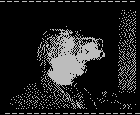
Controlled by web users
Real Remote Guided, by Antonio Lomas, features a subject who is "blinded" while the spectators / speakers on the internet and in the physical space, are able to see what the subject could see in normal circumstances.
GPS and web cam are combined with a laptop linked to the net through telecomunicaton systems (cellular telephony and/or wireless).
On the web page, the web guides see the images from the camera worn by the artist, as well as map images that define his location so that they can send him instructions, guiding him through a space of real intervention. The artist can only see the instructions sent by the users and the map images of the GPS system.
The idea is to represent, in a playful way, how new technological systems can take control. So, spectators are invited to take that control and to manage it. (Posted by Régine Debatty)
Posted by Regine at 03:01 AM | Comments (0)
December 16, 2004
Aura
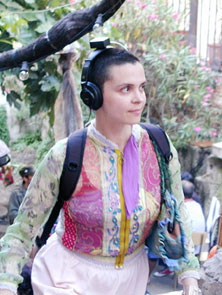
The stuff around the stuff around you
"aura", by British artist Steve Symons, is a full sonic augmentation of real space.
Wearing headphones and carrying a backpack containing a PDA programmed to access his/her location and heading, the user navigates the augmented “aura” world that blurs the real space and artistic intervention. Sounds stay fixed, so the user is able to map or identify particular sounds with features in the real world.
Probably the best metaphor for an aura sound world is to imagine walking through an array of invisible audio speakers suspended in space. Each speaker represents a sound node and emits different audio depending on where you, the user, is situated in relation to it. (Posted by Régine Debatty)
Posted by Regine at 11:24 AM | Comments (0)
December 15, 2004
Gravicells
![wait[1].jpg](http://www.turbulence.org/blog/images/wait[1].jpg)
Experiencing gravity
Japanese artists Seiko Mikami and Sota Ichikawa's work, Gravity and Resistance - Gravicells , makes our bodies aware of the interactions between gravity and resistance.
Moving inside the installation space, participants can feel gravity on their bodies and its resisting force. They can also sense the forces that other participants cause.
In the center is a 6m x 6m floor with a built-in sensor. All movements and changes made by participating visitors are transformed into the movements of sound, light (LED) and geometrical images through the sensors, so that the whole space develops or changes in this interactive installation. The installation is surveyed by GPS satellites, so it has the observatory point outside the earth. (Posted by Régine Debatty)
Posted by Regine at 03:35 AM | Comments (0)
December 14, 2004
Where on-line meets on the streets:
experiences with mobile mixed reality games
"We describe two games in which online participants collaborated with mobile participants on the city streets. In the first, the players were online and professional performers were on the streets. The second reversed this relationship. Analysis of these experiences yields new insights into the nature of context. We show how context is more socially than technically constructed. We show how players exploited (and resolved conflicts between) multiple indications of context including GPS, GPS error, audio talk, ambient audio, timing, local knowledge and trust. We recommend not overly relying on GPS, extensively using audio, and extending interfaces to represent GPS error." From M.Flintham, R.Anastasi, S.Benford, T.Hummings, A.Crabtree, C.Greenhalgh, T.Rodden, N.Tandavanith, M.Adams, and J.Row-Farr (2003). Where on-line meets on the streets: experiences with mobile mixed reality games. In Proceedings of the conference on Human factors in computing systems, pages 569–576, Florida, USA. [via pasta and vinegar]
Posted by jo at 02:53 PM | Comments (0)
December 13, 2004
Petra Fagerberg's Publications

User-Centred Perspectives
Petra Fagerberg, Fredrik Espinoza, and Per Persson (2003). What is a place? Allowing users to name and define places. In Proceedings of CHI 2003, Fort Lauderdale, USA. [PDF]
Per Persson and Petra Fagerberg (2002). GeoNotes: a real-use study of a public location-aware community system. Technical report, (T2002:27), Stockholm, SICS. [PDF]
Persson, P., Espinoza, F., Fagerberg, P., Sandin, A. & Cöster, R. (2002). GeoNotes:A Location-based Information System for Public SpacesKristina Höök, David Benyon and Alan Munro (eds), Readings in Social Navigation of Information Space, pp. 151-173, Springer. [PDF]
Petra Fagerberg (2002). Social Navigation in a Location-Based Information System, Masters Thesis, Numerical Analysis and Computer Science, Royal Institute of Technology, Stockholm, Sweden. [PDF]
Posted by jo at 10:32 AM | Comments (0)
December 10, 2004
TRANS CULTURAL MAPPING - PROGRESS MANIFESTO ISSUES
"The exploratory movements of locative media lead to a convergence of geographical and data space, reversing the trend towards digital content being viewed as placeless, only encountered in the amorphous and other space of the internet. Much like Long, 'geo-annotation' projects such as [murmur] and Urban Tapestries weave interlocking narrative threads through the environment, and a wide range of other artistic approaches are also being explored, such as the mixed reality gaming of Uncle Roy All Around You, the ambient narrative of InterUrban, and the sensory immersion of Come Closer. It is too early to offer a topology of locative media arts, however, or to tie the field down with strict definitions or borders.
While artists such as Masaki Fujihata, Teri Rueb and Stefan Schemat have been producing work in this area for many years, more widely there have been only a handful of fully realised locative art works, with many projects remaining in the beta stage if not still on the drawing board. We have not yet reached the point at which the technology disappears - all too often the tendency is to focus on the technology and tools rather than the art or content." From Locative-Progress Manifesto Central [via Mobile Audience]
Posted by jo at 09:51 AM | Comments (0)
December 09, 2004
Summoned Voices
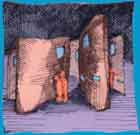
Interactionfields
Summoned Voices--by Iain Mott and Marc Raszewski--acts as a living memory of people and place. It consists of a series of door installations each with an intercom, sound system and a computer that is networked to a central file and database server. The design metaphor of the door presents a familiar scenario, that of announcing oneself at a doorway and waiting for a response from persons unknown. Signage instructs the public to speak, make sounds or sing into the intercom. Their voice is stored and interpreted, and results in local playback composed of the individual's voice with those that have gone before. Summoned Voices acts as an interpreter of sound, a message board and an imprint of a community - a place for expression, reflection and surprise.
Summoned Voices is one of the 22 projects catalogued by Mirjam Struppek for her thesis Interactionfield - Public Space in the Digital Age (2002): "The public space is a field, which is created and becomes alive through various forms of interaction.
Thus interactive art with its life proximity, communicative issues and reflection of the power of the modern technologies is well suited to be linked with the urban public space. This information platform presents detailed some selected interactive media projects, which went consciously into the urban public space. The analysis, categorization and questionaire with the producers of these 22 examples show how new media can be alternatively used, in order to contribute to the rediscovery and reactivation of the urban space and to lead to new interaction qualities. In the open expandable list further projects are collected. With the time an archive can develop, with examples, that show new ways in dealing with the public space. The links section presents various conferences, research projects, articles and specialized artists that related to this topic."
Posted by jo at 06:36 PM | Comments (0)
The Meaning of Place

Technological Imagination and Human Experience
The Meaning of Place Forum and Seminar took place on September 9 + 10, 2003 in Hillsboro, Oregon: New technologies are reconfiguring our relationship to the places we inhabit. With the near ubiquitous presence of cell phones in many cities, the rise of wireless networks, hybrid games, the use of geographical information systems, and the emergence of an embedded computing research agenda in many labs, physical location has re-emerged as an important construct in the imagination of and creation of new technologies. But humans think of place quite differently than our technologies might demand. We inhabit places, not physical coordinates or zones of reception. Places are imbued with meaning through cultural practice; places are bounded and denoted in ways that may or may not match physical or technological means. This forum is intended to understand how the human construction of place both affects and is affected by new technologies.
People and Practices Research by Scott Mainwaring
Technology in Places by Joe McCarthy
The Links Between Place, Computing and Mobility by Anthony Townsend
Posted by jo at 06:21 PM | Comments (0)
msdm
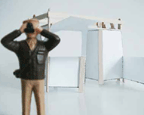
researching mobile strategies of display & mediation
msdm [mobile strategies of display & mediation] is an imaginary organisation founded in 1998 by paula roush to research mobile strategies of display & mediation. A hybrid of artistic, curatorial, experimental practice operating in the interstices of institutions and social systems, the organisation aims to propose participatory alliances for transversal, critical, cultural and aesthetic outputs. The collaborations have extended into the domains of open source software, publishing, para-architecture, public signage, radio streaming and mobile media platforms. They have been shown in galleries, museums, non governmental organisations and independent spaces, including Space Studios, Coleman Project Space, The South London Gallery, the Institute of International Visual Arts, the Bauhaus Foundation, Gesellschaft fur Aktuelle Kunst and the Living Art Museum.
Projects include:

geneticSilence: Public intervention and installation at the Living Art Museum in Reykjavik for the project Polyphony. A bus tour -the ’genetic noise tour’- was organised connecting the gallery with the street. The initial proposal was to have it to collect tourists in the city centre and take them on a tour of the high security genetic labs in the surroundings of Reykjavik. Because the right bus could not be found, the project took another shape and the tour was done in a small VW van, with the tech crew streaming the sound and images to the museum. The accompanying wall catalogue and public newspaper boards showed an archive of the links between art, genetics and architecture. The word ‘art’ -privatised by a genetics research company- was ‘corrected’ in the museum signage with the corresponding patent number.

bowville: bow wireless/ space studios/ london; locative media performance, 2004. Marion Manesta Forrester was electronically tagged. She had 3 days to earn her right to become a citizen of Bowville. People had to vote for her to stay or to go by phone, online or in person by visiting the Bowville Investigation Bureau. Download Bowville Booklet, 9 pages (pdf, 656k) or individual pages at higher resolution : page 1 | page 2 | page 3 | page 4 | page 5 | page 6 | page 7 | page 8 | page 9 |

SOS:OK: A work generated in response to Biscuit Town, the name given to the area surrounding Peek Freans biscuit factory. Biscuit Town was a marker in both organisational and representational forms of labour. It was the first mass producer of biscuits and commissioned the first documentary film shot on location (A Visit to Peek Freans, 1906, BFI Archive). At its core there is an artistic intervention that crosses a gallery installation with a public art intervention. The aim is to produce an emergency biscuit in response to the history of the site (Peek Freans was the first factory to manufacture an emergency biscuit ration to feed the starving population of Paris during the Franco-German war 1870-71) and the current international state of emergency. The launch and the time based performance at Coleman Project Space is inserted into a wider public campaign which includes billboards.
Posted by jo at 05:44 PM | Comments (0)
December 03, 2004
Interactive portrait of the Liberties

interactive narrative environment as navigable architectures
The Interactive portrait of the Liberties--by Valentina Nisi--is an interactive digital narrative application developed in conjunction with the Trinity College/MediaLabEurope CARMEN HCA founded project. The vision is to provide multimedia content to individuals and to groups, which is relevant to them at a particular point in time and space – in other words, context-aware. The delivery platform for multimedia application will be the WAND infrastructure: a collection of wirelessly connected nodes linking Media Lab Europe with Trinity College where content and services can be stored. The WAND infrastructure and the CARMEN middleware and software will allow stories, collected from local community members, to be distributed in the space and physically navigable taking literally the metaphor that describes interactive narrative environment as navigable architectures. Example.
The stories will be available to the users as they walk around. A database of many short self-contained stories is put together following the themes of locations, social networks within the community members and a family genealogic threes. Location, social network, user profile are some of the variables that come into play when talking about context aware stories. Depending on the changing variables many different combinations of the story elements can result from the viewer navigation of the area.
The stories have been researched and collected by making contact with local community members and through books with a strong emphasis on the social and folkloristic aspects of the area, such as Mairin Johnston book “Around the banks of Pimlico” and Leo Mhonogan not yet published photographic collection about the liberties. Some ethnographic interviews have been conducted during the summer that revealed a rich baggage of stories and traditions which make the liberties area an ideal location for this type of project.
Posted by jo at 12:21 PM
Augmented Space
"GPS, wireless location services, surveillance technologies, and other augmented space technologies all define data space – if not in practice than at least in their imagination - as a continuous field completely extending over and filling in all of physical space. Every point in space has a GPS coordinate which can be obtained using GPS receiver. Similarly, in the cellspace paradigm every point in physical space can be said to contain some information that can be retrieved using PDA or a similar device. With surveillance, while in practice video cameras, satellites, Echelon (the set of monitoring stations which are operated by the U.S. and are used to monitoring all kinds of electronic communications globally), and other technologies so far can only reach some regions and layers of data but not others, the ultimate goal of the modern surveillance paradigm is to able to observe every point at every time. To use the terms of Borges’s famous story, all these technologies want to make the map equal to the territory." From "The Poetics of Augmented Space: Learning from Prada" by Lev Manovich.
Posted by jo at 10:49 AM | Comments (0)
mobile_connections

SPACE
mobile_connections explores how geographical, cultural and perceptual space are being reconfigured by wireless and mobile media, and looks at the diverse ways in which artists are pushing the limits, and soliciting unexpected or unforeseen results, from communication media past and present, from the radio to mobile telephony and wireless LAN.
mobile_connections is the media art strand of the futuresonic04 festival of electronic music and media arts, and also involves satellite events at other international events in the lead up to the festival. It was devised by loca.
Posted by jo at 10:18 AM | Comments (0)
December 02, 2004
Teri Rueb's four questions
Four very good questions on locative media posted on the Location_Focus list (blogged below), reblogged by Martin Rieser on Mobile Audience:
From: Teri Rueb
1) Community and site-specific practices of the 60s and 70s emerged in large part from artists concerns about circumventing the elitism of the gallery/ museum system and addressing issues of representation and participation in shaping and interpreting the cultural landscape. Whether or not communities / sites have been meaningfully and responsibly engaged in such practices remains a central concern in evaluating their impact. How do you see emerging practices in locative media relating to and carrying forward this history - or do they? Has this historical connection been adequately examined? What role does the technology itself play in locative media practice? Is it critically engaged or does it more often tend to upstage or eclipse social concerns inherent in such practice?
2) The mobile phone is often envisioned as the ideal delivery platform for locative media works due to their ubiquity and general accessibility. Even where bandwidth via mobile phone becomes an issue (in the case of video or sound), shifting the focus to alternative hardware platforms such as PDA or pocket PC still requires a contractual relationship with the phone company or ISP for connectivity. In each case, a tremendous amount of power and profit is placed in the hands of the phone company as content delivery potentials expand with locative media. Can we envision ubiquitous/accessible delivery systems that don't leave the phone company holding all the cards? Can policy dictate the equivalent of a "public access" channel, or percent-for-art model equivalent for locative media that relies on network connectivity? Are there alternative solutions that can maintain the vision of universal access when it comes to mobile connectivity?
3) Where might locative media take us in terms of cognitive and proprioceptive ability and awareness? What kinds of cognitive processes are engaged by or emerge from interaction with locative media? For example, in my own work I have used sound overlays only - no screen-based, visual content delivery. This is partly because I believe that audio is a more appropriate mode of information delivery when dealing with the mobile subject where eyes and bodies are typically already engaged in navigating and taking in the surrounding environment. However, I am open to the possibility that we might adapt to multi-modal interfaces as they become more pervasive. For example, it was originally thought that putting a radio in a car was dangerous - but very quickly a radio became an essential part of the standard dashboard.
4) How do locative media re-invigorate practices associated with predominantly oral cultures such as the fixing of information in memory based on place (as in ancient and classical mnemonic arts) and movement (as in Aristotle's peripatetic school) or the spatialized narrative of aboriginal walkabout or the medieval bard? Can Walter Ong's notion of secondary orality be meaningfully applied to this area of inquiry?
See answers.
Related: Sabine Breitsameter's interview with Teri Rueb on Audiohyperspace
Posted by jo at 11:58 AM | Comments (0)
November 26, 2004
The Mobile Audience
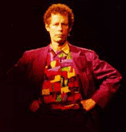
Locative Incarnations
Progress Report 2--The Mobile Audience: Art and New Located Technologies of the Screen by Martin Rieser.
Summary: A critical study examining emergent uses of mobile, wearable and wire free technologies, which move the audience for screen-based work out of the gallery and cinema into public spaces and geographies, with a particular focus on forms of experimental art works using narrative in its new spatialised "locative" incarnations. This continues arguments on reception rehearsed in Rieser, M., Zapp, A. New Screen Media: Cinema/Art/Narrative (BFI, London, 2002), but examines and contextualises more recent and developing work founded on mobile technologies.
This is a book involving primary field research, the principal aims being to develop visual languages and critical discourses around new art and narrative forms using mobile technologies, in particular through examining audience response. Read more.
Posted by jo at 05:15 PM | Comments (0)
November 24, 2004
Mulholland Drive
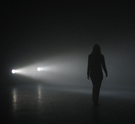
cinema sans image
In Mulholland Drive by D. Scott Hessels, three artists drove Los Angeles' famous Mulholland Drive with five types of sensors—measuring tilt, altitude, direction, speed, and engine sound. The captured data was used computationally to control two robotic lights in a dark room filled with fog. Two beams of light and the processed sound of the engine recreated the topology of the road as a new form of visual experience and sculpture—cinema without image.
Mulholland Drive is a light installation that translates the movement across a topology as two beams of light. Instead of direct human interaction, the work takes the sensed data (tilt, sound, and GPS) of traversing an environment and recreates the drive through angles, light, and sound. A passive interactive experience, the artwork emphasizes the spatial quality of light—it is cinema without image. Like cinema, direct data is captured, then edited, and shaped. However, here the environment directly defines the experience, using the geography computationally. In a sense, “Mulholland Drive” is a new media Earthwork and demonstrates how suddenly the rhythms, patterns, and random chance of the environment can be sensed through new media technologies and used to create new forms of visual experience.
Producing under the name Damaged Californians, Scott Hessels has released experimental art and commercial projects in several different media including film, video, web, music, broadcast, print, and performance for the last decade. His work has shown in international film and new media festivals, on television, and in contemporary art galleries. He recently completed a commission of three interactive films and six online movies for Australia and was honored with a career retrospective at the Melbourne International Film Festival. As a media artist, his installations have shown at CiberArt in Bilbao, the Hammer Museum in Los Angeles, and the Japan Media Arts Festival. Professionally, as Director of Information Technology for Fox Television, he was responsible for the systems, software, communications, and security for two television stations and two cable networks…a career he followed for 25 years. He currently teaches digital video at UCLA in the Design | Media Arts Department and is studying for his graduate degree in that field.
Posted by jo at 01:00 PM | Comments (0)
November 23, 2004
multi-disciplinary research in location aware media
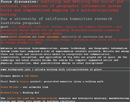
Location-Aware Research
Your participation is desired in an online forum geared toward focusing the theme for an interdisciplinary research residency proposal. The discussion will take place from November 26 through December 5. In the last few years, advances in wireless telecommunication, sensor technology, and Geographic Information System tools have inspired a tide of experimental creative projects. Artists are using these tools and location-aware media to renegotiate how communication, navigation, and big data are played out in space. As the landscape and urban streets become the canvas for computer augmented social and physical interaction, what possibilities emerge for practices outside the arts? How can we mutually inspire and inform diverse practices?
We request your participation in the form of either a question or suggested topic posted to the discussion list. Your inquiry will thus be fielded to an invited list of scientists, researchers and practitioners from diverse disciplines such as cognitive science, anthropology, archaeology, sociology, psychology, literature, science fiction, theatre, history, art history and theory, computer science, and earth sciences. We envision the role of artists in this discussion as minimal, more instigating than expository. You may find you will need to clarify your intended topic. Finding a common language among disciplines may constitute a valuable goal in itself! Your topic or question will alert scientists and researchers to some of the issues or questions that are engaged or encountered by artists working with locative media.
Our goal is to create an open channel for the scientist/researcher quotient of the discussion participants, who may not have considered a creative application of mobile media and mapping in the context of their research. The identification of critical issues, spaces of common interest, and potential blind spots between disciplines is of particular interest. A bibliography will be compiled and made available at the conclusion of this discussion. To participate in the discussion, go to http://34n118w.net/UCHRI
Here you will find directions for subscribing to the discussion list (available by this Thursday), as well as relevant links (available now).
Your input would be a valuable factor in a multi-disciplinary research residency to take place in the next year, pending funding. The research residency itself would be attended by participants chosen through an international open call by the University of California Humanity Research Institute. We greatly look forward to hearing from you. Feel free to contact us with any questions.
Sincerely,
Brett Stalbaum, Lecturer psoe, stalbaum @ ucsd.edu
Coordinator, Interdisciplinary Computing in the Arts Major, UCSD.
Naomi Spellman, Lecturer, spellman @ 4n118w.net
Interdisciplinary Computing in the Arts, UCSD.
Posted by jo at 10:48 AM | Comments (1)
Amsterdam RealTime
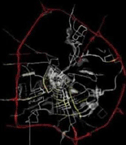
Drawing Routes of Mental Maps
For the exhibition Maps of Amsterdam 1866-2000 at the Amsterdam City Archive, Waag Society and Esther Polak set up the Amsterdam RealTime project. Every inhabitant of Amsterdam has an invisble map of the city in his head. The way he moves about the city and the choices made in this process are determined by this mental map. Amsterdam RealTime attempted to visualize these mental maps through examining the mobile behaviour of the city's users.
During two months (3 Oct to 1 Dec 2002) all of Amsterdam's residents were invited to be equipped with a tracer-unit. This is a portable device developed by Waag Society which is equipped with GPS: Global Positioning System. Using satellite data the tracer calculates its geographical position. The tracers' data are sent in realtime to a central point. By visualizing this data against a black background traces, lines, appear. From these lines a (partial) map of Amsterdam constructs itself. This map does not register streets or blocks of houses, but consists of the sheer movements of real people.
When the different types of users draw their lines, it becomes clear to the viewer just how individual the map of Amsterdam can be. A cyclist will produce completely different favourite routes than someone driving a car. The means of transport, the location of home, work or other activities together with the mental map of the particular person determine the traces he leaves. This way an everchanging, very recent, and very subjective map of Amsterdam will come about. Participants received a print of their personal routes through the city, their diary in traces. [Related]
Posted by jo at 09:58 AM | Comments (0)
The Gambit
![]()
The Narrative Abilities of Flowers
The Gambit is a portable interactive animation sited in the lobby of the Westin-Bonaventure Hotel (John Portman, 1977). The medium of the project is a digital compass attached to a PDA ("personal digital assistant") with a two and a quarter inch by three and a quarter inch color screen and headphones. This apparatus worn by the viewer displays images of spaces normally inaccessible to the viewer's vision from within the Westin's lobby, in other words, as if you're seeing through walls with a kind of periscope.
The "seeing through the walls" has a shape, like Gordon Matta Clark's cuts through buildings. The shape is configured by animated still images and sound. The still images and sound tell a story. The story is of a hotel flower arranger, and of a parallel world where flower arrangements have archival and narrative abilities. The Gambit is a project of Kati Rubinyi.
Posted by jo at 09:45 AM | Comments (0)
November 22, 2004
Affective Turbulence
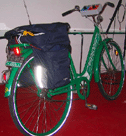
Tactical Urban Maphack
Mirjam Struppek has posted photographs of DEAF04: Affective Turbulence. The Tactical Urban Maphack: Open_Brunch Sensing Location (presentation) included an introduced by Marc Tuters, and the following projects:
FRIDA V [Free Ride Data Aquisition Vehicle]: A W-Lan mapping bicycle by Luka Frelih (SI). Frida V. is a rugged and comfortable bicycle equipped for efficient exploration and mapping of public urban spaces. It carries a small computer, GPS positioning device, 802.11 wireless network transciever and a basic audiovisual recording unit. The consolidated software and hardware assembly enables automated mapping of stumbled wireless networks, easy creation of location-tagged media and opportunistic synchronization with a server resource on the internet.
Cartographic Command Center: Display for locative media by Marc Tuters, Jaanis Garancs. The Mobile Cartographic Command Center (MC3) is the forward command post to engage free and open GIS, educational and commercial geographic institutions, and the tactical media art community in active discourse related to locative media, military conversion, collaborative cartography, and tactical public visualization. The purpose of the project is to actively create and display locative media and free GIS applications (such as, for example, gps3d, GPS satellite monitor/world view, gpsdrive, path tracking, vterrain, earth and SaVi- satellite Visualization).
Biomapping: Mapping the stressfactor in public space by Christian Nold. Bio Mapping is a research project which explores new ways that we as individuals can make use of the information we can gather about our own bodies. Instead of security technologies that are designed to control our behaviour, this project envisages new tools that allows people to selectively share and interpret their own bio data.
Posted by jo at 05:51 PM | Comments (0)
November 08, 2004
aura - The stuff around the stuff around you

Sonically Augmented Spaces
The aura project takes this on through the full sonic augmentation of real space. aura rejects visual interfaces (mouse, keyboard, screen) in favour of directional augmented reality using 3-dimensional sound to create a seamless, naturalistic experience. Augmented reality involves the overlaying of digital information onto real space. By moving through the real environment users experience the digital information at the location to which it refers. read more
Posted by michelle at 12:02 PM | Comments (0)
November 07, 2004
DEAF04

participatory locative sound imaging hoedown
Dutch Electronic Art Festival (DEAF) is a biennial international festival for electronic art, presented by V2_, Institute for the Unstable Media, in Rotterdam, The Netherlands.
TRAMJAM V.03- ROTTERDAM RUSHHOUR by Mumbai Streaming Attack is a multi-track- multi-driver mix hub streaming jam session of Rotterdam city vibe, orchestrated in sync with the city's tramlines' routing schedule. Play along November 12 if you're in Rotterdam. Mumbai Streaming Attack is a networked performance study group currently based at SNM/HGKZ in Zurich.
Also at DEAF04 (and simultaneously in New York, Brisbane, Linz, and Singapore) is media artist Zhang Ga's public art project The Peoples' Portrait, where five photo-capturing kiosks, including the location in the Times Square Alliance Information Center at 150 7th Avenue in New York City, are set up globally to capture a diverse range of people in their unique environments. Every few seconds, a central server will retrieve the portraits and display them first in time stamped order, then randomly from the archive. [Related]
Originally posted by Eli Chapman on unmediated
Posted by jo at 06:55 PM | Comments (0)
November 02, 2004
LOCATION!LOCATION!LOCATION!

GPS Data
Remote Location 1:100,000, by Paula Poole and Brett Stalbaum
Created during August 2004, Box Elder County, Utah, Remote Location 1:100,000 binds together data about landscape and the landscape as data, using GPS influenced tiles, soil samples, paintings and photo documentation. The project is sponsored by the Center for Land Use Interpretation. Paula Poole is adapting landscape painting traditions to new media. She centers on the landscape of the Great Basin desert of North America. Brett Stalbaum is a C5 research theorist and software development artist. He co-founded Electronic Disturbance Theater and collaborates with Paula Poole on land/walking/GPS/ locative/performance/pictorial works.
1:100,000 will be at YLEM Forum: LOCATION!LOCATION!LOCATION!; Three Projects in Locative Media by California Artists on Wednesday, November 10, 7:30 pm; McBean Theater, Exploratorium, 3501 Lyon St., San Francisco, CA. Free, Open to the public and wheelchair accessible. Also included are...
Slipstreamkonza:Autochamber by Christina McPhee with sound collaboration by Henry Warwick
Slipstreamkonza is a sonic topology that remediates carbon absorption and release data from the tallgrass prairie. Autochamber is a sound prototype that interprets data from an active climatologic research site using locative robotic sound within an conceptual practice following the historic HPSCHD by Lejaren Hiller and John Cage. Christina McPhee's new work from the series Strike/Slip/Merz_city will open at Transport Gallery in LA in March-April 2005.
34 north 118 west, by Jeremy Hight, Jeff Knowlton and Naomi Spellman
34 north 118 west uses GPS data and interactive map that triggers live data through movement in downtown Los Angeles. "34 north 118 west" won the grand jury prize at the Los Angeles based Art in Motion Festival, Aim IV, in 2003. Jeremy Hight is a writer fascinated by the weather and 'agitated space'. Naomi Spellman and Jeff Knowlton work in locative media, networked narrative, and were recently Artists in Residence at the Media Centre, Huddersfield, U.K.
Posted by jo at 10:14 AM | Comments (0)
October 28, 2004
MapTribe
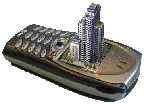
A tool for collaborative mobile learning
MapTribe is a software application for mobile phones. It enables group of users to see each other's position on a city map on the screen display, and to add on this shared map a certain number of objects that will positioned on the map according to the user's real position in the city.
MapTribe is based on the idea that every person retains and develops over time an image of the spaces s/he lives, which may be quite different from the physical inhabited place. It is commonly experienced, in fact, that places are enriched of psychological features that transform their perception. MapTribe is a tool for exchanging and comparing these personal images of the city among a group of friends. The tool we are developing helps people in analysing, capturing and visualizing this mental structure and to share it in a social network. From the negotiation of the differences between the maps of each participant in the group, a common understanding raises, an informal learning obtained by each user of the system about the image of the city.
Posted by jo at 10:37 AM | Comments (0)
October 27, 2004
A Taxi Tour of Site-Specific Video

Teletaxi
A project by the Year Zero One collective, Teletaxi is a site-specific media art exhibition in a taxicab. The taxi is outfitted with an interactive touch screen that displays video, animations, music, and information triggered by an onboard GPS (Global Positioning System) receiver which allows the displayed artwork to change depending on where the taxi is in the city. With the combination of the media/gps technology, the mobile environment and the passenger/audience inside the cab – the seven artists in teletaxi are offered a unique set of possibilities for showing their work - both technically and thematically.
Teletaxi exposed interactive media art to a normally passive audience, by presenting works that explore notions of intimacy, mapping, subterranean space, simulated cities, information architecture, data-visualisation, public interventions, surveillance and psychogeography.
Of note is David Jhave Johnston's project, Gridlock, which was included in the first public presentation of Teletaxi. Gridlock treats GPS as a number, which may be changing or not changing, rather than a number that refers to a location. Therefore, when the number does not change for a period of x seconds, the taxi is not moving, and there is a possibility that you are stuck in traffic. The Gridlock piece is triggered by this lack of movement, and offers a Flash-based game for frustrated taxi passengers. (Posted by Michelle Kasprzak)
Posted by at 01:07 AM | Comments (0)
October 25, 2004
Street Stories
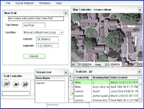
Social Computing, Maps and Storytelling
Last week, we attended Warren Sack's lecture at Rhode Island School of Art and Design (RISD). Sack referenced the writings of Robert Putnam (Bowling Alone: The Collapse and Revival of American Community), Guy Debord (The Society of the Spectacle or see this translation online), and Claude Shannon and Warren Weaver (information and communication theory + translation + A Mathematical Theory of Communication) to locate two of his well-known projects Translation Map, and Conversation Map, and a project that has gone through various phases and is still under development, Street Stories.
About Street Stories: For geographically-based community members, many local places have stories associated with them. Some of these are commonly-known stories; others are personal narratives associated with, for example, the house of one’s childhood or the place along the old train tracks where the sweetest blackberries grow. But when people move elsewhere or (sub)urban development paves over an area, the stories are decoupled from the places and the places lose their vernacular particularities and are transformed into much more generic spaces. As increasing numbers of geographically-based communities are displaced by network-based communities, the places of community–and their associated stories–are lost.
The goal of this research project is to invent new places of community memory and communication for the network society through the creation of a new practice and technology of storytelling. Prototypes of the proposed technology already exist. Many museums and historical sites have created audio tours by lending visitors a tape, recorder, headphones and instructions on when to start and stop the tape to hear the recorded story associated with the given place or artifact the visitor is looking at. Technologies of this sort that can automatically detect the visitor’s position in a defined space. The proposed technology is a digital, networked device (built using a wireless technology, global positioning system, and a handheld computer) that will allow visitors (or locals) to record and leave their own stories at any geographically specified location they desire.
Posted by jo at 01:12 PM
[Locative Media]
Why Geo-Annotating Location?
The blog Future Now dealt with the use of geotagging. I have always been amazed by this topic, especially with regard to how people will use it. There are many projects like Urban Tapestries, GeoNotes, Mauro’s projects…
The author proposes a kind of typology of geotagging uses (listen mauro!): There are 2 types of messages: "I was here" or "You are here".
People will take the time to compose a message and tag that message to a place because they want you to know that they were there, or because they have information that will be relevant to you later when you’re in the same location, or some combination of both.
From pasta and vinegar, October 25, 2004
And then, each of those 2 categories could be divided in:
the “I was here” motivation will be largely emotionally driven. Examples: 'This is the place where he proposed'; 'I needed to mark the spot where occurred'; 'I’m a tourist and really having a great time'; even 'I lost a bet, as part of my payoff I have to mark the spot where...' Ultimately, these types of annotations are still meant for other people – what is the sound of an unread geo-annotation? – but the value for the viewer will largely be to participate in someone else’s experience and get a sense of the unrecorded history of a place.
(…)
The "You are here" motivation for leaving physically-tagged messages would seem to offer more utility for both person tagging and person viewing. Examples: geo-personals ('if you’re in this location, you might be my type'); geo-classifieds ('if you’re here on this bike trail, you might want to buy the bike I’m selling'); announcements ('if you’re here, you might want to come to my event'); community organizing ('we're often here…if you are too, join us next time'); tips/assistance/warnings ('if you’re here at night, be extra careful', or ‘here’s what worked for me…'); lost&found (’if you're here, do you see the bracelet I lost?'); temporary notes ('if you’re here, we were here…an hour ago! now we’re at the party'); gaming and scavenger hunts (even incorporating features of the location – imagine GeoEverQuest in Central Park); and filling in gaps left by other annotations ('Did you know that this spot will be the site of Starfleet Headquarters? I bet *that* isn’t on the official geo-tour!').
I fully agree with the conclusions of the author: there are 2 crux issues: interface and people's adoption. The system is so related to people's use that it needs a critical mass of users (the system itself does nothing, it’s just a kind-of shell that allow a new type of interaction).
peterme argues that the author is wrong. He discusses the notion of doing stuff for yourself or for the others. He takes the example of del.icio.us. Why would you want to annotate space for yourself? For whatever reasons you would use del.icio.us. While del.icio.us thrives as a “social bookmark” site, it depends on the me-ness of the activity – by and large, I’m saving items to del.icio.us that interest me, that I might want to return to later, and the posting-for-others aspect is largely secondary. It’s an added benefit, but not the raison d’etre.
(…)
In fact, I would argue that if people are annotating space only to serve others, it will never, or only rarely, happen. What do I care what some stranger 8 months from now thinks about what I wrote at the corner of New Montgomery and Market in San Francisco? What on earth could I possibly say that’s meaningful to them? What benefit do I derive by acting as a tour guide to a stranger?
Comment »
1. In fact I argue that the key idea here is “communication". We leave these notes for communicating with our peers. Accidentally, we might be interested in strangers or putting lot of effort for others to recognise our persona. At the contrary we are more willing to spend time and energy to be in touch with our firend and to accomplish and acknowledge our connectedness.
Comment by Mauro — 10/25/2004 @ 3:04 pm
Posted by jo at 11:52 AM | Comments (1)
October 21, 2004
Psychogeography
"In psychoanalysis the word psychogeography is used in relation to phenomena of location based hysteria: you are perfectly sane, you enter a particular room and within a split second you are stark raving mad. Only when this response is universally shared and not dependent on a random individual neurosis, this power of a room can be called psychogeographic... In the end psychogeography is not about intervening through constructing (or demolishing) physical objects but about constructing narrative structures on top of what already exists."
From "Do-It-Yourself Urbanism: Psychogeography, Generosity, Serendipity and Turriphilia" by Wilfried Hou Je Bek/socialfiction.org
Posted by jo at 06:12 PM | Comments (0)
Come Closer

The Edges of Personal Space
Continuing squidsoup’s explorations into immersive intuitive media and the boundaries between virtual and physical space, Come Closer uses wearable technology, wireless networking and stereo vision to explore and expand on our sense of personal space and proximity to others. The closer two people get to each other, the more acutely aware of each other’s presence they become. This sensation may be comforting or disquieting, but participants are encouraged to transcend the normal barriers of personal space and explore the meaning of closeness in both virtual and physical terms. The space between people is filled with sound that is affected by their movement and position. With more people in a room, complex harmonies begin to appear and disappear, allowing scope for cooperation and confrontation, intimacy and rejection.
Posted by jo at 05:45 PM | Comments (0)
Malleable Music

Social tech is performative
"...Malleable Mobile Music system is my idea of truly social (i.e. performative) mobile tech.
"'Historically, music was never meant to exist in isolation,' Tanaka says. 'There was always a physical, acoustical, and even social context. These kinds of technologies can add some of those elements back in to the listening experience'...As one participant naturally sways to the groove, the PDA's motion sensor detects his motion and shifts the tempo of the song. With the song's intensity building, another listener subconsciously grips her PDA tighter, introducing echo effects into the mix. The closer that listening partners move to each other, the more prominent their part in the song becomes. Meanwhile, the software applies various 'error correction' techniques to prevent an onslaught of arrhythmic noise, unless of course that's the goal. As they listen to it, the mobile music orchestra transforms the tune into a dubby, spacey version of the familiar Bjork song...Someday, malleable music may even become an art form in its own right, leading to a duet between the artist and the audience."
Check out the Ubicomp 2004 paper for more detail. Originally posted by Anne Galloway on purse lips square jaw.
Posted by jo at 11:43 AM
October 20, 2004
A map larger than the territory
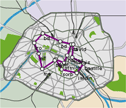
Mapping Flow, Crossed Paths
A Map Larger Than the Territory is a Web application that enables participants to represent their paths across the city using images, texts and sounds. Territory here is not a piece of land enclosed within borders but an interlocking network of lines or ways through. The map materialises and connects individual trajectories.
How does it work? Choose a city and a language. The map shows other people's paths in that city. A button at the right sends you to a blind map where you can add an itinerary of your own. To do so, you must first give it a name, a date and a color. Use the tools provided to locate places on the map and define points on your path. Each time you mark a location, a dialog box opens up for you to identify and describe it. When you have finished marking up your path, you can view the itinerary you have made.
Posted by jo at 10:42 AM
Geostash
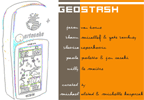
Hide, Seek, Act
Geostash is a public art project that uses the city of Toronto as its inspiration and utilises Global Positioning Technology (GPS) and the web as a means to achieve its creative goals. Geostash takes its cues from the practice of Geocaching (blogged here) - a sort of high-tech treasure hunt that was originally conceived in 2000, and has spread worldwide through websites promoting this activity. Each artist will hide a "stash" somewhere in the city and post the GPS co-ordinates of where the stash is hidden on the Geostash website. The stash may contain a set of instructions requesting an in-situ performance, or could contain objects, materials and a manual to create temporary public art. Once the stashes have all been placed in the city, each participating artist will be randomly assigned another artists' stash to find using a GPS receiver. Once found, the artist will transform the contents of the stash into a performance or ephemeral work of public art.
Date: October 29 - 31, 2004
Location: Various locations in Toronto TBA (check blog for updates)
Participating Artists: Jason Van Horne + Duncan Walker, Shawn Micallef
+ Gabe Sawhney, Slavica Ceperkovic, Paola Poletto + Jon Sasaki, Willy
Le Maitre
Curators: Michael Alstad & Michelle Kasprzak
Posted by newradio at 09:35 AM
October 19, 2004
Proboscis
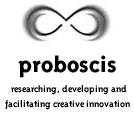
Actors, Agents and Authors
"...Proboscis is trying hasten the arrival of a world where people author as well as consume."
"I believe that this radical shift in information flow and control away from large institutions (both public and private) to ordinary people could have a profound social and cultural impact on the uses and implications of wireless and mobile technologies and mobile technologies in daily life, as well as social and community relations. I believe that the future for our society lies in broadening the capabilities of its members to be actors, agents, and authors, not merely consumers of a culture created by others employed in the 'culture industry.'" Giles Lane quoted by Howard Rheingold in Proboscis Probes Urban Public Authoring. Also, see post on Urban Tapestries.
Posted by jo at 08:48 AM
Teri Rueb

Connecting via Fluid Space
"The integration of data space and real space through mobile media and location-based systems brings back into circulation a whole host of communication rituals and interaction styles that engage the body, movement and context-sensitive exchanges. With the increasing ubiquity of wireless and mobile media, space is imagined as a Hertzian soup – a space of flows that defies the clear and fast boundaries of visual space and concrete form, instead emphasizing our connectedness in and through the social body." Continue reading Syncopated space – wireless media shaping human movement and social interaction by Teri Rueb.
As a digital artist, Teri Rueb explores the relationship between sound, space and human movement in location-aware installations and large-scale responsive spaces. She exhibits and lectures widely in international venues and is a professor in the graduate Department of Digital Media at the Rhode Island School of Design (RISD).
Posted by jo at 08:30 AM | Comments (0)
October 18, 2004
AudioHyperspace

audio »visions«
The Internet offers to the media as well as to the media artist a new electroacoustic space, abundant with audible live streams, audio on-demand, sound files and increasingly complex interactive audio art. These new possibilities may open up surprisingly new audio »visions« and provoke new strategies of perception. Audio on the Internet has made the boundaries between art, communication and play flexible. This offers a perspective on radio concepts and on radio art designs. AudioHyperspace guides you through the jungle of sound data and explores the development of sonic web art: every month it selects the most interesting audio websites and presents an annotated collection of links to audio and audio art on the web. Some examples of interviews:
Mobile Listening - Electrical Walks
Christina Kubisch in Conversation with Sabine Breitsameter
Sonic Art in Hertzian Space
Teri Rueb in Conversation with Sabine Breitsameter
Birdsong for the Mobile Age
Sadie Plant in Conversation with Sabine Breitsameter
Posted by jo at 12:56 PM
Traces of Fire
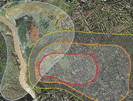
Barium Meals for the City force-fed
Traces of Fire, by Volkmar Klien & Ed Lear, starts with a pub-tour. "Couple of drinks, couple of cigarettes, off to the next bar...Next day, same thing...In each of the pubs we leave behind a nice silvery lighter...equipped with a nice little transmitter and its own transmission id. For several weeks we track the transmissions - tracing the lighters, tracing the fire, collecting the data; echo-soundings from within the urban habitat. Relaying times and locations to their observers, the lighters build an information model giving a sense of position and distribution--a presence in physical space. We toggle between information model and urban life. Logging data, tallying positions, extracting telling trends of behaviour. Reacting to the situations our roles as observers lead us into and pointing cameras in our specimens’ common grounds. Recording the soundscapes of places regularly passed...Marking encounters with inhabitants, handing out sparklers - capturing the moment for posterity. Recapturing the fire. Discovering traces left in an urban habitat we leave traces of our own."
Posted by jo at 09:10 AM
October 13, 2004
CITYchromosomes

Fixed Points Gathering Impressions
The Stadschromosmen (CITYchromosomes) project gathered thoughts and impressions of particular points around Antwerp and its districts that were shared via SMS. There were 25 ‘text points’, each inviting the submission of impressions about that place. After six months, a selection has been compiled into a booklet that combines the different ‘text points’ and gives an alternative view on Antwerp and its districts. The booklet (in Dutch) is available for download in PDF, plain text and a special version for iPods. By November 15, a complete English translation will also be available under the creative commons license.
"It’s been a fantastic, city-wide...event, put together against the odds and with very little support...by Stefan Kolgen and Ann Laenen of C.H.I.P.S, and including brilliant things like them spending a night turning all the city’s buses into Stadschromosomen text points and leading a walk with 200 recent immigrants round the city, asking them to text in their feelings about the landmarks of their new home town." FishArePeopleToo
STADSchromosomen is CityPoems’ sister project in Antwerp, Belgium, UNESCO's World Book Capital 2004. CityPoems and STADSchromosomen have 'twinned' matching locations in Leeds and Antwerp, to let you use your mobile phone to be in two cities at once.
Posted by jo at 03:05 PM | Comments (1)
October 12, 2004
CatchBob!

Locating Collaboration
CatchBob! is an experimental platform in the form of a mobile game for running psychological experiments. Running on a mobile device (iPAQ, TabletPc), it's a collaborative hunt in which groups of three persons have to find and circle a virtual object on our campus. CatchBob! will test how a location awareness tool modifies group interactions and communications, the way they perform a joint task as well as how they rely on this spatial information to coordinate. Series of experiments will be run to determine how location awareness impacts group collaboration. Read "Impacts of Location-Awareness on Group Collaboration" [PDF] position paper.
Via Emily at smartmobs
Posted by jo at 02:52 PM | Comments (0)
October 07, 2004
The Wireless Invisible

Sound Tracks and Data Footprints
"Stalking the footfalls and echoes of the wireless invisible" by Tobias C. van Veen, Horizonzero, Issue 15: New Movements in Digital Music
When what is "useful" is defined in terms of its market, when GPS directions lead to the nearest McDonald's, then wireless art becomes yet another pervasive intrusion, a one-way dictation. The ephemeral terrain of wireless art in all its forms is a floating, multicast struggle where the century old battles of radio are being re-played out. Yet - this time with Open Source software and technologies; with artist-driven hardware development; with a programmer's technique and a hacker's verve; and, like a hive, with a collective approach to anticipating the enemy's moves on the global level. This machine aims to engage the participant in the game: encouraging the step of becoming a content-creator rather than just a passive receptor, disrupting the sender/receiver of communication, the fortress of static/noise, of what defines efficiency and usability. The target of producing ever new and publicly-oriented ways of engaging life through the tendrils of technology is in sight. This disruptive yet productive desire has been a persistent dream since the avant-garde encountered radio one hundred years ago. Read article.
Posted by jo at 08:36 AM | Comments (1)
October 05, 2004
Life: a User's Manual, Part 2

Inhabiting Image Spaces
Commissioned by and currently on exhibit at Impakt Online, Life: a User's Manual locates the city of Utrecht as its game board, where every story, every piece stands on its own, but is part of an intricate jigsaw puzzle. Both public physical spaces and private interior spaces contain traces of fragmentary personal [hi]stories tied together by an invisible network of media. How people inhabit the hidden 'image spaces', discovered by a wireless surveillance camera scanner, while at the same time inhabiting physical outdoor spaces, was revealed through the daily practice of walking during the Impakt Festival 2003. The findings of Michelle Teran's walks have been arranged on a map of Utrecht's secret transmissions.
Life a User's Manual is a series of walking performances taking place in different cities (see an earlier post on this site), based around the activity of tapping into the unencrypted transmissions of wireless security cameras using a 2.4 Ghz receiver. In a search for the hidden stories within the city, a walk through the urban streets reveals an invisible network of watched spaces. The unencrypted signal from the camera leaks into public space, making it easily viewable from the street. This puts us in an interesting moment of uncertain inhabitation, of being in two spaces at once.
A tiny fraction of the spectrum of the airwaves has been allocated for public use, as if space and the air are not public already. Taking advantage of this unlicensed part of the spectrum, we have seen an increased used of wireless devices that are all fighting for use of this narrow band. Use of wireless [wifi] networks, cordless phones, bluetooth, and wireless cameras transmitting on this frequency contributes to an already existing invisible world of electromagnetic fields and frequencies that saturate our bodies on a daily basis. It becomes impossible to separate our bodies from the traffic reports, surveillance video, phone calls and pop songs of others. We wear each other's information.
Posted by jo at 11:10 AM | Comments (0)
October 04, 2004
Practice
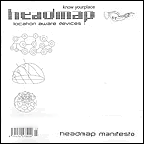
steps beyond the obvious
Esther Polak (Waag Society NL) and Leva Auzina (RIXC, LV) went some way towards rescuing landscape painting. They followed the driver of a milk truck through rural Latvia. He went through his daily routine of collecting up small amounts of milk from local people along a fixed route (in space and roughly in time). They traced the route using GPS units and software from the Realtime Amsterdam (and Riga) project. They took pictures, spoke to the people they met, and recorded interviews. In the end the GPS traces were inadequate. They had to sit down with the driver at the end of the journey with a map and pieces of paper and have him work through the broken traces with a pencil to produce a usable map of the route.
The result of the process was a very different view than photos, or interviews conventionaly produce. They had the drivers route, and maps, and time, and location to anchor point of view differently. They had misty pictures of people carrying milk churns through the countryside. But they also had a rich anchor for the systemic, subjective and spatial context; and more explicit than a literary or filmic narrative conventionally works with. The maps were generated by the people. Both implicitly, and explicitly as the man made sense of the journey he followed (six days a week) with a pencil, and a paper map, and GPS trace fragments.
The follow up thoughts were to trace the milk the next step of the way to the people who ended up drinking it (or consuming it processed into food). This opened up the idea of being able to trace what you consume or produce, right to producer or consumer. And further, open a dialogue between the participants in this cycle of production, distribution and consumption.
From an artists perspective it is now possible to (relatively easily) location stamp digital art work. The place where a work was made, or to which it refers can be logged using GPS for example. Work can be explicitly associated with a place digitally, and then 'found' according to spatial criteria: 'show me all the work associated with this place'. In mobile device terms, work can be accessed actually at a place predetermined by the artist or by the search criteria of the accessor.
How this is interpreted (conceptually and technologically) is up to artists, tool makers, and users.
Filmmakers for example can trace the spatial movements of the camera. Authors can place the next chapter at a new location. Musicians can spontaneously choose a location to perform and generate the audience through a combination of mapping and communications. Festivals, warehouse parties and rave variants have been working on these ideas for many years now, transforming dislocated spaces into gatherings though a disparate range of media.
In Karosta an audience of local people and workshop participants was led out in the dark through the woods to a clearing marked out by a circle of candles where Cheryl L'Hirondelle Waynohtêw was singing. Some way through, the audience (also singing) moved the circle of candles in closer, to make a smaller stage. The candles hinted at location aware, networked lights. You could have a lightweight portable stage that could be followed around, found and mapped on the net. Temporary, portable, visible (both visually and electronically), and findable architectural elements that would fit into a backpack.
Orientating usually requires a conversation with people who know where they are already. These conversations often serve to challenge the inhabitants of a place as to what their place means. Pete Gomes [Parkbench TV, UK] and Gabriel Lopez Shaw [US] found a group of local russian kids to show them around Karosta so that they could film. In the end the group made the film together. The kids found the locations, acted and improvised. Pete and Gabriel logged the locations and showed the kids filmmaking and GPS (the russian kids had long term access to film making and editing equipment through K@2 the Karosta based art project hosting the locative media workshop). Karosta is a very strange place, a borderland between cultures and times. The film explored Karosta in terms of dislocation and location, and its quality as a portal in time and space.
Inside K@2 Jo walsh sketched out an RDF schema for describing located media objects:
"We set out to develop a data structure for 'locative media'. This is partly a holding-place; an open standard format that can be simply re-purposed and re-represented. RDF was chosen because it allows metadata freedom; rather than the prescribed structure of a table with fixed relations to other tables, the underlying model is a graph of connections. 'database' carries the wrong connotations; this is more of a data model, a world model."
from Wilfried Hou Je Bek's database cartography; 'Mapping the patchwork of the street grid as a pattern of connections enables the cartographer to organize them in relativistic space.'
In this locative world model, the atomic unit could be the 'Packet'. A Packet is a state of affairs in space and time. Each Packet can be found at a unique URL on the web. the Packet is tagged with properties; these can be concrete, like latitude and longitude and timestamp, the packet's creator; or they can be abstract, descriptions of moments, feelings, smells. The 'tags' come from shared vocabularies which are published on the web." [see http://locative.x-i.net/karosta/]
All through the workshop participants and locals were focused out towards the surrounding area, trying to corrolate all media generated with location acquisition. Locals and artist going out would take a GPS and try and log location while taking film or photos or writing notes. Using the Waag society's realtime handheld tracking tools and the local GPRS network artists outside the K@2 center could be tracked and there journey traces visulised. Cheryl L'Hirondelle [CA] and Mari Keski-Korsu (FI) were monitored at K@2 after their trace went static for several hours (as they got more and more drunk on a beach with a couple of locals until one of their wives turned up).
Over the course of the workshop a whole sequence of journey traces was generated, enough to build up a subjective map of Karosta.
One night the workshop coordinator Mark Tuters [Locative, CA], with the Latvian electronic musician Voldomars Johansons [LV], and two of the RIXC staff went skinny dipping in the war harbour at 4am. Taking only themselves and a glow stick into the water they returned to find their clothes, and more importantly, the huge symbolic Jungian key to the K@2 centre, had disappeared. Marc turned up at the door with Voldomars behind him and red marks on his neck where one of his RIXC colleagues had tried to strangle him, still carrying the glow stick. Over the next few days all the clothes were found scattered imaginatively throughout the surrounding area.
One of the results of the workshop was a clearer understanding of the practical extant to which location adds a new dimension to media in social, artistic and technical terms. Locative media is a practice and it changes the way users relate to space and their work and each other.
Their were more theoretical aspects to the workshop. A number of the participants had backgrounds in radio.
A discussion between Zita Joyce and Adam Willetts [NL, NZ], radioqualia's Honor Harger and Adam Hyde [UK, NZ], and Ben Russell [Headmap, UK], focused on 'spectrum geography'.
Radio has always had an implicit and explicit connection with geography. For example the power and properties of a transmitter, determines the geographical region it can cover. Radio is a space altering technology, a property that can be articulated and used in many location and community related ways
The electromagnetic spectrum has a geography that can be mapped (see FCC frequency allocation tables), and that can be visualised spatially (see Fiona Raby's 'Flirt' and Anthony Dunne's book Herzian Tales)
Spectrum and space share the fact that they both seemed like finite resources. Now with advances in computing, one piece of spectrum can be divided up almost infinitely. Parallel advances in locative technologies mean that one piece of land can hold an infintite number of digitally mediated constructs and annotations.
Mobile phones which are essentially complexly networked walkie talkies, that use the landline marketing strategy. Instead of selling the open channel, you sell call time on a temporary connection. IP telephony (the word telephony encodes the marketing model) has no reason to follow this model, the infrastructure is already there, no additional exchange or network needs to be built. Open channels are as easy as finite, time limited (and costed) channels. Quake players for example use open channels, for no additional cost. The business model shapes the experience.
The sale of domain names, the primary method of taxing the internet, involves selling something which does not really have a value in the sense that domain names are only vaguely a finite resource and are just an entry in a database.
In the tracking industry there are also parallel examples. 'Geo fences', that is establishing an area and triggering an action if a tracked object enters or leaves that area, are already marketed and sold by some companies despite being a short entry in a database.
Marketers working on location awareness as a business model are going to be working to produce more examples of concrete sounding products which are actually trivial to activate, and involve no (or very little) effort to maintain once the structures are in place to run the larger system. Beyond artificial restrictive walls, marketing also has a simplifying and describing function.
Effective use of locative technologies requires hardware evolution. But also new metaphors that can underpin new interface concepts, that generate new ways of understanding and using the intersection of space, locative hardware and locative software.
Finding innovative uses for locative media probably involves using it for a while rather than endlessly trying to imagine the steps beyond the obvious.
Submitted by locative on Sun, 01/18/2004 - 02:18. Karosta
Posted by jo at 07:21 PM | Comments (0)
Distributed Form: Network Practice
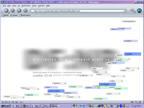
Dominant Spatial Paradigm
Distributed Form: Network Practice, University of California, Berkeley, October 22-24, 2004
"Recent developments in information technology have resulted in the entrenchment of networks and distributed systems as the dominant spatial paradigm, effectively challenging fundamental design issues of autonomy, originality, place, practice and form, which reconfigure disciplines through the implementation of distributed logics and collaborative 'open' practices. As a benchmark, this conference will analyze how the disciplines of art, science and architecture are responding to rapidly changing mobile, wireless, and information-embedded environments.
The conference will be organized around a multidisciplinary framework operating at three different scalar levels: At the Meta level, the conference will first address Form and the Network, raising issues of architectural morphology of and within networked society, by building a provisional history of networked design processes and production.
The second session, Form and Technology, will consider current research on the relationship between experimental digital technologies and emergent form.
The third panel, Micro: Form and Operation, will address theories of operative design strategies, social relationships and bodiless form.
The fourth panel, Mega: Form and Presence, will investigate how larger scale networks and their reconfiguration of time and space are altering professional design practices, while critically considering a logic of connection as the primary site of design."
Posted by jo at 06:22 PM | Comments (0)
October 01, 2004
PERVASIVE AND LOCATIVE ARTS NETWORK (PLAN)
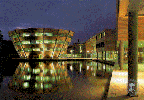
THIS IS THE (PLAN)
A new international and interdisciplinary research network in pervasive media and locative media has been funded as part of the Engineering and Physical Sciences Research Council (EPSRC) Culture & Creativity programme. The network will bring together practicing artists, technology developers and ethnographers with the aim of advancing interdisciplinary understanding and building consortia for future collaborative projects.
The network will stage three major gatherings. Each gathering will have a distinct form and focus: an initial workshop to launch the network and assess the state of the art; a technology summer camp for artists and technologists, including hands-on prototyping sessions using the facilities at Nottingham's Mixed Reality Laboratory; and a major public conference and participatory exhibition as a central component of the Futuresonic 2006 festival in Manchester; as well as a supporting web site and other resources.
CALL FOR PROPOSALS - PLAN Workshop
Submissions are invited to the first of these events, a two day public workshop with papers, demos and discussion sessions. The aim of the event is to launch the network, review the state of the art, bring key players in the field together, and make initial contacts. The event will also aim to identify a range of specific interests that can lead to the formation of sub-groups within the network. Position papers and a summary report will subsequently be published on the network web site.
The workshop will take place in London over two days in the week beginning 24th January 2005. Venue and final dates announced soon.
Please send submissions to ben@open-plan.org by Monday 8th November.
We request that participants seek support for travel and subsistence from their institutions. For participants without institutional affiliation the network shall support applications to funding councils and foundations, please contact us for further details.
THE NETWORK
Pervasive and Locative Arts Network (PLAN) - Enhancing Mobile and Wireless Technologies for Culture and Creativity
This network will draw together computer scientists and engineers who are leading the field in developing pervasive and locative technologies; artists who are using these technologies to create and publicly deploy innovative and provocative experiences; social scientists with a proven track record of studying interactive installations and performances; industrial partners from the creative industries, spanning the arts, television, games, education, heritage, mobile computing and telecommunications sectors; and international partners who are coordinating parallel networks around the world.
NETWORK OBJECTIVES
The network aims to support the formation of a new interdisciplinary research community to investigate how the convergent fields of pervasive media and locative media need to evolve in order to support future cultural and creative activities. Specific network objectives are:
-To review the scope of the research that is currently being carried out in
these fields through a focused workshop, leading to an integrated state-of-the art survey paper.
-To identify the key research issues that need to be addressed in order to further develop pervasive and locative media to support culture and creativity, leading to a series of discussion white papers.
-To seed future projects by bringing artists, scientists and industry together in a creative environment so that they can generate and practically explore new ideas, and also to provide a forum for publicly demonstrating some of these.
-To produce online and offline resources to support researchers, artists, industry and to promote public understanding of this emerging field, including a public website, an online document repository for members and a newsletter and DVD.
NETWORK ACTIVITIES
The network will organise and support a range of activities aimed at growing a research community and generating new collaborative projects between artists and technologists. These will include staging three major research gatherings, producing online and offline resources for fellow researchers and PhD students, and outreach activities targeted at industry.
Gatherings
We will stage three major gatherings. Each gathering will have a distinct form and focus: an initial workshop to launch the network and assess the state of the art; a technology summer camp for artists and technologist, especially PhD students, including hands-on prototyping sessions using the facilities at Nottingham's Mixed Reality Laboratory; and a major public conference and participatory exhibition as a central component of the Futuresonic 2006 festival in Manchester. These major gatherings will be interspersed with more ad-hoc steering and reflection meetings as required by the network participants.
Producing resources
We will produce resources to publicise the network, encourage the exchange of perspectives and discussion, and to provide tutorial support for PhD students, artists and other researchers who wish to break into this area. These will include:
-Online resources: a public website providing access to network information including project deliverables as well as news of forthcoming calls for proposals and conferences, supported by a online document repository where members can upload documents and take part in discussion. The latter will be realised using BSCW or Project Place software.
-Offline resources: a six monthly printed newsletter and a DVD of video
Outreach
The network will reach out to other researchers beyond the initial partners and also to the creative industries. This will include distribution of the newsletter and also staging a series of industry seminars, for example as part of the TI/EPSRC Outreach programme. The network research associate will also carry out a series of site visits to different partners and potential partners in order to learn more about and report on ongoing activities.
BACKGROUND IN SCIENCE AND CULTURE
A new generation of pervasive technologies is enabling people to break away from traditional desktop PCs and games consoles and experience interactive media that are directly embedded into the world around them. And locative media, the combination of mobile devices with locative technologies, supports experiences and social interaction that respond to a participant's physical location and context. Together these convergent fields raise possibilities for new cultural experiences in areas as diverse as performance, installations, games, tourism, heritage, marketing and education.
A community of researchers working in pervasive media, also known as ubiquitous computing, are exploring location awareness as a requirement for the delivery of accurate contextual information. Another community, primarily consisting of informal networks of technical innovators and cultural producers, which identifies its field as Locative Media, is exploring developments in and applications of locative technologies within social and creative contexts. One of the aims of this network is to bring these two communities together, linking academic research initiatives and agendas to key figures and ground breaking developments that are currently taking place outside mainstream academia.
The creative industries are also beginning to take up these opportunities, led by artists who are actively charting out the potentials and boundaries of the new pervasive and locative media. Other cultural sectors have also been exploring the potential of pervasive and locative media including the games industry through commercial examples of locative games played on mobile phones such as Bot Fighters and Battle Machine and also research projects such as ARQuake, Mindwarping, Pirates! and Border Guards. Researchers have also demonstrated applications in heritage and tourism, for example personal tourist guides and outdoors augmented reality displays and as well as in mobile learning experiences and participatory local history mapping projects.
A key characteristic of this research is its interdisciplinary nature, with many of these projects combining practicing artists, technology developers and also ethnographers, whose studies of early experiences that are actually delivered as public artworks have yielded new insights into the ways in which participants experience pervasive media, for example how they (and performers and technical crew) deal with uncertainty of location and connection, and, conversely, new metaphors for engaging in locative media.
However, realising the full potential of pervasive and locative media requires several further developments. First, it is necessary to expand the research community, drawing in new academic partners and also a greater range of partners from the creative industries. Second, it is important to deepen the interdisciplinary relationships between artists, technology developers and social scientists working within and between these two convergent fields. This is not only a matter of reflecting on this relationship, it is also necessary to pursue it in practice, which means forming new collaborations leading to practical projects. Third, we need to clarify and deepen the research agenda for this area, by opening up a variety of research questions, including:
-To what extent does the convergence of pervasive media and locative media signify a commonality of views, definitions and issues in each field?
-What new kinds of cultural applications will become possible through pervasive and locative media? Can we envisage new installations, performances, games and other public experiences?
-Can common design frameworks and tactics help create powerful user experiences? Can we identify and share design guidelines and generate useful abstractions, for example building on recent proposals for deliberately exploiting uncertainty and ambiguity
-What tools are required by creative users, for example that enable them to easily (re)configure an experience to work in different locations or to orchestrate it from behind the scenes. What new research challenges do these embody, for example, how do we visualise the state of the technical infrastructure-networks and sensors-96 or intervene in participants' experiences?
-What methods do researchers use to design and evaluate their experiences? We already see the use of ethnographic studies, audience discussions and even analysis of system logs; how should these be extended and can we share approaches, tools and even datasets to enhance our understanding of experience and design?
These questions, combined with the need to build a broader inter-disciplinary research community, provide the underlying motivations for this network.
INITIAL NETWORK
Project investigators:
Steve Benford, Nottingham (Principle Investigator)
Drew Hemment, Salford
Henk Muller, Bristol
Matthew Chalmers, Glasgow
Michael Sharples, Birmingham
Geraldine Fitzpatrick, Sussex
Christian Heath, Kings College
Jon Hindmarsh, Kings College
Network co-ordinator:
Ben Russell, Headmap/Locative Media Lab
Initial partners:
Marc Tuters, Locative Media Lab
Dennis Del Favero, NSW iCinema
Steve Sayers, NESTA
Toby Barnes, EM Media
Richard Hull, HP Labs
Denny Plowman, City of Nottingham Council
Sara Diamond, Banff Centre
Andrew Caleya Chetty, Metapod
Amanda Oldroyd, BT Exact
Matt Adams, Blast Theory
Nick Southgate, Ricochet TV
Annika Waern, iPerG
Giles Lane, Proboscis
Minna Tarkka, m-cult
Carsten Sorensen, LSE
Angharad Thomas, Salford
Chris Byrne, New Media Scotland
Paul Sermon, Salford
Nina Wakeford, INCITE, Surrey
Posted by jo at 08:20 AM | Comments (0)
September 27, 2004
swimming together

tunA
tunA is a handheld ad-hoc radio device for local music sharing created by Arianna Bassoli, Julian Moore, Stefan Agamanolis at the Media Lab Europe.
tunA is a mobile wireless application that allows users to share their music locally through handheld devices. Users can "tune in" to other nearby tunA music players and listen to what someone else is listening to. Developed on iPaqs and connected via 802.11b in ad-hoc mode, the application displays a list of people using tunA that are in range, gives access to their profile and playlist information, and enables synchronized peer-to-peer audio streaming. (from the website)
The idea is to use music to connect people at a local level and engender the sense of a shared experience.
Posted by newradio at 01:00 PM
September 26, 2004
QUIXOTE

A Moblog Performance in Turin
During the week of September 23, 2004 Quixote, a puppet, will explore Turin travelling within a network of writers, undefined at the beginning and growing day by day. Their task will be to accompany him around sharing his story with us, chronicling his journey through the city.
Quixote's journey is tracked via a GPS/GSM system in order to show on the website the exact geo-location of each moblog post and to define the topology of the network arisen during the performance. The project is an ongoing investigation around digital mobility and social networks in relation to new forms of mobile expression and interaction.
As of March 2005, Quixote has a new moblog.
Posted by jo at 03:45 PM | Comments (0)
wireless networks
Without the Net
Douglas Rushkoff's Networks Without the Net initiates an exploration of what a wireless network really is. Referencing the work of Julian Bleecker (WiFi Bedouin), MediaLab Europe (tUNA), and Jonah Brucker-Cohen and Katherine Moriwaki (umbrella.net), he suggests that "Just as the Internet fostered a global connectivity for users pinned to their desktops, the wireless network--by going along in one's pocket--... enhance[s] users' connections to their immediate environments and temporary communities."
Rushkoff's concern is that software developers begin to think of wireless devices as "quite capable of constituting new networks, all by themselves," networks that are Internet-independent and focus us on our local environments.
You might want to check the "locative media" on this blog and articles like Kate Armstrong's on location aware fiction. They add strength to Rushkoff's insights and argument.
Posted by newradio at 03:00 PM | Comments (0)
physical proximity
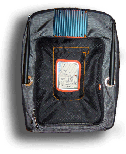
WiFi.Bedouin
Conceived and developed by Julian Bleecker, WiFi.Bedouin is a wearable, mobile 802.11b node disconnected from the global Internet. It forms a WiFi "island Internet" challenging conventional assumptions about WiFi and suggesting new architectures for digital networks that are based on physical proximity rather than solely connectivity. Most significantly, WiFi.Bedouin facilitates the creation of a truly mobile web community.
WiFi.Bedouin is designed to be functional as well as provocative, expanding the possible meaning and metaphors about access, proximity, wireless and WiFi. This access point is not the web without wires. Instead, it is its own web, an apparatus that forces one to reconsider and question notions of virtuality, materiality, displacement, proximity and community. WiFi.Bedouin is meant to suggest that what are often considered two entirely separate realms - virtual and physical worlds - are actually a much more entangled hybrid space. (from the web site)
Posted by newradio at 02:06 PM | Comments (0)
September 25, 2004
street stories

[murmur]
[murmur] is an archival audio project that collects and curates stories set in specific Toronto locations. At each of these locations, a [murmur] sign marks the availability of a story with a telephone number and location code. By using a mobile phone, users are able to listen to the story of that place while engaging in the experience of being there.
Toronto is a city of stories. But the rapid progress and growth that replaces its structures erases its stories as well. [murmur], conceived by Shawn Micallef, James Roussel and Gabe Sawhney, aims to keep these stories alive and on the streets. Their plan is to expand throughout Toronto, step by step, until a [murmur] sign is located everywhere a story the rest of us should hear exists.
For more, read the 8/19/04 Eye article Flaneur by Phone
Posted by newradio at 05:58 PM | Comments (0)
location aware fiction

Hypertext's limit exceeded
The emergence of location aware or physically located narrative works is the subject of Data and Narrative: Location Aware Fiction, a Trace article by Canadian writer and new media artist Kate Armstrong.
Earlier Turbulence blogs have described one of the works Armstrong addresses, 34 North 118 West by Los Angeles artists Naomi Spellman, Jeremy Hight and Jeff Knowlton. Its focus is on "narrative archaeology" and "the investigation of liminal city areas such as abandoned industrial zones, in which layers of time and story are unveiled to the wandering reader/user. As they move through the area, a GPS reading triggers audio fragments in the headphones, resulting in a dynamic fictional experience that follows the user's unique path." (Armstrong)
Armstrong references a second work as well--[Murmur]--by the Toronto-based collective of the same name. [Murmur], she writes, is an "archival audio project"; it "establishes links between narrative fragments and specific points in city neighbourhoods...When a user calls in using a cellular telephone, points in the city scape marked by encoded street signs trigger stories collected from other users and residents."
What intrests Armstrong is how these works push the limits of hypertext by pulling the reader away from the screen and back into physical space. As she says, they "take spatial and navigational relationships outside the almost purely mental space of the computer and posit them in the living city...It is hypertext but without the links between nodes: nodes in physically located narrative works are imbued with content and then left where they can be encountered by the reader/user/walker - in any order, in no order, in an order determined by the movement of the user. The last mechanical determination of the author is erased: the reader has total agency in an uncontrollable, unpredictable, living city. It makes hypertext seem microcosmic, almost sterile - at least more sterile than the world."
Kate Armstrong is a new media artist and writer. Her physically located narrative project PING is on exhibit at the Contemporary Art Centre in Vilnius, Lithuania.
Posted by newradio at 04:49 PM | Comments (0)
September 23, 2004
ACCESS
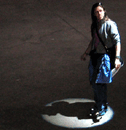
Undesired Spotlight
ACCESS is a public art installation by Marie Sester that applies web, computer, sound and lighting technologies in which web users track individuals in public spaces with a unique robotic spotlight and acoustic beam system. The robotic spotlight automatically follows the tracked individuals while the acoustic beam projects audio that only they can hear. The tracked individuals do not know who is tracking them or why they are being tracked, nor are they aware of being the only persons among the public hearing the sound. The web users do not know that their actions trigger sound towards the target. In effect, both the tracker and the tracked are in a paradoxical communication loop. The ACCESS spotlight system travels from one undisclosed public space to another. The exact location of the public space is revealed only after ACCESS moves to its next location. The ACCESS website, which contains the webcam view and spotlight control, keeps an updated list of the locations visited as well as a video archive. Click here to participate.
Regine blogged this on we make money not art
The content of ACCESS calls for awareness of the implications of surveillance, detection, celebrity, and their impact on society. The structure of ACCESS is intentionally ambiguous, revealing the obsession/fascination for control, visibility, and vigilance: scary or fun. ACCESS was primarily influenced by the beauty of the surveillance representations (x-rayed bodies, luggage or vehicles, 3D laser scans, satellite reconnaissance imagery, etc.), the invisibility of the collected data, and the power generated by means of surveillance practices.
Posted by jo at 07:30 AM | Comments (0)
ACCESS

Undesired Spotlight
ACCESS is a public art installation by Marie Sester that applies web, computer, sound and lighting technologies in which web users track individuals in public spaces with a unique robotic spotlight and acoustic beam system. The robotic spotlight automatically follows the tracked individuals while the acoustic beam projects audio that only they can hear. The tracked individuals do not know who is tracking them or why they are being tracked, nor are they aware of being the only persons among the public hearing the sound. The web users do not know that their actions trigger sound towards the target. In effect, both the tracker and the tracked are in a paradoxical communication loop. The ACCESS spotlight system travels from one undisclosed public space to another. The exact location of the public space is revealed only after ACCESS moves to its next location. The ACCESS website, which contains the webcam view and spotlight control, keeps an updated list of the locations visited as well as a video archive. Click here to participate.
Regine blogged this on we make money not art
The content of ACCESS calls for awareness of the implications of surveillance, detection, celebrity, and their impact on society. The structure of ACCESS is intentionally ambiguous, revealing the obsession/fascination for control, visibility, and vigilance: scary or fun. ACCESS was primarily influenced by the beauty of the surveillance representations (x-rayed bodies, luggage or vehicles, 3D laser scans, satellite reconnaissance imagery, etc.), the invisibility of the collected data, and the power generated by means of surveillance practices.
Posted by jo at 07:30 AM | Comments (0)
September 22, 2004
Geo-Cinema

Embedding GPS in Moving Images
"If we can send a picture of a place, why wouldn’t we want someone else to find exactly the same spot? The same angle? The same longitude and latitude? The same Place." Being On Location: The beginnings of a Geo-Cinema & Location-aware video recording. See also: Get Carter 1971 Location List & Days in the Country & Photo recognition software gives location & RAW What happened in that minute before you took a picture? (=place) & this MDVR from March Networks & Data and Narrative: Location Aware Fiction.
originally posted by thomas, 04.11.04 on angermann2.
Posted by jo at 11:21 AM | Comments (0)
BioMapping.net

How Did You Feel?
Bio Mapping is a research project which explores new ways that we as individuals can make use of the information we can gather about our own bodies. Instead of security technologies that are designed to control our behaviour, this project envisages new tools that allow people to selectively share and interpret their own bio data.
The current version of the Bio Mapping system allows people to measure their Galvanic Skin Response (GSR), which is a simple indicator of emotional arousal in conjunction with their geographical location. By sharing this information we can construct maps that visualise where we as a community feel stressed and excited. Will other people’s experiences allow us to engage differently with our environment?
Posted by jo at 10:34 AM | Comments (0)
September 21, 2004
Life: A User's Manual
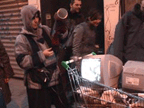
Subverting Surveillance Tactics
Life: A User's Manual is a public performance by media artist Michelle Teran where she dresses up like a bag lady and carries an antenna made out of a soup can while pushing a shopping cart full of televisions along a designated route in Brussels, Belgium. The antenna is connected to a 2.4 GHZ X-10 video scanner which picks up signals from wireless cameras deployed by stores, homes, or police in the buildings and neighborhoods she passes. The found signal is then displayed on the TV in her cart. This type of surveillance is a theme of Teran's work that attempts to make hidden or private CCTV streams into public performance and online mappings. Really interesting take on the act of subverting existing surveillance tactics by displacing the context of the medium.
From her description: “The city is a game board, where every story, every piece stands on its own, but is part of an intricate jigsaw puzzle. Both public physical spaces and private interior spaces contain traces of fragmentary personal [hi]stories tied together by an invisible network of media. How people inhabit the hidden ‘image spaces’, discovered by a wireless surveillance camera scanner, while at the same time inhabiting physical outdoor spaces, is revealed through the practice of walking.” From jonah at coin operated.
Posted by jo at 07:39 AM | Comments (1)
September 20, 2004
Tactical Sound Garden [ TSG ] Toolkit

Shaping Space Through Sound
The TSG Toolkit is an open source platform for cultivating public "sound gardens" within urban environments. The TSG offers the urban dweller a participatory role in shaping the soundscape of contemporary public space: it enables anyone with a WiFi enabled mobile device (handheld, laptop, etc) to "plant" sounds within a networked, 3D audio environment. These "plantings" are mapped onto the coordinates of a physical location, overlaying a collaboratively constructed soundscape onto a specific urban space. Wearing headphones connected to a WiFi enabled device, participants drift though virtual sound gardens planted by others as they move through the city.
Posted by jo at 12:37 PM | Comments (0)
September 19, 2004
Hubbub
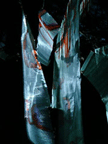
Speech-painting public places
Hubbub is an investigation of how accidental and non-accidental conversations can by catalyzed in urban spaces by means of speech projected onto public surfaces. Hubbub installations may be built into a bench, in a bus stop, a bar, a cafe, a school courtyard, a plaza, a park. As you walk by a Hubbub installation, some of the words you speak will dance in projection across the surfaces according to the energy and prosody of your voice. Read PDF>>
Posted by jo at 07:49 AM | Comments (0)
September 18, 2004
Chased in Brighton and Barcelona
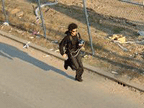
Can You See Me Now?
(from AudioHyperspace of SWR2 RadioART: Hörspiel by Sabine Breitsameter.) Highly recommended: For those who want to experience Blast Theory's live and online game "Can You See Me Now", note the following dates: From 27 September to 1 October 2004, you can take part - corporeal - in Brighton, UK, and from 28 to 31 October 2004, join the game in Barcelona during the "ArtFutura"-festival. Those who cannot make it to these places: It is also fun to join the game online. [more]
Posted by newradio at 10:48 AM | Comments (0)
Automated Prayer Machine

Immersive Radio
The Automated Prayer Machine repositions radio as an antidote to despair. We create an expansive radiophonic sound environment by manipulating signals rebroadcast through a low-watt FM transmitter to multiple receivers in the audience. Digital video projection, live accordion, violin and voice complete the circuit, activating the metaphorical prayer machine.
"Bridging locative media and radio, as well as offering a critical and feminist voice, is the work of Anna Friz...and Annabelle Chvostek...Automated Prayer Machine...seeks to "proactively change the function of radio" by integrating radio speakers into (what was) the audience, thereby "activating acoustic listening space that also has a radio quality... making one aware of being out in the audience, in an immersive radio experience."
Mixing live radio samples, shortwave noise, fundamentalist talk radio, and prayers sent via voicemail and email, Chvostek and Friz are reinserting community voices and empowering wireless practice and discourse by spanning the tradition of radio with an awareness of context and location that addresses the crucial tensions of the wireless arts. For Friz, "radio addresses the same subjects new media tried to address. The hopes are and were the same, the barriers are the same: Who are you when you are in this mediated state? What is it that you want? How profound is this communication, and through the distance and nearness of geography? In new media, the tool still leads the work: beware the tool that leads." From "Sound Tracks and Data Footprints Stalking the footfalls and echoes of the wireless invisible," Tobias C. van Veen, HorizonZero, Issue 15.
Posted by jo at 08:39 AM | Comments (0)
September 17, 2004
billboard
ABC: Alphabet Billboard Cambridge
Alphabet Billboard Cambridge (ABC) is an interactive portrait of Cambridge and its surroundings, its people and their lives - designed for and displayed at the city's foremost arts space, the Junction. The portrait unfolds in real time over a period of three years on an impressive 7.5-meter electronic billboard running along the southeast side of the Junction, to which participants, residents of the Cambridge area, send images taken with picture-messaging phones provided exclusively for the project.
Each week over a three-year period, one selected person in Cambridge takes part in the ABC project. Each participant is given a phone for the week to use to send pictures as often, or as sporadically as they wish, creating a photo-diary.
Participants take images documenting any aspect of their lives and surroundings - from personal life and people around them to landscapes, favourite places and their jobs - and send them to the billboard, live, in real time. (from the website)
Posted by newradio at 04:50 PM | Comments (0)
Locative Media List
Steve Dietz's Locative Media list
Originally posted by icon from pasta and vinegar, reblogged by Gavin on clippings Sep 17, 2004.
Posted by jo at 01:55 PM | Comments (0)
September 12, 2004
mobile performance group
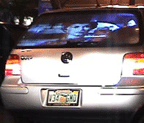
(auto)mobile performances
04.15.04 Downtown Orlando FL: Using the automobile as a mobile performance apparatus MPG presented a live performance which included real-time video and audio processing techniques. This project used two cars, one with audio performers the other with video performers. Using wireless networking and a FM transmitter the two cars where able to keep in sync and perform together as they moved through the city. Performers where Laura Oxendine, Adam Roberts, Martha Garzon, Damion Waters, Bryan O'neal, Ben Hustis, Julius Santiago, James Auten, Chester Udell, Jamie Tauler. Project Leaders where Nathan Wolek, Matt Roberts.
MPG:Mobile Performance Group is a collective of new media artists interested in finding new ways to present art outside of traditional venues. The Group was founded by Matt Roberts and is based in Florida. Using custom video and audio software instruments in real-time, and original video and audio recordings, Roberts and Wolek will present a meditation on the Florida Landscape which will be realized as an improvised new media performance at the New Forms Festival, Vancouver, Canada on October 24, 2004.
Posted by jo at 04:46 PM | Comments (0)
August 28, 2004
More from the 34North folks
Jeff Knowlton and Naomi Spellman are doing a residency at The Media Centre in Huddersfield. Here's their description of what they are up to:
http://www.druh.co.uk/residencies.html
The work we are developing is an urban exploration shaped from the immediate environment and from online databases. It unfolds in realtime, through space, as the visitor makes her way through the city. The Interpretive Engine creates an audio and visual narrative, relying on the visitors' location and direction – as well as on access to wireless internet connections along the way. The Interpretive engine is a computer-based work, which can be experienced singly or in small groups, either from a visitor's own laptop, or from equipment checked out to visitors. It requires no input from the visitor, other than her natural progression through a loosely delineated space. The project takes into account local surroundings, events, and available telecommunications infrastructure.
Server side data will be parsed in real time from a variety of predetermined online resources, including a news source, a national or metropolitan historic database, a weather source, a local directory, most-wanted international criminal directory, etc. The project will parse and interpret this data, and integrate it into a site specific narrative. Key to this project is a shift in consciousness of the listener, through an exposure of something that is already always present: the [invisible] wireless network. We will encourage visitors to question how informational databases are accessed and controlled in an era of increasingly pervasive corporate and governmental control.
Posted by at 03:01 PM | Comments (0)
ubiquitous computing and the production of space

Call for WiFi.ArtCache Participants
This is a call for contributions to art-technologists interested in contributing to the WiFi.ArtCache during its exhibition at Spectropolis October 1-4, 2004. Deadline for submissions is September 26th.
By simply coding to a provided ActionScript 2.0 API, Flash artists are able to create an interactive experience that changes based on how many people have downloaded their art object, how many people are currently interacting with their art object, or whether their art object is currently in range of the WiFi.ArtCache. Here are earlier posts about WiFi.ArtCache and Spectropolis.
The WiFi.ArtCache is a physical object server containing a standard WiFi 802.11 access point. When exhibited at the Spectropolis event at New York's City Hall Park in Lower Manhattan, the WiFi.ArtCache will contain a storehouse of art objects. Visitors to the event can download these art objects onto their 802.11 equipped laptops and experience the artists' interpretation of location and proximity effects.
Developer documentation and downloads can be found at:
http://wifiartcache.techkwondo.com/overview.jsp
http://artcache.techkwondo.com/overview.jsp
Please send submissions, questions and inquiries to wifiartcache at
techkwondo dot com.
General information about the WiFi.ArtCache concept can be found at:
http://www.techkwondo.com/projects/artcache/
Additionally, the WiFi.ArtCache will contain a generic storehouse of digital ephemera that visitors can upload and download to the server. Scratchy audio, yellowed digital documents, discolored image files and spoiled emails can all be found and dropped off at the WiFi.ArtCache.
WiFi.ArtCache was developed by Julian Bleecker with support from Eyebeam Atelier. This exhibition is sponsored by the Downtown Alliance, NYCWireless, the Lower Manhattan Cultural Council and Spectropolis. Spectropolis is curated by Wayne Ashley, Yury Gitman and Brooke Singer.
http://spectropolis.info
http://www.techkwondo.com/projects/artcache
http://www.eyebeam.org
http://www.nycwireless.org
http://www.lmcc.net
Posted by jo at 10:57 AM | Comments (0)
August 25, 2004
The Relational Aesthetic
From an essay written for Camerawork: A Journal of Photographic Arts by Matt Locke:
[A story about Uncle Roy All Around You by Blast Theory; A story about Surrender Control by Tim Etchells; and A story about Audit by Lucy Kimbell]
"Those stories describe three interactions. Or performances. Or moments in the production, or consumption, of an artwork. Or perhaps they are descriptions of how the production and consumption of an artwork can be reduced to the same act, the same moment. They operate within, to use Nicholas Bourriaud's term, a 'relational aesthetic' - these artworks don't rely on an encounter with a traditional art object, nor do they substitute that with some transcendent concept of a dematerialised art object. In Bourriaud's definition, these works exist within "the realm of human interactions and its social context, rather than the assertion of an independent and private symbolic space". They are moments to be experienced, not viewed, reaching out and enmeshing themselves in the messy network of conversations and relationships that make up your life." Continue reading.
Posted by jo at 05:45 PM | Comments (0)
August 17, 2004
dennis crowley

networks, mobile play & big brother
In the press a lot lately, are the works of dennis crowley, focused on 'finding the intersection between location-based services, social software and user-generated content on mobile devices.' His work includes dodgeball.com, a live, mobile-based friend finder, Pac Manhattan, where physical players do the PacMan thing around Washington Square Park, and Big Brother Foosball, a foosball game that displays your SS number while you play. [Posted by Nathaniel Stern]
Posted by at 05:41 AM | Comments (0)
August 15, 2004
Umbrellas in the Net
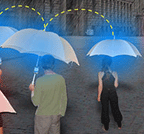
Spontaneous Wireless Mesh Networks
Gizmodo reports on Bluetooth Umbrella Networks: A team called "Umbrella.net" (no relation to Umbrella Corp, we hope) has developed a prototype system of Bluetooth umbrellas that facilitate "sudden, striking, and unexpected connections between people in public and urban space" by forming ad-hoc mesh networks when unfurled. As each umbrella is opened and added to the network, it lights as it comes online.
reblogged from Smart Mobs; posted by Paul Hartzog. August 13, 2004 at 09:46 AM
And Unstrung adds in Umbrellas in the Mesh:
In other words, create spontaneous wireless mesh networks that form when people put their umbrellas up -- and end when the rain stops.
This kind of mesh technology allows the devices themselves to act as nodes, passing data back and forth in an ad hoc setup, without a fixed connection to the wired Internet -- unlike the majority of commercial mesh products available.
The UMBRELLA.net project itself says:
UMBRELLA.net is a project exploring transitory or ad-hoc networks and their potential for causing sudden, striking, and unexpected connections between people in public and urban space. The project focuses on the theme of "coincidence of need", or how shared, yet disconnected activities can be harnessed into collective experiences. UMBRELLA.net examines how the haphazard and unpredictable patterns of weather and crowd formation can act as an impetus to examine coincidence of need networks. In particular, when umbrellas are opened and closed in public space. The project will attempt to highlight these informal relationships by creating a system of ad-hoc network nodes that can spontaneously form and dissipate based on weather conditions.
Now we finally know what those lighted umbrellas in Ridley Scott's film Blade Runner are.
Posted by jo at 01:05 PM | Comments (1)
August 05, 2004
Spectropolis: Mobile Media, Art and the City
New Urban Experience
Spectropolis: Mobile Media, Art and the City is a three-day event that highlights the diverse ways artists, technical innovators and activists are using communication technologies to generate new urban experience and public voice. The event explores what is possible when wireless communications (both new and old), mobile devices and media converge in public space. The increasing presence of mobile communication technologies is transforming the ways we live, construct and move through our built environment. The participants of the Spectropolis exhibition make obvious or play with this shift, creating new urban perceptions and social interactions with cell phones, laptops, wireless internet, PDAs and radio. In addition to the projects presented in the park, there will be several hands-on workshops and two panels free to the public. Find out more
Posted by jo at 12:41 PM | Comments (0)
August 01, 2004
Mixed Reality in Los Angeles
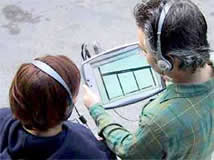
GPS Walkabout
34 North 118 West plays through a Tablet PC with Global Positioning System receiver and headphones. GPS tracks your location to determine how the story unfolds - in real time, in real space, as you traverse the sidewalks of Los Angeles.
Description of Tour: Imagine walking through the city and triggering moments in time. Imagine wandering through a space inhabited with the sonic ghosts of another era. Like ether, the air around you pulses with spirits, voices, and sounds. Streets, buildings, and hidden fragments tell a story. The setting is the Freight Depot in downtown Los Angeles. At the turn of the century Railroads were synonymous with power, speed and modernization. Telegraphs and Railroads were our first cross-country infrastructures, preceding the Internet. From the history and myth of the Railroad to the present day, sounds and voices drift in and out as you walk. Read Narrative Archaeology by Jeremy Hight.
Posted by michelle at 06:07 PM
July 31, 2004
Mobile Culture-Scratching
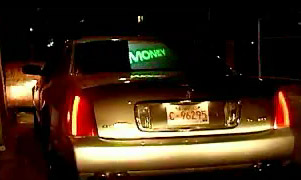
by Julie Andreyev, at New Forms Festival 2003, consists of 3 cars fitted with video projection on the rear windshield. Each car has a theme determined by the character of the car, and by characteristics of the host city where the fleet is mobilized. The choice of cars for the project reflects the specific car culture of the host city expressed through customization and branding.
Mobile Equipment
The cars are set up with equipment to allow for mobile video downloading, and video mixing using data from the car. While the fleet is mobile, videographers in the downtown site are creating videos for projection on the cars. The themes are used as a guide for them to create footage of the activities of a city's inhabitants.
Networked Process
This footage is uploaded by the videographers onto a web server. Then, the footage is downloaded by the cars as they drive by WIFI (wireless internet) download sites. A sound artist records ambient sound using a microphone held outside the window of one of the cars, mixes this, and plays it back using an FM transmitter. Nearby cars can tune into our frequency and hear the audio sampling. Each car is equipped with a sensor and software patch that interprets data from the car.
Software Interface
For example, one sensor reads data from the engine speed. This data causes a kind of 'jittery' effect to be applied to the video. The faster the car revs, the more 'jittery' the video. In this way, not only are the inhabitants of the city portrayed, but also the car is expressed in the video. After the performance, the cars can be driven into a gallery space where they can be set up to project their archive of the evenings' videos.
Mobile Portrait of the City
The goal of this project is to create a mobile portrait of the city through video and audio sampling of real time events. VJ-Fleet relies on current VJ (or video jockey) culture and the hosting city's local car and social culture. For each performance the project is customized and scaled to reflect the particular nature of the host city.
Posted by michelle at 06:37 PM
July 30, 2004
On Liveness and Presence
What is Live Art?
This from the UK: "Unlike with opera, people often ask, 'What is Live Art?' The answer is people have been experiencing it for the last hundred years, from the earliest events at the Cabaret Voltaire where DADA was born to the happenings of the Sixties which influenced Andy Warhol, and in the 21st century this tradition continues to mutate." 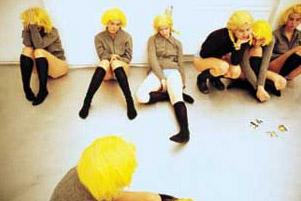
Today Live Art is witnessed at perfomances by Vanessa Beecroft or The Battle of Orgreave by Jeremy Dellar. Live Art is an interrogation of the aesthetics of presence. Live Art is about being there.
"Live Art mixes genres and diverse cultural experiences to express the complex organisation of contemporary life. It often involves work which questions commonly held assumptions. Live art is the trash-can of culture recycling and celebrating the debris of the modern world."
The History
: In 1965 Kaprow explained his evolution from collage to environments and happenings: "The action collages then became bigger, and I introduced flashing lights and thicker hunks of matter. These parts projected further and further from the wall into the room, and included more and more audible elements: sounds of ringing buzzers, bells, toys, etc., until I had accumulated nearly all the sensory elements I was to work with during the following years...." His works expanded until they filled the gallery, creating an integrated environment for the spectator. "I immediately saw that every visitor to the environment was part of it. And so I gave him opportunities like moving something, turning switches on -- just a few things. Increasingly during 1957 and 1958, this suggested a more 'scored' responsibility for the visitor. I offered him more and more to do until there developed the Happening...The integration of all elements -- environment, constructed sections, time, space, and people -- has been my main technical problem ever since."
Kaprow's progress did not occur in a vacuum, as he readily acknowledges. Robert Rauschenburg, Claes Oldenburg, and Jim Dine, among others, were also working on theatrical pieces, although they soon returned to more traditional areas; In Europe, Wolf Vostell and the Fluxus Group, and in Japan, the Gutai Group, were all investigating similar directions.
The Theory of Happenings: The Happening, as Kaprow developed it, is a non-verbal, theatrical production that abandons stage-audience structure as well as the usual plot or narrative line of traditional theatre. Although a compartmented organization may be used, the performers are considered as objects -- often kinaesthetically involved -- within an overall design of environment, timing, sound, colour and light. Found environments are often used and built upon, but the events are not casually arrived at, nor are they entirely accidental and spontaneous.
His view was that the Assemblage was to be "handled and walked around", the environment" was to be "walked into", but the happening was to be a genuine "event" involving spectator participation and no longer confined to the museum or gallery. Performers are encouraged to capitalize upon unplanned occurrences while acting out fantasies based on real life within a certain roughly pre-ordained structure that suggests symbolic and universally basic themes and meanings. A field of aesthetic operation is thus created in relation to life, combining artfully determined materials with strong associational properties, and dimensions with events and things from the sphere "outside" of customary definitions for art.
In the following networked performance types we directly see the influence of happenings particularly in the emergence of wireless network enabled Urban Gaming such as the Go Game. Go Game started off as a bunch of digerati having fun with their handhelds. Then it started becoming popular so the developers began marketing their services as event producers to corporations. Now their website has this decidedly corporate slant.
Pac-Manhattan was developed out of the NYU Interactive media program...possibly interesting if it doesn't fizzle out....
Urban Challenge, urrr I guess it's now Verison Urban Challenge. Enough said.
FlashMobs have matured to smart mobs.
GeoCaching is an entertaining adventure game for GPS users. Participating in a cache hunt is a good way to take advantage of the wonderful features and capability of a GPS unit. The basic idea is to have individuals and organizations set up caches all over the world and share the locations of these caches on the internet. GPS users can then use the location coordinates to find the caches. Once found, a cache may provide the visitor with a wide variety of rewards. All the visitor is asked to do is if they get something they should try to leave something for the cache.
Posted by michelle at 11:40 AM | Comments (0)
July 29, 2004
Networked Local Performance
Flip Flop
Flip Flop comprises a group of motion poets, cyborgs, and sound, video and net-artists who collaborate on ‘site-specific remote connection theater performances’ that, in their words, "challenge boundaries between audience and performer, on-stage and off-stage, the venue and the street outside."
For instance: the audience is invited to a party where, over the course of the evening, one of the partygoers (actor and motion poet Ajay Naidu) emerges as a performer, and the audience gradually realizes that it is participating in theater. As the performer shifts between private conversation and "narrative outbursts," the event shifts in mood and form.
Simultaneously, a performer, equipped with a wearable multimedia-streaming computer roams the neighbourhood. The route is choreographed to synchronise with the performers story, and a live "point-of-view" video feed (as well as audio) from the wanderer is relayed by wireless broadband to the performance venue. Flip Flop was performed in July, 2002. Read a report on Live Streaming as Dramaturgy.
Posted by newradio at 06:17 PM
July 27, 2004
More about Blast Theory
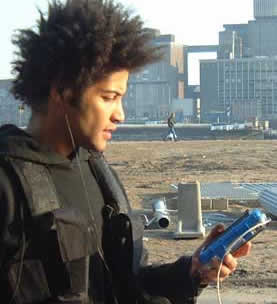 Matt Adams of Blast Theory posted a comment of encouragement to the blog's opening and I'd like to follow up with more about Blast Theory and a call out to Matt to respond to some specific questions about their work.
Matt Adams of Blast Theory posted a comment of encouragement to the blog's opening and I'd like to follow up with more about Blast Theory and a call out to Matt to respond to some specific questions about their work.
Blast Theory, comprised of Matt Adams, Ju Row Farr, and Nichols Tandavanitj, describe themselves as 'an artist group whose work explores interactivity and the relationship between real and virtual space with a particular focus on the social and political aspects of technology. It confronts a media saturated world in which popular culture rules, using video, computers, performance, installation, mobile and online technologies to ask questions about the ideologies present in the information that envelops us.'
This is evident in a survey of their work over the past decade. Formed in 1991, a chronology of their work from 1994-2004 is available on their website where the themes and explorations of technology range from video in live performance to interactive installations with the most recent using a pda or 3G phone to enable a mixed-reality game-based experience.
Beginning with their 1999 work Desert Rain and continuing on to the mixed reality works Can You see Me Now (project website), Uncle Roy All Around You (project website), and I Like Frank (project website) they have collaborated with the Mixed Reality Lab (MRL), an interdisciplinary research initiative at the University of Nottingham which brings together leading researchers in Computer Science, Engineering and Psychology to research new technologies that merge the physical and digital worlds, focusing on playful, artistic and educational applications.
The projects with MRL are clearly interactive in their game structures and use of mobile, networked technologies. The hybrid online/live action approach was explored in Kidnapped (1998) and interactivity has been a component in the early work since Stampede, (1994) in which the audience triggered how the piece unfolded via pressure pads.
Their work has been described as 'somewhere between theatre, performance art, installation and club culture' by Lois Keidan, Director of Live Arts, Institute of Contemporary Arts, London. In reviews of Uncle Roy in 2003 a direct link to the content and approach of their work can be found - a group of friends with various creative backgrounds get together to form a theater company. This comes through in Matt's initial comment to the blog in which he claims his excitement for recent developments in networked_performance, despite the backward looking stance of many traditionally moored theater and dance practitioners. Blast Theory is freed from any prior history in a single discipline by having a group comprised from various practices across which they draw to create their work.
Some Questions
Matt, firstly, correct any inaccuracies in the above. Would you tell us what are the backgrounds of the members and elaborate on the evolution of the group from the early years till now. What led to the formation of the group and why theater? It seems that BT has always had an interest in media and technology born of club culture perhaps. What is the importance of the 'live' and 'performance' aspects of your work? As opposed to addressing the same social and political themes about technolgical impact on culture by focusing solely on interactive installations, such as in An Explicit Volume, for example.
How did the collaboration with Steve Benford and MRL evolve? How has the relationship with MRL influenced BT's work conceptually? You might also elaborate on how the collaboration has enabled your work to evolve technologically as well. Can you speak about the offshoot of the BT / MLR collaborative endeavor, EVERPRESENCE and your project Vicinity to which you've been able to apply these joint efforts? It appears to include aspects of the mixed reality game-based works and a reality-tv episodic, perhaps. What's the timeline for presenting this work?
You also mentioned in your post that there is lots of interesting work happening in networked_performance. What's out there that you currently find interesting and why?...
Posted by michelle at 08:13 PM | Comments (3)
July 26, 2004
A PDA walkabout in Joyce's Dublin
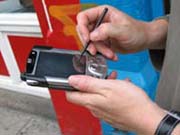
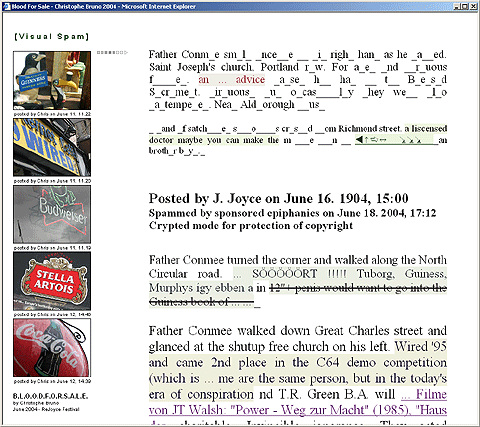
The program allows these "sponsored epiphanies" to disturb and transform the text of Ulysses, "Wandering Rocks", by incorporating themselves into the text. The real-time evolution of the text is displayed and graphically animated, sentence by sentence, projected in different places in Dublin, and online. By the end of the performance, carried out over several days, the original text by Joyce is almost entirely replaced by the "sponsored epiphanies."
Posted by michelle at 06:26 PM | Comments (0)
